This page comprises news items about birds and bird conservation in France, much of it based on the work of the LPO, compiled by Ken Hall. Any opinions and interpretations expressed should in general be taken as mine, and not those of the LPO itself. For more details about the Ligue pour la Protection des Oiseaux, its activities and publications, please see the their French-language webite, https://www.lpo.fr, from where it is possible to join as a member, subscribe to the various publications, etc.
News items for 2018
12 June 2018
Time for a change
As is obvious from the long time that has elapsed since I last updated these pages, I have not been very active as far as keeping you all up to date with what has been going on in France from a bird conservation point of view. It's not that the LPO is not as committed as ever, or that there are no problems that still need attention, quite the reverse in fact. But rather, although I have made one or two visits across the Channel, and have continued to read the LPO's various publications assiduously, I just have not had the time to translate and compile news items that I think would be of particular interest to a UK audience. Nevertheless, people continue to contact me with various queries concerning their membership, or who are taking a group to France, or who are living there and want to manage their property in a more wildlife-friendly manner, etc. etc., and I continue to do what I can to help out. But for various reasons, including having had to spend more time on activities more local to where I live near Bristol, the LPO has unfortunately slipped down the list of priorities somewhat.
With this in mind, and also because I was somewhat alarmed to find that over 25 years have elapsed since the LPO first asked if I could act as a contact in the UK on their behalf, I have decided that it's time to 'retire' as it were, and leave the field free for some new enthusiast. I shall continue to go birding in France as often as possible, and will maintain my subscriptions to the LPO's various publications, which I have always found as interesting as any of the other wildlife-oriented magazines that land on my doormat. And of course I will continue to keep in touch with the various birding friends I have made there over the years.
The LPO will be having a stand at the Birdfair in Rutland this year (17th–19th August), so that would be an ideal opportunity for anyone not only to hear the latest news on their activities, but also to see if they would welcome someone to take over where I am leaving off.
So for the moment, it's au revoir from me, hoping that the news items have been of interest and of some use in helping improve the lot of the birds and other wildlife of France. But my contact coordinates remain the same, and I will be happy to help out if anyone needs more information about the work of the LPO or birds and birding in France more generally on a more informal basis.
News items for 2017
27 November 2017
Ortolans – some relief at last
A recent press release from the LPO gives the news that for the first time in many years they have not detected evidence of any significant trapping of Ortolans in Les Landes, in south-west France this autumn. Assuming that this good news is repeated in future seasons, it marks the successful culmination of an extremely long and sometimes bitter fight against this illegal practice by the LPO and other conservation bodies. Adverse publicity, some real action by the authorities, some exemplary fines, and the strictures of the new environment minister, have all also played a part. But the LPO will be checking on the ground in 2018, just to be sure.
26 October 2017
Organbidexka migration counts
Although the season of counts at this Pyrenean migration watchpoint is not yet over – it runs to the middle of November – it is clear that for several species it has been an outstanding autumn. For instance, over 15,500 Honey Buzzards have been seen passing south, the fifth highest total in 39 years of counting. Over 2000 were seen on 24th August, with over 1000 on several other dates. Over 37,000 Black Kites were recorded this year, nearly 14,000 of them on just one day, the 7th August, after a few days of bad weather during which birds just had to sit and wait in the foothills to the north. I experienced something similar myself on 2nd August at the Col du Soulor, further east, when nearly 6500 Black Kites passed through once the skies had cleared after several days of frustratingly low cloud and no birds at all. But definitely worth the wait, for me if not for the birds themselves. October is the peak time for Red Kites, with 1940 counted on 7th, the highest daily total since records started. In some years at the start of the new millennium even the annual total never got as high as that, as the graph below shows. It is encouraging to see that the recent trend is upwards. They are still on the move, of course, over 8000 so far altogether, a new record.
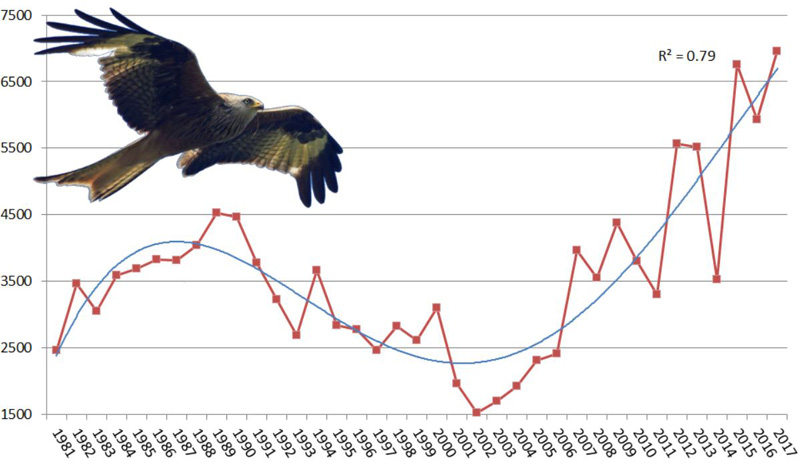
Another species also found in increasing numbers is the Black Stork. Whereas when counts began, nearly 40 years ago, it was rare to see one at all, during the 1990s numbers started to increase, and this year, for the first time, over 1000 have been seen heading south. No doubt increasing numbers breeding in northern France and elsewhere can account for this welcome rise in numbers. Among a few of the oddities, a Short-toed Lark was a first for the site, a Great Bustard was a bit of a surprise, and more than 2000 Hawfinches so far are a reflection of what seems to be quite a widespread 'invasion' across western Europe this autumn.
26 October 2017
Ortolans and the law
As a follow-up to the on-going saga of the illegal trapping of Ortolans and other small birds (see here), the result of one case against eleven people found guilty of breaking law has recently been confirmed after they appealed against the result and the fines increased slightly. Other cases are also going to appeal, to be considered later in the year. The LPO's press release, in French, can be seen here. It appears that these trappers, all fairly elderly, really don't have much else to do with their spare time, although that did not seem to cut much ice with the legal authorities. Another encouraging sign of the times is that Nicolas Hulot, the ecology minister, sent a message in August to the Préfet des Landes, the official tasked with the application of the law in that part of France, instructing him to reinforce the fight against the illegal killing of birds, with a view to eliminating the practice altogether.
12 September 2017
Honeyguide Wildlife Holidays
Each year I receive a brochure from Honeyguide Wildlife Holidays, as not only do their trips include visits to France, they also make a donation to the LPO from part of the cost of each holiday, the donations being made via the Honeyguide Wildlife Charitable Trust. In 2018 I see that they are visiting both the Dordogne area and the Camargue in May. Funds from the first holiday will support the 'Refuges LPO' network of over 17,000 protected sites across France, many of them private gardens and public parks, while those from the second will go towards enhancing the breeding sites of Lesser Kestrels on La Crau, one of the places participants will be visiting. For more details of these and other holidays on offer, check out the Honeyguide website.
27 August 2017
Recent issues of Ornithos
With a bit of time on my hands (i.e. staying at home to avoid the Bank Holiday traffic), I've at last had a chance to read through the two most recent issues of Ornithos. As usual there is always something of interest here. In Number 24-2, the main item is the third update to the 'Nouvel inventaire des oiseaux de France' (NIOF, published in 2008), adding new information about a large range of species, with references to sources given for those who wish to enquire further. A summary of the previous update can be found here. Among the more notable changes are those concerning the herons and their allies where, in many cases, as in the UK, there have been some significant increases. For instance, in the Camargue the numbers of Night Herons reached a new peak in 2015, with 1120 pairs, while the population at the Lac de Grand-Lieu (Loire-Atlantique) has varied between 220 and 240 pairs since 2008. These figures are of added interest knowing that this year a pair bred successfully in the UK for the first time, on the Somerset Levels. Likewise, the recent Cattle Egret influx to the UK is no doubt linked to the steady increase in France since a cold winter in 2012 knocked numbers back quite severely. Another species that has also started breeding in the UK, the Great White Egret, has a population in France now estimated to be around 500 pairs (2016 figures), with new breeding sites occupied each year. In 2015, in the Camargue, no fewer than 1028 pairs of Glossy Ibis bred at the Scamandre reserve alone, and at least three young from that population have made their way to Britain. Both White Storks and Spoonbills continue to extend their ranges, with record numbers of both noted on migration. On the down-side, Squacco Heron numbers seem to be declining, although 453 pairs were still reported from the Camargue in 2016.
Other items that caught my eye concerned four Great Bustards from the Wiltshire reintroduction project which had crossed the Channel between 2011 and 2013. One made it back under its own steam, one was caught and sent back after recuperation in a rescue centre, one was found dead, and one survived for several months before disappearing again, who knows where. Among the waders, the highest post-breeding number of Kentish Plovers that could be found in Brittany was 187 in September 2015, compared to 600–700 back in July 1995. No wonder they are increasingly rare now in the UK. With Bee-eaters having attempted to breed again in Britain, it is interesting to note that there have been quite a few small colonies scattered across northern France in the past few years, but many of them are only transitory, as has also been the picture here. Crested Lark populations continue to decline in many places, and it is depressing to note that an estimated 120,000–240,000 Skylarks were reported as killed during the 2013–2014 shooting season. Unfortunately this species, whose French wintering population has dropped by nearly 44% between 2000 and 2016, remains on the (much too extensive) list of legal quarry in France. The well-known most northerly population of Rock Sparrows, those at the Abbaye de Fontevraud (Maine-et-Loire), seem to be on the way out, despite work to maintain their nesting sites at this historic building, with only three or four pairs in 2011 (although I did see at least one bird still there in 2013).
These are just a few of the species mentioned – the rest of the list contains much else of interest. The other main paper is an account of a mixed pair of shrikes, Lesser Grey and Woodchat, which attempted to breed in the Vosges area in 2016, the former being, of course, almost a vagrant this far north.
In Ornithos Number 24-3, there was an interesting paper about birds with deformed bills, some of which were quite extreme, leading one to wonder how some of them managed to feed at all. Nevertheless, many of them did survive for quite long periods, presumably having to take up some odd positions to manage to do so. However, a couple of colour-ringed gulls seen on multiple occasions, although having quite deformed bills at one time, were noted as having 'normal' bills a few months later, presumably having 'moulted' the deformity away. Perhaps other species might have managed the same thing. A second paper summarised the importance of the mudflats of the Loire estuary for birds, concentrating on the section immediately upstream from the Saint-Nazaire road bridge. Dabbling ducks, Greylag Geese and a variety of waders, including up to 3800 Avocets, all depend on this area, protected from hunting, but under possible threat from industrial development and general disturbance. The main paper in this issue concerned sexing and ageing of Short-toed Eagles, a useful addition to the section in Dick Forsman's excellent 'Flight Identification of Raptors of Europe, North Africa and the Middle East'. For those spending time watching migrants in the Pyrenees at, for instance, Organbidexka, the Col du Soulor, or Eyne, both the book and this article will make particularly interesting reading. As usual the issue ends with book reviews, some recent rarities and some short notes.
16 July 2017
A brief visit to the Dordogne
A little time ago I wrote a review of a birding guide to the Dordogne (see here), an area that I have passed through several times, but where so far I have not had time for a longer stay. Although essentially this remains the case, earlier this month while travelling through France I did stop for a couple of days in the west of the département, at the request of the owners of a guest house who had asked me for information about the birding possibilities of their area. Although I was only there for a couple of days, I managed to see a good range of species without even leaving their own property. The surrounding heaths and woodland also looked interesting, and as some of the sites mentioned in David Simpson's book are also not far away, it seemed worth putting a short account of what I managed to see here.
19 June 2017
Spring migration at the Pointe de Grave
The 34th season of counts at the Pointe de Grave, a natural funnel for north-moving migrants on the west coast of France, where the Gironde enters the sea, has recently ended. From the beginning of March to the end of May, a team of watchers counts the migrants passing through, to monitor populations changes, but at the same time to explain to the visiting public the importance of the site. Jean-Paul Urcun, the coordinator for the LPO, has sent me a summary of some of the highlights, starting on 6th March when a storm brought exceptional numbers of gulls close to the shore, plus a day-record of seven Great Skuas. Later the same day, with rain continuing to fall, an arrival of passerine migrants included 27,000 Chaffinches and 3000 Meadow Pipits in the space of just two hours.
In April it was time for migrants from Africa to appear, including Cuckoos, Purple Herons, Montagu's Harriers, Black Kites and Hobbies. In May, the numbers of hirundines peaked – 19,312 Swallows on the 4th and 7511 House Martins on 9th – with daily counts of Swifts as high as 25,000 around this time. Among record counts for the season as a whole, Spoonbills totalled 3104, Chaffinches 55,086, Purple Herons 336, Bee-eaters 109, and Yellow Wagtails 3691. Other encouraging totals, for which one has to go back 20 years to find better numbers, concerned Serin with 3277 individuals noted and Golden Oriole with 440. Hopefully a sign of an upturn in their fortunes?
Rarities included three Pallid Harriers, a Black-shouldered Kite, six Red-footed Falcons, single Egyptian and Griffon Vultures and a Velvet Scoter. In total 182 species were recorded during the season, of which 158 were on active migration, the grand total coming to a remarkable 473,662 individuals over the three months. Clearly the Pointe de Grave is one of Europe's most important spring migration sites, well worth a visit if you have the chance. But don't forget that counts at the Col d'Organbidexka, in the Pyrenees, for migrants returning south, start on 15th July and continue to 15th November.
19 June 2017
Stonechats in Alsace
The LPO group in Alsace, among its many other activities, carried out a survey of the numbers of Stonechats breeding in its area in 2016, a repeat of a similar survey in 2002. It is encouraging to note that the estimated population rose from 2400–3100 pairs to 3790 pairs over the fourteen years between the two surveys, quite a contrast with the 32% reduction in France as a whole over the same period. The species seems to have benefited locally from a series of mild winters, and also by adapting to new habitats in the area. Each year, the group chooses a 'bird of the year' for special study – this year it is the House Martin, also the target of surveys in the UK under the auspices of the BTO, as numbers seem to be declining in both France and the UK.
16 May 2017
Ringing data from France
The CRBPO (Centre de Recherche sur la Biologie des Populations d’Oiseaux) is the body in France that coordinates the activities of the network of the ringers active in France (over 400 apparently). The results of their work are steadily being digitised and, at least from the year 2000, are available on the on-line site https://crbpodata.mnhn.fr. The introduction and instructions are in English, and it is possible to consult the data in either map or statistical format.
The maps are perhaps the easiest to understand, with data shown separately for ringing recoveries, and for resightings/recaptures. The list of species can be searched by common name or by scientific name. Note that for species which have been ringed in large numbers (e.g. Barn Swallow), you may have to wait for some time for the results to appear. Also the sightings are mapped with varying degrees of precision, and some of the non-French ones may just be centralised on the country concerned.
Out of interest I picked a couple of species where there are enough data to show some reliable patterns, Red Kite and Great White Egret. For the former, the annual migration north-east/south-west is very clear, with just a couple of resightings of birds marked in the UK found in France at a later date. For Great White Egret, the movement of birds from Hungary and elsewhere in eastern Europe to France, primarily in the winter, is shown clearly, with the dispersal of those now breeding in western France northwards to Britain and the Netherlands also very evident. There are hours of endless fun to be had here!
22 February 2017
Illegal trapping, the LPO and the Law
On 9th November 2016, a team from the LPO, including their President, Allain Bougrain Dubourg, were in the Landes region of south-west France, on their now annual trip to gather evidence of the illegal trapping of small birds during the autumn migration period. As usual there were altercations with the local trappers, but on this occasion it took a new turn in that they were attacked by a man wielding a spade and wearing little more than his underpants. Not unsurprisingly in this day and age the subsequent images went viral.
The case has recently now come to court, and the people involved in the illegal trapping have been fined 1000€, partially suspended, while those found guilty of violence were also fined and given various prison sentences, again all suspended. Their hunting permits were withdrawn for up to a year, although they all gave undertakings that they would not be trapping again in future, and their weapons, including the famous spade, were confiscated. It is encouraging to see that the judiciary are applying the law rigorously, especially in a region where local politicians are often willing to turn a blind eye. The case will be considered again in April, but one hopes that the adverse publicity so far will act as an additional deterrent to practitioners of this out-moded 'tradition'.
29 January 2017
White-tailed Eagle returns as a breeding species
Although White-tailed Eagles continued to breed in Corsica until the middle of the 20th century, they had died out in mainland France some time in the 19th. In recent years, as is well-known, they have become regular winter visitors to several sites around the country, the most notable being the huge lakes in the Champagne-Ardenne region of north-east France. However, birds are also regularly seen at the Lac de Madine and the Etang de Lindre in Lorraine, so it was not a great surprise when one, and later a second bird, arrived at the latter site in the late autumn/early winter of 2009. However, when both birds were still present in April and May 2010, suspicions were aroused as to a possible nesting attempt, but there were then no sightings until August of that year, albeit a very early date for a returning winter migrant.
The area is a vast one, much less visited by birders in the summer, and this species, although huge, can keep a very low profile during the breeding season. Up to four individuals were seen during the next winter, followed by some very intermittent sightings of two birds, only one of which was a full adult, during the summer of 2011. It was quite a surprise, therefore, when two juveniles were seen with the two older birds in August, and when the nest was located in the following winter, it could be confirmed that a successful breeding event had at last occurred. Since then, there have been two failed attempts in 2012 and 2013, but two young were fledged in 2014, one in 2015 and one again in 2016. Hopefully the Etang de Lindre will provide a base camp for further colonisation. A full account of these events can be read in Ornithos 23-4: 186-195 (2016).

24 January 2017
Big Garden Birdwatch
The weekend of 28–30 January is when the RSPB-run Big Garden Birdwatch takes place in the UK, when we are all encouraged to spend an hour in our gardens, counting all the birds that appear there during that time. By running this survey, which is simple to do and attracts a huge number of observers, comparisons can be made between years concerning the populations of our most familiar birds. Sometimes changes in numbers reflect actual population changes, sometimes the severity of the weather plays a big part. During the same weekend, the French will be doing the same thing – the slightly less snappily named 'week-end national de comptage des oiseaux des jardins'. The results will be added to the ongoing survey of garden birds (see the survey's website), where people are encouraged to make similar one-hour counts all through the year. On their site there is a map (carte des jardins) showing the distribution of the nearly 25,000 gardens taking part. They are well spread across the country, although there are clear concentrations around major towns and cities. A few maps showing a sample of the species recorded during the survey are also of interest.
21 January 2017
Ortolan migration
As has appeared here and here before, each autumn the LPO (and other conservation organisations such as CABS) have gone to the Landes area of south-west France to draw attention to the illegal trapping of small birds still prevalent there, particularly of Ortolans, although other small birds are also caught. One of the reasons that the trappers claim that it is acceptable to catch this species, which has seriously declined in numbers in western Europe, is that these particular migrants actually come from much further east, in Russia, where there are still healthy populations. So that's alright then! In the light of this assertion it was interesting to come across the results of a very detailed study carried out by Frédéric Jiguet and his colleagues on the migration and wintering strategies of this bunting, a summer visitor to Europe and Asia, wintering in Africa. The full article can be downloaded here and although it's in French, the various maps can easily be understood without much knowledge of the language, and at the end there is an update, in English, on the latest population estimates country by country.
The methodology inevitably occupies quite a bit of space, but as far as migration is concerned, the key results can be summarised as follows. There are two principal migration routes, one eastern, one western. The first concerns the birds breeding in Russia, and everywhere east of a line from Belarus to Serbia, taken by an estimated 4 million pairs (rounding the figures somewhat), around 90% of the European population, to winter on the plateaus of Ethiopia and Eritrea. The western route, involving just 10% of the European population, around 500,000 migrates to west Africa, principally Sierra Leone, southern Mauritania, Mali and Guinea, with the main stop-over points being in Spain and northern Morocco. This route can be further divided into two slightly different trajectories, one involving birds from Finland, the Baltic countries and some from Poland moving via northern Italy along the Mediterranean coast of France and on into Spain. Birds from Sweden, Norway, Germany and others from Poland take the most westerly route, via north-east France across the country to cross into Spain towards the western end of the Pyrenees. These are the ones, around 81,000 total, which will go anywhere near the trappers of Les Landes. There is also a third, more minor route, used by some birds from Finland, Poland, Italy and the Balkans, heading for Nigeria via Libya and Tunisia. Obviously the numbers using these routes will vary from year, partially influenced by the prevailing winds, but the overall picture is reasonably clear.
Although the species is not thought to be seriously threatened globally at the moment, with a large population spread very widely, numbers in the more western part of the range have seen a decline of 20% to 30% between 2000 and 2014. This is for a variety of reasons, partially related to habitat changes due to farming activities on both the breeding grounds and along their migration routes. So as far as relaxing the laws on trapping of Ortolans in France is concerned, it is clear that the excuse that they come from areas with stable breeding populations certainly does not hold true, but whether the trappers will be convinced by this new evidence remains to be seen. Nevertheless, the lack of firm moves by the French authorities to fully implement European law as far as Ortolans are concerned has recently been referred to the European Court of Justice by the European Commission (see this press release). One hopes that the Court might prod the authorities into more effective action.
16 January 2017
Col d'Organbidexka, end-of-season results
The full results of the migration counts made at the Col d'Organbidexka during the period July to early November are now available, with 167,432 individuals of nearly 82 species recorded during the season (see below for an earlier report). Black Kite and Honey Buzzard were, as usual, the dominant species among birds of prey, but there were also good numbers of Booted and Short-toed Eagles, Red Kite and both Black and White Storks. Rarities included four Pallid Harriers, a Dotterel, three Yellow-browed Warblers (a new species for the site) and a Wallcreeper. There were relatively low numbers of Woodpigeons there this year, but the nearby site of the Col de Lizarrieta, which is also manned during the migration season, counted nearly 700,000 of them, so numbers were certainly not lacking overall. Notable sightings at this site included a juvenile Pallid Harrier, a group of 72 Spoonbills, and totals of nearly 3500 Red Kites and 18,000 Cranes heading south. A Pallid Harrier was also noted at the third site in this part of the western Pyrenees, the Redoute de Lindus, sometimes known as Lindux, along with an Eleonora's Falcon, a Pallid Swift and a flight of ten Ruff. One never knows what might turn up!
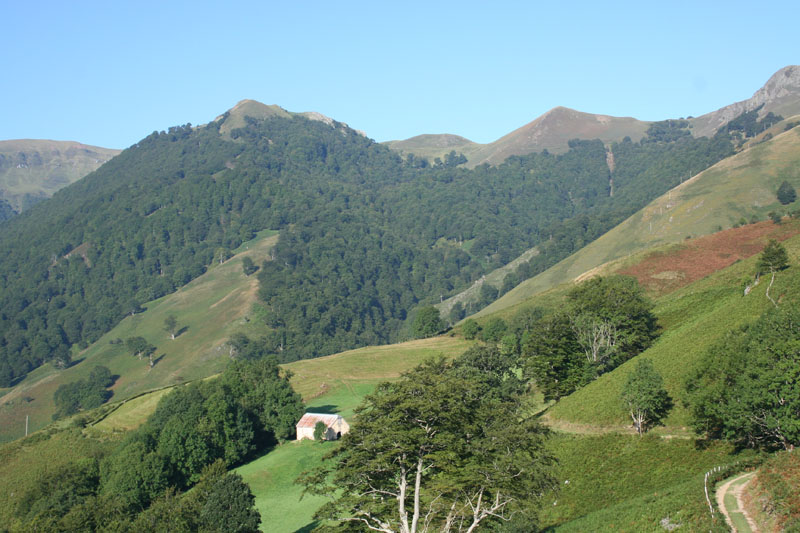
The full counts for Organbidexka can be found here, with an indication of the periods when most were passing through. It is easy to navigate from here to summaries of the counts from the other two places, as well as to counts from watchpoints all over France.
16 January 2017
One week, one bird
I've only just come across a series of short articles, published online under this heading by the LPO-Champagne-Ardenne group, and also appearing in the Sunday supplement of a local paper. The series has been on-going for a year, and I don't know for how long they will continue, but there is plenty there at the moment to keep one occupied. It's quite a simple idea, giving a character sketch of one species per week, and where applicable putting its status in the Champagne-Ardenne region into the wider context in an interesting manner. Although in French, these 'bite-sized' items look to me to be ideal for someone wishing to brush up on the language, and also to learn a bit more about what is a very rewarding part of France as far as the birder is concerned. The link can be found here.
13 January 2017
A Happy New Year
The start of a new year is always a great time to join the LPO, and to take out a subscription to one of its publications. L'Oiseau Magazine is the most popular, and as one can see from the cover of the latest edition, the contents cover a lot more than just birds.
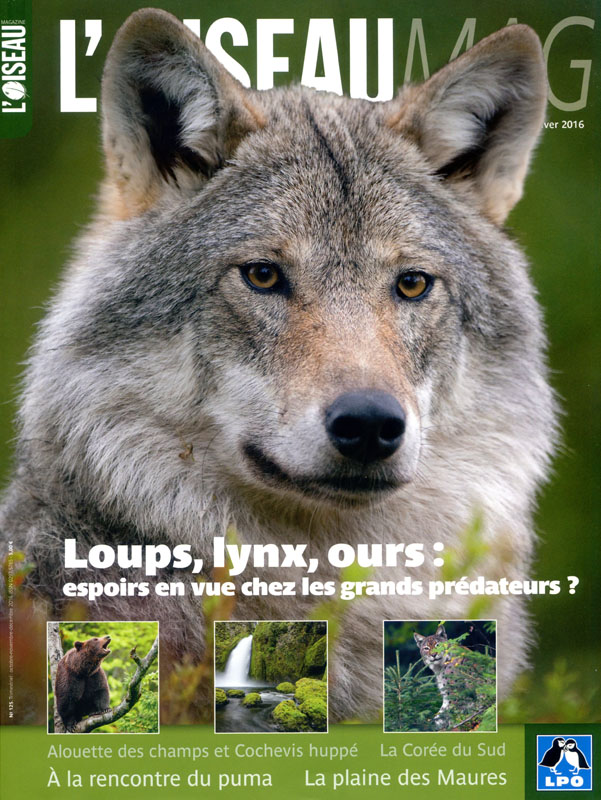
There is plenty of news about what the LPO has been up to, articles about the large mammalian predators in France, pumas in Chile, underwater soundscapes and their effects on cetatceans, site guides to La Plaine des Maures in southern France and further afield to South Korea, reviews of binoculars and tripods, improving your garden for birds and other wildlife, book reviews, etc. etc.
All the current subscription rates can be found here.
13 January 2017
Some background on the numbers of ducks shot in France
As I've seen some concerned comments on the sheer numbers of ducks shot in France, I thought I'd would do a little research to try to put the figures into perspective. One useful paper I located (see here) summarises the data, such as it is, taken from a sample of hunters questioned about their bags in the winter of 2013/14, so reasonably recent. Although there are no standardised systems for collecting data across Europe, a certain number of comparisons can be drawn. The first point that the authors make is that the total number of wildfowl shot (or 'harvested', as they put it) in France has remained reasonably stable over the past 15 years. The most numerous target species by far was Mallard, followed by Teal, Wigeon and Shoveler, with dabbling ducks outnumbering diving species by quite some way. Against a generally increasing winter population of dabbling ducks in France, it may be that the decline in the numbers of registered hunters in France (down from 2.2 million in 1974/75 to 1.2 million in 2013/14 is reducing the shooting pressure (they are all getting older too!). However, this is somewhat speculative, and some of the data indicate that the numbers shot have in fact increased in line with the populations of the species concerned.
Comparing figures country by country across Europe, France by far heads the list, with around two million wildfowl shot each year. Next comes the UK (which might surprise some people) with around one million, then Denmark (c.600,000), then Finland (c.455,000) with Germany, Spain, etc. reporting smaller numbers from then on.
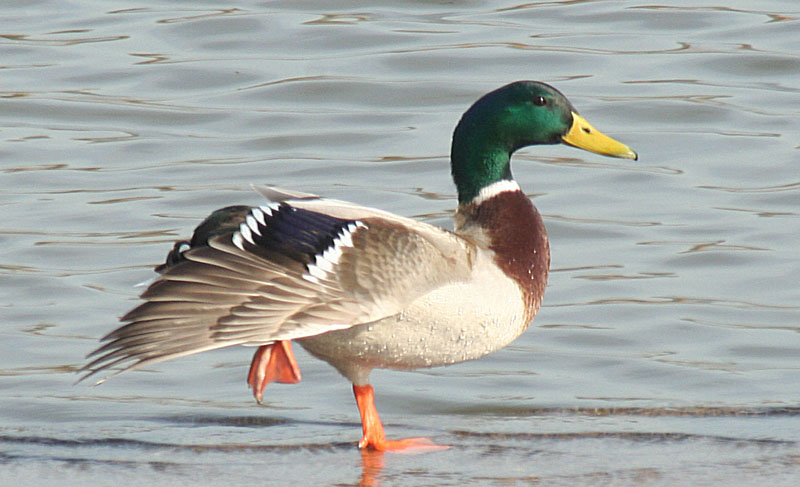
Considering France in more detail, and taking the most numerous species, Mallard, it would appear that around 1.2 million of these are shot each year. This seems to be an enormous number, in fact far higher than the 300,000-400,000 average wintering population, but what needs to be taken into account is the fact that about 1.4 million farmed birds are released (lâché) into the wild each year (see this report, in French). The farmed birds can be distinguished genetically from wild ones, and also appear to be less fit, with smaller gizzards and muscles, for instance. To study their survival, researchers in the Camargue have tagged captive-bred birds before releasing them into the wild. Even before the hunting season had started, the mortality rate among released birds could be as high as 71% (average 43%), whereas it would be only about 16% in wild birds of the same age. Birds released for hunting are usually about 10 weeks old and ideally are released two months ahead of the hunting season, but in some cases they are only released just before the season starts, which is perhaps not surprising in view of the attrition rates mentioned above! Dispersal is very low, with 92% shot close to where they were released, and it appears that around 80% of released birds are shot soon after the season opens or within a few weeks. It also appears that the vast majority of birds shot near the release sites, are in fact those same released birds, with wild-bred birds only a small proportion of those killed. Only a relatively small proportion of farmed birds make it through to the next breeding season, and even among those released into the non-hunted areas of the Camargue, only between 10% and 18% survived into the next year. Studies in the UK (e.g. this old Wildfowl Trust paper by the late Hugh Boyd) have also found poor survival rates among released birds.
One other result reported in the French survey is that avian flu has been detected among the birds reared for release at a much higher level than is found in wild populations. This is consistent with the view that avian flu, especially in its more virulent forms, is a disease to which intensively reared poultry, including ducks as well as chickens, are particularly prone. Interestingly, the French paper indicates that about half a million farmed Mallard are released into the wild in the UK. One wonders how many of those might be infected with avian flu. Mind you, this is peanuts compared with the numbers of Pheasants imported for shooting purposes! (See this written answer to a Parliamentary question.)
One final point that came out of these studies is that even a proportion of the hunters are disturbed by this totally artificial form of 'hunting', whereby semi-tame birds are released and then immediately shot. There are some who are opposed to this 'numbers game', and would prefer to have a countryside with habitats fit to support enough birds naturally for them to take a few for the pot, without these massive releases being necessary. There would be plenty of naturalists/birders who would go along with that.
News items for 2016
22 September 2016
Regional Natural Park of the Contentin and Bessin marshes
There are 51 regional natural parks in France, and all are well worth exploring. Several of them are producing 'where to watch' guides for birdwatchers and naturalists more generally, available from their central website. One of the closest to Britain is the Parc naturel régional des Marais du Cotentin et du Bessin, on the Cotentin peninsula south of Cherbourg. Having visited the area briefly on a couple of previous occasions and collected various leaflets on specific sites of natural history interest, I spent a few days there in May to investigate as many of them as possible in the time available. In the hope that others following in my footsteps might find them useful I have compiled some notes about where I went and what I saw and have put them on a separate webpage which can be found here.
22 September 2016
Lammergeier update
It's a pity to report that one of the young Lammergeiers (or Bearded Vultures, as they are sometimes called), named Larzac, which was released in 2015 in the Grands Causses in France, has been found dead in Germany. As discussed (below), young vultures can sometimes wander very widely before settling down to breed, but getting as far as Germany was quite a journey. The most recent information can be seen here. A post-mortem examination is in progress, but the fact that it was found under some electricity cables looks quite significant.
18 September 2016
Col d'Organbidexka, mid-season report
The Col d'Organbidexka is a pass, at 1283 metres altitude, situated towards the western end of the Pyrenees, and is one of the most important sites for bird migration in western Europe, along with Falsterbo in Sweden and the Straits of Gibraltar. Since 1979, the autumn passage has been studied by teams of observers, currently led by the LPO, not only counting the birds, but also welcoming the large numbers of visitors who come to help or who are just there as tourists. The 'season' lasts from 15 July to 15 November, and the results can be seen on-line day by day at the site www.migraction.net, which also publishes counts from many other migration hotspots around the country.

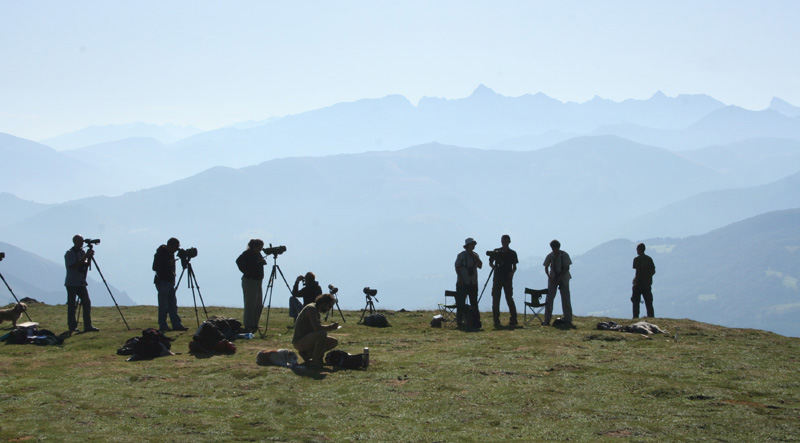
A month into this year's counts, as of 15 August, nearly 20,000 Black Kites had been logged, this being a species for which the main passage is at the end of July into early August. This is quite a low total compared with previous years, when over 30,000 have been counted. But there can often be quite large variations from year to year, partially depending on weather conditions, and this is a species which is thought to be thriving in France at the moment. Species diversity tends to be highest later in the season, but even by mid-August there had been 98 Honey Buzzards, five Montagu's and seven Marsh Harriers, 75 White and 31 Black Storks, and two Ospreys. Rarities have included a Black Vulture, a Black-shouldered Kite and a probable Lanner Falcon. In addition, of course, there are always the local Red Kites, Short-toed Eagles, Lammergeiers and Griffon and Egyptian Vultures to look at.
This is a good time to join the watchers – all are welcome, the more the merrier. With a couple of months to go, there are still plenty of migrants to look forward to, including Red Kites, Cranes and Woodpigeons, along with lots of pipits, wagtails and finches among a wide variety of small birds. I can't make it myself this year, although I did manage a few days at Falsterbo (http://www.kjhall.org.uk/reports/falsterbo-2016.htm), which I can also recommend. It was interesting to compare the mix of species that far back up the migration route, and to think that some at least would be heading over the Pyrenees a bit later.
11 August 2016
Stone Curlew protection near Lyon
The Rhône département is home to about 300 pairs of Stone Curlews, including several dozen which are very close to the conurbation of Lyon. With the expansion of the city and other associated building projects, there is a danger that numbers of this emblematic species might be significantly reduced. Consequently the LPO has been working with the local authorities and other interested parties to see what can be done to mitigate these effects. An ambitious 45,000 ha has been identified to the east of Lyon, first to be surveyed to find out how many pairs there are, and then to locate precisely as many nest sites as possible. Once a nest has been found, often in a field under active cultivation, discreet markers are put in place so that the farmer can steer round the nest when undertaking routine farm activities. The nests are not just in arable fields, however – others have been found in gravel workings, on airfields and even one pair in a private garden! In 2015, at least 79 pairs were located, of which 44 were definitely breeding. Twenty-two chicks were seen, although it is likely that more were missed, hidden in growing crops. One post-breeding gathering close to Lyon held 162 individuals, with other smaller groups noted elsewhere. An encouraging start to a project which has mobilised both LPO volunteers and the locals alike.
8 August 2016
La Ferme aux Grues
Visitors to the Lac du Der in the Champagne-Ardennes region to see the Cranes, White-tailed Eagles and wildfowl that winter there in good numbers might not all be aware that there is a farm nearby which is set up to attract Cranes during the daytime. This is the ‘Ferme aux Grues’ at Saint-Rémy-en-Bouzemont, where there is a hide overlooking some of the maize stubbles which are where the Cranes mostly prefer to feed. At dawn, they disperse quite widely from the lake, and mostly only return there in the late afternoon to roost. As of the end of 2015 the farm has changed hands, and the new farmer aims to turn it over to organic production, while at the same time increasing its eco-tourism potential, not only in the winter when the Cranes are around, but also during the rest of the year. He is working closely with the LPO over this, so if you are in the area, please do try to have a look – the village lies a short way to the north-west of the lake itself, and the hide at the farm affords some excellent viewing and photographic opportunities.
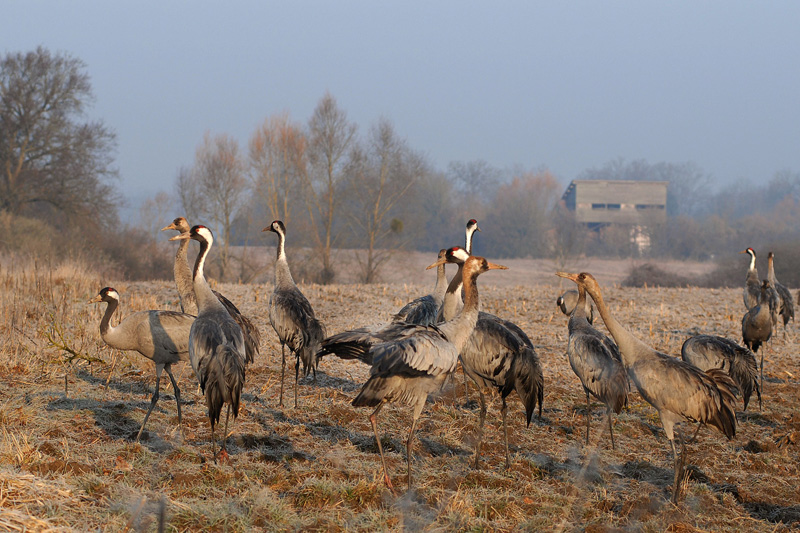
For more information on Crane migration at the Lac du Der and more widely, this LPO site is a good source of information in English.
29 July 2016
Conservation legislation and the work of the LPO
Over many months, the LPO has been closely involved in the tortuous passage of a Biodiversity Law through the French parliamentary system, the law finally being approved on 20th July. A previous law, covering the Protection of Nature, has been on the statute books for exactly 40 years, and that too had a difficult gestation. In both cases, the initial bold concepts have been watered down by various vested interests, including the agrochemical industry, the hunting lobby and marine fishing interests. However, the earlier law did establish that the natural environment was something of public utility that needed to be taken into account during planning processes, and also it led to the establishment of a network of national nature reserves.
This new law takes things a bit further, and incorporates the concept that there should be no backtracking on previous environmental commitments, and that there should be no net loss of biodiversity when new developments are proposed. In addition, the principle that the polluter should pay for any environmental damage also appears; a Biodiversity Agency is to be created, although its make-up and financing appears to be less than what was hoped for; and neonicotinoid pesticides are to be phased out by 2018, unless there are no other alternatives. These are some of the pluses. On the negative side, the proposal to more heavily tax the use of palm oil, whose plantations are doing so much damage to tropical forests, was overruled. Likewise, the proposal to outlaw the use of bird-lime, still legal in some Mediterranean parts of France, was also abandoned, following heavy lobbying by local politicians, and despite the fact that a petition to ban the practice gathered more than 320,000 signatures! The LPO is currently taking this particular aspect, together with the non-application of the law concerning bird-trapping (e.g. of Ortolans) to the European Commission, who have requested a response from the French authorities to justify their (in)action. The intricacies of the French legal system mean that even though this law has been passed, it still needs to be approved by the Council of State, and then decrees published that puts it, or parts of it, into practice. Opponents of the new law are already challenging it in detail, so there is still a long way to go. And in any case, those who break the law then have to be prosecuted, something that is by no means a foregone conclusion. France, of course, is not alone in this – we can all think of examples on this side of the Channel too. However, overall it must be considered another step in the right direction, even if a rather faltering one.
One can only but admire the tenacity with which the LPO, various individuals and other conservation organisations keep on pushing away at what sometimes seems to be an insurmountable obstacle of ignorance, prejudice and mis-information about the living world, especially seeing that it’s the only one we have.
28 July 2016
Annual reports in Ornithos
Two more issues of Ornithos have arrived in the past month or two, but it has taken me a bit of time to get round to reading them. Among other things, issue 23-2 contains the annual report on rare breeding birds in France, covering the year 2014. As ever there are pluses and minuses, with species ranging from Whooper Swan to Black-headed Bunting but I'll just pick out one, Spoonbill, which is currently doing quite well. Back in 2008 there were between 334 and 339 nesting pairs, this being a species for which a population estimate can be made with some degree of accuracy. Since then, numbers have increased every year, culminating in 950 to 1012 pairs in 2014. The département with the largest concentration is Loire-Atlantique, with 462–506 pairs, 206–230 of which were at the Lac de Grand-Lieu. There were 241 pairs in the Camargue, and about 100 in Charente-Maritime. Elsewhere smaller numbers occurred at sites such as the Barthes de l’Adour (Landes) in the south-west and the Parc du Marquenterre, near the Somme estuary on the Channel coast in the north. They have, of course, recently established themselves in the UK, after an absence of many years, and one hopes that this trend will continue.

On the other hand, there are mixed feelings about the species listed in issue 23-3, in the report on non-native species breeding in France, the year in question here being 2015. Among the wide variety of wildfowl, it is interesting to note that Ruddy Ducks still maintain a significant presence, despite the control measures that are on-going in France, as they are in the UK. During the breeding season they can be very hard to find, and there was little direct evidence of young being produced but nevertheless winter counts indicate 170–200 individuals as present in 2014/15, the largest concentration being, as usual, at the Lac de Grand-Lieu. One other species for which control measures are in hand is Sacred Ibis, which is a predator of the eggs and young of other species. By 2015 the population had been reduced to 130 pairs, almost all in the Loire-Atlantique département, also breeding at the Lac de Grand-Lieu as well as in the Guérande salt pans area. In the winter they can be found rather more widely along the west coast, but sightings elsewhere are now relatively unusual. Among escaped cage birds, you are too late if you want to add Fischer’s Lovebird to your French list, as the small population on the Côte d'Azur no longer seems to be self-sustaining. However, you should be better off searching for Red-billed Leiothrix, with some 5000 pairs estimated, mostly in the Béarn, down in the south-west, with others around Paris and Nice. But they can be difficult to pin down, as they favour dense vegetation, where despite their bright colours they can be extremely hard to see well. Here are my best efforts so far!
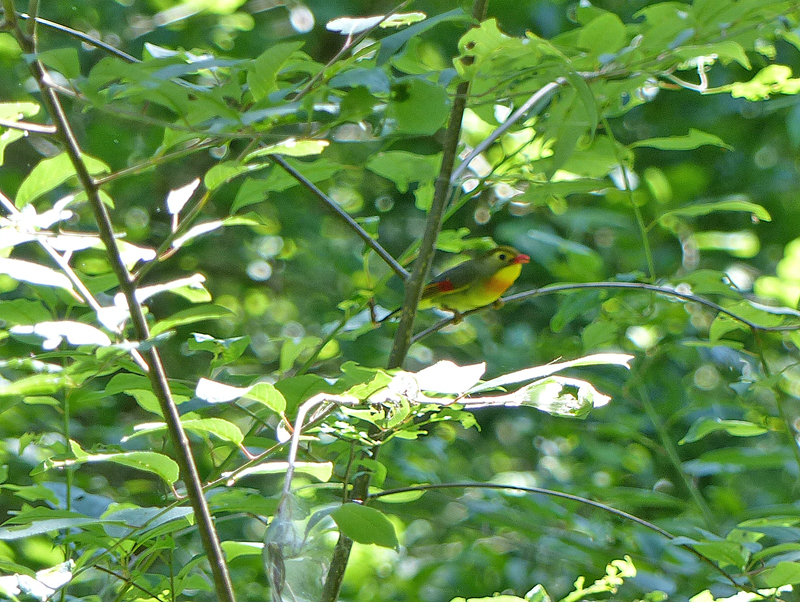
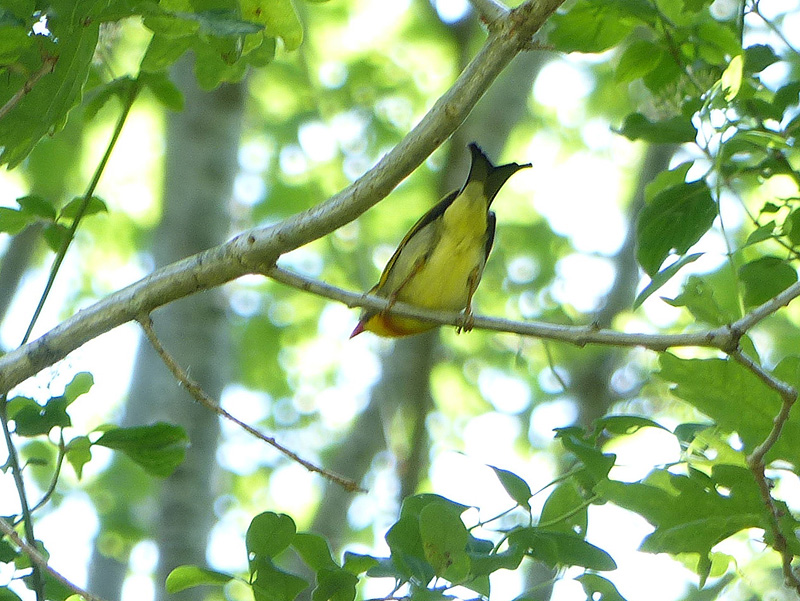
28 July 2016
A nestbox survey from the Refuges LPO network
One of the ways in which the LPO involves the general public in practical conservation is by getting them to declare an area that they own as a ‘Refuge LPO’. Very often this is their garden, although it can vary in size from a balcony upwards. Public spaces can also be designated, such as a town park or even the grounds of a chateau. The main thing is that some simple rules are followed that means that birds and other wildlife can thrive undisturbed. One obvious way is to put up nestboxes, which many households have been only too happy to do (a wide variety is available from the LPO, of course). As a follow-up, they are encouraged to supply as much information as possible about which species are using the boxes, and what the success rate is. Not surprisingly, Great Tit and Blue Tit head the list with, in 2015, 42% and 32% respectively of the nestboxes occupied, raising between four and five young per nest. Next in line is Black Redstart, which seems to take to artificial boxes very readily, and which of course is much more widespread in France than it is in the UK. Common Redstart is not far behind, presumably from more rural locations, followed by Coal Tit, House Sparrow and Nuthatch. Other species include Long-eared and Barn Owls where more specialised boxes have put up to replace the loss of more natural sites.
The Refuges LPO project has proved extremely popular, with around 18,500 sites participating across the country. It is nice to be able to acknowledge here that Honeyguide Wildlife Holidays, who always make a donation to a local conservation organisation after their trips, were able to send £390 to the LPO Refuges programme as a result of their most recent trip to the Dordogne.
13 June 2016
Migration studies in the Cap Gris-Nez area
Just a hop across the Channel is one of the best areas for studying bird migration in France, the Pas-de-Calais area, with the seawatching sites of Cap Gris-Nez (west of Calais) and Le Clipon (at Dunkirk) the most well known. But there are also several areas of coastal dunes and their associated reedbeds close by which provide cover for other migrants, and which are regularly worked by bird ringers. The results of their studies have recently been combined to appear in an English-language publication, supported financially by the local regional natural park (Le Parc naturel régional des Caps et Marais d’Opale) among others. It is available free on-line here from the Park's website. The 'Who, When, Where and How' of the observations made over many years are all comprehensively described in the introductory pages, followed by individual species accounts covering 59 seabirds, waders and wildfowl, and 47 nocturnal migrants, mainly passerines. Origins, routes, destinations and numbers are cited, illustrated with maps, charts and photographs. With Dungeness and other British migration hotspots only a short distance away across the water, it is fascinating to be able to make the comparisons between the two areas. Volunteers for future studies are always welcome, and many English birders, as well as Dutch, Belgian and French observers, have already been involved here over the years. And, of course, there are several other extremely rewarding sites not far away, such as the Marquenterre bird reserve and the Étangs du Romelaëre wetlands if you wished to combine the coastal sites with a longer visit.
27 May 2016
More on Lammergeiers
Remarkably, the day after I wrote the item below, an immature Lammergeier was found in South Wales, and has subsequently been seen in Devon and Cornwall. Exactly where it has come from remains a mystery at this stage, but the most likely explanation is that it originates in one of the populations in France, Spain or the Alps. Thanks to protection and various reintroduction schemes, numbers of Lammergeiers in Europe are at their highest level for at least a century. The largest numbers (c. 314 individuals) are in the Alps, nine pairs of which are in the French part of the range. The Pyrenean population is about 140 pairs on the Spanish side and 40 in the French side, while there are also five pairs remaining in Corsica. A reintroduction scheme started in 2006 in the Sierra de Cazorla in southern Spain has just produced its first young wild-bred bird in 2015 – there is no quick-fix for this long-lived species which can take up to seven years before reaching maturity.
In the southern part of the Massif Central (Grands Causses and Cevennes), two birds have been released per year since 2012. One is known to have died by electrocution on power cables, and two have lost their satellite tags, although these wandered to the Alps and Pyrenees respectively before doing so. As mentioned below, one has travelled to Germany and back, and another reached the Channel coast (it is currently back in the Massif Central), whilst the others did not move far out of the general area of release. Looking at the tracking results of birds in the Alps, most seemed to have stayed within that general area, although one moved as far as the Netherlands. Even if not fitted with tags, the newly released birds are ringed and mostly have their flight feathers bleached in individually recognisable ways, but of course these marks will disappear as the birds moult. Whatever the provenance of the bird in the UK, let’s hope that it will in due course make its way back to one of the mountain ranges it came from. Being a long-winged raptor, it is better suited to a sea-crossing than are the other more broad-winged vultures.
11 May 2016
Wandering vultures
As part of the various reintroduction schemes for vultures in France, several of them have been fitted with satellite-tracking sensors. These are throwing up some interesting facts about their behaviour, and particularly about their movements. One Black Vulture, Bernardus, a female born in captivity in May 2015 and released in the Gorges du Verdon (which are in the hills of Provence, north of a line between Marseille and Nice) in September 2015, is certainly well-travelled, as the map (left) below shows. By November she had moved west to Les Causses (another reintroduction site for this species) but did not stay long, moving south-west across the Pyrenees to reach Gibraltar by the end of the month, covering 1134 km in just six days non-stop. A previously released Black Vulture from the same area has gone as far as Senegal in the past, before returning to Verdon to breed. However, Bernardus hesitated to cross to Africa and made a full tour of Spain via Portugal back to Les Causses, then continued north across Switzerland and into southern Germany. Currently (10 May) she seems to have turned back south again. Black Vultures do not start breeding until they are at least four years old, so she has plenty of time yet before settling down.
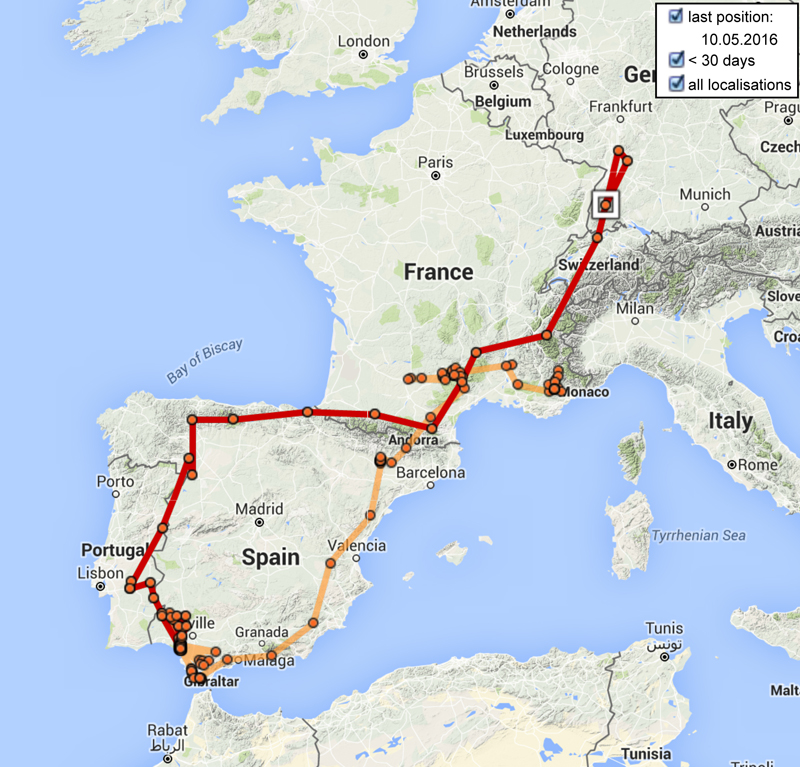
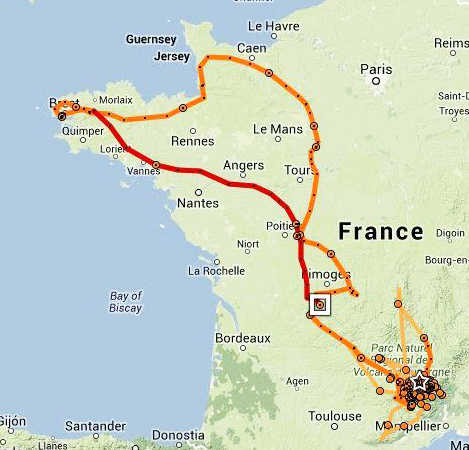
Similarly, Lammergeiers are being reintroduced into Les Causses, and are also being satellite-tagged. Although some do not go very far, some have headed well to the north, one to Brittany and Normandy (see map above, right), while another got as far as Hamburg in the north of Germany. The evidence is, nevertheless, that they eventually return to the release point, and hopefully settle down to nest.
For more information about these reintroduction schemes, both have websites here and here.
11 May 2016
Wintering Red Kites
The results of the most recent census of Red Kites in France, for the 2015/2016 season, have just been published, with a new record number of at least 11,373 reported from 247 roosts during simultaneous counts on the 9th and 10th January 2016. It seems that more and more are choosing to stay north of the Pyrenees these days, rather than crossing to Spain.

The map shows how the roosts were distributed, the pattern being much the same as in recent years.
11 May 2016
Red-backed Shrikes in Alsace
The LPO-Alsace group chose 2015 to carry out a repeat census of breeding Red-backed Shrikes in their region, following a previous one in 1998. The results show that the species remains well-distributed, but that numbers do seem to have declined since the previous survey. In one area which had been surveyed in both years, the decline was 7% over the 17 years since the previous count. In another area which is surveyed annually, the decline was 19% in just nine years.
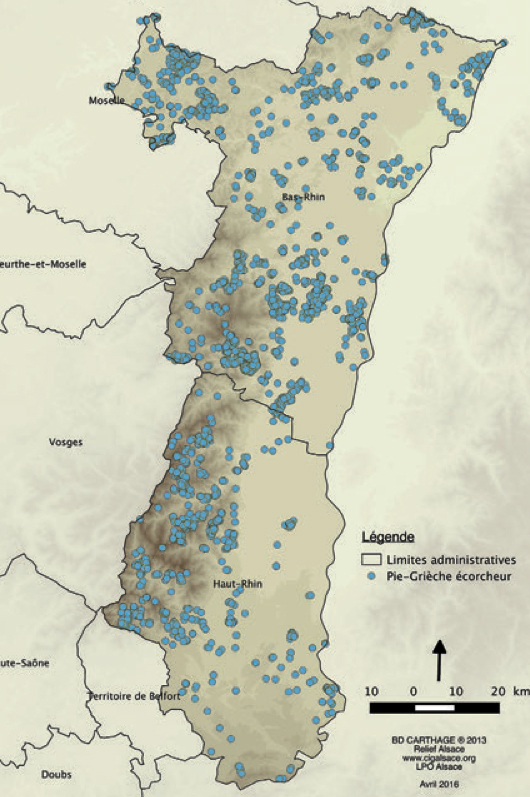
The causes are those that apply over so much of Europe these days, including agricultural intensification, loss of hedges and meadows and the effects of pesticides. Red-backed Shrikes are often found in low-intensity farmland, and where this is abandoned, particularly in more hilly areas, they can also be adversely affected.
9 May 2016
Réserve Ornithologique du Teich
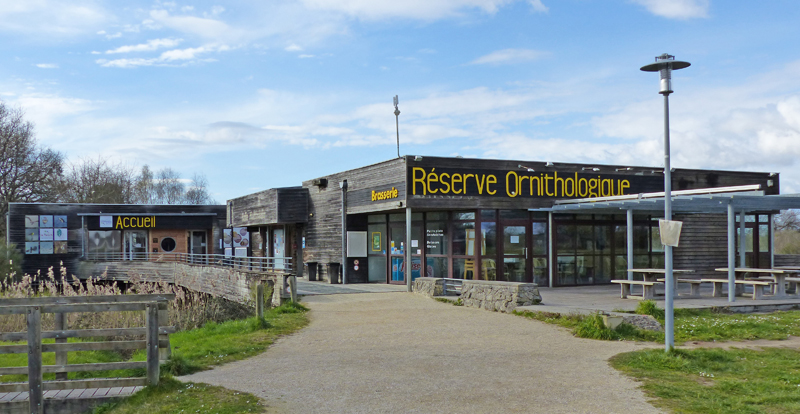
Since the last update, I have made another trip to France, where I managed to visit one of my favourite bird reserves anywhere, near the coast at Le Teich, to the south-west of Bordeaux. The reserve lies at the edge of the Bassin d’Arcachon, and consists of a series of lagoons, formerly used for fish-rearing, separated from the huge tidal inlet that is the Bassin by a dyke, with water flows controlled by sluices. The area has been owned by the local municipality for about 40 years, and was recently renamed a ‘Réserve’, previously having been called a ‘Parc’, when in earlier times it had a collection of tame waterfowl, both in and out of aviaries. These are now gone, and it is now run purely as a bird reserve, and is a popular ecotourism attraction, open every day of the year except Christmas Day. It is very well supplied with hides, and you can easily spend the whole day working your way from one to the next along the 6km circular route that runs round the whole reserve.

A tower hide also allows views out over part of the main Bassin. Note that there are several other protected areas along its shoreline, well worth exploring if you have more time, using an extensive network of waymarked paths. Within the reserve, in addition to the lagoons, which are of a wide variety of sizes, there is plenty of bushy cover, some reedbeds and also a good strip of woodland along the landward edge which boosts the variety of species to be encountered.

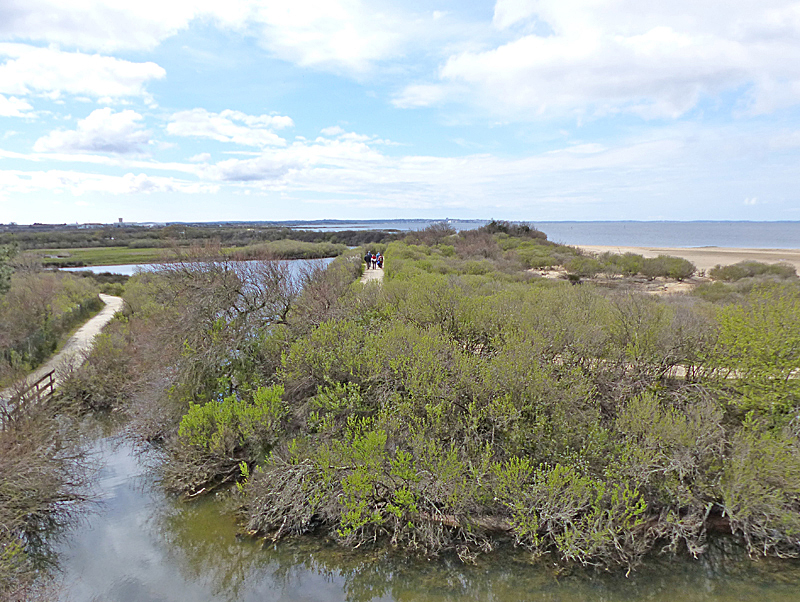
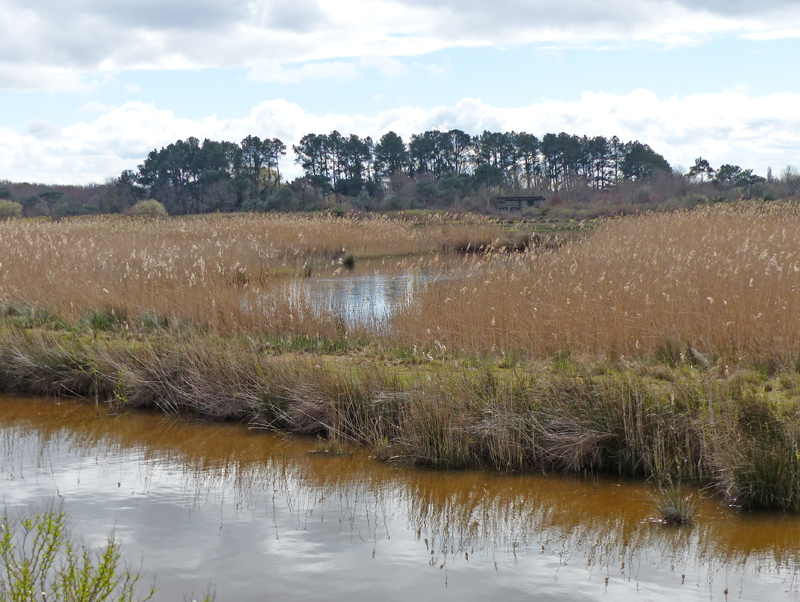
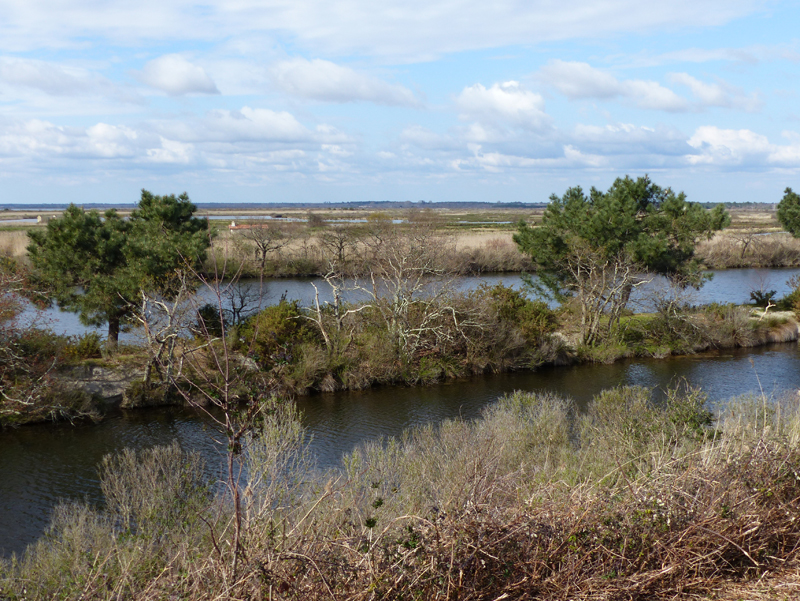
My visit was on 18th March, and luckily I coincided with high-tide in the Bassin, which meant that wader numbers on the reserve were boosted by those pushed off their main mudflat feeding grounds, those being temporarily immersed. A large flock of Dunlin also contained several Little Stints, plus both Ringed and Grey Plovers. A Red-breasted Merganser in the same area was a bit of a surprise this far south, but the reserve’s list does give them as a rare winter visitor, with fewer than 15 sightings to date.
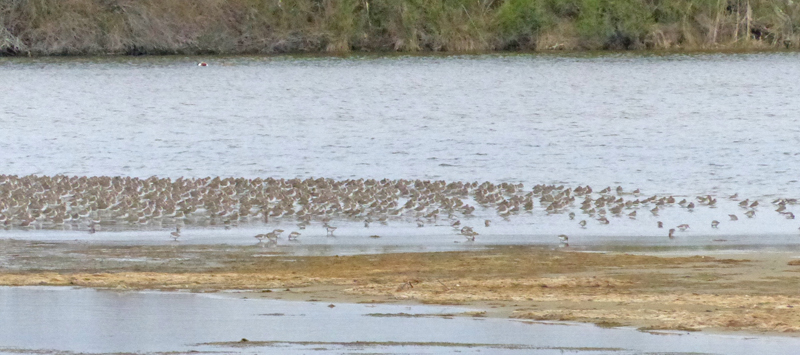
In other more sheltered lagoons I had the chance to compare Common and Spotted Redshanks side by side, both still in winter plumage, and there were good numbers of Black-tailed Godwits and Avocets present. Although Black-winged Stilts nest at the reserve, I was too early in the year to see them, though I have done so in the past; likewise for the White-spotted Bluethroats which also breed here in good numbers. But Black Kites and several White Storks had returned, the latter already settled onto their nests. This was one of the spots from which the storks started their recolonisation of France in the early days of their return to the west coast wetlands.

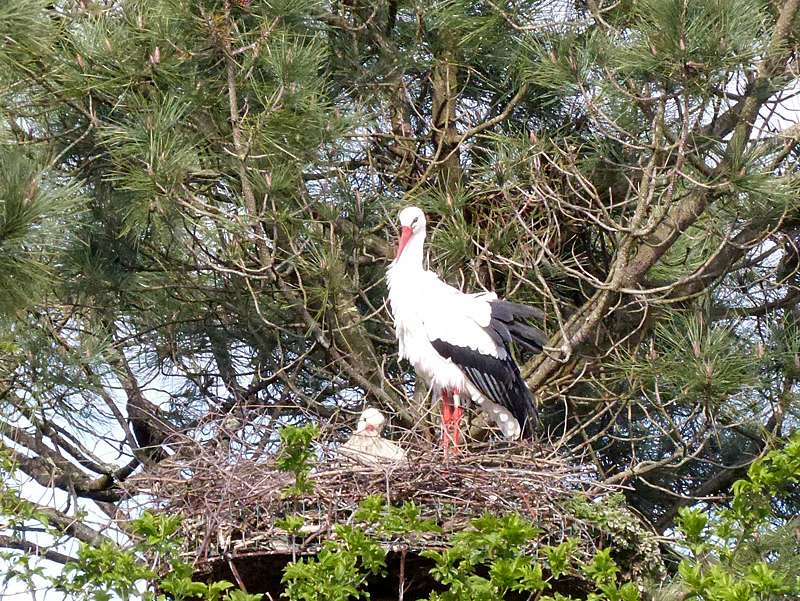
Spoonbills were much in evidence, and for once they were feeding actively, rather than roosting with their bills hidden, as so often happens. Le Teich is a major wintering and migration staging post for these birds on their way to and from their breeding grounds in The Netherlands. It was good to see them next to Little and Great White Egrets, and compare the different sizes and feeding behaviours of the three species.
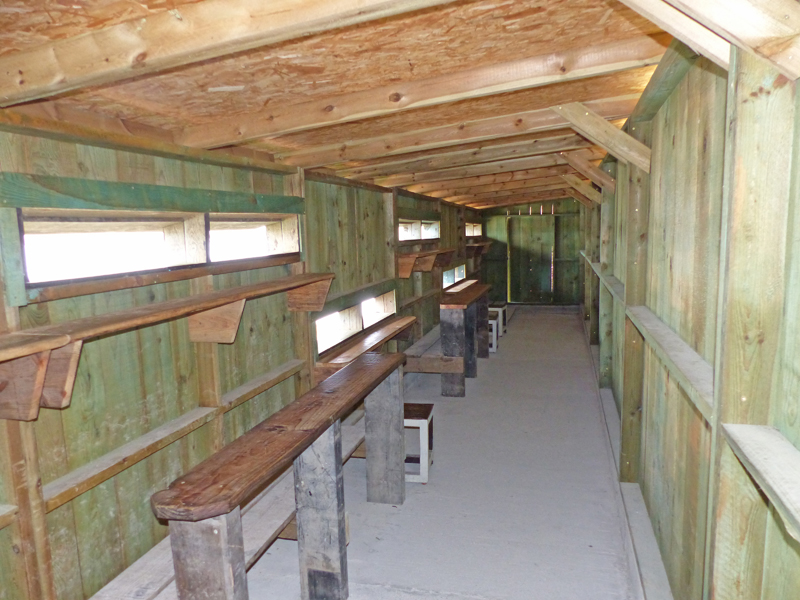
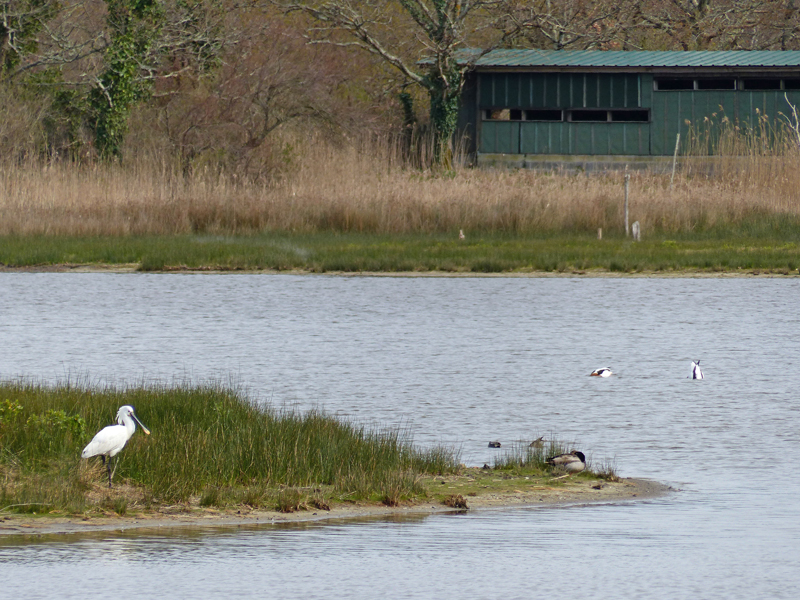
This reserve is worth a visit at any time of year – there is always something to see. For more information, take a look at their website, with options in English and Spanish as well as in French. There is even a discount on the entry charge for LPO and RSPB members.
11 March 2016
Purple Heron migration
Following the revelation that Bitterns will set off in groups on migration at dusk (see below), an article in Ornithos (22-4) describes how Purple Herons have been seen doing the same thing. The Dombes area of France, to the north-east of Lyon, is well known as a breeding site for Purple Herons, along with a wide range of other reedbed species, with perhaps around 200 pairs present in the summer. However, observers watching from various points to the south of the area between 19th August and 13th September 2014 counted no fewer than 1629 taking flight at dusk and heading south-south-west, the peak time for departures being about an hour before sunset. It was thought that although clearly the birds were then going to be migrating at night, most of them actually took off and left before it got dark. The peak number counted on any one night was 447 individuals, and although they were mostly noted in single-species groups, they were sometimes accompanied by Grey and Night Herons, along with Little and Cattle Egrets. Bearing in mind the numbers involved, it is likely that, similarly to the case of the migrant Bitterns, that birds from further north, making a stopover on their way south, were also involved.
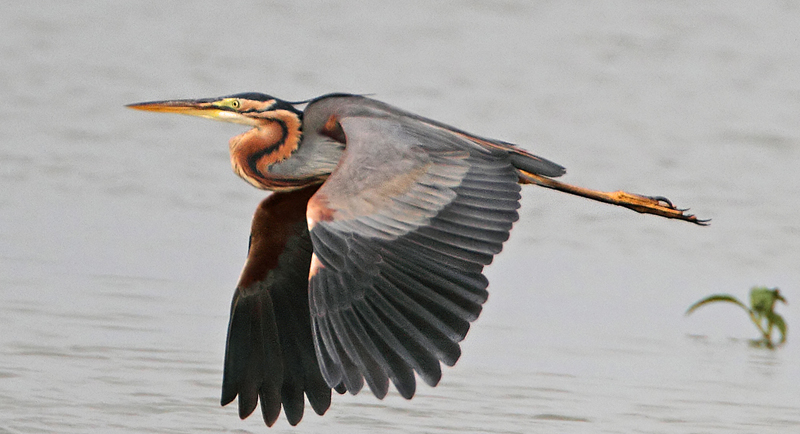
Many thanks once again to Gary Thoburn for supplying the image above.
11 March 2016
Corncrakes - an update
The four-year EU-funded LIFE+ programme of measures aimed at conserving the remaining Corncrake populations in France finished in 2015, although that is not the end of the story by any means. The general picture is not very different from the one I summarised below, with numbers still very low although just about stabilised. The problems, primarily to do with habitat management in actively harvested hay meadows, are well known, but the programme has been a good opportunity to try out various ways of ameliorating the effects of cutting regimes, by leaving bands of uncut hay round the edges of fields, attaching bars to the cutters to flush birds before the cutting blades arrive, delaying the date of the harvest, etc. Rather than repeat the details here, a good summary of the project is available in English in PDF format downloadable from the project's website. A national action plan is being developed to continue the good work, with the LPO very closely involved, as it has been all along, including having purchased some land in the areas concerned. If the programme could succeed even half as well as the schemes being undertaken by the RSPB in north-west Scotland, we would all be very happy
7 March 2016
Terres d’Oiseaux
Following a visit at the end of last October to the pretty and historic village of Talmont (founded by Edward I in 1284), on the east shore of the Gironde estuary near Royan, I noticed that there was a spot intriguingly named ‘Terres d’Oiseaux’, a few kilometres to the south. So, duly intrigued, I headed there to check it out. It turned out to be a bird reserve, situated by the mouth of an old canal which joins the Gironde at Port de Callonges, where there is a small marina.
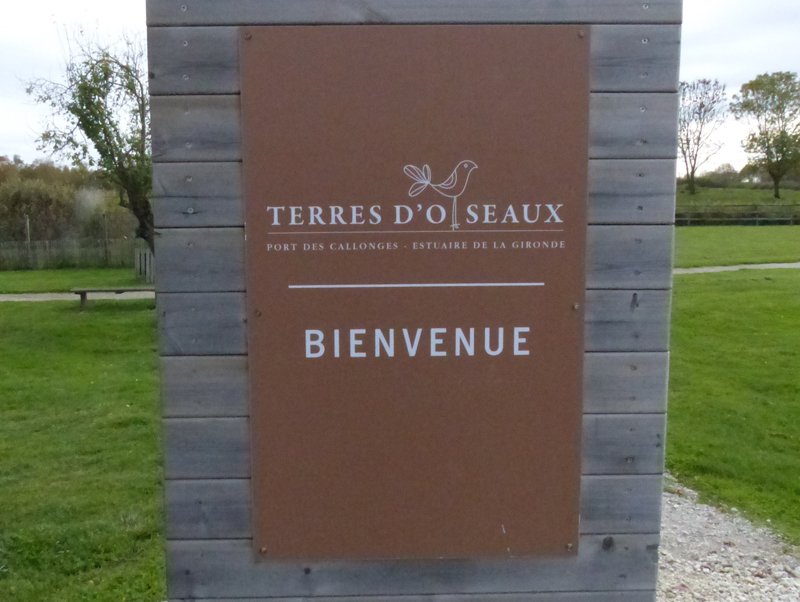
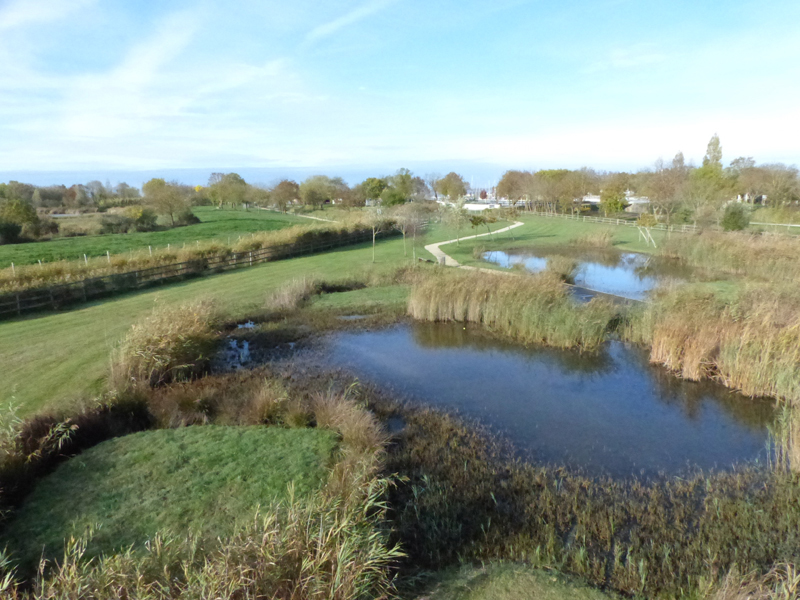
The reserve is owned by the local municipality of Braud-et-St-Louis, is open for most of the year on payment of an entrance fee (6€ currently), and comprises a series of lagoons, damp meadows and reedbeds, linked by footpaths and well furnished with hides. The route round is clearly marked and there are several options for walks of varying lengths, though I did the full circuit. A member of the staff leads you to the first hide and gives an overview of the reserve, but thereafter you can continue unaccompanied, although guided visits are also available.
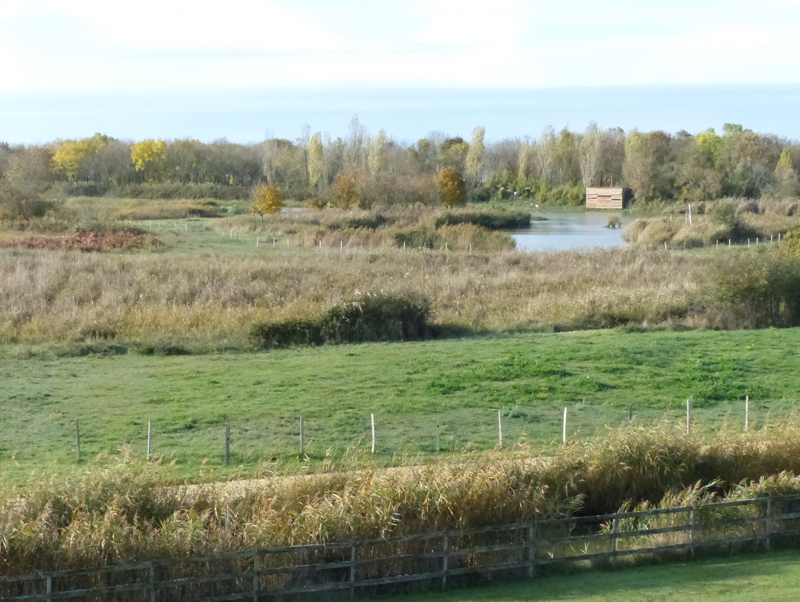
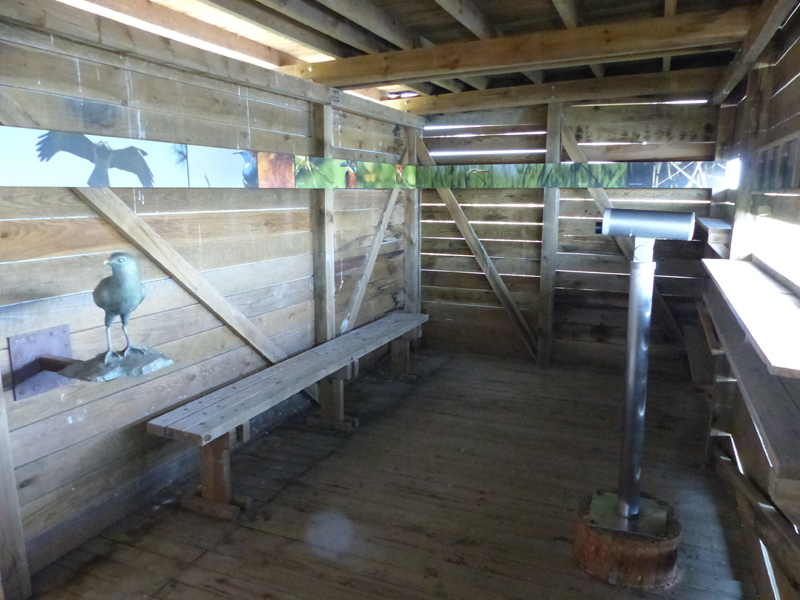
It appears that although originally the low-lying land here by the shore of the Gironde estuary would have consisted of wet meadows and marshland, by the 1950s these had been replaced by huge cereal fields. In the 1970s, when the Blayais nuclear power station, a short distance to the south and visible from the reserve, was being built, large quantities of earth brought from the construction site were deposited here, in rectangular patches. In the 1980s, this now-modified area was bought by a private individual who turned it into a commercial shooting reserve, adapting the habitat to that end. But at the turn of the century he sold it to the local authority who have since managed it as a nature reserve, with the ground again modified accordingly. As you walk round there is plenty of information as to what you might see, how the site developed, and how the various species are adapted to life in this sort of habitat.
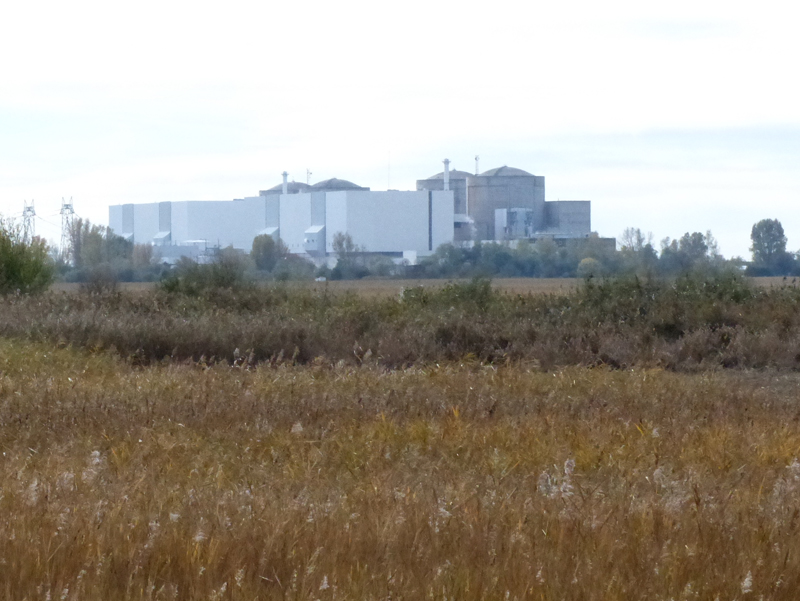

Despite my visit probably not being at the best time of year for variety of species, the main autumn migration having finished and the winter visitors not having arrived, there were Little and Great White Egrets present, plenty of Lapwings, Cormorants and a few Teal, Cetti’s Warblers were singing in several places, and a couple of Merlins and a Marsh Harrier were hunting over the nearby fields. According to the information on site, in summer there are White Storks, Red-backed Shrikes, Bluethroats and three species of harrier among breeding species, while the reserve is ideally placed to attract a wide variety of migrants in both spring and autumn. Certainly, looking at the habitat, that would all make sense.

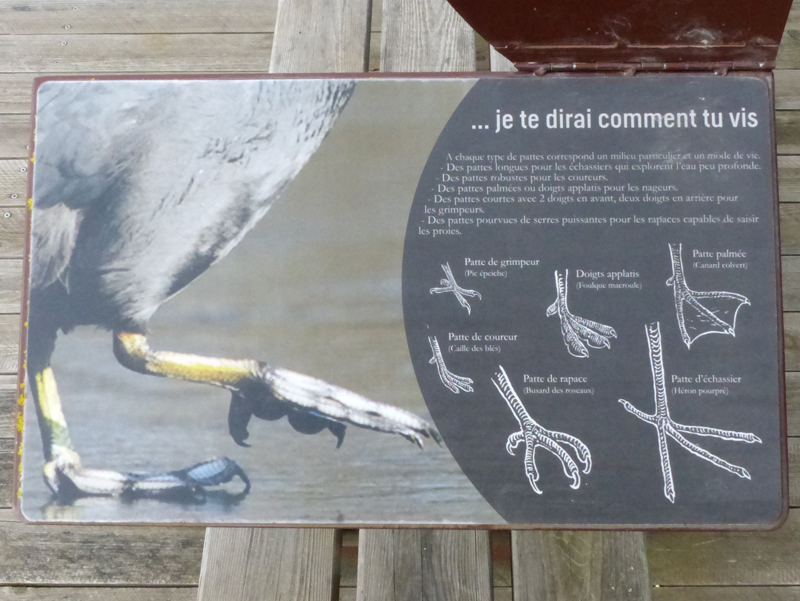
Even if you do not enter the reserve itself, there is a large tower hide and a few pools near the entrance, open to the public, and I can certainly recommend the adjacent restaurant, Le Marainaud, for lunch! For more information in French, do have a look at the reserve's website. It never ceases to amaze me how many protected areas there are in France, and the multitude of bodies that are involved in their designation and management.
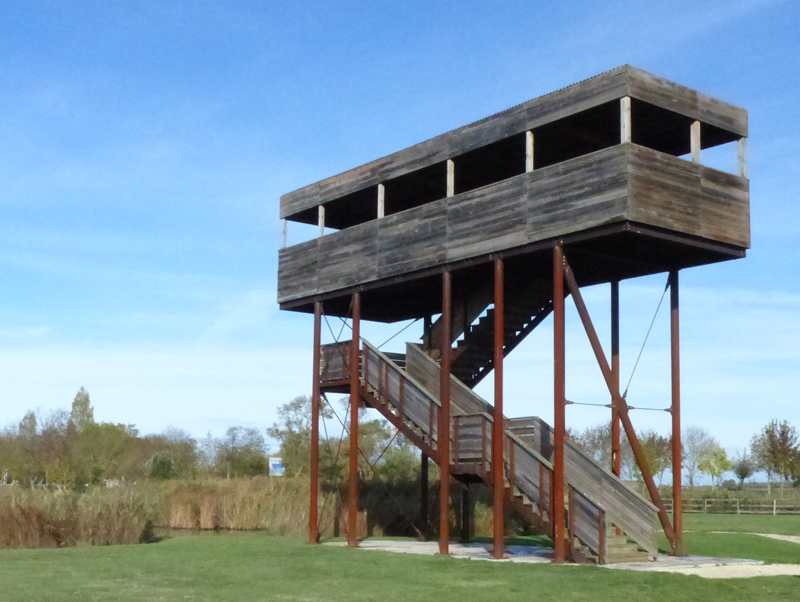
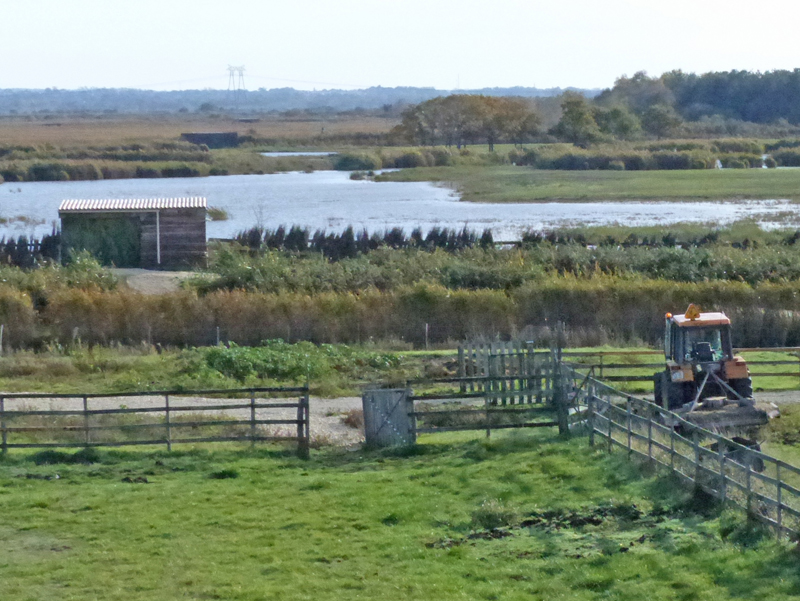
16 February 2016
Neutralising electricity cables
High-tension electricity cables can often be a menace as far as birds are concerned, and one such has been the 225,000 volt line over the canal de Huningue, in Alsace. This area is important for migratory birds and waterfowl, which are in danger of hitting the cables and/or being electrocuted. In view of this, the LPO-Alsace group has recently been working closely with the area’s electricity transmission authorities (RTE) in order to make the lines more clearly visible to birds. This involved some rather spectacular work by engineers, swinging from a platform attached to a helicopter, so that they could attach a series of coloured spiral objects to the cables, alternately red for diurnal birds and white for those active at dawn and dusk. Not only are they highly visible, they also make a whistling sound when the wind is blowing. It is thought that this work will reduce avian mortality by between 65 and 95%.
It is not the only way in which this partnership has been working – staff from RTE regularly survey their pylons to check that any birds that are nesting on them are not disturbed, and have also worked out ways of keeping vegetation under the cables controlled in an eco-friendly manner, delaying cutting until after the breeding season, and also until after the plants have set seed. Similar agreements have also recently been signed between the LPO Pays de la Loire and the LPO Isère groups and their local electricity authorities, with the same view in mind.
On a related note, an article in the latest ‘Rapaces de France’ supplement to L’Oiseau Magazine, reports on the results of 25 years of ringing of the Bonelli’s Eagles that nest in southern France. Over that period, 600 young plus ten adults have been ringed, quite a remarkable total seeing as the total French population is no more than 30 pairs. One striking fact that emerges from this concerns the cause of death of these birds, 43% of them being found electrocuted, and 7% killed by flying into cables of various sorts, i.e. 50% of all known casualties being linked to the electricity network. It appears that inexperienced young birds are the most at risk, and clearly this must be having a seriously negative effect on the recovery of this threatened species.
19 January 2016
Les Alpilles
The limestone hills of Les Alpilles, north-east of Arles, have long been a favourite area to visit during a trip to the Camargue area. Not only does it host a wide range of sought-after summer visitors such as Roller, Egyptian Vulture and Subalpine Warbler, but during the winter it is one of the most reliable places I know where you can get close views of Alpine Accentor and Wallcreeper, down from their high-mountain breeding sites to escape the cold and the snow. Here’s a picture of one of the former I took a few years ago at Les Baux, an historic fortress site dominating the surrounding countryside.
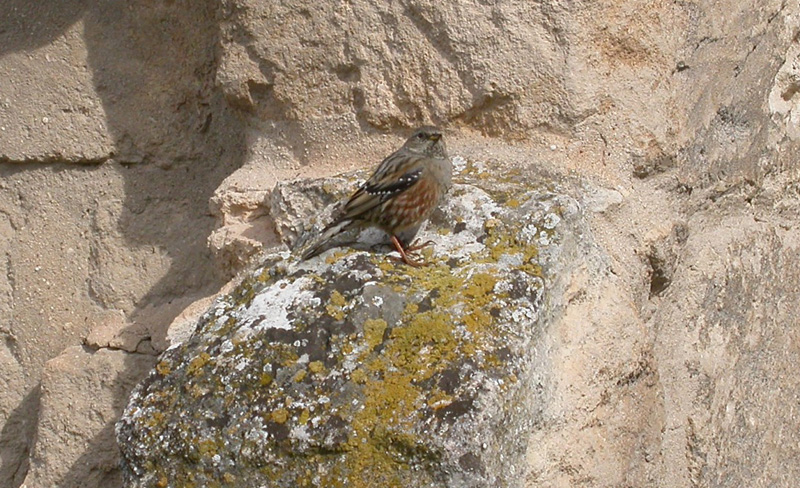
To encourage eco-tourism in the area, an EU-funded initiative has been set up, of which the LPO is one of the partners, and which runs through to 2018. There is information about what you might see in each month of the year to be found on the associated website – http://life-alpilles.com/en – and it is possible to download a smartphone app. giving commentaries on five recommended birding routes in the area, though you need to go to the French version of the site to get access.
19 January 2016
Black Storks return to Alsace
Black Storks formerly bred in the damp woodland along the Rhine in Alsace, but they died out many years ago, and since then suitable habitat along the river has become more and more fragmented. However, in the northern Vosges, there is still a good mix of the preferred habitat of this shy summer visitor, namely extensive woodland with nearby damp ground, and in 2015 a pair at last built a nest here and reared three chicks to fledging. The young were all ringed, and it will be interesting to see if there are any subsequent sightings. Black Storks have been slowly increasing in numbers in France as a breeding species, but this is a significant range extension, hopefully to be maintained. See also below for more details about this species in France, while of extra interest is the fact that two juveniles ringed in one nest in the French Ardennes in 2015 were later seen on autumn migration in the UK.
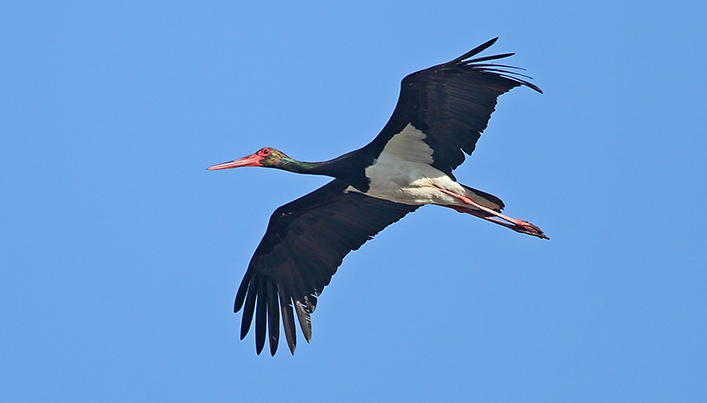
Thanks once again to Gary Thoburn for his image of a Black Stork in flight. You can enjoy lots more of his photos on his website.
13 January 2016
Poisoned raptors
A recent study published in the journal Ecotoxicology and Environmental Safety has indicated the extent to which poisoning is a significant factor affecting carrion-eating species in the French Pyrenees, and no doubt elsewhere. The objective of the study was to determine the causes of death of Pyrenean avian scavengers, and specifically to investigate toxicant exposure as a potential threat for the survival of endangered bird species involved in major European conservation programmes. Over the study period, from 2005 to 2012, a total of 170 birds (8 Lammergeiers, 9 Egyptian Vultures, 34 Red Kites, 119 Griffon Vultures) were collected and their bodies analysed to try to ascertain how they died.
Overall, poisoning cases were by far the most common causes of death (25% of all cases), followed by falls and collisions (12.3%), diseases (infectious and malnutrition 11.6%), shooting, blows and mutilation (11.2%) and electrocution (7%). Illicit use of banned pesticides was identified as a common cause of poisoning (53% of all poisoning cases) with lead poisoning also identified as a significant toxicant issue (17% of all poisoning cases). The insecticides carbofuran and aldicarb were the most commonly found pesticides from this analysis, despite there having been complete ban on their use in Europe since 2008. One can only conclude that there must be a clear case for making possession, not just the use, of these products illegal.
As far as the source of lead is concerned, this was linked to areas which were heavily shot over, both for pigeons and for deer. It has been estimated that between 1979 and 1984, for 100 shots, 11.3 pigeons were killed, 6.4 were injured and never found, thereby remaining available for scavenging birds, in addition to the spent shot being widely scattered on the ground. Moreover, raptors which had survived for some time with lead shot in their bodies had higher than normal concentrations of lead in their livers and kidneys. Isotopic analysis of the lead showed that its source was the same as that used in munitions locally.
In another study in the Swiss Alps, the levels of lead found in the bodies of Golden Eagles and Eagle Owls found dead (usually after fighting each other in the first case, and by electrocution in the second) were analysed. The levels found in the eagles was far higher than that in the owls, indicating that the eagles, which often feed on dead animals, were ingesting lead fragments that way, whereas the owls, which rarely do so, were avoiding this source of contamination. Once again, isotopic analysis of the lead found it to be the same as that used by local shooters.
The simple conclusion must be that the sooner lead shot is replaced with something less toxic, the better for all concerned. Somehow salmis de palombe does not sound quite so inviting as before.
8 January 2016
Réserve de St-Cyr
On 27 November 2015, and as part of the environmental campaign ‘a tree for the climate’, the President of the LPO, Allain Bougrain Dubourg, planted a large-leafed lime tree (Tilia platyphyllos) at the entrance to this reserve which lies some way north-east of Poitiers. In this symbolic gesture he was accompanied by the President of the Poitou-Charentes Region, the Maire of St-Cyr, and various other local notables, reinforcing the commitment of the community to enhancing biodiversity and counteracting the effects of climate change. In addition, volunteers from the local LPO-Vienne group had already planted 80 shrubs and trees here as part of the improvements to this reserve, which, it is hoped, may soon be given the status of ‘réserve naturelle régionale’, and attract some extra funding that way.
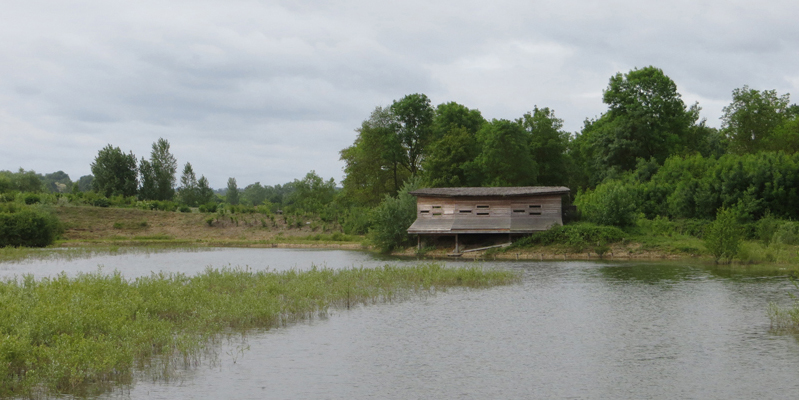
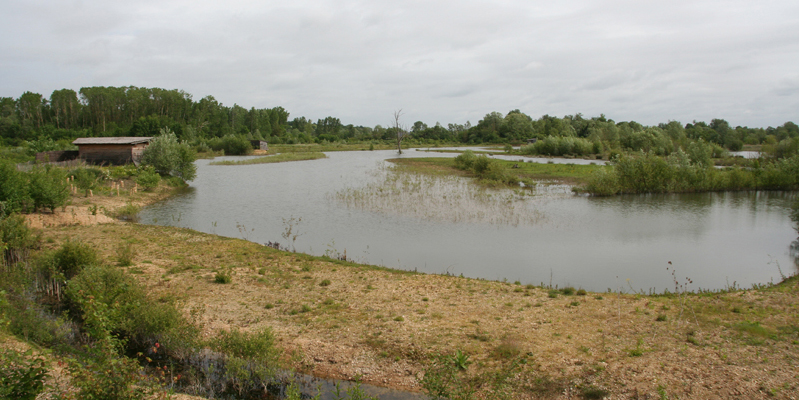
I had previously made a brief visit to the area in May 2014, when I took a few photos, despite the overcast conditions that day. They were not enough, however, to dampen the spirits of a Nightingale which was singing from one of the bushes by the path through the reserve, almost deafening at a few feet away, although completely hidden in the foliage, as is so typical of this species. The reserve is just a part of a much larger area, now a leisure park and formerly a gravel-extraction site. It is situated between Poitiers and Châtellerault, and not far from the well-known Futuroscope theme park.
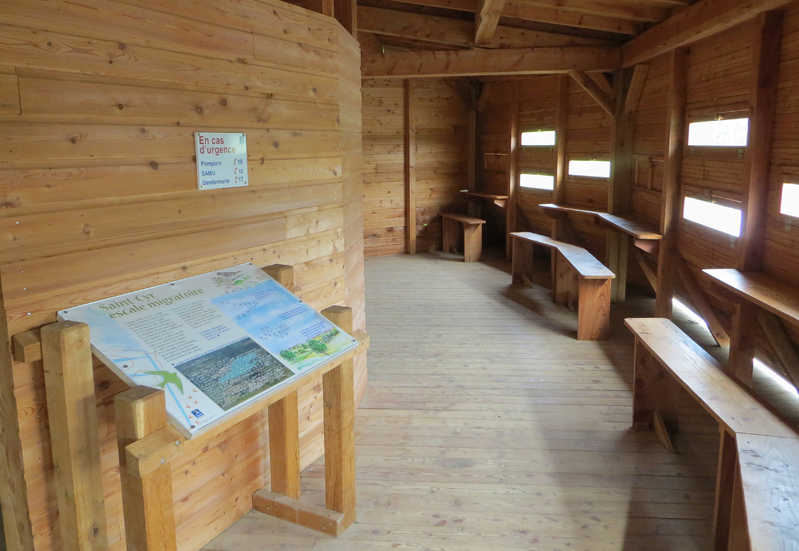
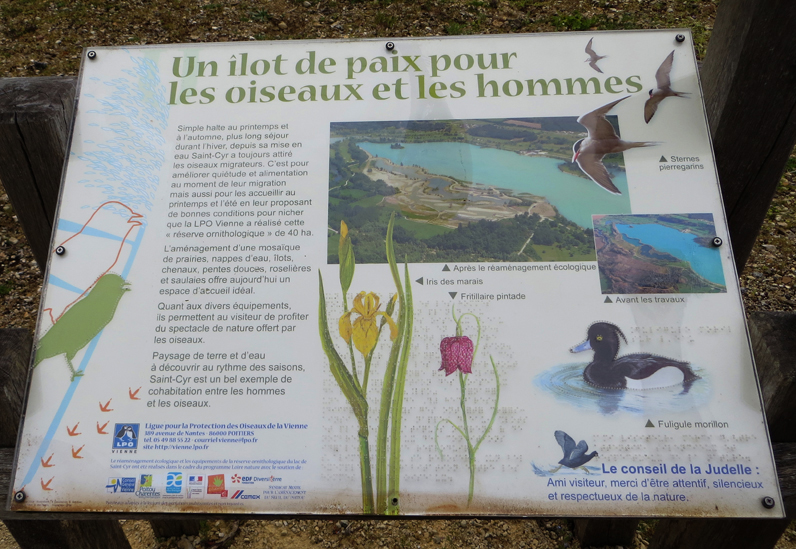
The main lake is used for water-sports and general leisure activities, while the reserve lies on the north-west side of the main lake. Here the habitat is being managed to attract wildlife and includes a series of shallow lagoons, plus a nice mixture of woodland, bushes and marshy ground. A marked trail open to the public leads through part of the reserve, leading to a series of hides where there is information about what you might expect to see over the different seasons. It is worth a visit at any time of year, with breeding Common Terns in the summer, and a mix of wildfowl in winter, while during migration periods it attracts a wide range of waders and other passage visitors (a couple of Whiskered Terns while I was there), including a creditable list of rarities. The flora and invertebrate fauna is also of much interest.
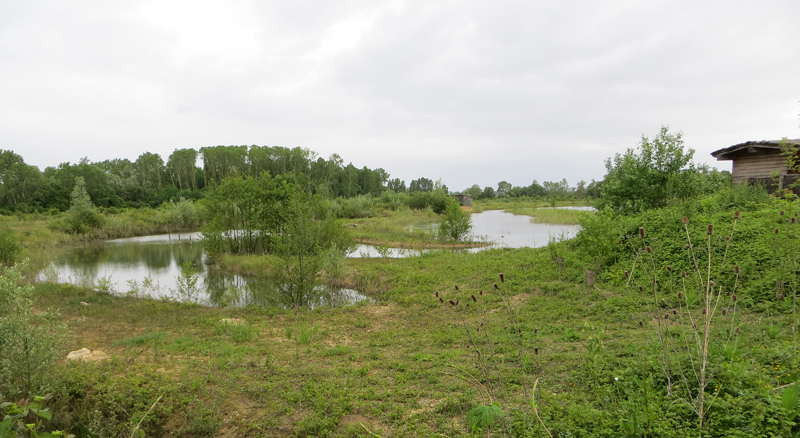
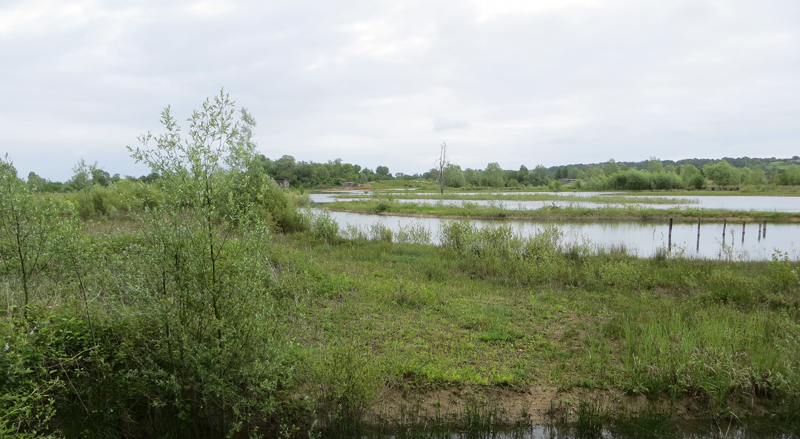
2 January 2016
Turtle Doves
A bit early in the year for these, no doubt, but I've got a few items from last year that I haven't covered as yet. As we all know, numbers of Turtle Doves have declined massively in the UK over recent years, with not much sign of any change in their fortunes, and their range now restricted to eastern England. Although still reasonably common in France, it seems that the same is happening on the other side of the Channel, as ongoing monitoring is showing (see, for instance, the population survey results reported here). The same link will take you to results from studies of satellite-tagged Turtle Doves breeding in France, indicating how they get to and from their west African wintering grounds, in this case in Mali.
In the summer of 2014, the RSPB satellite-tagged a male Turtle Dove in Suffolk, and were able to track him all the way to west Africa and back again, across France, Spain and the Sahara. The bird, named ‘Titan’, wintered in Mali, having covered the distance of 5600 km in about a month. The following spring he was tracked back to Suffolk, and as on the outward journey, again passed through France.
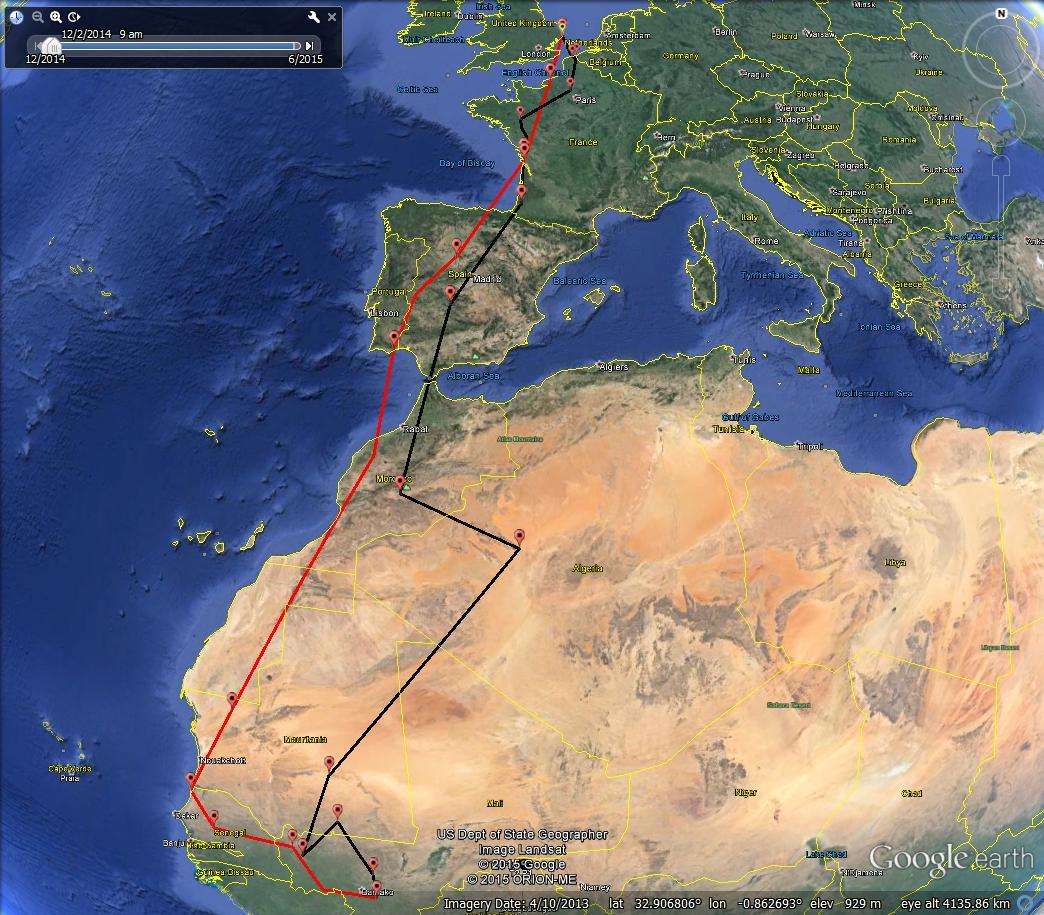
What is particularly interesting is that the spring journey (covered in just a fortnight) took him along the western coast of France, probably past the Pointe de Grave at the mouth of the Gironde near Bordeaux. This was the area where the LPO spent so many spring campaigns trying to get the illegal shooting of these and other birds stopped. They were eventually successful, thereby protecting not only ‘their’ birds but ‘ours’ as well! Nevertheless, the local shooters have recently applied to have an exception made to the ban on spring hunting, but happily their request was rejected by the judges of the Conseil d’État – but it’s a reminder that eternal vigilance is needed to keep the bird-killers at bay.
It’s also good to know that Birdlife International, of which both the LPO and the RSPB are partners, is running an EU-funded project aimed at identifying the conservation needs of 16 charismatic species, of which the Turtle Dove is one, across ten countries (see here for more details of the various species actions plans (SAPs) under consideration).
News items for 2015
29 December 2015
Ornithos
As I've mentioned L'Oiseau Magazine below, I also need to remind everyone of the LPO's more 'scientific' journal, Ornithos, and herewith reproduce a recent cover.

Don't let the word 'scientific' put you off, as it's a very readable publication, and contains much the same sort of material that one would expect from the UK journal 'British Birds', only it's in French, of course. It includes articles on such things as surveys of rare breeding birds, rare migrants and true rarities, censuses of wintering gulls, wildfowl, waders and seabirds, non-native species, identification papers, and a range of reports on studies carried out in France, plus various notes and photographs of recent sightings. As for L'Oiseau Magazine, this is a good time of year to start on a new subscription.
28 December 2015
Honeyguide Wildlife Holidays
This is the period when traditionally one often starts planning one's holiday(s) for the coming year. If this is the case, you might be interested in checking out the offers made by Honeyguide Wildlife Holidays. Their trips are designed with the general naturalist in mind, and the cost of each holiday includes a proportion to be donated to a conservation project in the country concerned, via the Honeyguide Wildlife Charitable Trust. They usually feature at least one such holiday to France, sometimes more, though they like to ring the changes, especially with so many repeat customers. In 2016, they are off to the Dordogne in mid-May, an area rich in flowers and insects, as well as holding a good range of birds such as Bonelli’s Warbler, Black Kite and Hoopoe, among many others. Chris Durdin, who runs the company, has again selected the LPO to be the recipient of the conservation-oriented donations for this particular holiday, as he has done for several years. For more details of the offers available, see their website: www.honeyguide.co.uk.
28 December 2015
The Regional Natural Parks of France
And talking of visiting France, and although I’ve mentioned this before, it’s worth a reminder that this network of parks is well worth investigating, set up as they were to protect and manage the natural resources, landscapes and cultural heritage of various parts of rural France. Their website has more details of where they are, and some at least have downloadable 'where to watch' information about the birdwatching opportunities.
28 December 2015
LPO Catalogue 2016
This is probably of more use to those living in France than those based in the UK, but if you wish to buy a nestbox, feeder, birdbook, etc., etc., you might want to browse through the LPO’s latest catalogue, which you can do on-line. A nestbox designed to attract Hoopoes might not be so easy to find elsewhere, for instance!
27 December 2015
The French Overseas Territories
It is easy to forget that France, like Britain, still retains a range of overseas territories dating from colonial times, with some of them having département status just like the mainland ones – les Départements d'outre-mer (DOM). As such, they are eligible for some EU funding under Life+ programmes. One such five-year programme has recently finished, and some of the translation work for this has occupied my time over the past year. I’ve learnt quite a lot, as have the participants in the various conservation actions, about some very exotic birds – Guianan Cock-of-the-rock, Agami Heron, White-breasted Thrasher – and some equally exotic places – French Guiana, La Réunion, Martinique, where they occur. It would be nice to visit some of them, but, failing that, check out the programme’s website for more information about the project as a whole. At least some of the information there appears in English.
23 December 2015
Thierry Vezon, photographer
I was looking back at the various copies of L’Oiseau Magazine that have piled up since I last updated this site – and where does all the time go? – and was particularly impressed by a series of beautiful photographs taken by Thierry Vezon which appeared in one recent issue. He specialises in landscapes and wildlife, often combined, with many showing the wildlife of southern France, where he lives. The Languedoc, the Camargue, Provence, the Cévennes all feature in his work. As well as exhibiting in various art galleries and at different festivals, he has also published a number of books, all well-illustrated, as one might imagine. To sample his work, his website is well worth a look.
23 December 2015
L’Oiseau Magazine
Talking of L'Oiseau Magazine, I’ll reproduce here the cover of issue 120, marking 30 years since since the magazine was first published.

It gets better and better each year, and many people have said to me that it certainly knocks the ‘house magazines’ of many other organisations into the shade. Once again, with this issue, the design and layout have been updated, and the results are even more striking than before. Not only are the illustrations and photographs wonderfully reproduced, but there is plenty of text, not just snippets, to read and enjoy. At the turn of the year, this is, of course, an ideal opportunity to take out a new subscription or renew an old one!
10 March 2015
White Storks in Champagne-Ardenne
During a brief few days exploring the delights of the Lac du Der and the Forêt d'Orient area at the end of February, a group of us from Bristol duly saw the expected thousands of Cranes on migration, three or four wintering White-tailed Eagles, plenty of Greylag and White-fronted Geese (just one Bean) plus a wide variety of other wildfowl, including several much-appreciated white Smew. Black and Middle Spotted Woodpeckers, Hawfinches, Firecrests and Willow Tits took a bit of tracking down in the woodland, but perseverance paid off in the end. Great White Egrets were everywhere, and we even managed a solitary Spoonbill. But one surprise, as far as I was concerned, was the pair of White Storks on their nest in one of the villages near the Lac du Der. I knew that they were increasing in France, both as a breeding bird and in winter (see below) but I had not seen them here before. But with the French breeding population already around 2000 pairs, the majority along the west and north coasts, plus the long-established ones in Alsace, they are now starting to appear elsewhere, especially in places where the damp grassland they like to feed in occurs.
Although there are historic records of breeding in Champagne-Ardenne dating back to 1869, the first 20th century nesting attempt only took place in 1948, and it was not until 1999 that things started to become somewhat more regular. By 2013, they had become established in the Ardennes area near the Belgian border, with others in the Seine and Aube valleys, and the one pair near the Lac du Der, as shown in the map below.
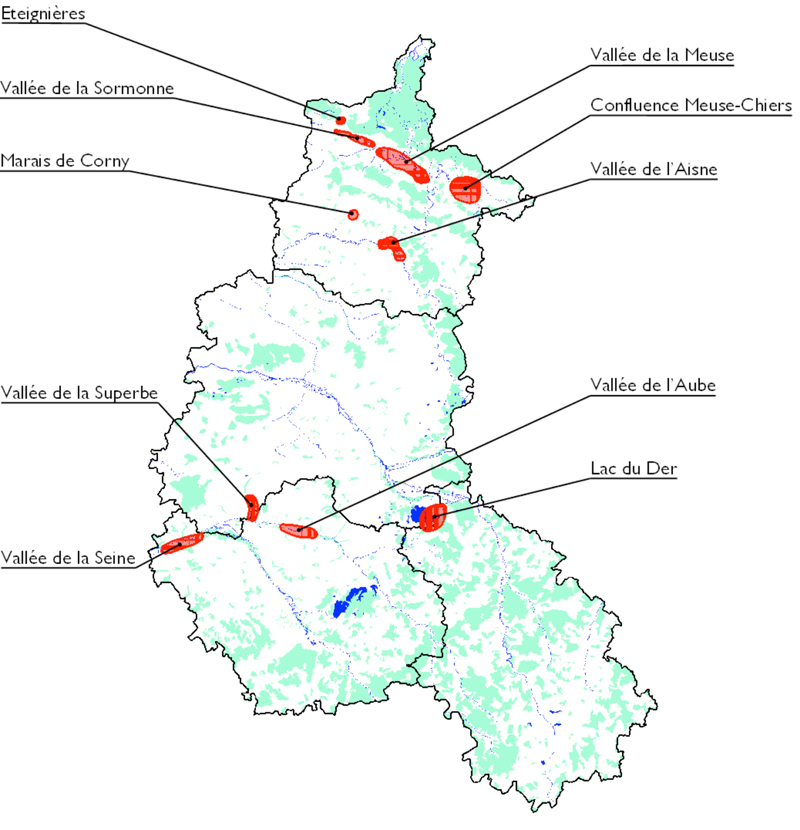
For several years the population hovered between three and six pairs, but more recently numbers have started to rise steadily, with the latest count I could find being 26 pairs in 2013. The graph below shows how the population has developed, and from the behaviour of the two birds we saw on the nest near the Lac du Der, numbers are likely to keep on rising! Thanks to David Wilson for capturing the moment.
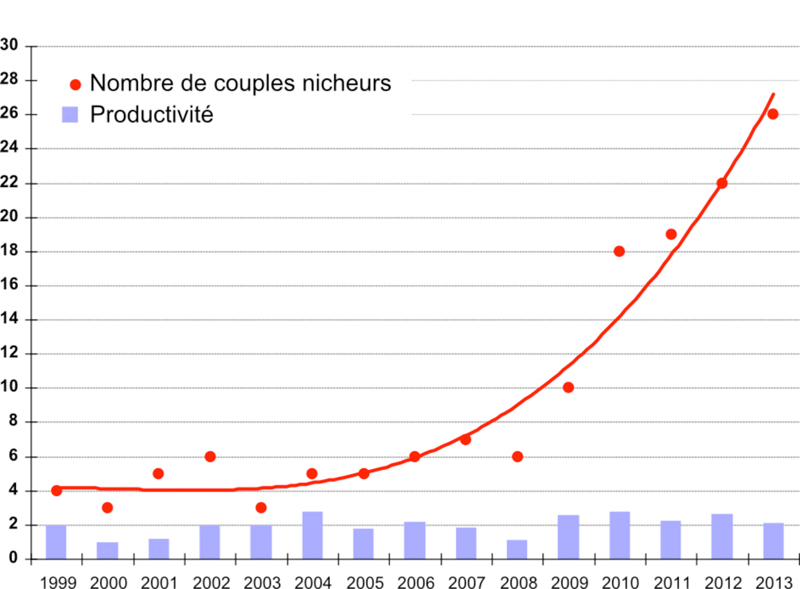
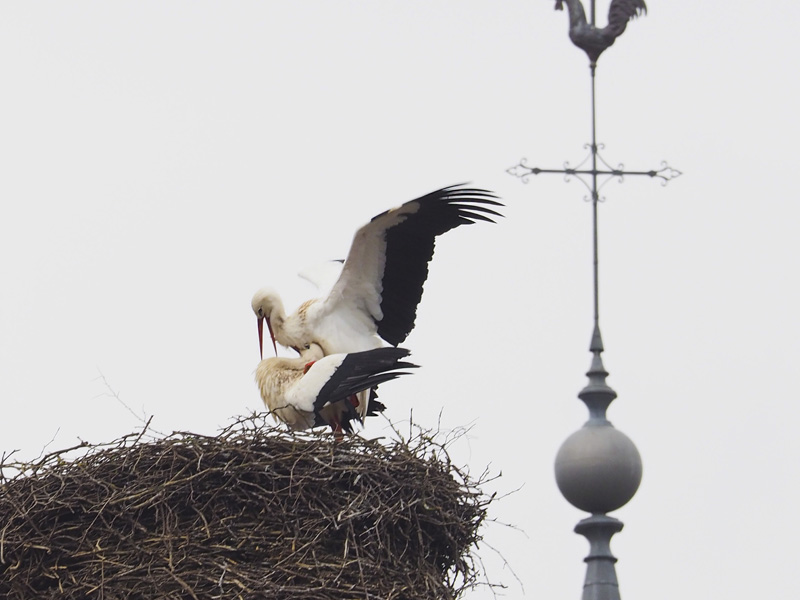
18 February 2015
Little Bitterns
The latest issue of Ornithos (21-6) contains the 2013 report on rare breeding birds in France. One of these is the Little Bittern, and the report takes the opportunity to summarise the results of a special survey which took place in 2012, updating the previous national survey of 2004. In 2012, 279–520 pairs were located, a fall of 40–50% over the intervening eight years. The principal areas where good numbers remain are the Camargue (72–93 pairs), the marshes along the River Somme (53–58 pairs), the Hérault département (15–59 pairs) and the Saône valley (31–44 pairs). Severe declines were evident in the regions of Aquitaine, Centre and Champagne-Ardenne. In many places, the breeding-site habitat does not seem to have changed significantly, but the birds have still disappeared, so conditions on the African wintering grounds may also be implicated. The main strongholds are now to the east and south of France, rather than the north and west, so the appearance of breeding birds in Somerset in recent years is more of a jump than an obvious range expansion.

Thanks to Gary Thoburn for supplying this excellent photo of a species that can often remain hidden in dense reedbeds, only betraying its presence by the male's barking calls. And if you would like see more of Gary's photos, do have a look at his website here.
18 February 2015
French Birdfair 2015 cancelled
I've just seen that the third French Birdfair, scheduled for 29–31 May 2015 has been cancelled, it seems for budgetary reasons. A note can be seen on the website here where presumably details of any replacement will in due course appear. It's a pity, as they have been great places to meet up with other birders and catch up on the news.
18 February 2015
Operation Turtle Dove
Although Operation Turtle Dove is a British-based conservation project, I mention it here because one of the fund-raising activities for 2015 will be taking place in France. A team of six will be sponsored to walk, kayak and cycle from England, through western France, as far as northern Spain, following part of the Turtle Dove's migration route across Europe. This follows a successful sponsored walk undertaken in England in 2014. For more details, see the Dove Step 2 website.
The reason for all this is that Turtle Doves have been declining in Britain for many years, by 93% since the 1970s. In France they are still reasonably widespread, although numbers there are also nowhere near what they were, and for much the same reasons as in the UK, notably habitat changes and lack of suitable food. During the migration seasons, it has been a favoured target both in spring and autumn, and this is hardly a sustainable practice for a species in such dire straits. Thanks in great part to the sterling efforts of the LPO the spring shooting that used to take place in the Médoc area of western France has now been stopped, although there were some pretty nasty clashes with shooters along the way. Unfortunately, spring hunting in Malta is still permitted, but one hopes that a referendum there in April this year will show that the majority are against it.
17 January 2015
Subscribing to the LPO
As I remind people every year, this is perhap the most ideal time to join the LPO and to subscribe to either Ornithos or L'Oiseau Magazine or both. Details (in French) about the contents of recent issues of both publications can be found via the LPO's main website on http://www.lpo.fr. Subscriptions to the LPO are on a calendar-year basis, but subscriptions to the publications can start at any time and run for a year from the first issue subscribed to. If like me you are not the best organised person in the world, an ideal solution is to start everything in January, and get it all out of the way at one go. Current UK subscription rates and associated details can be found on http://www.kjhall.org.uk/subscriptions.htm.
However, having said all that, it appears that they still have not fully sorted out the on-line subscription system. If you have problems with this, it is probably best to print off the form which can be found here, fill in your name, address and credit card details, post the form off to Rochefort (the address is on the form). Existing members/subscribers will receive a reminder from Rochefort, and can pay direct to them, using a similar form. In all cases, remember to add in the UK postage for L'Oiseau Magazine (I've included it on my subscriptions page). If you still are having problems, please let me know, and I'll see if I can sort things out with Rochefort on your behalf.
12 January 2015
Corncrakes
The EU-funded LIFE+ programme aimed at saving the Corncrakes of France from extinction (see also below) enters its final year in 2015, and the latest information bulletin about the project contains a summary of current status, at least for some key sites. In the Charente valley, near Saintes, between five and seven calling males were located. The farmers concerned were contacted immediately, with a view to leaving those particular hay-meadows untouched. The mixed weather in August also helped, so there was no problem in waiting until mid-month before hay-cutting commenced, an ideal date as far as Corncrake survival is concerned. One of the farmers said that he had seen five Corncrakes during harvesting operations, including some young, evidence that at least some of the birds had bred successfully.
The middle section of the River Oise valley in Picardy is another area where the LPO is monitoring the situation, and here between 30 and 32 males were heard, one of the highest counts of recent years. It appears that they arrived quite late in the season, peaking in mid-June, with calling heard through to mid-July. Several areas were quickly given extra protection, in cooperation with the local farmers, and when hay-cutting took place the machines were accompanied by counters to judge how effective the extra measures might have been. Several young were seen in the protected areas, but none elsewhere, which indicates that there must have been some positive effects.
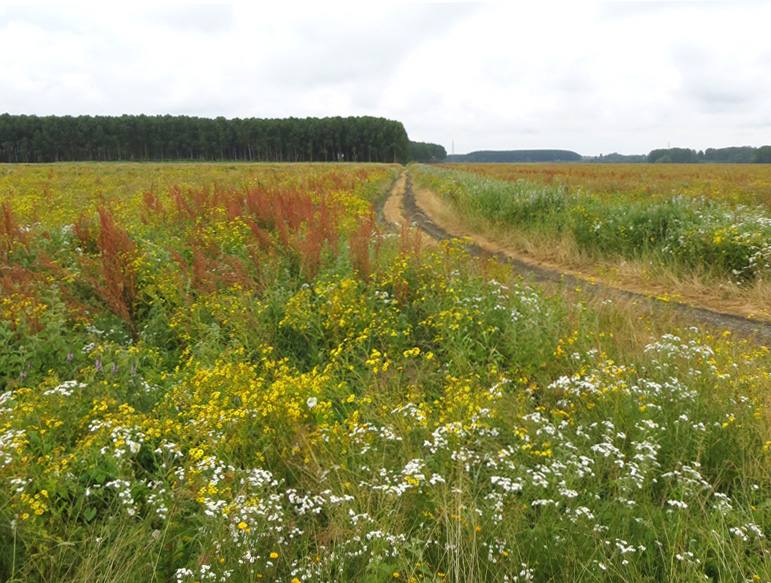
The third area surveyed was the Basses Vallées Angevines near Angers in the Loire valley. Although there had been 225 calling males here in 2011, two very wet summers since then, and some extensive flooding, had seen numbers drop to just 78 in 2013. With a much more favourable season weather-wise in 2014, numbers have crept up to 90, hopefully the start of a sustained recovery. At all the sites, in addition to managing the meadows in a traditional way, and delaying the harvest until late in the season, the other main habitat modification has been to maintain strips of vegetation uncut along the edges of the fields and watercourses, so that the young, which may still be flightless, have some refuge habitat to hide in while they continue to mature. Not only are these areas good for Corncrakes, but other species such as Whinchats and Reed Warblers also seem to gravitate to them, particularly on migration.
12 January 2015
Vienne 2014
LPO-Vienne is one the LPO's more active groups, and their latest newsletter gives some results from their surveys in 2014. The plains north-west of Poitiers hold the remnants of the formerly widespread Little Bustards of arable farmland in France. Sample counts are made each year to ascertain how well the protection measures in place are doing. In one key section, 105 calling males were noted, the fourth consecutive year that a small increase has been noted here. In addition, simultaneous counts made on 16th September of post-breeding flocks came up with a total of 234 individuals, as opposed to 179 in 2013. So some encouraging news there. Stone Curlews also form pre-migration flocks, and on 11th October a total of 2040 birds were counted, spread over 40 sites. Again, this is the fourth year in a row when the magic figure of 2000 has been exceeded. The Montagu's and Hen Harriers that breed in the same general area also did quite well, linked to the high numbers of small rodents present, as well as to the essential location and protection of individual nests, so that they can be avoided during the harvest. A Marsh Harrier nest was also located in farmland, a first for the area, even if perhaps not the best choice of site by the birds themselves. Conversely, the harriers that breed in the heathland habitat around the Pinail and Moulière forests near Poitiers continue to do badly, for reasons that are unclear, with just eight and two pairs of Montagu's and Hen Harriers respectively. However, with six pairs of Peregrines and at least three of Short-toed Eagles nesting in the département, its raptor population is quite an impressive one. Among smaller birds, Bee-eater numbers bounced back after a poor 2013, with 61 pairs located, the nests being associated with sand and gravel extraction, as well with riverbanks where the vegetation does not encroach too much. Dartford Warblers also increased in numbers in the Pinail/Moulière area, having previously been adversely affected by a couple of severe winters. The farmland north-west of Poitiers also holds a relictual population of Ortolans, among the most northerly in France, and a special survey located nearly 100 singing males. A programme of tree-planting in chosen areas is underway, as this is a species that likes song-posts scattered through the otherwise open habitat that it favours.
12 January 2015
Loire 2014
The news from the LPO-Loire group, based in the Loire département, which includes the upper reaches of the river of that name, is rather more mixed for 2014. The majority of the Montagu's Harriers that nest there do so in more 'natural' habitats, such as uncultivated ground, plus a few in hay-meadows and only one in cereal crops. A total of 23 pairs was located, much the same as normal, of which 20 bred successfully, fledging 38 young, only five nests needing to be specifically protected from farming activities. Of the 11 pairs of Red Kites monitored, the success rate was very high, with 21 young fledging, but overall the number of breeding pairs fell once again. The situation for Great Grey Shrikes was even worse, with only two pairs noted in 2014, where there had been ten previously, and of those only one nest succeeded, raising four young, while the other nest was predated by a Carrion Crow. This is one species whose long-term future as a breeding bird in France is very much in doubt, unfortunately.
12 January 2015
Red Kites in winter
The annual count of Red Kites wintering in France has just taken place for 2015, although the results will not be published for some time. In the meantime, I thought it was worth including here the results for 2014, just published, to compare them with those of 2012 below. It is evident that the distribution is much as before, with the numbers having increased to 7703 in total (7052 in 2012). Although any increase is welcome news, differences in weather and observer effort make drawing any definite conclusions quite difficult. As far as the French population is concerned, poisoning as a side-effect of rodenticides remains a big problem, and it is worrying to think that this may also affect migrants from Germany, some of which will be wintering here.
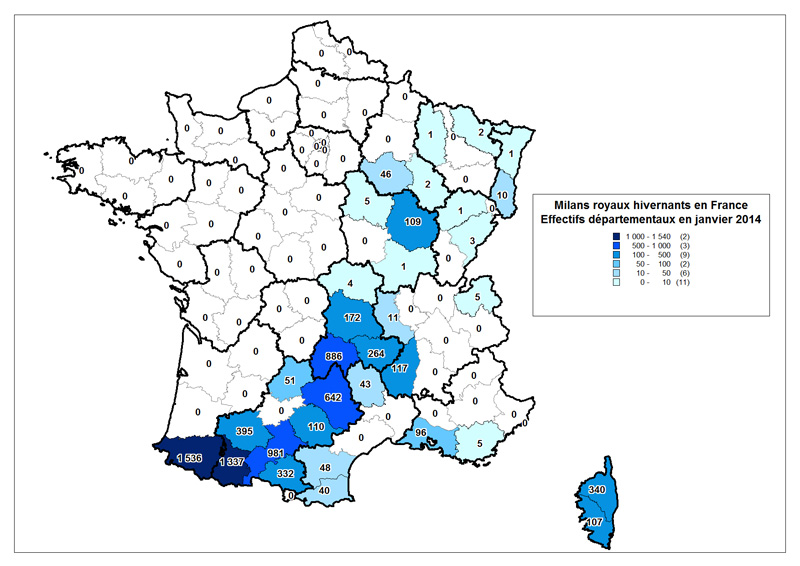
News items for 2014
22 December 2014
A miscellany of recent status updates
Published in 2008, the 'Nouvel inventaire des Oiseaux de France' (NIOF) provided an overview of the French avifauna as it stood at that date, and is an essential reference for anyone interested in the birds of France. However, time does not stand still, and bird populations continue to change, some for the better, others for the worse. Perhaps at some time in the future another edition will appear (this one was a revision of one published in 2000), but interim updates are produced from time to time for selected species, and the latest one of these has appeared in Ornithos 21-4 (2014). I've picked out a few items which might be of most interest to UK readers, but the whole article is well worth a read. And, of course, a subscription to the journal might make a good Christmas present!
Waterbirds. Bewick's Swans winter in small numbers in France, but record numbers were noted in a couple of years at two of their main sites, the Camargue (230 in January 2001) and the Lac du Der, Champagne-Ardenne (281 in January 2014) – encouraging counts for a species that is in worrying decline in Europe as a whole. The numbers of Dark-bellied Brent Geese wintering in France are of international significance, and a record of 164,553 birds were counted in November 2012, estimated at 67% of the world population. Their pale-bellied relatives also seem to be doing well, the 1707 individuals counted in January 2012 also constituting a new record, the majority being birds that breed in Canada. Among introduced species, around 200 breeding pairs of Egyptian Geese were counted in 2011, with up to 1000 individuals in the country as a whole. Mandarin Ducks continue to nest in small numbers, with 27–36 pairs noted in 2011, primarily in the region of Nantes. Mallard, obviously, are common in France, but it was interesting to know that around 1.4 million of them are released each year for shooting purposes. Many of them die, either shot but also because they are less resistant to disease, and although they seem not too 'pollute' the wild population too badly they are a potential source of avian flu, all the evidence pointing to this being primarily a disease originating in domestic poultry, despite claims to the contrary from those involved in the industry. Possibly related to climatic warming, a decline has been noted in recent years in both Scaup and Goldeneye numbers, France being on the southern edge of their winter ranges.
Seabirds. In recent years the Brittany and west English Channel coasts have become noted for significant numbers of non-breeding Balearic Shearwaters from the Spanish Mediterranean, with 1500 counted in November 2012 in the baie de Douarnenez while, further south, there were 1225 off Tarnos (Landes) in November 2006. On the other hand, studies of Yelkouan Shearwaters breeding on the Mediterranean coast of France indicate that their feeding movements at this time are out into relatively nearby waters, perhaps as far as the coast of Spain, but no further towards the Straits of Gibraltar. In winter, about a third may move towards the Black Sea and the eastern Mediterranean, but again there is no evidence of any movement out into the Atlantic. The source of one photographed off the Basque coast near St-Jean-de-Luz is therefore a mystery, the same holding for recent claims of birds seen in British waters.
Herons. The severe weather of February 2012 seems to have caused a marked diminution in the numbers of most of the heron species breeding in France, and may account for knock-on effects in the UK. The number of Night Heron pairs nesting in the Camargue fell from 749 in 2010 to 326 in 2012, and similarly Squacco Heron numbers fell from 805 pairs to 204 in the same period. The number of pairs of Cattle Egrets in the same area fell to 2545 in 2012 (there had been 7880 in 2008), while closer to the UK, there were only two pairs at Marquenterre, on the Somme estuary, in 2012 against 26 in 2007, and the Lac de Grand-Lieu population, near Nantes, fell from 1081 in 2008 to 253 in 2012. This might go some way towards explaining why they have not colonised the UK as fast as was initially hoped. On the other hand, Great White Egrets seem to be made of sturdier stuff, and continue to expand their range, and only small declines were noted in their breeding colonies, one of which, in the Lac de Grand-Lieu area, being the source of several birds seen in the UK. Glossy Ibises also suffered from the cold weather, but bounced back quickly in 2013, while Spoonbill numbers seem to be increasing steadily (560–624 pairs in 2012), perhaps because they mostly move south for the winter.
Crakes. In 2012, there were two proved breeding records for Baillon's Crake in France, plus two probables and three calling males, a record high for recent years. This was the year when up to six pairs bred in the UK as well, so the influx was clearly quite widespread. On the other hand, the cold weather of that year's February knocked back Purple Gallinule numbers, hopefully just a temporary blip in their expansion along the Mediterranean coast from Spain.
Gulls. A staggering 17,000 Little Gulls were noted migrating past Cap Gris-Nez (Pas-de-Calais) in spring 2013, with a record 3865 counted on just 9th March. Roof-top nesting by Herring Gulls, a common feature in the UK, also occurs in France, with about 3000 pairs in Lorient (Brittany), no natural site holding numbers anywhere near as large. Yellow-legged Gulls have also started doing the same, with four pairs noted in an industrial area of Angers in 2014.
Non-passerines. London is not the only capital city with a large population of Ring-necked Parakeets, as nearly 3000 individuals were estimated to be present in the greater Paris area in 2013, with scattered pairs in other large conurbations.
Passerines. In addition to the well-known site on La Crau (Bouches-du-Rhône), small numbers of wintering Richard's Pipits have recently been noted at various sites along the north, west and Mediterranean coasts of France, possibly accounting for at least some of the autumn migrants seen in Britain. We may have to wait a bit longer to see another Fan-tailed Warbler in Britain, as the cold winters of 2009 and 2012 severely reduced their numbers in many areas of France, after they had been steadily increasing their range northwards in recent years. Aquatic Warblers are regular autumn migrants through western France, but ringing has recently discovered them passing through Langudoc-Roussillon in spring, notably in the second half of April. Such 'circular' migration strategies are widespread among many other species, of course. Genetic analysis has shown that at least some of the Red-billed Choughs now nesting in Cornwall have come from Ireland, but the fact that a chick ringed on the island of Ouessant at the tip of Brittany in 2007 was seen in Devon and Cornwall in February/March 2014 shows that France could well be another source. Finally, bearing in mind how sparse the British population has become, the count of 13,800 Hawfinches during the autumn migration season at Ceyzériat (Ain), in eastern France, indicates that there must be some good breeding populations somewhere!
18 December 2014
Wintering Cranes
I'm sorry about the gap in communications, but I've been away quite a lot recently, not always in France. But I was there last week, specifically making a visit to the reserve at Arjuzanx, in the Landes region of south-west France. In recent years this area has held the largest numbers of wintering Cranes in France, the birds feeding in the maize fields which occupy part of an area which is mainly a vast pine forest. As everywhere, Cranes also need a secure place to roost and here this is provided by a former lignite mine, now transformed into a nature reserve (see here for more details). The reserve centre is currently in an old building just off the road between the village of Arjuzanx and nearby Morcenx, but will be moving to a new building, currently under construction, on the shore of one of the large lakes created when the mine closed. It is possible to see the Cranes feeding in the fields during the day, mostly to the north of the area of the reserve, and as long as you don't get out of your vehicle, the birds can be watched at reasonably close range from the roadside.
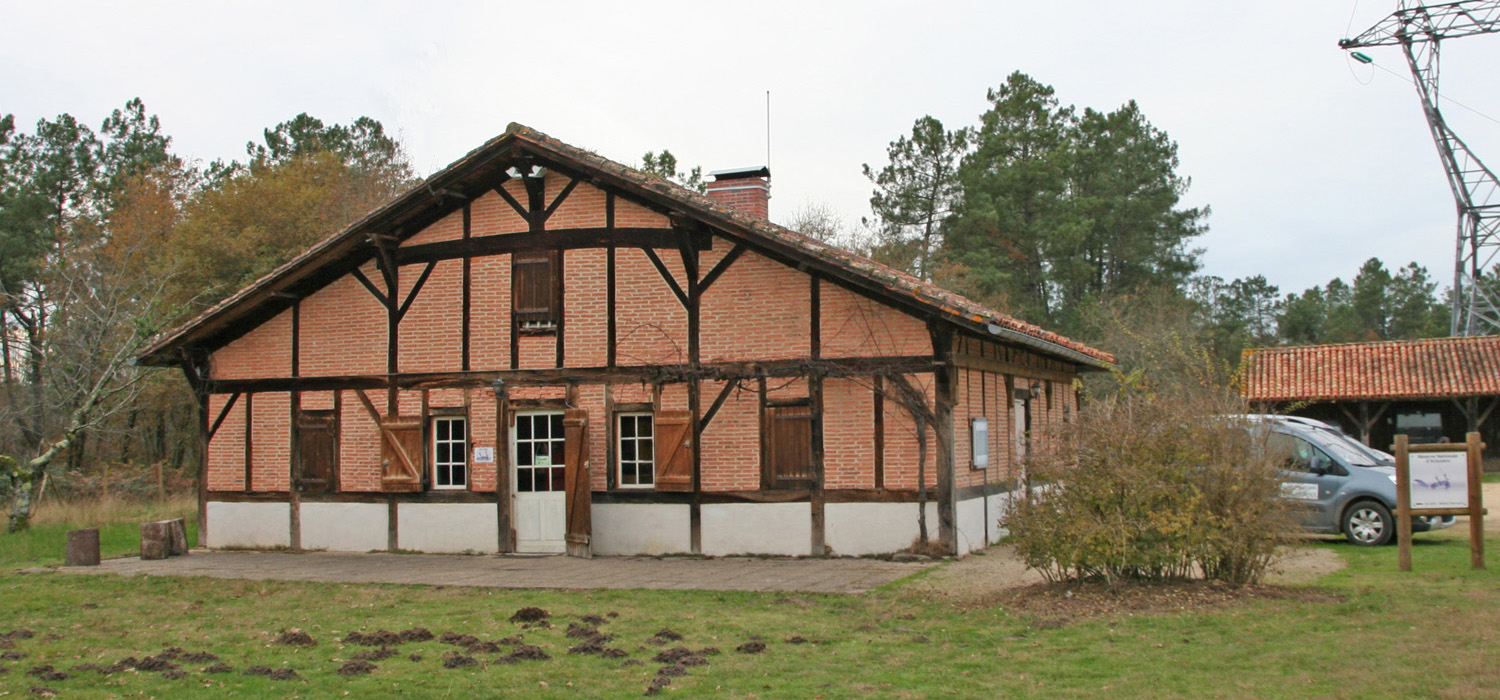
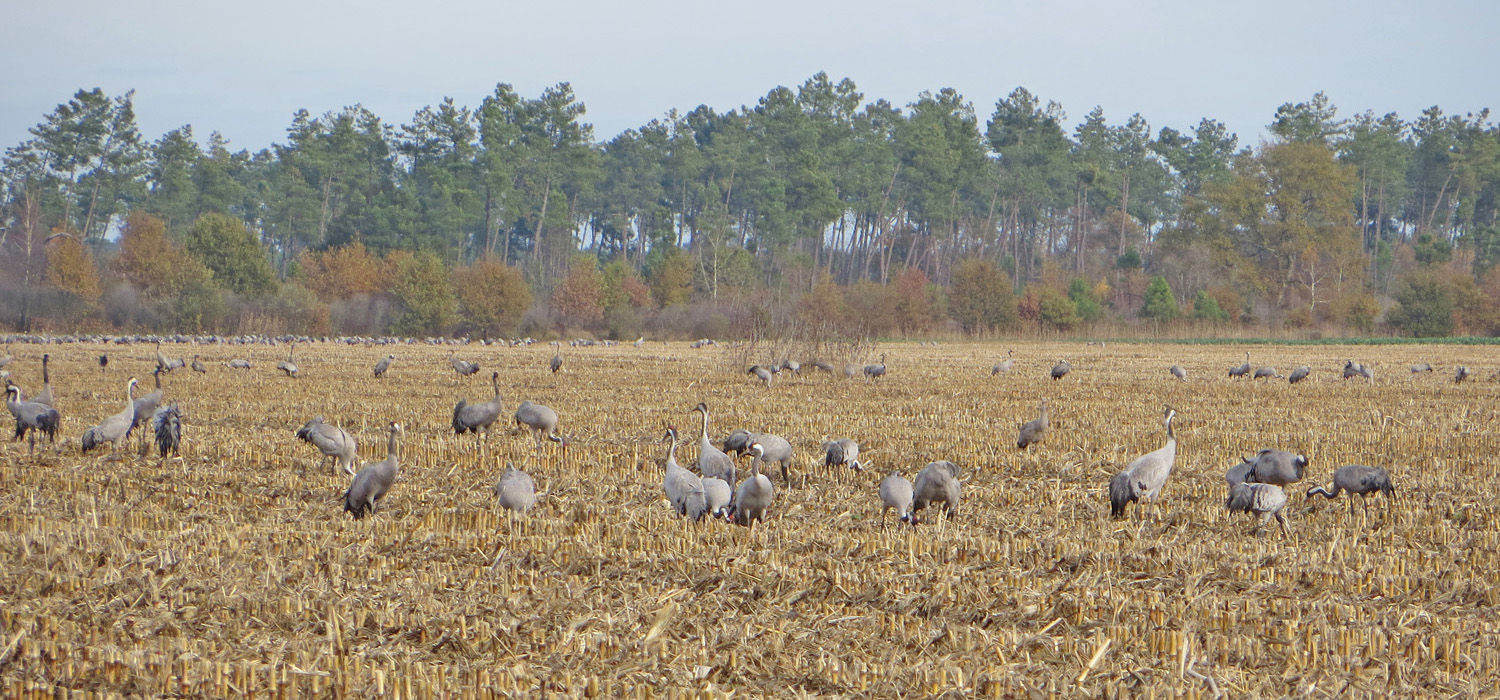
However, participants on an escorted evening visit into the reserve itself can experience the amazing spectacle of the birds coming in to their roost. Space on each trip is limited, so it is essential to book in advance, but I was lucky enough to get a place on the 12th December. You are escorted through a wilderness of pools, bushes and forest, in itself an outstanding habitat for a wide range of flora and fauna (we saw wild boar and roe deer during the visit), to a magnificent tower hide.
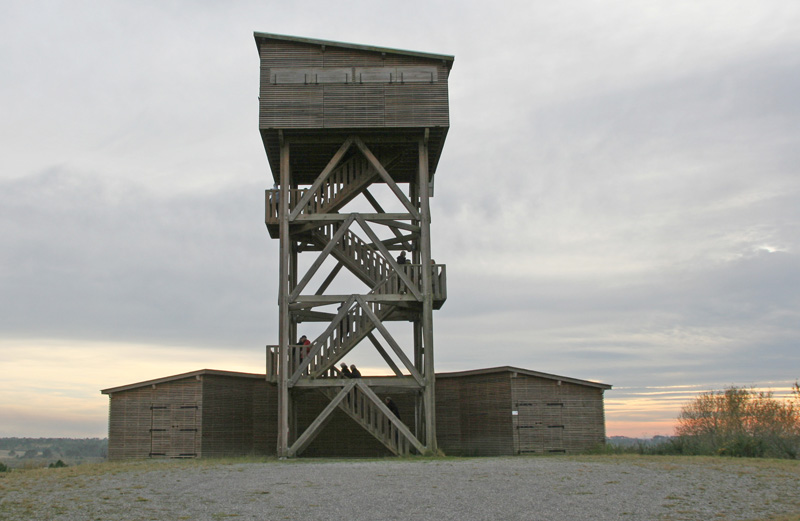
This overlooks the fields where the birds come to rest and preen, before they move the short distance to the areas of shallow water where they actually roost – apparently they like to have their feet in water at night to feel safer from predators.
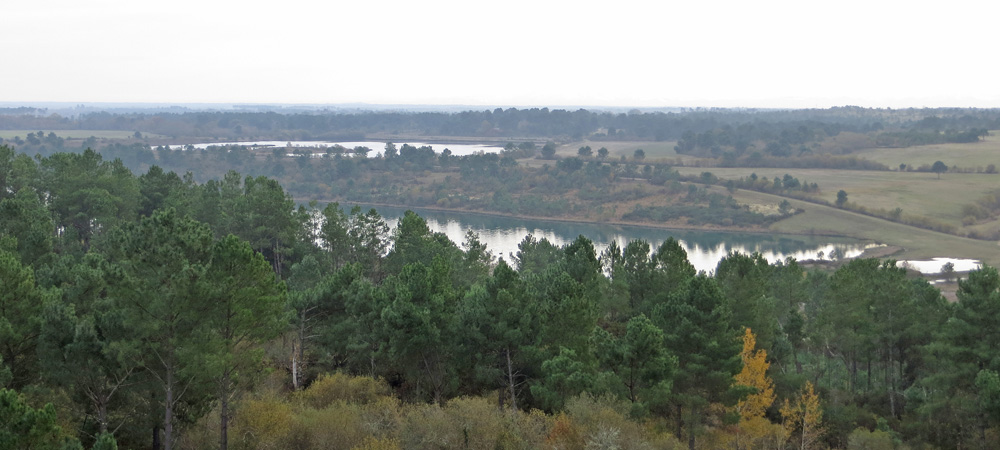
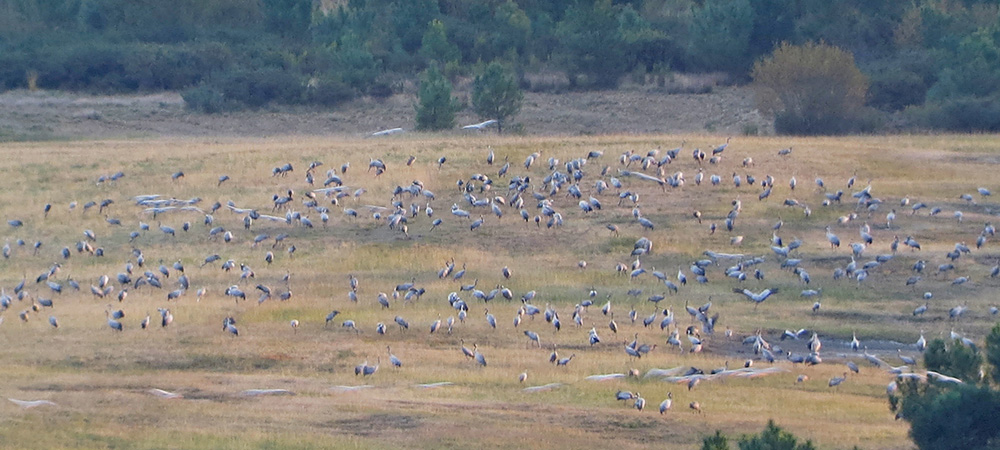
As dusk falls, the birds arrive in 'V' formation or straggling lines, calling all the time, and come close to the hide as they pass. An amazing spectacle, especially as on that evening there was a wonderful sunset with the chain of the Pyrenees clearly visible in the background on the southern horizon. Apparently there were 'only' 17,500 Cranes there at the moment – there were more than twice that number at the same time last year – probably because the mild weather has meant that they are still further north, at sites like the Lac du Der in the Champagne-Ardenne area.
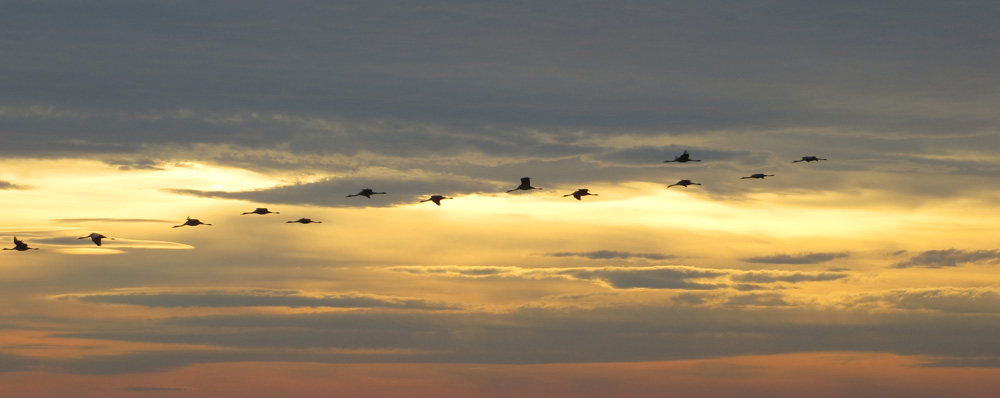
Concerning the Lac du Der, a fellow LPO member, Caroline Morton, kindly drew my attention to this website which has some current information about what is there, and includes some video – a taster for the real thing.
24 August 2014
Changes in breeding bird numbers in France
A report in Ornithos 21-3 (2014) summarises recent trends in the populations of breeding birds in France, the story being a broadly familiar one, with 'common' birds faring much worse than rarer ones. The latter have been monitored closely for many years, and many of them benefit from special protection measures. Hence species such as the vultures and scarcer birds of prey have seen their numbers stabilise and often increase, while species such as Buzzard, Kestrel and Sparrowhawk are showing signs of a recent decline, albeit after some important increases over the longer period since the 1960s. White Storks, Great White Egrets and Spoonbills have also increased in numbers, as their nesting sites and the birds themselves benefit from better protection. Likewise, seabirds such as the Gannets breeding in Brittany have also done well in recent years.
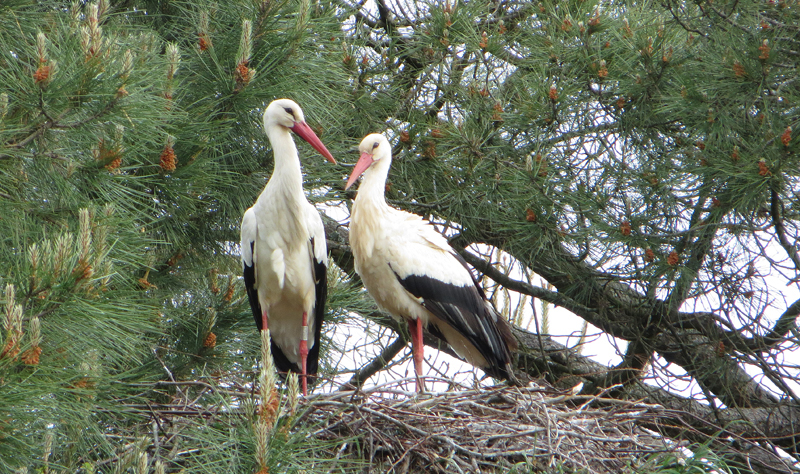
But with farmland birds, the story is much the same as in the UK, with significant declines in species such as, for instance, Skylark and Whinchat, the latter also seeing its range increasingly fragmented and restricted to more upland areas, and even there land-use changes are having an effect. Climate also seems to be involved, with the range of 'northern' species such as Willow Tit having pulled back to the east of the country, while 'mediterranean' species like Sardinian Warbler have started to expand north and west. Conserving key sites and habitats is clearly a priority, but limiting the effects of industrial and agricultural intensification is proving difficult to achieve.
24 August 2014
Index to Ornithos, Vols 1–20
The contents lists of the first twenty volumes of Ornithos are now available on-line for download from http://www.lpo.fr/revues/index-ornithos. The same site also has indexed species lists for each volume, again available for download. In both cases the format is PDF, which can easily be searched by keyword to find any article, subject or species of particular interest.
24 August 2014
Good news and bad about vultures
First the good news – the French population of Lammergeiers has increased to 39 pairs this year. All the territories were, as usual, closely monitored, and 13 young fledged successfully. More details are given on the Vulture Conservation Foundation website here.
The bad news is that an Egyptian Vulture found dead in the western Pyrenees had been poisoned by an illegal pesticide, probably after eating a poisoned bait, or the remains of an animal that itself had eaten a poisoned bait. More details are given here, and the LPO is pursuing the case through the French legal system. The same insecticide was involved in poisoning incidents in the eastern Pyrenees in 2009 and 2012 when two Egyptian Vultures, eight Griffon Vultures and a Black Kite were found dead in that region. Thanks to the efforts of the LPO and other conservation bodies, the numbers of Egyptian Vultures are slowly increasing, but the French Pyrenean population is only about 73 pairs, of which 45 are at the western end of the chain, and certainly cannot afford to sustain such losses.
24 August 2014
Seabird wreck
Although rather 'old news' now, it is still perhaps worth noting that the numbers of seabirds cast up on the western shores of France in the first three months of 2014 were quite staggering. More than 43,500 birds, of which only 3234 were rescued, were counted along the Vendée and Charente-Maritime coasts, more than 65% (27,745) of them being Puffins and 27% (11,801) being Guillemots. Significant numbers of Razorbills, Kittiwakes and Gannets were also found, although the full list of species was extensive, even including Little Auk and Brunnich's Guillemot. The principle cause of death seemed to be lack of food and exhaustion, following days and weeks of severe gales which would have stopped the birds being able to feed efficiently. The same gales also caused significant numbers of deaths of seabirds in the UK and Spain, and it remains to be seen what effect this will have had on breeding populations in north-west Europe. At the same time, the gales and high tides along the west coast of France caused significant erosion and incursions of salt water into several of the LPO's reserves, most notably at their newest at Belle Henriette. Management plans will no doubt need modification in many cases as sea-levels continue to rise.
21 June 2014
Terns
One of many reasons for subscribing to the journal Ornithos is that it contains the annual report on rare breeding birds. The latest report covers 2012, and it is interesting to compare the fortunes of the various tern species that breed in France. Common and Little Terns are both widespread, and thus do not feature in the report, and the Arctic Tern's distribution is more northerly, although the odd pair sometimes makes an attempt. Sandwich Terns are classified as rare breeders although in 2012 they had a record year, with 7315–8364 pairs estimated, bouncing back from the previous year when there were only 4950–6865. Although there are colonies in Languedoc and near Calais, about half are found on the Atlantic coast, the Banc d'Arguin off Arcachon holding the largest colony, with a further quarter at various sites in Brittany.
This last area is the stronghold of Roseate Terns in France, and after a poor year in 2011, with no young reared at all, their numbers rose to 33–38, with 31 chicks fledging. They breed on various offshore islands, but are much prone to desert because of the presence of predators such as crows and large gulls. The Mediterranean coast, primarily in the Hérault and Camargue areas, is where you have to go to find Gull-billed Terns, with 688–746 pairs another small increase after several years of steady recovery, although productivity remains low.
The two other breeding species have primarily inland distributions. Whiskered Terns have fluctuated around 3500 pairs for several years, and 2012 was no exception. The Lac de Grand-Lieu held the biggest concentration, with 1524 pairs, 42.8% of the French population, while La Brenne is another important site, with 1036 pairs, 29% of the total. The species is very dependent on lagoons with floating vegetation on which it makes its nest, and these only occur at a few scattered sites. These vary in suitability from year to year, as some of the ponds are drained temporarily as part of their use for fish-rearing.
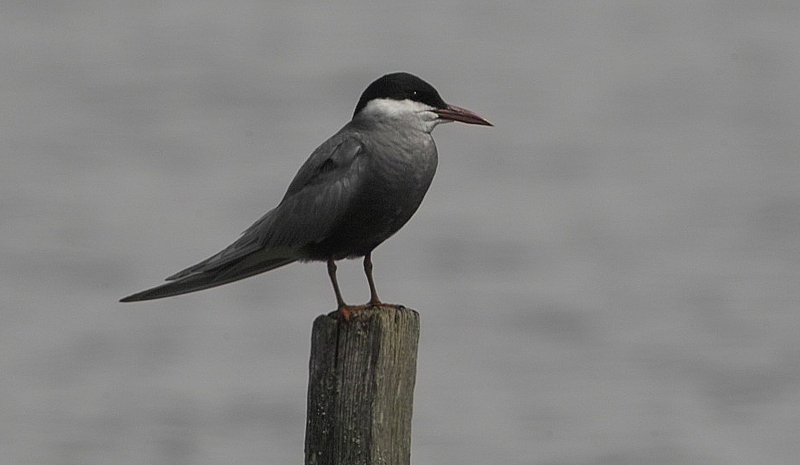
Black Terns are much less common, and 2012 was a disastrous year, with only 93–97 pairs located (in recent years there have been 200 plus) The dreadful weather was largely responsible for the loss of the main colony in the Brière, while the other small colonies, mostly in west coast wetlands, suffered losses from crows and gulls, despite most of the sites being under some sort of protection.
21 June 2014
Black Storks
According to the LPO's most recent newsletter devoted to Black Storks, it appears that the breeding population is holding steady. In 2013 a total of 33 nests were discovered, of which 23 were successful. The key area is north-east France, with the Ardennes département holding most nests, nine in all. This is a species which, despite its size, is very difficult to track down, with feeding birds ranging up to 20 km from the nest. Bearing this in mind, the most reasonable assessment of the total population is around 60 pairs.
Several of the birds have been satellite-tagged, and results so far indicate the main wintering area to be in West Africa (e.g. Mauritania, Senegal, Nigeria), but also that there is some interchange with the German population, with birds born in France subsequently nesting there. An adult marked at the nest in Haute-Marne in August 2011 provided much useful information until sadly it flew into electricity cables near Toledo, Spain, on its return journey in March 2013. In between it had wintered in the same area of Senegal three times, and also returned to Haute-Marne for the intervening summers. It is interesting to note that there could be up to six weeks between its crossing the Pyrenees in mid-late August, and crossing the Straits of Gibraltar in late September. In the spring, however, it took only eight days to get from Gibraltar to the breeding grounds.
For more information, see the site www.cigogne-noire.fr. It appears at the moment that the 2014 population is much the same as in 2013.
20 June 2014
Abbaye de Fontevraud designated as a Refuge LPO
The Abbaye de Fontevraud, close to the River Loire between Saumur and Chinon, has long been a popular tourist site, particularly for those interested in both British and French history, as it contains the tombs of Henry II of England, of his wife, Eleanor of Aquitaine, of their son, Richard the Lionheart, and of Isabelle of Angoulême, wife of King John, Henry’s youngest son. Among birders, however, it is perhaps better known as being the most northerly breeding site for Rock Sparrows, which continue to survive here, despite the renovation work that has been carried out over recent years.
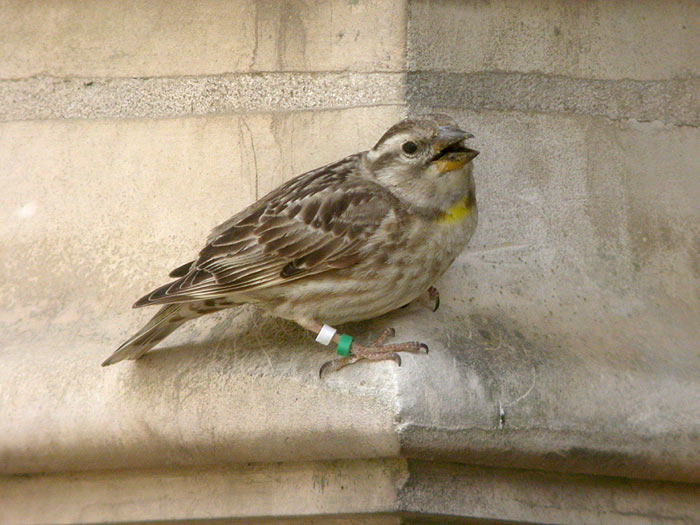
The authorities responsible for the upkeep of the abbey are keen to make the site as eco-friendly as possible, and have installed a new energy centre incorporating wood burners, solar panels, rainwater recuperation and waste recycling. In addition, the surroundings are being replanted with wild-flower meadows, hedgerows and pesticide-free grazing, and more provision for the hole-nesting Rock Sparrows is being made. The local population of these sparrows has been studied closely for several years, with many of them colour-ringed, and it is hoped that these actions can only but help maintain this relatively isolated colony. To underline the site's commitment to its on-going sustainable development, it has recently been incorporated into the LPO's network of Refuges, the formal signing taking place on 16th May.
20 June 2014
Corncrakes in the Charente valley
The Corncrake is a species that has suffered badly under modern farming practices and in France, as in the UK, has been pushed back to a small number of sites where the meadows in which it nests are managed specifically with the bird in mind, notably by delaying hay-cutting until after the young have fledged. One area where a few pairs still breed is the middle valley of the River Charente. An action plan, supported by EU Life+ funding, is running at the moment, targeting this area as well as a couple of others in France where birds still survive (the flood meadows near Angers, the Oise valley in Picardy). As part of this project, a nocturnal survey listening out for calling males took place recently, with eight birds located, a significant increase on the two or three that were all that could be found in 2012 and 2013. Let's hope that this is just the start of a successful recolonisation and a reward for the management being carried out in conjunction with the local farmers.
21 May 2014
An invasion of Red Kites?
The fact that 71 Red Kites appeared near Land's End on 15th May, along with four Black Kites and a Honey Buzzard seems to suggest that they have all come across the Channel. I've mused about this in the past, and although this event seems more convincing than most, there is still little evidence from the French side that the Red Kites have come from there. Their main migration period is in March, although some immatures do move through later, and their trajectory is nowhere near north-west France. Their main continental breeding sites are no nearer than eastern France, and winter/spring records from north-west France are rare. The breeding populations now in Britain are all much nearer to Cornwall and will soon become bigger, in fact. There seem to be five records of British-marked birds noted in France and one in Spain, and although this will be only a partial picture, it seems unlikely that large numbers are crossing the Channel in the autumn, especially as it's hard to locate records of them being seen to do so. One has to ask, if 71 are coming back in the spring, when did they leave this country, and by which route?
At the Pointe de la Hague, a long-standing seawatching site at the top of the Cherbourg peninsula, a Red Kite was seen heading towards England on 13th April, but this was the first one ever recorded there, and they are otherwise unusual in Normandy. During daily counts at the Pointe de Grave, a spring migration hotspot on the west coast near Bordeaux, 1600 Black Kites have been counted this year from the beginning of March to 18th May, but just one Red (on 1st April). During the whole 2013 season, only two Red Kites were noted here, one in March, one in May.
There is an active sightings website for Brittany, and during the period 6th–19th May, no Red Kites were seen (they would certainly have been worth a mention if they had been), and only one Black Kite (near Rennes on 6 May) was north of the tiny breeding population near the Loire estuary, the northern edge of their range in this part of France. I also found a record of a Black Kite seen between 3rd and 8th May near Rouen in Normandy, as worthy of mention there as it would have been in England. Both these Black Kite records are typical dates for spring vagrants.
It seems hard to believe that so many migrant Red Kites would have been missed on the French side, even allowing for the fact that there are fewer observers (but still quite a lot these days) over there, especially as subsequent to their arrival in Cornwall, there have been many sightings of them elsewhere in Cornwall, Devon and Somerset, with birds well within range of the naked eye. If they had been coming from further south in Europe, why should they change their migration strategy from being too high to be seen with the naked eye to flying at low level once they had crossed the Channel?
So how did they arrive at Land's End unseen, bearing in mind that there were relatively few sightings in south-west England prior to 15th May? One can only speculate, but the weather at that time changed from dull, wet and windy to anticyclonic with blue skies and warm sunshine. It may be that this prompted non-breeding birds to go for a wander, and that they circled up very high in doing so. It is likely that most of these wandering birds are sub-adults. For instance, Robin Morrison has kindly supplied the image below of a bird he saw in Somerset near Curry Rivel on 4th May, which shows pale tips to the underwing coverts and pale breast streaks, both retained from its juvenile plumage.
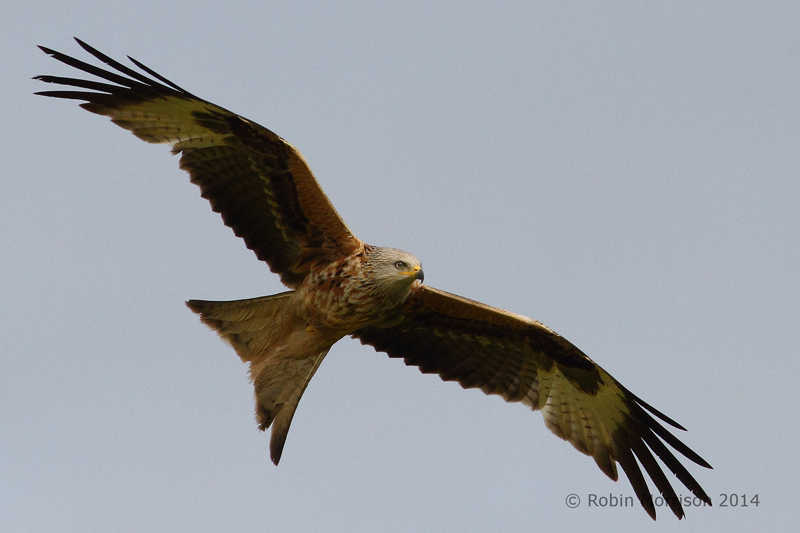
The strategy of dispersing immature Red Kites may well be different from that of purposeful migrants, which are often fairly easy to spot from ground-level if you are looking out for them. Assuming that this batch headed south-west they would have been aware, at height, that Land's End was as far as it was sensible to go, so then dropped down to ground level. The same anticyclonic conditions may have prompted the Black Kites on the French side, also probably immatures (the adults of both species will be occupied with breeding at this time of year) to go for a wander. Having crossed the Channel, some might have then teamed up with the Red Kites and drifted down to Cornwall with them. At the moment it seems that these Black Kites have not moved far, but the Red Kites are now slowly moving (back?) up-country.
Until more birds are satellite-tagged it will be hard to prove any of this one way or the other, but at least it's nice to know that we have an increasing population about which to speculate!
31 March 2014
Peregrines in Paris
If you happen to be visiting the Eiffel Tower in Paris, you might also turn your gaze towards the 'cheminée Beaugrenelle', a slim white tower 130 metres high among the tall buildings a short distance downstream. This tower is part of the heating system for the surrounding neighbourhood, but is now of more interest for hosting a pair of nesting Peregrines, which are using an artificial nest platform placed near the top. The platform was originally put there some years ago to attract the local Kestrels but in the end a pair of Peregrines appeared in the autumn of 2011, and after a failed attempt in 2012, successfully reared three young in 2013. This was the first known nest in the Paris area since the 19th century. The pair has now reoccupied the site, and by the end of March the female had laid four eggs – one hopes that the result will be at least as successful as last year. As happens at so many such nests, the progress of the birds can be followed on a webcam. The image below shows one of the birds in situ.
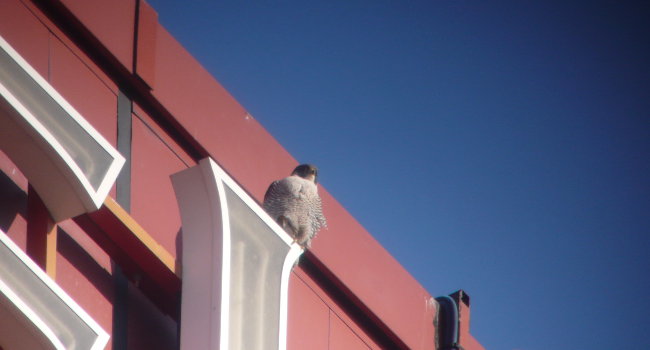
20 March 2014
Serious threat to European vultures
Over recent years, the increase in numbers and range of vultures in Europe, particularly of Griffon and Black Vultures in France and Spain, has been very much a 'good news story' – and there are not as many of those in the conservation world as one would like. However, a new threat has now arisen which could easily wipe out all the gains of the past few decades – a vetinerary drug called 'diclofenac' has been authorised for use in Europe, despite the fact that it has been proved to be fatal to vultures, its use having decimated the vulture populations of India. The LPO is among several organisations trying to get the drug banned, especially as there are safer alternatives available. The current position can be found, in English, on the website of the Vulture Conservation Foundation. This will no doubt be updated regularly, but in the meantime you are urged to sign the petition here to help bring more pressure on the authorities involved.
11 March 2014
Continuing problems with resubscribing
It appears that the on-line subscription system still is not working properly, and so it seems that we all need to wait a bit longer before (re)subscribing is possible electronically. If you receive a reminder via the mail, then you can always fill in your details and post the form back to Rochefort via old-fashioned 'snail-mail'. If I can help in any way, then I will do what I can, and will certainly post here if and when the system is fixed.
8 January 2014
Problems with resubscribing
Despite my previous item, exhorting everyone to subscribe or resubscribe early in the new year, it seems that the LPO's revamped on-line subscription system has incurred some technical problems. So it happens over there too! The new system seems to be based on e-mail address rather than the existing membership number, but even if you navigate that far, it seems that one's name and address details are incomplete and cannot be altered. For instance, it does not seem possible to insert the fact that most members reading this are likely to be in 'Royaume-Uni'. Thus you are not prompted to add the 6,10 euros postage for L'Oiseau Magazine, and also the address label will likewise not include the country. For the moment, therefore, it seems safer not to resubscribe. New subscribers may be OK, as they will be starting from scratch – I'd be interested to hear from any of them to see if they have more luck. If and when I have more information, I'll post it here. Bonne année a tous!
News items for 2013
December 2013
A great time to join the LPO and subscribe to its publications!
As I remind people every year, this is perhap the most ideal time to join the LPO and to subscribe to either Ornithos or L'Oiseau Magazine or both. Details (in French) about the contents of recent issues of both publications can be found via the LPO's main website on http://www.lpo.fr. Subscriptions to the LPO are on a calendar-year basis, but subscriptions to the publications can start at any time and run for a year from the first issue subscribed to. If like me you are not the best organised person in the world, an ideal solution is to start everything in January, and get it all out of the way at one go. Contact details and subscription rates can be found on http://www.kjhall.org.uk/lpo.htm, where there are also links through to the LPO's main website. Existing members/subscribers will receive a reminder from Rochefort, and can pay direct to them.
17 December 2013
Rapaces de France
The latest issue of this supplement to L'Oiseau Magazine (available at an extra 4.50 euros) contains the usual interesting mix of material. There are articles covering the various threats to birds of prey in France such as poisoning, illegal shooting and the hazards of power lines, and the work being undertaken to counteract them, as well as shorter news items from across France and also from abroad. One article summarises early results from counts carried out in a sample of 5x5 km squares, where observers try to estimate the total number of raptor pairs present in the breeding season. Although the results are not yet statistically significant, there are indications of declines in the number of Buzzards, Kestrels and Hen Harriers, but a rise in the numbers of Black Kites. It is hoped that with an increase in the number of participating observers that the results will provide a more representative sample, although the coverage is surprisingly widespread even at this stage. Longer items cover raptors in some of France's ocerseas territories, and on how to go about locating Hobbies in the breeding season, when they can be notoriously difficult to pin down. There are also articles about a variety of the birds of prey to be found in France, both diurnal – Egyptian and Black Vultures, Lammergeier, Bonelli's Eagle, Montagu's Harrier, Goshawk, Red Kite – and nocturnal – Eagle Owl, Little Owl, Tengmalm's and Pygmy Owls, and Barn Owl. Something for everyone, in fact. See here for more details and some sample pages.
25 November 2013
Annual sample survey of raptors
Each year, volunteers across the whole of France settle down to keep an eye on the breeding success or otherwise of a whole range of birds of prey, both diurnal and nocturnal, especially the more vulnerable species. The results for 2012 have recently appeared and, as ever, make fascinating reading. Not least because so many people are involved: 4302 in all this time, watching for a grand total of 14,056 days, with every département having at least one person taking part. Across all species, 6886 pairs were followed, these rearing a grand total of 9409 young. In some cases, e.g. Bonelli's Eagle, essentially every known nest was under surveillance, whilst for others just a sample was followed, hopefully a fairly representative one, and in any case, every nest that is watched inevitably gains a certain degree of protection. In the case of Montagu's Harrier, for instance, it is estimated that nearly 30% of the French population (c. 4500) is surveyed, something that is vital as so many of the nests in arable fields need to be saved from destruction during harvesting activities.
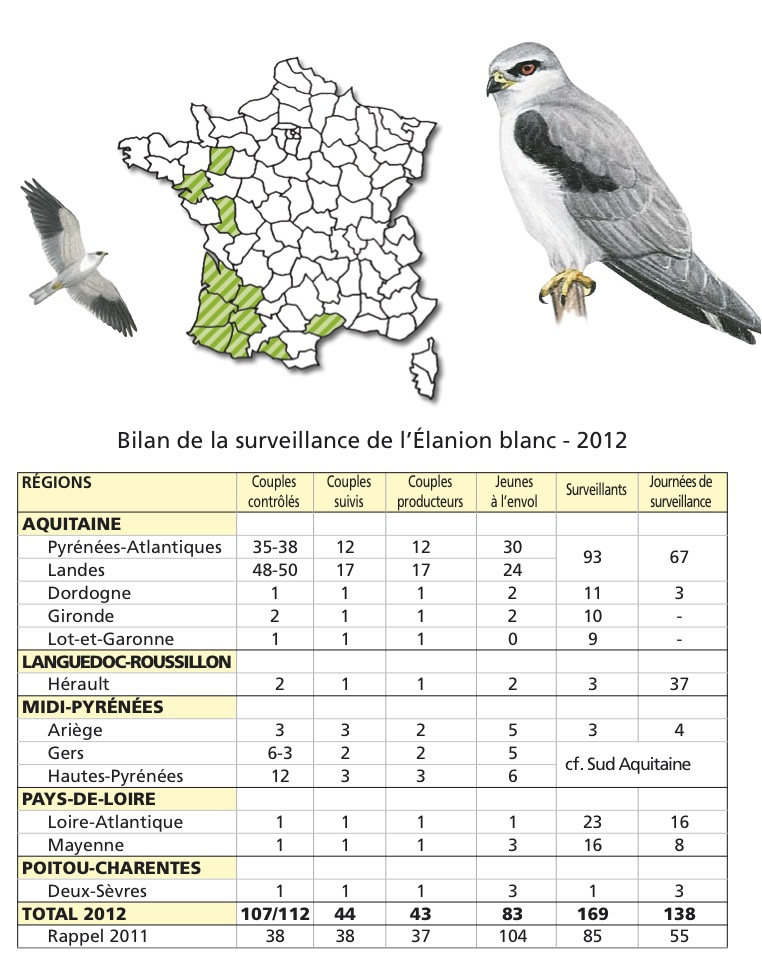
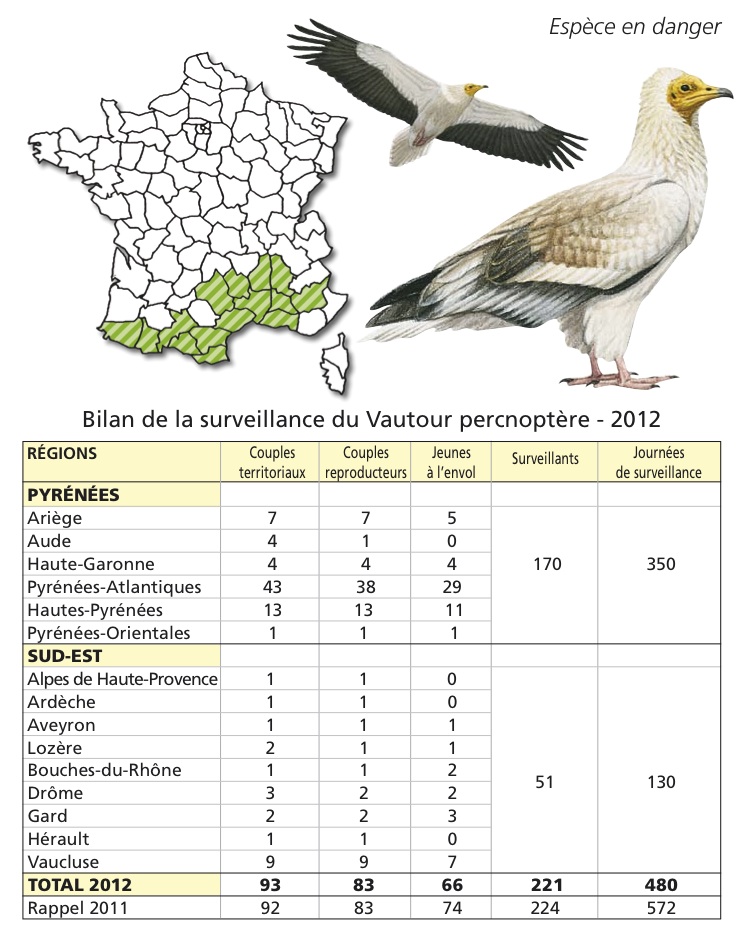
I've picked out the summary results for two species: Black-shouldered Kite and Egyptian Vulture. For the former, not only did the core population based around the River Adour top the 100 mark for the first time, the breeding range also expanded significantly, with one pair as far north as the Mayenne département, another as far east as the Hérault, while three pairs raised young in the Ariège, where no breeding at all had previously been recorded. Looking at the map, it's tempting to think that one might well cross the Channel in the not too distant future!
For the Egyptian Vulture, the population can be split into two groups, with 72 pairs in the Pyrenees, primarily towards the western end, and 21 pairs in the south-east, where they are relatively widely scattered. Historically, their numbers slowly increased up to 2004, and then stayed at much the same level until 2009, but since then numbers have started creeping upwards again. The number of young per pair reared in 2012 was slightly down on the previous year, although three pairs did manage to raise two chicks to fledging, a relatively unusual feat.
18 November 2013
Record count of Cranes at the Lac du Der
On the 27th October, over 83,000 Cranes were counted by volunteers from the LPO-Champagne-Ardenne group at the Lac du Der, the highest total ever recorded at this site. The previous high was 74,500 seen in November 2010. The first birds to arrive in any numbers were c.5000 on the 5th October, but the fact that 81,650 were seen on the move in Germany on the 19th October with a further 33,600 there on the 22nd gave advance warning that the birds were on their way. The weather conditions just happened to be adverse enough locally for large numbers of the birds to decide to break their journey at this huge artificial lake in the Champagne region of north-east France, one of the main staging posts on this species' migration route across Europe. On 29th the weather improved, with clear skies and light winds encouraging significant numbers to head on towards their wintering grounds in Spain and south-west France. By the end of the month even more had gone, although up to 20,000 still remained on site, this being a fairly typical number that may well stay all winter.
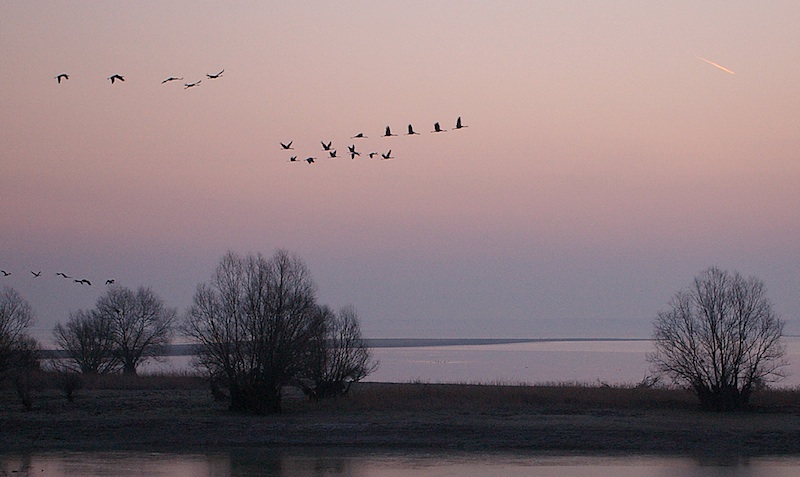
If you have the chance to visit any of the Cranes' wintering or migration sites, the spectacle is certainly well worth the effort.
18 November 2013
The Chaffinch remains a protected species in France
On the 2nd November, Philippe Martin, the French Minister for Ecology, announced that there would be no exception made to the fully protected status of the Chaffinch, despite demands from the bird-trappers of Les Landes in south-west France that their 'traditional' practices be allowed. The trappers had high hopes that M. Martin, who is elected from the neighbouring Gers département and has previously acted as the Préfet (the State's representative) for Les Landes, would see things their way, especially as they also had quite a lot of support, verbal at least, from their local elected representatives. But the national council for the protection of nature, having heard representations from all sides of the argument, voted by ten votes and one abstention against any change in the law.
Chaffinches, and other similar small birds trapped in the region, are destined to be fried, added to omelettes, or roasted on skewers, and continue to be caught illegally in some numbers. The local trappers profess themselves stupefied and outraged by this outcome, claiming that their way of life is under threat from outsiders. The LPO, although delighted with the minister's decision, is now pressing that the regulations are actually applied with some rigour.
Concerning the Ortolan question (see below), the minister seems to have deferred a decision pending more evidence.
4 November 2013
LPO partnerships with industry bear fruit
Back in 2003 the LPO signed an agreement with the building materials company Cemex, which agreed to sponsor several programmes in favour of wildlife promoted by the LPO. To date forty-one of these campaigns have benefited, including those targeting Black Terns, Peregrines and the various vultures. But, in addition, the LPO has been able to work closely with the staff involved in running the company's quarrying activities, mostly notably their gravel pits, often extremely valuable habitats for birds, both during and after their active use for sand and gravel extraction. Active pits are often used by such species as Sand Martins and Little Ringed Plovers as breeding sites, and with relatively minor changes to working practices, which staff are encouraged to adopt, neither the birds nor the work-schedule need suffer. In several places controlled access has been arranged so that surveys can be carried out by local birdwatchers.
At individual sites, a variety of opportunities have arisen. For instance, in the Sarthe département, Yellow-bellied Toads took up residence in one area of pits, finding the shallow and stagnant pools there much to their liking. Following advice from members of the LPO-Sarthe group, active parts of the pit were drained, so that the toads would concentrate in the quieter areas which were kept humid. Between 15 and 100 of this vulnerable species have been counted here since the programme started in 2006, the site thereby providing a valuable additional habitat.
In south-west France another actively worked pit has hosted a pair of Black-shouldered Kites since 2011, with hedges and rough ground nearby providing ideal nesting and feeding opportunities. The LPO-Aquitaine group has been involved here in advising as to how the habitat can be extended further, particularly the open vegetated areas that hold the small mammals that form the bulk of this newly colonising bird's diet.
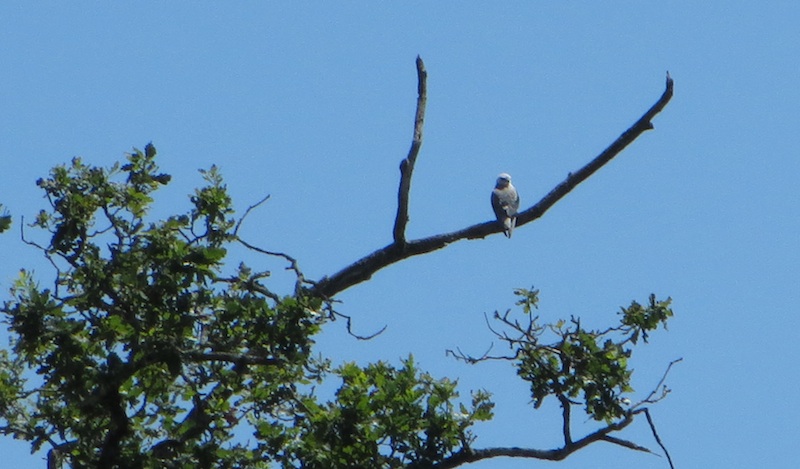
In the Fontainebleau area, six working pits have been surveyed since 2009 for a suite of indicator species, not just birds, but also for their bats, dragonflies, butterflies and other insects, as well as the terrestrial and aquatic vegetation to be found there. The aim is to come up with plans to improve the way the pits are exploited and also how they can be managed once extraction activities cease so that their biodiversity is maximised.
So overall, the agreement with Cemex has been deemed a great success by both sides, and was renewed in July 2013.
4 November 2013
Save the world – drink tea!
Well, not the world exactly, but perhaps make a contribution to preserving the damp meadows of Alsace, known as Reids, south of Strasbourg. And how? By buying a 'thé militant' marketed under the name 'Oiseau Lune' and produced by the specialist tea retailer 'Les Jardins de Gaïa'. The company is based near to some of this special habitat, and its founder, Arlette Rohmer, and her staff, were keen to put something back into their local environment, particularly as the company clearly has a Fairtrade/Organic ethos. This particular range of teas takes its inspiration from the crescent-shaped bill of a Curlew, hence 'moon bird', a species emblematic of these wetlands although very much reduced in numbers. For every packet sold, the company will donate one euro to LPO-Alsace to support its work in protecting this fragile habitat. For those wishing to know more about 'activist tea' (seemingly a contradiction in terms!) see http://www.jardinsdegaia.com/en for more information.Yet another example of how the LPO tries to find suitable sympathetic partners to help promote its message.
31 October 2013
Hirundine surveys
A two-year enquiry into the status of swallows and martins in France is drawing to its close, but some initial results are already available. For instance, in 2012, 44,364 nests were located, of which 30,859 were of House Martins, 7248 of Swallows and 6257 of Sand Martins. Such a survey was partially conceived so that as many people as possible could participate in it, over and above just LPO members, not only to count the birds, but also to become aware of where they were and also perhaps be more favourable to their protection. On the whole, most people like to see swallows and martins over their towns and villages, but they often complain about the droppings that are inevitably produced around the nests. As a consequence, nests are sometimes knocked down or the birds otherwise discouraged, although all hirundine species are fully protected by law in France. But there are in fact many ways round this perceived problem, and the LPO is always happy to advise. Sometimes all that is needed is for a wooden shelf to be placed below the nests, to catch the droppings, and the shelf cleaned up later once the birds have migrated. Where Swallows nest in outbuildings, artificial nests can be placed in strategic places to encourage the birds to use a more convenient spot, although I have to admit that they don't always play ball! But the results can definitely be worth it (see image below).

One notable site that was surveyed in some detail was the Château de Versailles, where volunteer Hervé Lefort assiduously noted the exact positions of 452 nests on the palace as a whole (158 occupied, 241 empty and 53 damaged) – quite an impressive total. It was thought that the fact that the lawns surrounding the château were kept well watered on a regular basis lead to an abundant supply of soft mud being available from which the birds could construct their nests. For more information about this and other findings, see the survey's website.
31 October 2013
Honeyguide Wildlife Holidays
Once again, Chris Durdin of Honeyguide Wildlife Holidays has sent me their latest brochure, for 2014, and potential visitors to France who want a wildlife holiday that also helps bird conservation in France could well be interested in seeing what is on offer. Their holidays are designed with the general naturalist in mind, and the cost of each holiday includes a proportion to be donated to a conservation project in the country concerned, via the Honeyguide Wildlife Charitable Trust. For 2014 there are three holidays heading for France – one to the Pyrenees, one to the Cévennes, and one to the Dordogne, all these areas having appeared regularly on their programme over the years. Chris Durdin has selected the LPO to be the recipient of the conservation-oriented donations for these holidays, as he has done for several years. For more details of the holidays on offer, see their website: www.honeyguide.co.uk.
31 October 2013
Birding Dordogne
For anyone thinking of visiting the Dordogne area, whether with Honeyguide or not, a useful source of information can be found in a booklet written by a British ex-patriot now resident there. The following is a review I wrote for Birdwatch magazine in 2011, and reproduced here with their permission. The book (32pp, ISBN 978189811-05-21) is available from Birdguides, currently at £8.00.
"Despite being one of the most popular areas in France for family holidays and second-home owners, the département of the Dordogne has up to now been overlooked by birding site-guide authors. This gap has now been comprehensively filled by David Simpson, a resident there for over ten years. Situated about halfway between Bordeaux and the Massif Central, the Dordogne is typical of rural France, where birds like Golden Oriole, Hoopoe and Cirl Bunting are widespread, but the more localised species often take some tracking down. The effort, however, is definitely worth it – the limestone cliffs hold breeding Eagle Owl, Crag Martin and Alpine Swift, there are Black and Middle Spotted Woodpeckers in the forests, and both Hen and Montagu's Harriers nest in the arable farmland. Wintering Wallcreepers and Alpine Accentors just add to the attraction."
"The booklet opens with some useful background visitor information, the main text then being divided into six chapters, each with an extremely clear and detailed map, pinpointing key spots within the wider area. Two describe the valleys of the Rivers Dordogne and Vézère, two others cover the more open landscapes of the Verteillac plain and the Faux plateau, whilst a fifth details the heathland and woodland of the Double and Landais forests. A sixth chapter ventures south, just out of the département, to include the Lot valley, where both Subalpine Warbler and Ortolan can be found. The author needs to be congratulated for packing so much information into so few pages."
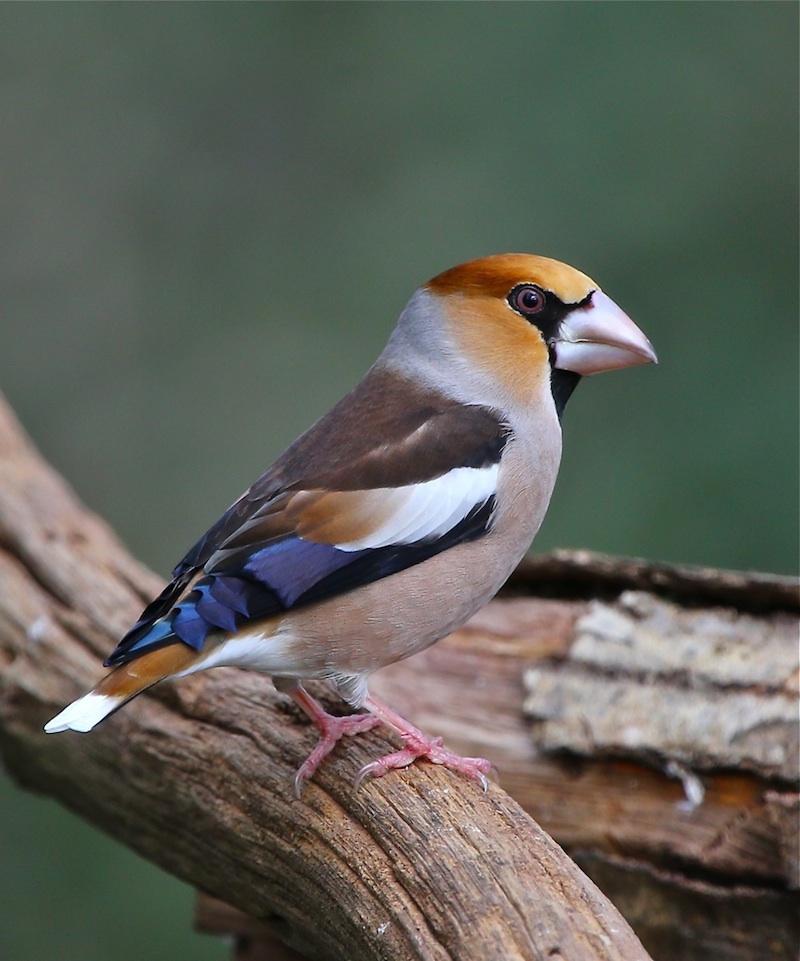
This striking image of a Hawfinch, another common resident of woodlands in the Dordogne, was kindly supplied by John King, who also now lives in the region.
2 September 2013
The Lesser Grey Shrike in 2013
The LPO-Hérault group, which is coordinating the study and protection of the last remaining breeding Lesser Grey Shrikes in France, reports that 18 pairs bred this year, all in Languedoc-Roussillon. This total is line with the numbers recorded over the past few years, so for the time being they seem to be holding their own. Despite some dreadful weather in the early part of the season, 54 young birds fledged this year, the last doing so on 23rd July. Three nests failed because of bad weather and, at a fourth, one of the adults was predated. The birds have now left for their winter quarters in southern Africa, so we will have to wait until next May to see how many return in 2014.
2 September 2013
Ortolans on the menu once again
Mid-August to mid-September is the time of the 'traditional' Ortolan trapping season in south-west France (primarily in the Landes département), and of the equally traditional appearance of Allain Bougrain Dubourg (President of the LPO) in the area to open up a few of the traps to release the birds concerned. This year he was accompanied by representatives of CABS (the Committee Against Bird Slaughter) plus, as usual, the media and the local police. Killing Ortolans is of course against French and European law, and France has already been warned by the European Commission that it runs the risk of serious sanctions if the law is not upheld. Several of the local politicians are known to support the trappers, although the latter number no more than 600 in all – how significant can their votes be? But maybe they have rather more than votes to provide – one can but wonder. The latest scheme they have come up with is to ask for 'scientific hunting' to be allowed, rather like the Japanese with whales, ostensibly to find out how many migrant Ortolans there really are, with a view to legalising the trapping regime. Let's hope the authorities are not taken in by this somewhat transparent ruse.
28 August 2013
The Étang de Trunvel, western Brittany
Rob Adams, who is a frequent visitor there, has sent me some information about the Étang de Trunvel, situated on the Baie d'Audierne on the west coast of Brittany. The lagoon supports some large reedbeds and hosts a good selection of breeding birds, including several pairs of Savi's Warblers in addition to the many Reed and Sedge Warblers while Bearded Tits also nest here, and a few Bluethroats have also arrived recently.
But Trunvel is better known as a migration hot-spot, particularly as a key stop-over for Aquatic Warblers on their way from breeding grounds in eastern Europe to wintering sites in West Africa (see also below). There is an active ringing group at the lagoon, and as a long-term ringer Rob has joined them on several occasions. His most recent visit was on 11th August, when over 100 Sedge Warblers and six Aquatic Warblers were caught in the space of a couple of hours. Many thanks to Rob for this photo of one of the latter.
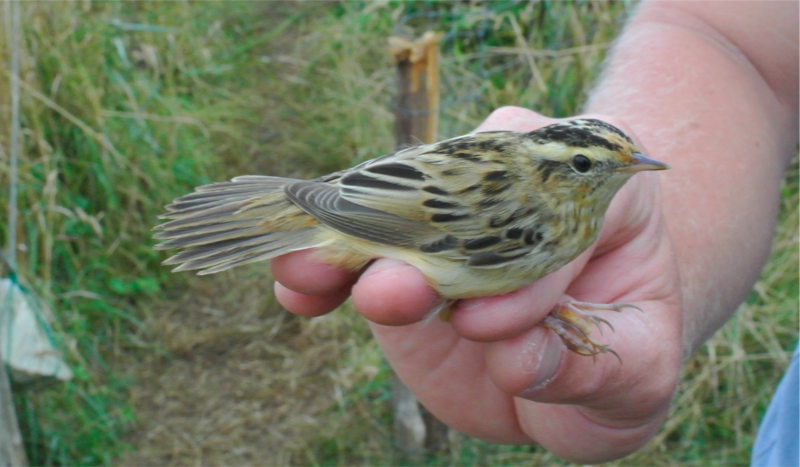
In an average autumn session (1st July to 31st October), the ringers can catch in excess of 10,000 birds, of which over 1000 would be Sedge Warblers (including retraps of British birds) and over 50 Aquatic Warblers, with a long list of other species including Bluethroat, Spotted and Baillon's Crakes, Wryneck, Paddyfield Warbler (two in 2012, one so far this year), and so on.
Trunvel is just one of several excellent sites for birds in this part of France. To date, 327 species have been noted in the general area of the Baie d'Audierne. Some sightings from the 2009 report include good numbers of migrant waders along the shore, Mediterranean, Glaucous and Iceland Gulls in winter, and several pairs of nesting Bee-eaters, quite remarkable this far north.
For those with a command of French, more information about activities at the Trunvel ringing station can be found via the Bretagne Vivante website (see also here for a running total of Aquatic Warblers trapped at Trunvel and elsewhere in France in 2013). In addition, the Anse de Penfoulic bay, not far away to the east, also has a website about the birds to be seen there, including some interesting data drawn from sightings of colour-ringed Sanderling, Spoonbill and Mediterranean Gulls made in that area.
20 August 2013
Bonelli's Eagles
With only 30 or so pairs in France, the Bonelli's Eagle is one of the country's rarest breeding birds. A Mediterranean species, it is restricted to the regions of Languedoc-Roussillon, Provence-Côte d'Azur and Rhône-Alpes, where the population has been increasing, albeit at a glacially slow pace. Apart from disturbance, the main threats have come from electricity cables, with which a frighteningly large proportion of young birds manage to collide, and from illegal shooting. Just this last April, for instance, an adult Bonelli's Eagle was found shot in the Gorges d'Ardèche, in an area where it was hoped a new pair would establish itself shortly. With all this in mind it is, then, good to report that 2013 seems to have been a productive year for the species in France, with 32 young fledging, as opposed to the 17 that were reared in 2012. Let's hope that they manage to survive though to breeding age, which can take up to four years. During this period the immatures will range widely across south-east France and into central Spain. At the present time, the French population is not really self-supporting but happily there is a degree of exchange with birds from Spain which has helped maintain their numbers.

My thanks to Alan McBride for his photo of an adult Bonelli's Eagle taken in an area of Languedoc-Roussillon where a pair raised two young this year.
18 August 2013
Birdfairs (again)
I have just spent two days at the British Birdwatching Fair by Rutland Water, an excellent opportunity to catch up with various friends, and try not to spend too much money, although the temptations are many to do so. The French Regional Natural Parks had a stand, and it was good to see that they are continuing to produce their 'Where to Watch' guides to sites in the various parks, well worth picking up if you are in any of them on holiday. At least some of them are downloadable from their website.
They will also be at the forthcoming French Birdfair, to be held in Paimboeuf from 20th to 22nd September (see below for details) – this is just a reminder to pop in if you are in the area.
18 August 2013
Col du Soulor (yet again!)
While in France for a short holiday, I stopped by at the Col du Soulor (see also below) just for a couple of hours on 5th August. I would have stayed longer, but the clouds rolled in and curtailed the day's observations somewhat. However, I was pleased to see that the OCL watchers were once again there, counting the migrant raptors, this time from 15th July to 8th September. So there's still time to join them if you are in that part of the Pyrenees – the more the merrier. In just the time I was watching, nearly 1000 Black Kites went through – apparently they had seen 9000 the previous day. The cumulative count so far was 30,585, showing just how significant the site is. Last year the season's total had been 18,322, but they had only started the count after the peak of the Black Kite passage had taken place. On the other hand, so far only 29 migrant Honey Buzzards had been seen, so there was some way to go to pass last year's total of 3627. Their main passage does not take place until the end of August and into early September. Hundreds of Swifts were also whizzing over, a reminder that migrants at these watchpoints are not restricted to large gliding species. I also managed to see a Lammergeier, two Egyptian Vultures, good numbers of Griffons, a couple of Red Kites and a Honey Buzzard, all of which were local breeders. It's rapidly becoming one of my favourite birding sites in France!

Incidentally, there is an item about the area in the latest issue of L'Oiseau magazine, yet another reason to subscribe to what is widely considered to be one of the best birding publications around (though you need to understand French to get the most out of it!).
If you can't get to Soulor, don't forget that, at Organbidexka, away to the west, the LPO is coordinating this year's annual migrant count. They will be there through to November, and that's another spot where volunteers are always welcome.
18 August 2013
Little Bustards at Marseille airfield
At the end of May a serious accident was avoided at Marseille airport when an Airbus A320 collided with two Little Bustards and had to make an emergency landing. Happily nobody was injured, but the local authorities then decided to start shooting the other Little Bustards which were feeding at the airfield, around 50 in all. This was, of course, illegal, as the species is fully protected in France, and moreover the birds were in the middle of their breeding season. The LPO made rapid contact with the authorities, and the shooting was then stopped, but not before 38 birds had been killed. Allain Bougrain Dubourg, the LPO's President, met with the various bodies involved to try to come up with a more sensible method of solving this problem, and these discussions are ongoing. In the meantime, no more shooting has taken place. The presence of large birds on airfields is not unique to Marseille airport, and much expertise is available to enable the best solution to be found. Obviously the LPO is as concerned as everyone else about aircraft safely, but as so often happens the first solution seems to be to pick up a gun rather than to engage the brain. I am sure we can all think of parallel situations elsewhere.
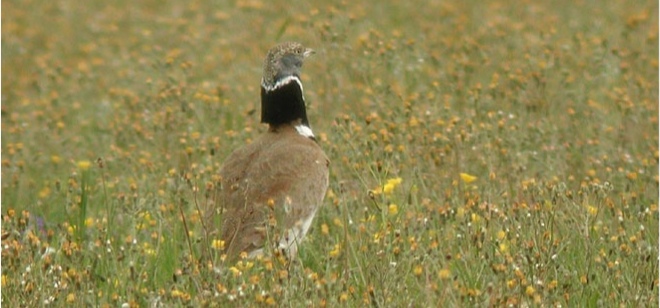
Languedoc-Roussillon and Provence are two areas where Little Bustards have been maintaining their numbers quite well, as opposed to the ones of the arable plains of Poitou-Charentes which are only just hanging on, despite extensive conservation measures being in place, so it would be unfortunate if the southern population was persecuted unnecessarily.
12 June 2013
Migration studies in France
The latest issue (the 100th!) of Ornithos (20: 2) has a paper about the places across France where migration is studied on a regular basis, with a very useful map of where they all are, around 120 in all. Some of them have been watched for over 30 years, although for the majority consistent counting over at least one of the migration seasons is relatively recent. The coverage is biased towards autumn migration (75%) and towards landbirds (88%) as opposed to seabirds. The paper gives summary details of the key features (species, timing) for all the sites – plenty of holiday ideas here!
Details of counts on a daily basis can be found on the website www.migraction.net for many of the places cited, with seasonal summaries for some. As the spring migration has just finished, it's a good time to see how things have panned out this year. I was interested in the results for Red Kite, as they seem to be on the move in good numbers in the West Country at the moment (late May/early June), with speculation from some quarters that they might be crossing from the continent. But, as hinted by the winter distribution, there is in fact little evidence for this. The Pointe de Grave on the west coast of France is one of the best-covered sites and has huge numbers of spring migrants, but only two Red Kites were seen here between March and the end of May (one in March, one in May), although 1543 Black Kites passed through during the same period. At Cap Gris Nez, opposite Dungeness, no Red Kites were recorded at all, although the odd Marsh Harrier and Hobby were seen. It was the same story at the Bois de Cise, a bit further south on the same coast, a noted spring watchpoint. Although primarily a seawatching site, the Cap de la Hague, at the top of the Cherbourg peninsula, did report single Marsh and Montagu's Harriers, but again no Red Kites. From here, Portland Bill is directly north across the English Channel, but when I spoke to Martin Cade of Portland Bird Observatory recently he could not recall ever having noted a Red Kite coming in off the sea, although raptor migrants like Osprey, Montagu's Harrier and Honey Buzzard have all been seen to do so. When Red Kites are seen at Portland, which certainly happens more frequently than in the past, it is almost always at the northern end of the island, and they rarely get as far as the Bill.
One site in France where good numbers of migrating Red Kites do occur is Le Hucel, in the east on the Swiss border, heading north-east. This spring, 1571 Red Kites passed through here, the main numbers being seen in April, peaking mid-month. By the end of May, passage was virtually over. So neither the timing nor distribution of Red Kites in France supports the idea that the spring movements seen in southern Britain involve cross-Channel migrants, at least not in significant numbers. One would guess that they are more likely to be immature British birds wandering in search of new sites in which to settle down in due course. For instance, the migrant photographed recently on the Severn estuary near Bristol looks to be a one-year-old bird (see here and scroll down to 9th June).
Looking at other species at the Pointe de Grave, it was good to see that numbers of Turtle Doves, at 11,801, were up on the past two years, although nowhere near the 27,487 counted in 2001 for instance. Over 2000 Spoonbills, nearly 29,000 Swifts and over 72,000 Swallows were among some of the more notable counts made this year, despite apparently some pretty terrible weather.
30 May 2013
Reintroduced Lammergeiers: an update
As the link to the maps showing the movements of the two Lammergeiers released in Les Causses (see below) seems to be a bit erratic (though always worth trying!), here are a couple of recently published stills showing the movements of the two birds to date, or at least up to the 15th May.
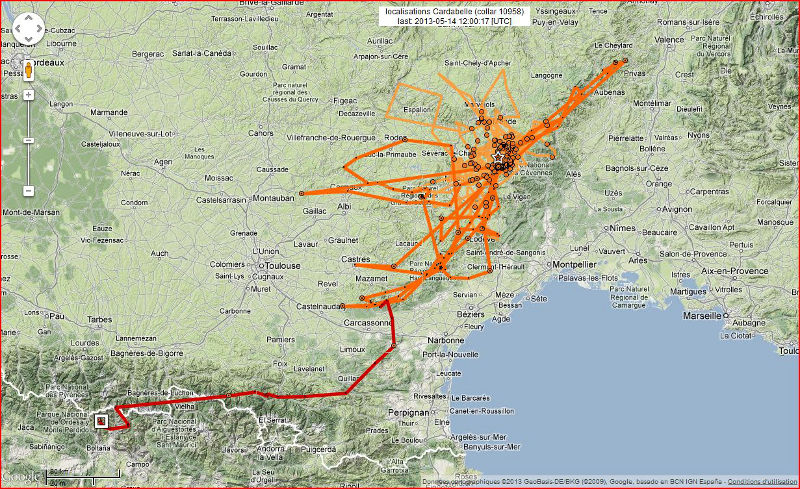
Cardabelle, the female released in June 2102, had previously wandered as far west as Albi/Montauban and north-east as far as Privas (orange lines) but, as the red lines show, she crossed the River Aude on the 12th May to reach the Corbières before continuing over the Spanish border on the 14th to arrive in the Ordesa National Park, where she was located at one of the feeding stations that top up the food supplies of the vultures in the Pyrenees.
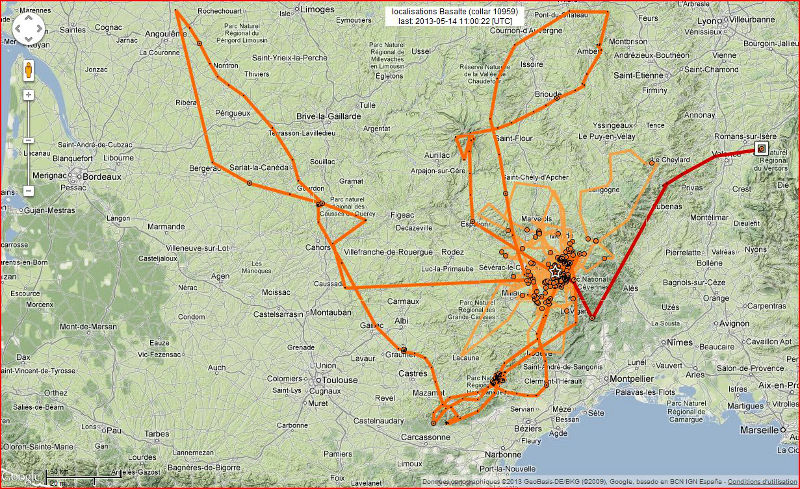
Basalte, the male also released on the 12th June 2012, had previously wandered as far north-west as Angoulême, and also north into the Auvergne, but more recently (red line) had moved north-east to the Monts d'Ardèche near Privas before crossing the Rhône north of Valence on 14th May to reach the Vercors National Park the next day.
In fact the Vercors is another area where young Lammergeiers have been released recently, and at least one of these has already wandered as far as Périgueux, passing close to the Causses area, indicating that the hoped-for mixing of populations already seems to be on course. More releases are due to take place in the Gorges de la Jonte area shortly. If you would like to support this project, one way is to sponsor one of the young birds already released (see this link).
9 May 2013
French Birdfair 2013
Following the success of the first Birdfair held in France in 2012 (see below), the LPO has decided to repeat the event, using the same venue as before – Paimboeuf, near the mouth of the Loire. The 'Festival' will run from 20th to 22nd September. More details will appear on the website http://www.birdfair.fr. If it is as enjoyable as last year's show, it's well worth stopping by if you are in the area.
9 May 2013
Music inspired by birds
The French have a long history of creating music inspired by birdsong. One thinks of 'Carnival of the Animals' by Saint-Saëns and of course Olivier Messiaen who used birdsong extensively in several of his major works. Not perhaps in the same league, but interesting nevertheless, Christophe Piot has followed the same path, using drums and percussion to create a jazz-based sound. He was a performer one evening at the 2012 French Birdfair and has also worked closely with the Regional Natural Park of La Brière to help promote this important wetland area in western France. He performs as 'Electroplume', and has already published one CD, 'Birds & Groove'. In the early days he dressed up in a bird costume while playing, but that, it seems, was a step too far, though certainly it was different! For jazz-lovers, and anyone interested in experiencing yet another way of drawing inspiration from the natural world, have a look at this short video, which includes English subtitles.
9 May 2013
Château de Villandry
Anyone who has toured the Loire valley to visit its many magnificent châteaux will very likely have stopped at Villandry, famous in particular for its formal gardens. The owner, Henri Carvalho, has drawn on the expertise of the LPO Touraine group to make an inventory of the birdlife of the 30 ha wooded park that surrounds the property, with a view to protecting and enhancing its biodiversity. The result was an impressive list of 89 species, including Black Woodpecker, Cattle Egret, Spotted Flycatcher and Golden Oriole, and was followed by a presentation of various recommendations on how to manage the habitat to enhance its bird population even further. In the light of all this, Henri Carvalho requested that the château be incorporated into the LPO's network of Refuges, to join over 10,500 others spread across the whole of France. The formal agreement was signed by the owner in October 2012 in the presence of the LPO's President, Allain Bougrain-Dubourg and the Vice-President of the Conseil Régional du Centre. One hopes that some of the other wonderful châteaux along the course of the Loire can be persuaded to join the scheme as well.
13 March 2013
White Storks wintering in France
In parallel with the increased numbers of breeding pairs of White Storks in France (c. 1900 pairs in 2012), the numbers remaining for the winter have also risen in recent years. Although the former is clearly having an effect on the latter, it is thought that climate change is also playing a part, with other species also being affected, some positively, others less so. In the past, White Storks were merely summer visitors to France, departing to the far side of the Sahara once the breeding season was over. This is still the case for much of the population, although some now only go as far as Spain, but the counts shown in the graph below indicates how things have changed since the 1990s, mostly a fairly steady increase.
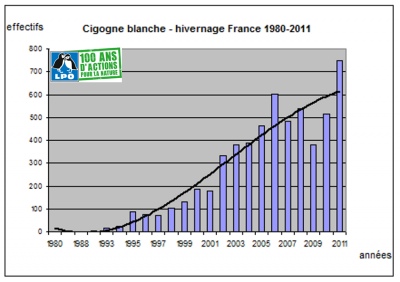
There was a distinct dip in 2009, a winter which was particularly severe, but the trend has now resumed its previous course. Not only are more birds remaining in France for the winter, but they are now to be found increasingly widely across the country, although the western coastal fringe remains their current heartland. They are among the earliest arrivals in the spring – the majority of breeding pairs will already be back on territory, and the first eggs will be being laid about now.
13 March 2013
Lammergeiers in the Pyrenees
The Lammergeier is another early-nesting species, often laying eggs in January. A count of the pairs currently breeding in the French Pyrenees indicates (by department, west to east), 8 pairs in Pyrénées-Atlantiques, 13 in Hautes-Pyrénées, 2 in Haute-Garonne, 7 in Ariège, 1 in the Aude and 4 in Pyrénées-Orientales. However, there have been significant falls of snow in many parts of the mountains this winter, so it remains to be seen how successful the birds will be. In recent years, this particular population has, on average, successfully raised 0.5 young per pair, allowing a slow but steady increase in both numbers and range. Elsewhere in France, this magnificent vulture can be found in the Alpes and in Corsica, while a reintroduction project is currently under way in the Massif Central (see below).
22 February 2013
Red Kites in winter
The LPO organises an annual January count of Red Kites, made at roost sites across the country. The results for 2013 are awaited, but the map here shows the distribution in 2012, when 7052 birds were recorded at 149 sites. The largest numbers are in the Massif Central, and in the western Pyrenees. Although these are both areas with significant numbers of breeding birds, the winter population is boosted by birds from elsewhere, predominantly from Germany and north-east Europe. Of course, many other birds cross the Pyrenees and continue into Spain for the winter.
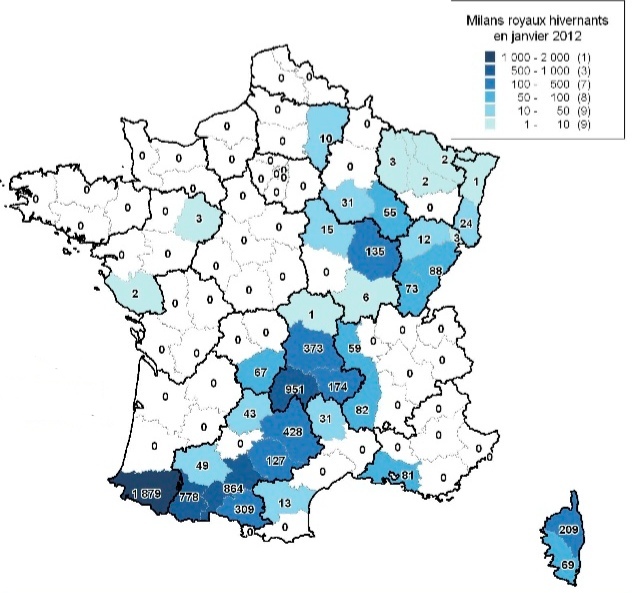
The overall distribution also reflects the main migration route taken by migrants in both spring and autumn, north-east/south-west. It is notable how few records there are from the north-west of France, indicating perhaps that not many cross over from Britain, despite the fact that these days quite significant numbers of Red Kites are seen in south-west England, especially in the March-May period, although few currently breed in this part of the UK. There have been a couple of recoveries of UK-bred birds in France, and a few from Germany have been noted in Britain in winter. A British-marked bird was apparently recently found electrocuted (under power lines) in Brittany. But until more evidence emerges, it seems likely that most of the kites seen away from their breeding areas in the UK are in fact British-born individuals. But it's always worth looking out for wing-tagged birds, both in the UK and abroad, to build up a better picture.
News items for 2012
19 November 2012
Rapaces de France
I should remind subscribers that, in addition to the normal quarterly editions of L'Oiseau Magazine, there is also an annual supplement entitled Rapaces de France, available at an extra 4.50 euros, and concentrating on birds of prey. The latest edition, No. 14, has recently appeared, and as ever contains some fascinating material. To mark the 100th anniversary of the LPO there are historical articles about raptor persecution in France and the measures gradually introduced to protect them. A related article covers the various reintroduction schemes that have become a natural extension of these efforts, and which continue to this day. Among individual species the Kestrel is picked out for special treatment, with a couple of major items on its study and on its behaviour. And of course there are plenty of other species-specific articles covering a wide range of both diurnal and nocturnal birds of prey as well as more general ones on subjects such as woodland management, migration, and biodiversity in the Pyrenees.
Among the many short notes, I was particularly interested in one reporting a study made virtually daily over 11 years of a pair of Black Kites nesting in the Hérault region of southern France. From the arrival of the pair in the first three weeks of March, the female never left the nest-site until she laid her eggs, usually between the 4th and 12th of April. The eggs would hatch at the end of the first week of May with the young vacating the nest around 10th June, well before they could fly, their first efforts in this direction not taking place until the end of the month. They continued to be fed by the adults until the young left on migration towards the end of July. It was interesting to hear that the young never departed as a group, the gap between the first and the last being between 5 and 13 days. The adults then remained near the nest for, on average, another 5 or 6 days after the young had left. The only time they left at the same time as the young was when only a single chick had fledged. The implication of this is that the flocks of Black Kites migrating south in autumn are not therefore made up of family parties, in contrast to, say, Bewick's Swans and Cranes which stay as family units well into the winter.
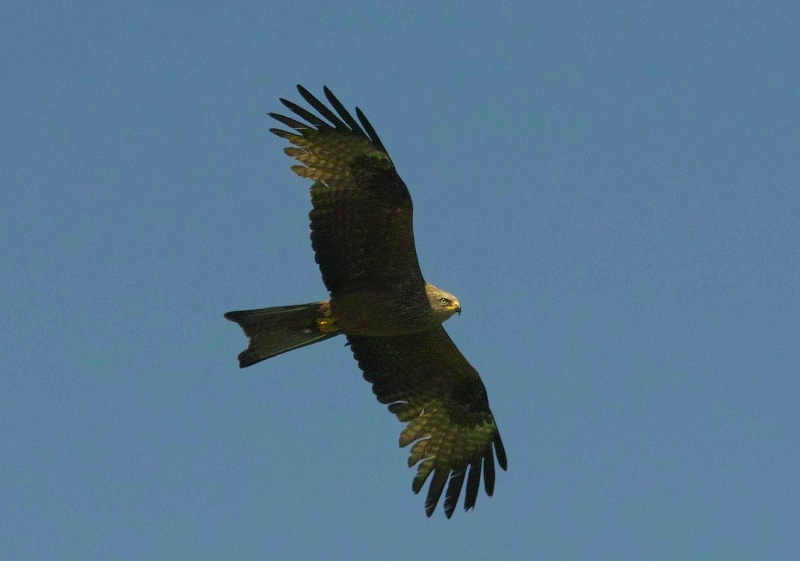
19 November 2012
LPO catalogue 2013
There are many ways of spending your money, especially with the festive season approaching, so perhaps another is superfluous, but for something a bit different you might want to take a look at the LPO's current catalogue. A wide range of material is on offer, from field-guides to bird-food, with books and games for children well represented. The catalogue is viewable on-line (http://www.lpo-boutique.com/catalogue-interactif/2013/), and payment can be made that way too.
27 October 2012
Ospreys
An article in a recent issue of Ornithos (19-4, 2012) summarises the current status of the Osprey in France, and outlines what is known of its history as a breeding species on the mainland. Between 1850 and 1960 there seem to have been a variety of nesting attempts, mainly in the more northern parts of the country, and it is possible that, although very rare, the species never entirely died out during this time. It was also seen on migration, but in low numbers, hardly surprising in view of the fact that the European population as a whole was depressed during this period. From the 1960s, breeding attempts became more frequent, with the first successes in the mid-eighties, but it was not until the turn of the new century that numbers started to increase significantly. However, since then numbers have built up steadily so that by 2011 there were at least 30 pairs, producing 65 young to fledging. The main population is to be found along the central Loire valley, particularly in the forests of Orléans and Chambord, with smaller numbers in the Sologne and Lorraine. On top of this, there is of course the stable Corsican population of around 44 pairs. Another phenomenon of recent years has been the presence of odd birds remaining late into the year, particularly along the west coast of France, with over-wintering having certainly occurred in Brittany and to the south of the Gironde estuary. Several of the wintering sites look as if they could well be possible breeding sites in the future. At the moment the Osprey population is being monitored closely, and artificial breeding platforms have been erected in promising-looking places. Several of these have already been used successfully, encouraging pairs to settle down more quickly than might otherwise have been the case.
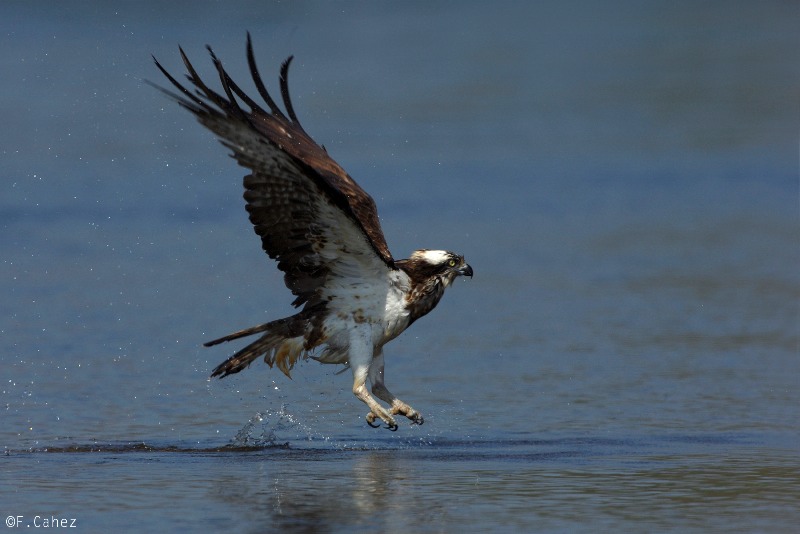
The latest issue of Oiseau Magazine (No. 108, 2012) contains a wonderful selection of images taken by the photographer Fabrice Cahez, together with his tribute to the work of the LPO in its centenary year. He has kindly allowed me to use his photo of an Osprey, shown above. But I would also urge you to look at his website http://www.fabricecahez.com to marvel at the range of other evocative pictures he has taken, and the various of his publications in which they have appeared. They really are quite stunning.
27 October 2012
Reserves managed by the LPO
Although the LPO does not actually own anywhere like the number of reserves as does, for example, the RSPB, it is nevertheless involved in the management of a considerable range of sites that are protected in one way or another, totaling more than 21,000 ha in fact. The largest numbers of these are, not surprisingly, to be found in the general area of its HQ at Rochefort. Many of them are wetlands, such as the coastal marshes between the Loire and the Gironde, but also include the Basses Vallées Angevines, close to the Loire valley, so important for Corncrakes. But the range of other habitats covered is vast, ranging from its own reserve at Les Sept Îles off the Brittany coast to upland reserves that are owned by the state but managed by outside bodies, in this case the LPO. For more information, a 12-page booklet on this aspect of the LPO's work is available in PDF format, which can be downloaded here.
27 October 2012
Another group joins the LPO 'family'
On the 7th October an agreement was signed at an Extraordinary AGM of 'Lot Nature', whereby this association, dating from 1987, transformed itself into 'LPO-Lot', thereby becoming the 42nd entity in the LPO 'family'. Representatives of the adjoining LPO groups (Tarn, Aveyron) were also present, a local outing was arranged, and the day was rounded off by an apéritif and a convivial meal, always essential on such occasions. The group already has 300 members, and would be worth contacting if you happen to visit that attractive part of France at all regularly.
2 October 2012
French Birdfair (again)
Recently I took advantage of a 5-day break to visit the first French Birdfair, which took place from 21st–23rd September (see also below). The venue was Paimboeuf, a small port on south shore of the Loire which flourished in the 18th and 19th centuries, primarily serving Nantes, upstream, before being eclipsed by St Nazaire, a few kilometres downstream. The fair was set up close to the shore, so using the scopes at the various optics stands, of which there were several, there was a chance to see birds moving up and down-river.
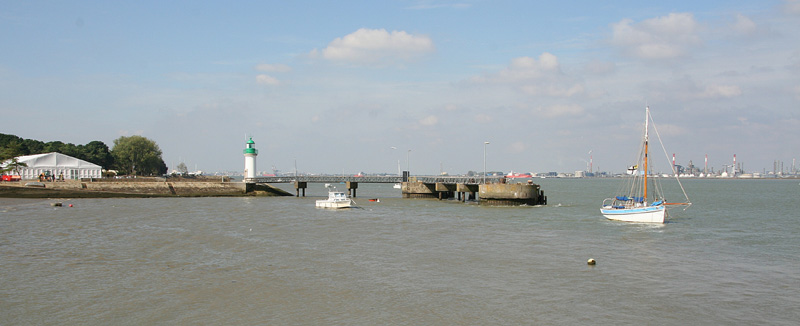
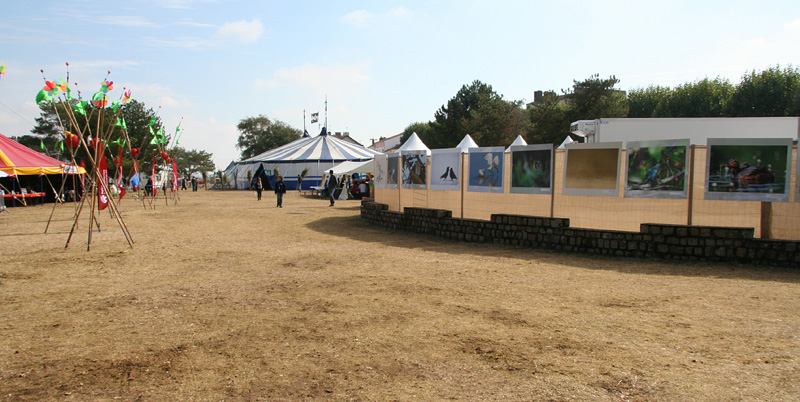
The marquees held the expected exhibitors – conservation groups, including of course the LPO, they being the prime mover in setting up the fair, tourist companies, booksellers, artists and their works, national parks and reserves, etc. were all on show. The LPO's mobile bird rescue unit was open to visitors, and there was an interesting demonstration of how radar was being used to track seabird movements along the Atlantic coastline from Iberia to Scotland.


There was an extensive series of specialised talks, each about 40 minutes in length, and a smaller number of longer presentations. Among these a couple on the more 'philosophical' aspects of birding (the value of an historical sense; the virtues and rewards of patience) were perhaps different from what one might expect in the UK, but nonetheless fascinating for all that. Marc Duquet covered some of the best birding sites in France, not forgetting one's own garden, and Frédéric Jiguet went into the importance of the latter in more detail. A major attraction was the talk given by Killian Mullarney, expertly translated 'on the hoof' by Tony Williams. Killian outlined the background to the creation of the Collins Bird Guide, and later was kept very busy signing copies of the large-format version which had just appeared in French translation. I was pulled onto the stage to say a few words to make the comparison with the British Birdwatching Fair, pointing out that although that was now a massive affair, when it started 25 years ago it was equally modest in size. There was certainly a buzz about this one, and one hopes that it will also be the first of many such events.
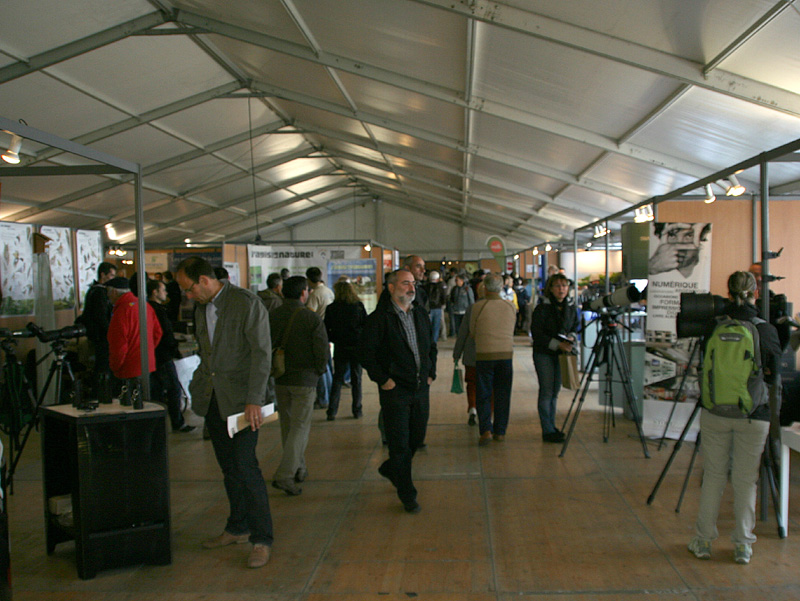
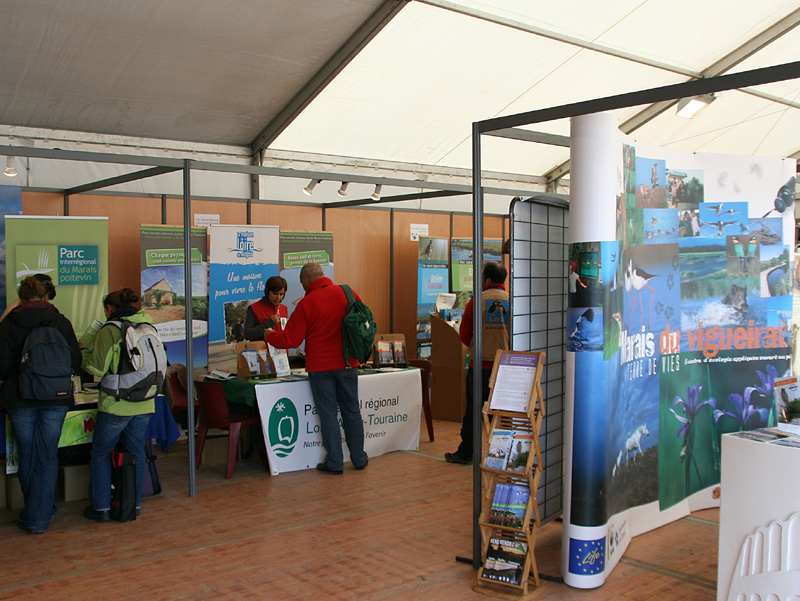
A variety of local trips were on offer, including boat rides out into the mouth of the Loire to look for seabirds, up-river in the opposite direction to look at the riverside wetlands, across the St Nazaire bridge to La Brière, and south-east to the Lac de Grand-Lieu. All of them were booked out, but I did take the opportunity to have a look at the edges of one of the places they visited – the Réserve de Massereau, a few kilometres up-river on the southern side. This is a wetland area, with reedbeds and damp cattle-grazed meadows covering 393 ha, important in winter for Teal (5000+) and other wildfowl, while in summer Bluethroats, Reed and Great Reed Warblers head a list of smaller breeding species. Even in a short visit I saw Cattle and Little Egrets, Cetti's Warbler and several Marsh Harriers, while not far away a party of Honey Buzzards were clearly on migration. Definitely an area worth another visit.
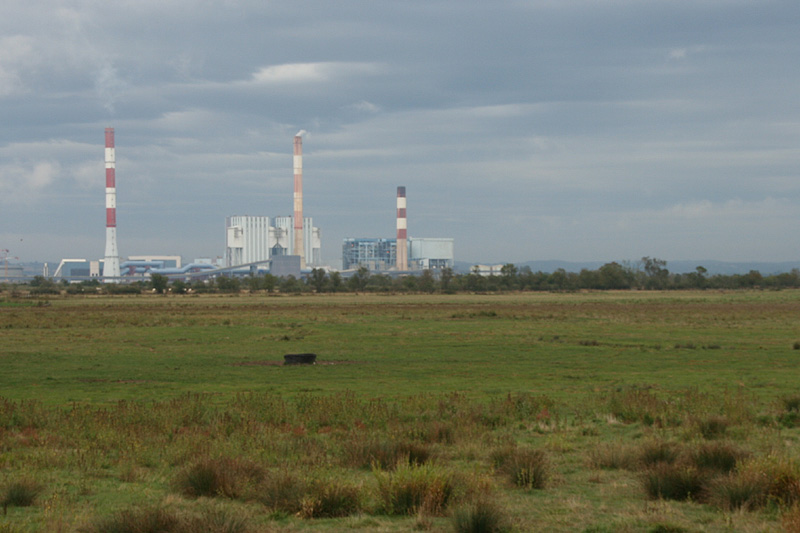
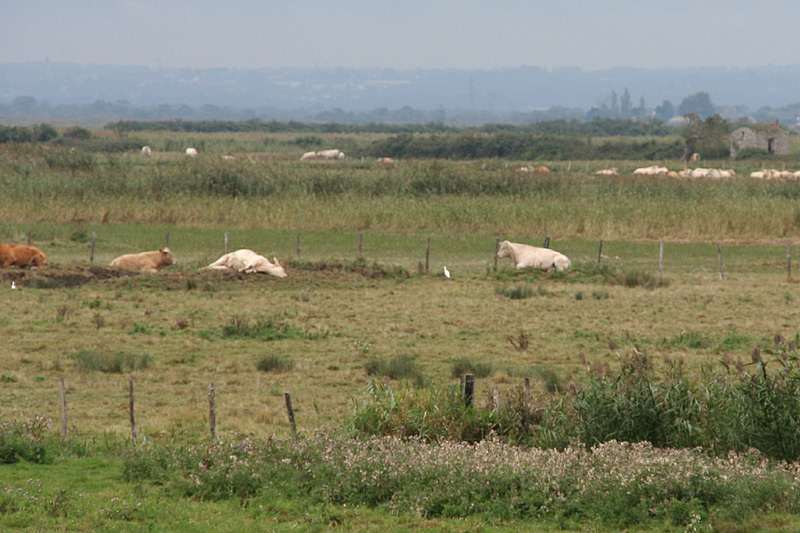
16 September 2012
Col du Soulor (again)
Prompted in part by the item below, I decided to spend a few days at the Col du Soulor, from 26th to 29th August, to see how productive the site was, and hopefully to help in a small way. The Col was certainly an attractive spot, at the top of a wide valley running up from the east and surrounded by spectacular hillsides and peaks. The watchpoint, on the top of a grassy knoll, was in a central position at the head of the valley, just a short distance from the road and a couple of bar/restaurants – a most civilised situation as far as the observers were concerned! The three OCL watchers, Alain, Sébastien and Gwénaël, had been there since the beginning of August, and were due to stay until mid-September, after which they were heading west to a site near the Atlantic coast, primarily to monitor the Woodpigeon passage which peaks during October.
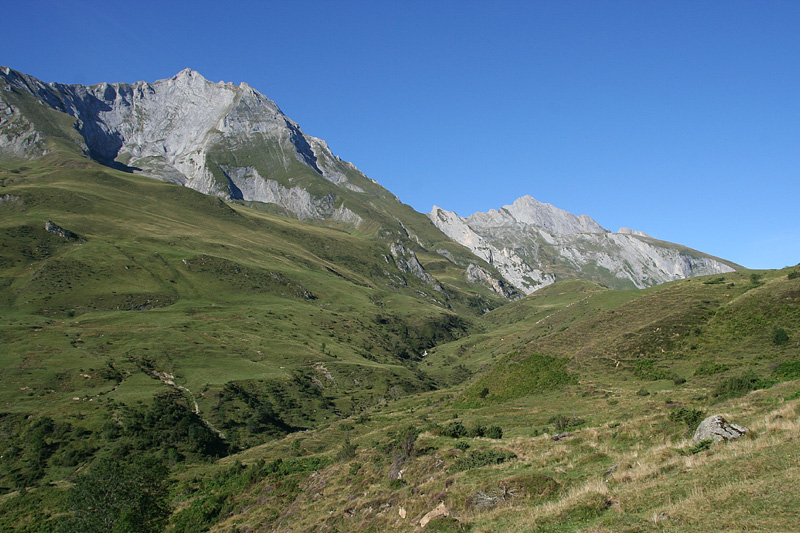
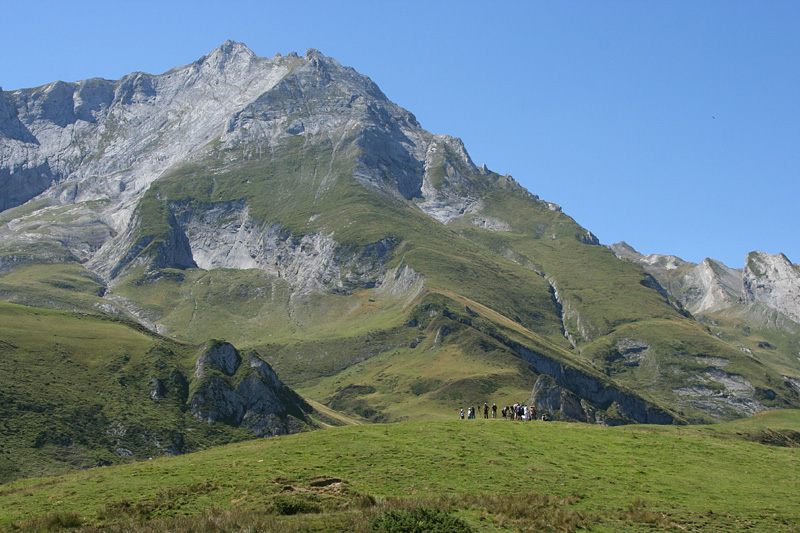
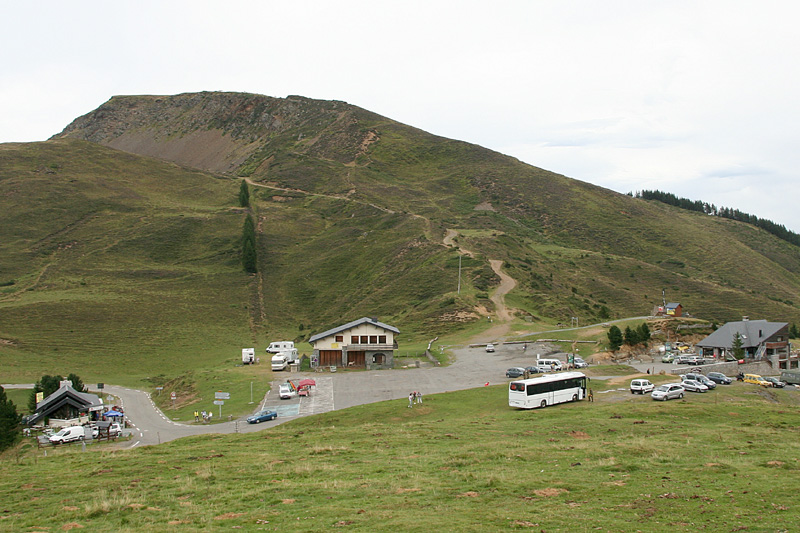
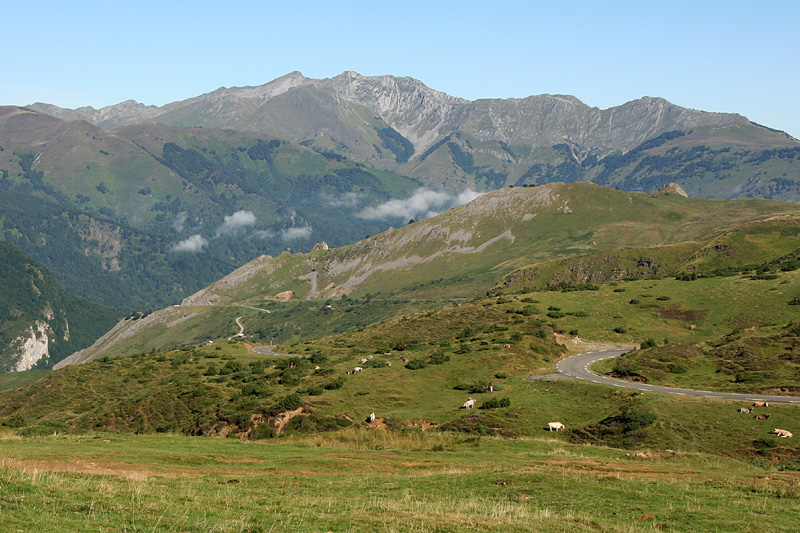
By the time I got there, the main passage of Black Kites was over, c.18,000 birds having been counted, with just the odd birds still on the move. But the Honey Buzzard passage was in full swing, 2500 having already gone through, about half-way to last year's total, with small groups passing every day. As well as counting the birds, the official observers, primarily Sébastien but we all helped out if necessary, were kept busy answering the questions raised by a steady stream of tourists who had come to see the Col itself but were intrigued by the sight of all the optical gear. One piece of equipment new to me, but ideal for showing birds to non-birders, was a set-up of two telescopes in parallel, so that Sébastien could find and track the flying bird through one scope and the visitor could follow it through the other. I took advantage of his expertise myself several times!
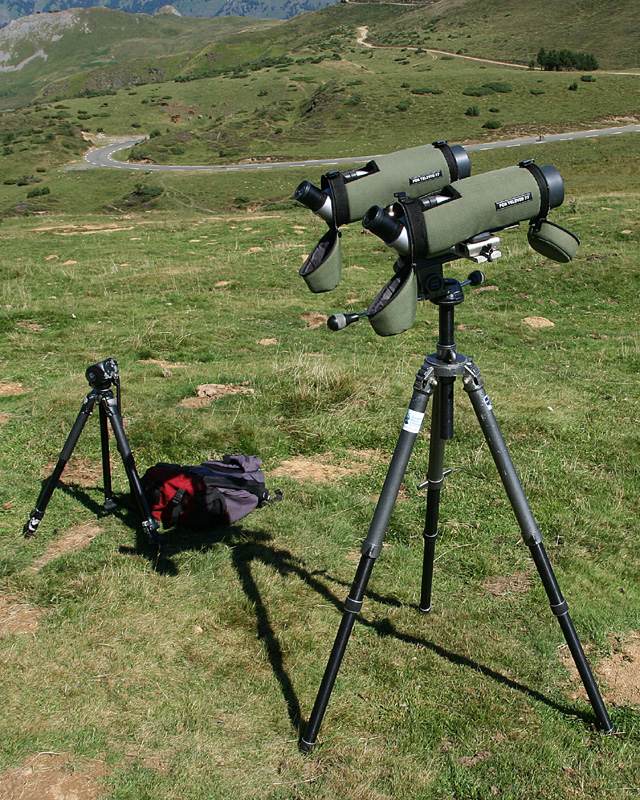
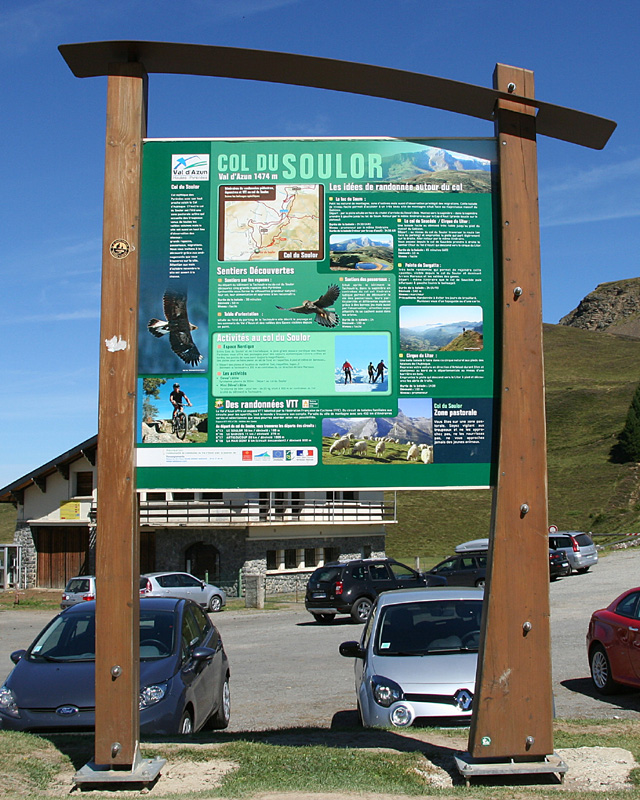
It was good to see that the tourist information by the roadside and in the bars featured the birds and wildlife, as well as the area's significance as part of the Tour de France route and its situation as a starting point for exploring the mountains. In fact there was a short 'bird trail' on the adjacent hillside, with some impressive information boards displaying the migration strategies and general behaviour of the local raptors and other mountain specialities.
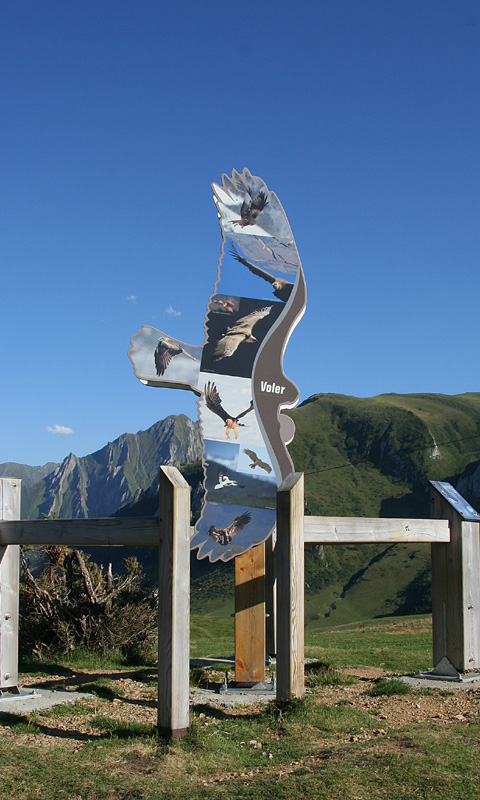
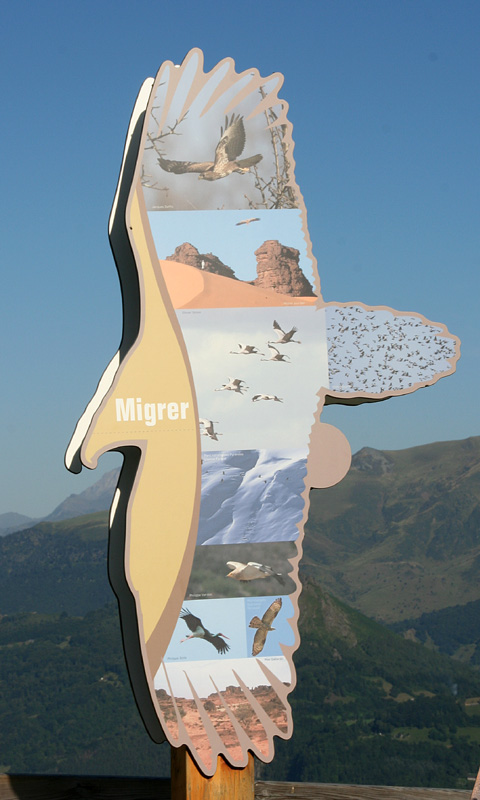
Although the number of birds crossing the Pyrenees here is clearly not as great as at the Col d'Organbidexka to the west, an important plus is the presence of easily seen breeding raptors as well as just the migrants. I saw Lammergeier every day, both adults and immatures, sometimes accompanied by one or two of the local Golden Eagles. Booted and Short-toed Eagles could be seen hunting over the nearby hillsides – although they would be due to leave in September – while Egyptian and Griffon Vultures, Red Kite, Hobby, Sparrowhawk, Buzzard and Kestrel were also seen on a daily basis. Among the migrants also on the move, Marsh, Hen and Montagu's Harriers all passed through while I was there. They are not so easy to distinguish when vertically overhead, so it's an instructive place to be if you are interested in identifying birds of prey, especially with the OCL experts on hand. They hope that they will be able to man the watchpoint again next year, and any assistance is always welcome.
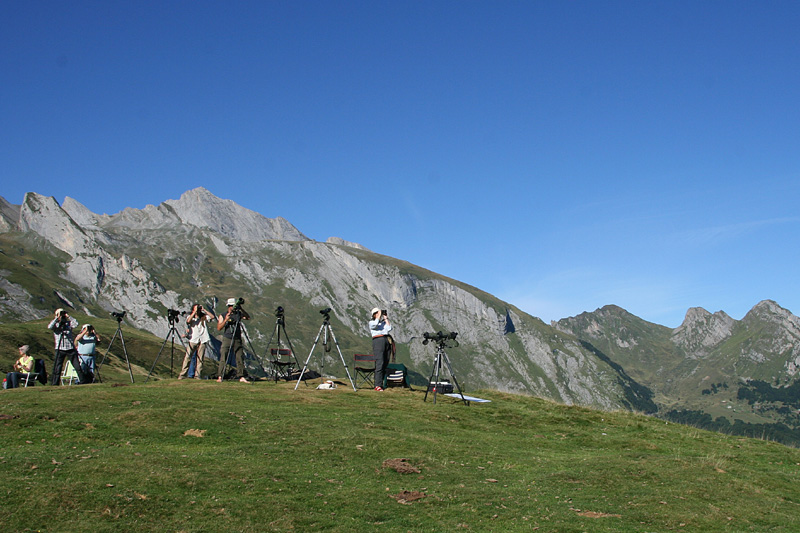
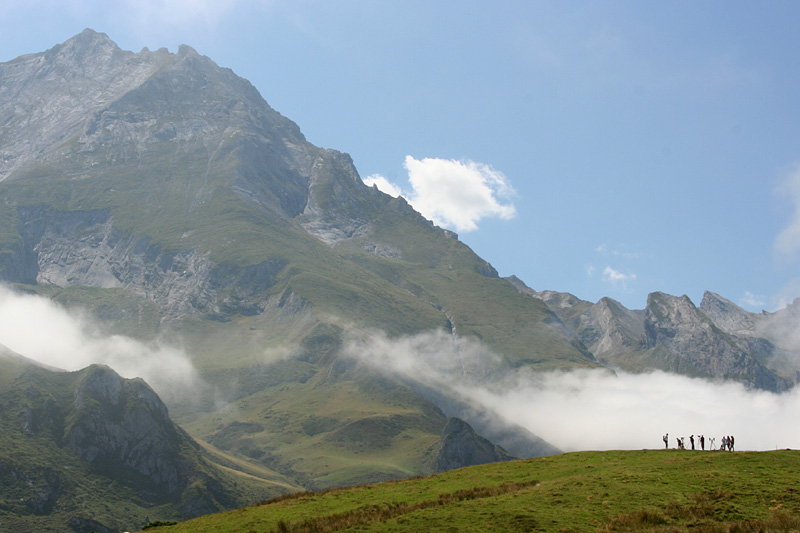
16 September 2012
Duck migration
A little time ago I wrote about the use of nasal saddles as a means of tracking the movements of wildfowl, particularly ducks. This was prompted by the sight of a Tufted Duck carrying such a saddle at Blagdon Lake, in Somerset. Another similarly marked bird, this time a Pochard, appeared at the lake in July, and it appears that it too originated at the Lac de Grand-Lieu in France. Nigel Milbourne, who watches the lake on a regular basis, and updates his extremely informative website virtually every day has been in correspondence with the organisers of the scheme in France, and has kindly allowed me to use the following comments from his website.
"I've received news from Alain Caizergues regarding the male Common Pochard Aythya ferina with nasal saddle 'F V1' that I spotted at Blagdon on the 10th and 12th July. It was captured, ringed, and had the saddle attached on 1st May 2012 at Saint-Philbert-de-Grand-Lieu, France, as an adult of unknown age."
"Interestingly, the new British Trust for Ornithology Bird Study, volume 59 part 3, contains an article on pps 266-278 entitled 'Movements of wintering diving ducks: new insights from nasal saddled individuals' by Gourlay-Larour, M-L., Schricke, V., Sorin, C., L'Hostis, M. and Caizergues, A. The aim of the work was 'to describe the movements of Common Pochards Aythya ferina and Tufted Ducks Aythya fuligula during the wintering season in France.' Their work confirmed that long-distance movements of these two species were not uncommon but surprisingly showed that the movements from Lac de Grand-Lieu did not fit any previously observed pattern, particularly those of Common Pochards. Scott & Rose (1996) suggested the direction of autumn migration for individuals on the North-Western European flyway was towards the southwest, but this study shows that irrespective of gender or age, Common Pochards were more likely to move towards the northeast. Earlier work published by Guillemain & Caizergues (2010) documented migration towards the northeast for both Common Pochards and Tufted Ducks breeding in Western France. The latest study showed that Tufted Ducks move in large numbers towards the northwestern French coast during winter where they may feed on molluscs in coastal lagoons, whereas Common Pochards which tend to feed on aquatic weeds, bulbs and seeds almost never moved in that direction. The difference clearly reflects their respective food preferences. The surprising finding was that in winter when the Lac de Grand-Lieu froze, those birds that hadn't moved away (which were the majority of those ringed) moved off to the east to large lakes in the pre-Alpine area which rarely freeze. However, the authors do point out that there are a number of winter strategies employed by both species, including individuals that move up to 800 km away to northwestern France, the Netherlands, Belgium and Great Britain rather than southern Europe or North Africa, as shown by those that visit the Bristol Reservoirs."
"Common Pochards with nasal saddles have turned up more frequently at Blagdon than Tufted Ducks, rather perversely. The other thing I find confusing is that the authors refer to autumn migration as being over the period October–November, whereas the French birds turn up as early as August, especially Tufted Ducks, which also show a definite gender bias towards drakes at that time. This is a moult migration and many appear to move on afterward. Do they, therefore, carry out moult, autumn and winter movements?"
As ever, almost as many questions as answers! I know that more saddled-marked ducks have been seen at Bladgon, and I'll try to post news of those if and when details come in.
30 July 2012
French Birdfair
There can be few people who do not know how successful and enjoyable an event the British Birdfair at Rutland Water has been – the 24th one is due to take place from 17th–19th August. So it is not surprising that the French have decided to launch one of their own, with the LPO the prime mover in the event. It is due to be held in September, from the 21st to the 23rd, the venue being Paimboeuf, on the banks of the River Loire, between Nantes and the bridge at St Nazaire. There will, of course, be lots of exhibitor stands promoting bird-related wares such as optics and holidays, plus a range of lectures and question-and-answer sessions with various expert speakers. Several artists are showing their work, and looking forward to interacting with the public. Visits to local areas of interest are also on offer, including boat trips on the Loire and out into the open sea to look for more pelagic species. There is plenty of entertainment laid on for children, and music is on the menu too. For more details, and a downloadable programme, see the fair's website: http://www.birdfair.fr.
30 July 2012
A new Lammergeier reintroduction project
With its Pyrenean population slowly increasing and the reintroduced birds of the Alps also now reasonably well established, the Lammergeier's future in western Europe looks a little more secure than was the case a few years ago. But it would be even better if the two groups could intermingle on a more regular basis, and with this in mind two young birds, reared in capitivity, were released into the limestone gorges of the Grands Causses area of the Cevennes National Park, in the Massif Central, midway between the other two population centres. This area is, of course, the site of previous extremely successful vulture reintroduction projects involving, first, Griffons, followed later by Black Vultures. Both of the two young Lammergeiers have been fitted with GPS satellite tags, so that their movements can be followed over time. As of today, they have not gone very far, just moving along the Jonte gorges it seems, but if past experience is anything to go by, they may well move much further in due course. Their positions can (sometimes!) be followed on the website http://rapaces.lpo.fr/gypaete-grands-causses/le-suivi-des-oiseaux.
26 June 2012
Cross-Channel Great Bustards
In January 2006 I reported on three Great Bustards from the Salisbury Plain reintroduction project that had migrated to France. One was found dead under electricity cables near Angers, one was seen in Brittany and the other made it as far as Toulouse. It is believed that neither of the latter two made it back to the UK either.
However, a radio-tagged female (T5), released in September 2011, has recently managed to cross the Channel in both directions. Her first port of call was Worth Matravers in Dorset on 21st and 22nd November 2011 but on the 18th December she was reported to be in Normandy, at Montchaton on the Cherbourg peninsula, not far from Coutances. Incidentally a Great Bustard seen flying south over Portland Bill earlier in November gives a hint as to the route she might have taken. She remained in the same general area, feeding in a field of lucerne, until at least the 25th March 2012, with local people keeping a watchful eye on her. The next report, however, was on 17th May when she was found at Auderville, at the very tip of the Cherbourg peninsula, about as near to the UK as is possible in that area without getting her feet wet! By the 26th May she had recrossed the Channel, being seen near Exmouth in Devon on that date, rapidly moving on to near Weston-super-Mare in Somerset by the 28th, before reappearing close to her original release site on the 31st May. Despite the journey she seemed in very good shape, and has attached herself firmly to other bustards in the area, presumably being glad of the company after so long alone! Although the Great Bustards from the reintroduction project often disperse widely across southern England, this is the first time one has returned from France unscathed.
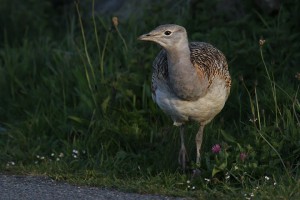
For more information on the Great Bustard Group's release project, see their website http://greatbustard.org. They kindly let me use one of the photos of T5 taken near Auderville.
4 June 2012
Little Bustards and Stone Curlews
The recently published annual report for 2011 from LPO-Vienne summarises the post-breeding counts in their area for these two species, both emblematic of the arable plains of Poitou, and both having sustained long-term declines allied to agricultural intensification. For the Little Bustard, 100–110 birds were considered to be present in 2010 and 2011, as opposed to 80–90 in 2005 and 2009. The slight increase was possibly due to better observer coverage, but the warm and dry spring of 2011 may well have enabled the eggs and chicks to get through to fledging more successfully, and also to have increased the amount of prey available to nourish the young post-fledging. All this is despite the number of calling males (c. 80) located in the spring having shown a slight decrease from earlier counts. Overall, the feeling was that the Little Bustard population in the Vienne area was currently stable, although remaining fragile.
Stone Curlews in the same area also gather into flocks at the end of the breeding season, and coordinated counts take place twice in the autumn. The first, over 3–4 September 2011, located 1038 individuals, as compared with 490 in 2010, 706 in 2009, 544 in 2008, 401 in 2007 and 432 in 2006. The second count took place on 1–2 October, when 2033 Stone Curlews were found, as opposed to 1204 in 2010, 1271 in 2009, 995 in 2008, 1511 in 2007 and 690 in 2006. Again, the ever-increasing observer effort is playing a part, but nevertheless the increase does seem to be real, although again the warm dry spring in 2011 will have helped.
4 June 2012
Col du Soulor
Although the organisation Organbidexka Col Libre (OCL) is still associated with the migration watch-point in the western Pyrenees from which it takes its name, it has handed over the main responsibility for the counts there to the LPO-Aquitaine group. However, it has now set up a similar autumn watch-point at the Col du Soulor, a 1474 metre pass in the central Pyrenees, roughly south of Pau. Followers of the Tour de France cycle race may well be familiar with its name. Watchers will be present from 1 August to 15 September 2012, and as ever all are welcome to come and help, or just to join in with the spectacle. During the same period in 2011, 9557 migrating raptors were counted here, of which the majority were Honey Buzzards (5240) and Black Kites (3969), although the bulk of the latter had already gone through by the time the watchers arrived. In addition, both Black (84) and White Storks (271) were seen heading south. Other migrants were Short-toed Eagle (27), Marsh Harrier (58) and Osprey (28), among others, while local resident raptors seen on an almost daily basis included Griffon and Egyptian Vultures, Lammergeier, Golden Eagle and Peregrine. As well as counting the birds, the participants are there to explain to the public what migration is all about, including reassuring the numerous adults who apparently still seem to think that birds of prey might attack them!
25 May 2012
Great White Egret
On a recent visit to Shapwick Heath National Nature Reserve in Somerset, I became aware that 'something was up', from the extra monitoring activity that was clearly going on. That 'something' has now been revealed to be the fact that Britain's first breeding attempt by a pair of Great White Egrets was taking place. The eggs have now hatched, and the young are being fed, so hopefully the most critical period is over. As there had been up to eight Great White Egrets at Shapwick and at the nearby RSPB reserve of Ham Wall at various times over the past few years, this breeding attempt was not an entirely unexpected event, but is nevertheless a very welcome development. As the female of the pair is known, from the ring it is carrying, to have come from a nest in France, I made a check on how numbers have been increasing on the other side of the Channel in recent years to try to put the event into a wider context.
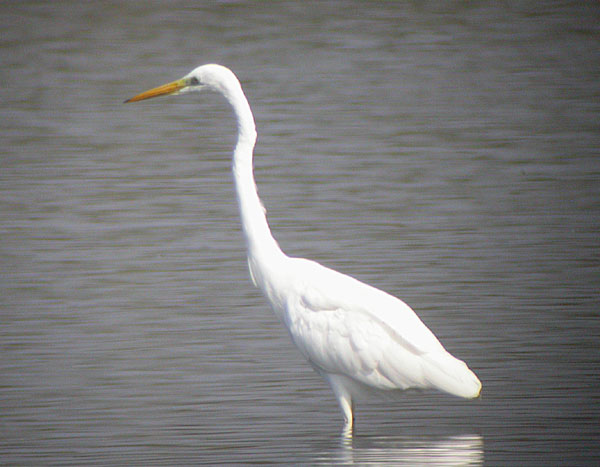
With the bulk of its breeding population in eastern Europe and beyond, the species only started to become anything more than a vagrant to France in the 1980s, when up to five birds started to spend the winter in the Camargue. Wintering numbers increased slowly over the next decade, with 200 being counted in 1990. After that the pace increased, with 3000 counted in January 2007, and birds could be found almost anywhere across the country. The first breeding attempt took place in 1994, at the Lac de Grand-Lieu, south-west of Nantes on the River Loire, and shortly afterwards nests were located in the Camargue, on the Mediterranean coast, and in les Dombes near Lyon. By 2008 the total number of pairs had reached 200, of which the vast majority, 160, were at the Lac de Grand-Lieu. An offshoot of the colony here is in the marshes at Besné, just to the east of the Brière marshes, another reserve area just north of the Loire. It was here that the female of the Shapwick pair was ringed in May 2009. With Little Bitterns having nested at Loxton Marsh (part of the Ham Wall reserve) in 2010, there is some speculation as to what the next 'southern species' on these Avalon marshes might be. It is perhaps then of some interest to note that a pair of Glossy Ibises bred successfully in 2011 at the Lac de Grand-Lieu! See here for more information on that.
25 May 2012
Turtle Dove and Cuckoo
I have been browsing through the recently published 'Atlas des oiseaux nicheurs de Midi-Pyrénées', a most impressive tome setting out the results of a survey of the breeding birds of this region of France. The Midi-Pyrénées administrative region, the largest such in France, stretches from the Massif Central, south-west through the River Garonne valley around Toulouse, as far as the central Pyrenees along the Spanish border. The survey took place from 2007 to 2010, and the book contains detailed accounts on each of the 190 species found to have at least shown some signs of breeding in the area. Of those, I picked out a couple which seem to be holding up reasonably well, although faring quite badly in the UK.
Turtle Doves were found in almost every 10 km square surveyed, apart from in the higher parts of the Pyrenees and Massif Central, with 1000 metres being the upper altitude limit. Despite much of the region being under cultivation, it seems that enough semi-natural and mixed farmland habitat remains to provide this dove with living space. Only in the most intensively cultivated areas were birds difficult to find. The distribution had not changed significantly from that of the previous atlas which covered the years 1985 to 1989. Population density is harder to be sure of from such surveys, and nationally a decline of 21% is estimated for France as a whole. Hunting pressures in France seem to have eased over the past few years, with the abandonment of spring shooting in the Medoc (not least due to action by the LPO), although huge numbers are still killed on their migration routes and wintering grounds in Morocco and Senegal.
Similarly, Cuckoos were also found in most 10 km squares over the whole region, only the mountains above 1500 metres being avoided, just as in the earlier survey. After a decline in France that took place up to the turn of the century, it seems that numbers have now started to increase again, and are now thought to be back to the levels of the 1990s. The caterpillars of the pine processionary moth is one of its favoured food sources, and in France this is currently expanding in numbers, so perhaps there is a link between the two.
In any case, it is nice to be able to report that there is at least one part of Europe where the characteristic sounds of summer provided by these two species can still be heard relatively easily. Incidentally, the Atlas (all in French, of course) is available in the UK, via Amazon for instance, at a price no higher than you would pay in France. In addition to the texts, a double-spread per species, there are plenty of photographs of the birds and the wonderful landscapes in which they can be found.
25 February 2012
Spring migration
That migration watch-points in France are manned in autumn is a fairly well known fact – Organbidexka, Fort de la Revère, Cap Gris Nez, etc. – but there are many that only really come into their own in the spring, and many of these are also watched on a regular basis. One such is the Pointe de Grave, at the mouth of the Gironde estuary on the west coast near Bordeaux. The regional group, LPO-Aquitaine, is just about to put its team of watchers in place, for a stint that runs from 1st March to 31st May, counting all the birds that are heading north to their breeding grounds. Spoonbills, Hobbies, Turtle Doves and Swifts are some of the stars, but over 150 species have been recorded each season in the past. Volunteers are always welcome, even if they only stay for a day or two. If you just want to check the results day-by-day, they are posted, along with those from other sites, on http://www.migraction.net. In fact this year the Pointe de Grave has already been manned from 26th January by volunteers from the Association pour la Protection des Animaux Sauvages (ASPAS) who, I notice, have logged 10,456 Greylag Geese already. For those who can read French, an account of the results of all the sites manned by LPO-Aquitaine in 2011 is available for download as a PDF here.
25 February 2012
The Status of and Trends in the French Avifauna, 2011
This is the (translated) title of a report recently published by the French Natural History Museum in association with the LPO. Using birds as an indicator, one of the purposes of the report is to see how far the widely supported aim of stopping the widespread declines in biodiversity has succeeded, or not. As can be imaagined, the results to date are somewhat mixed. On the positive side, the rarer birds are, on the whole, doing reasonably well. Legal protection and targeted conservation action has led to a significant increase in the populations of most of the herons and egrets, and the same can be said of many birds of prey and some of the shorebirds. The big problem is with 'common' birds, the ones that most people expect to see in towns and countryside on a day-to-day basis. Here the picture is, by-and-large, one of steady and remorseless decline. Birds like Skylarks, Whinchats, various buntings, etc., although still widespread, are becoming less and less numerous in France, just as has happened in the UK. Agricultural changes account for the loss of many species, but even in urban areas, the 'tidying-up' of open areas and buildings themselves has meant that birds like Swifts and House Sparrows, for instance, find it more difficult to find suitable nesting sites. Climate change is also playing a part, and it is interesting to see how the Willow Tit in France, which used to be found over much of the north-eastern half of the country, is now only really numerous along the eastern border, with numbers elsewhere quite fragmented. On the other hand, Sardinian Warblers have started to spread north along the Rhône valley and west towards Toulouse from their long-established Mediterranean strongholds. There are many examples of how the creation of reserves and the implementation of conservation plans have met with great success (Gannets in Brittany, Lesser Kestrels in Languedoc, vultures in the Massif Central) and this work needs to continue. But protecting the everyday birds is something that still needs more thought and more action, something of which the LPO is very much aware.
23 February 2012
Glossy Ibis range expansion
An item in issue 18-2 of Ornithos reports the fact that a pair of Glossy Ibises bred successfully at the Lac de Grand-Lieu, south-west of Nantes, in 2011. This is just the most recent of a series of instances of how this species is currently enjoying a population boom in western Europe. In Spain, breeding only became an annual event from 1993, but by 2007 the Iberian population had reached 3777 pairs, the vast majority in the Coto Doñana, with smaller numbers in the Ebro delta. In France, the Camargue population has grown rapidly from 14 pairs in 2006 to 478 in 2010. On the west coast of France, where the species was only a sporadic visitor up to a dozen or so years ago, it has become an annual visitor to the Lac de Grand-Lieu since 2005, although mostly in the late summer, when dispersing birds from further south have moved north, as has also happened recently in Britain. But in 2011, up to four birds arrived at Grand-Lieu in April, and soon became associated with a mixed colony of Grey Herons, Little, Cattle and Great White Egrets, Spoonbills and the invasive Sacred Ibises. Control measures to limit the numbers of the latter led to the discovery of a Glossy Ibis nest with eggs, and later with three young, which were then duly ringed. This is the first French breeding record for Glossy Ibis outside the Mediterranean area, but it is likely not to be the last. One wonders how soon breeding birds will arrive in Britain?
23 February 2012
Défilé de l'Écluse
Strategically placed to the south-west of Lac Léman and Geneva, the gorge of the Défilé de l'Écluse forms a splendid funnel for migrants heading south during the autumn along the Jura ridges of the Rhône-Alpes region of eastern France. In 2011, this watchpoint was manned from mid-July through to the beginning of November by LPO staff plus over 40 volunteers, putting in over 1000 hours to log the numbers of passing birds. Nearly 70 species were noted, and for birds of prey a new record of more than 43,000 individuals of 16 species was achieved. Among the most notable were 14,699 Common Buzzards, 11,413 Black Kites, 7362 Red Kites, 1798 Sparrowhawks, 824 Kestrels, 729 Marsh Harriers, 137 Ospreys and 73 Merlins. Record numbers of White (1640) and Black (187) Storks were also recorded, plus 6924 Cormorants. As well as being an important method of checking on population fluctuations, spending time watching all these magnificent birds passing over is extremely enjoyable for all concerned, and visitors, are always welcome to join the teams, even if only for a short period.
23 February 2012
Slender-billed Gull breeding success
The Salins d'Hyères are a series of former saltpans on the Mediterranean coast, to the east of Toulon, purchased by the Conservatoire du Littoral when commercial salt production ceased in 2001, in order to protect the area from urban development. It has long been an important area for non-breeding Flamingos from the Camargue, particularly in autumn and winter, but also holds a good number of breeding birds such as Avocet, Black-winged Stilt, and Little and Common Terns. Over several years, nesting islets have been constructed in the saltpans of one major part of the area, the Salins des Pesquiers, and in 2011 this work bore fruit when 184 pairs of Slender-billed Gulls arrived and settled down to breed. This is a very localised breeding species in France, the main colonies being in the Camargue, so this range extension is most welcome. Productivity was excellent, and researchers from the Tour du Valat were able to ring no fewer than 248 young, in an effort to track their movements and survival rates.
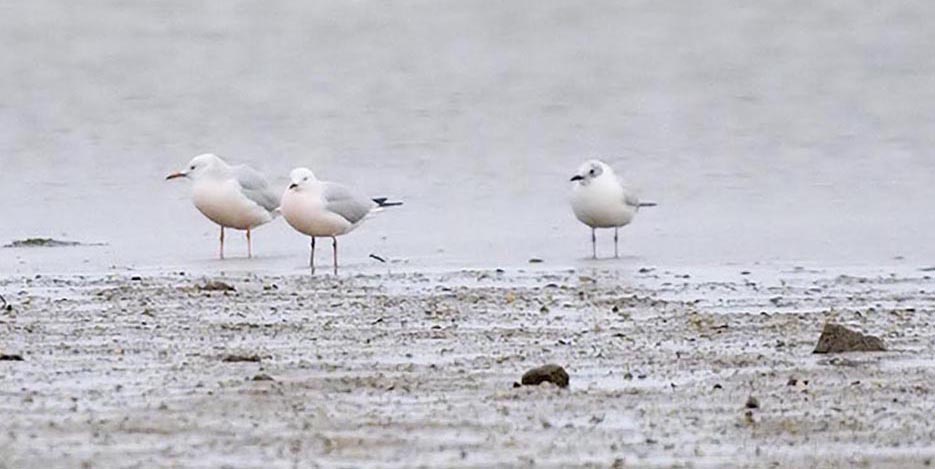
Thanks to David Wilson for the picture, taken not far away in the Camargue.
News items for 2011
11 December 2011
Shrikes
In the autumn issue of L'Oiseau Magazine there is an article summarising the current populations of the four species of shrikes in France which are declining the most severely (the fifth, Red-backed, is for the moment still present in good numbers). The LPO is in the process of compiling an action plan to see what can be done to halt, and if possible reverse, the reductions in numbers and in ranges. The focus will be first to map the current populations as accurately as possible, and to ascertain the various species' habitat and food requirements, and find out the effects that agricultural developments/chemicals are having on both the birds themselves and their key prey items. There is an urgent need to find the most effective ways of maintaining sufficient suitable habitat to support the birds' requirements during the breeding season, and to work with farmers and landowners to come up with solutions compatible with their needs too. Shrikes tend to favour rather open habitats with a mix of scrub, hedges, meadows, etc., the kind of semi-natural 'ordinary' countryside that it is difficult to motivate people to protect, as they think there must be lots of it everywhere. Which there was at one time, but not now! Any solution will have to be more widely based than, say, just setting up special reserves or protection areas.
The most threatened species is of course the Lesser Grey Shrike, with only about 16 pairs located in 2011, all in the Aude/Hérault area of Languedoc-Roussillon. This remnant population is under constant surveillance and benefits from much active protection, but such a tiny isolated population clearly has the odds stacked against it. As far as the Great Grey Shrike is concerned, a paper in the Sept/October issue of Ornithos (18-5) reports on the results of a survey, carried out in 2009, of all the places in France where the species had ever been known to occur. In the fifteen years since the previous complete survey (1993–94) numbers have fallen by 75%, with perhaps fewer than 1000 pairs now present. In addition, the range has shrunk to a nucleus around the Auvergne area of the Massif Central (305–860 pairs), well separated from the smaller numbers still to be found in north-east France along the borders with Belgium, Germany and Switzerland. Habitat destruction and fluctuations in their key prey species, the Common Vole, are two features common to the declines everywhere.
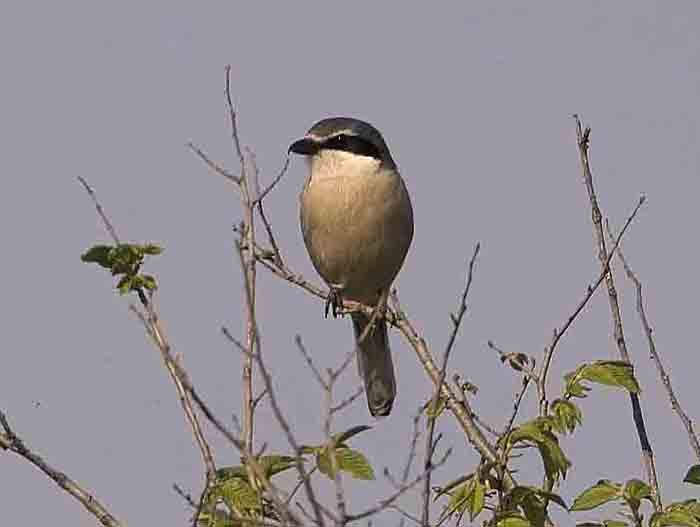
The closely related Southern (or Iberian) Grey Shrike (thanks to Derek Moore for the photo) replaces the previous species around the Mediterranean area of France and down through Spain. Provisional figures suggest a French population of between 650 and 1150 pairs, a 40% reduction since the 1993–94 survey. It is mostly resident, although some birds wander westwards as far as Aquitaine in winter. The fourth species, the Woodchat Shrike, is also primarily a Mediterranean bird these days, although some can be found as far north as a line between the Vendée and the Ardennes, with a separate subspecies breeding in Corsica. In addition to being typical of the garrigues of Provence and Languedoc-Roussillon, further north it can be found, for instance, in orchard country in Lorraine and cattle pastures with tall hedges in the Burgundy region. In the 1990s there were estimated to be around 10,000 pairs, but the current total is almost certainly far less than this. Climate change might possibly help a northward spread of any or all of the shrikes, but habitat and food requirements are probably more important factors.
11 December 2011
A round-up of recent activities across the country
Every issue of L'Oiseau Magazine carries a summary of news from the LPO's various groups around France, and it's impressive to see how numerous and varied they are. Here is just a selection from the latest issue.
- Insertion of a 'walkway' under bridges on the River Antenne (Charente-Maritime) so that the increasingly rare European Mink can get from one bank to the other without crossing the roadway itself (they seem to avoid swimming unnecessarily!). Significant numbers of mink, along with many amphibians, are killed on the roads in France, and this is just one of several schemes in place to reduce this hazard.
- Rescuing young White Storks from a nest in Breuil-Magné (also Charente-Maritime), with the aid of the electricity company on whose pylon the nest had been built. A short-circuit had caused the nest to catch fire, so the young, which fortuitously had survived the blaze, were taken into care and subsequently successfully released into the wild. Further north along the west coast of France, in Loire-Atlantique, the LPO has recently signed a convention with the electricity company there, RTE Ouest, to exchange information between naturalists and engineers concerning the protection of the storks that frequently nest on electricity pylons in that area too.
- In the same general area, the LPO has signed a convention with the Office National des Forêts (ONF) to work with foresters to reduce the risk of disturbance to forest-nesting birds such as Nightjars, birds of prey, etc.
- A tasting of local produce at Peyrelade, overlooking the River Tarn gorges, accompanied by an exhibition of photos, activities for children, and a theatrical show based on the lifestyles of the vultures which could be seen passing nearby at the same time. The local school-children performed a song they had composed themselves, also on the theme of vultures, and the event – so French! – was deemed a great success, and to be repeated. This is just one of several similar events held in various parts of France to involve local people in the natural world that surrounds them, and of which they are often barely aware.
- Rescue, recuperation and release, after six months in care at Rosenswiller (Alsace), of an injured Eagle Owl picked up near Strasbourg. Similarly, the local firemen had to be called out to rescue a Barn Owl that had got its claws trapped in the top of a street lamp in Elven (Morbihan), but luckily this bird only needed a few days to recuperate. The rescue and rehabilitation of injured birds is something in which the LPO has built up a great expertise over the years, particularly with regard to seabirds and birds of prey.
- Successful breeding of a pair of Peregrines on a factory in Dunkerque (Nord), using an artificial nestbox supplied by the local LPO group. The female of this pair had been ringed as a chick in The Netherlands, so had not travelled far before settling down to breed. Three young successfully fledged in early June. Some images and history are available on the web.
- The LPO in the Provence area have started running short training courses in various aspects of natural history – dragonflies, grasshoppers, flowers, and also birds. Certainly worth a look if you are spending time in that area.
11 December 2011
Cranes in winter
At this very moment there will be thousands of Cranes in France, as they are increasingly wintering north of the Pyrenees, and at a wider range of sites. The summary for the 2010/2011 season has recently been produced, and indicates that once again previous records have been beaten, with around 110,000 birds counted from all sites combined, in January 2011. The comparable figure for the previous winter was 103,000, itself a new record at the time. A period of cold weather pushed wintering birds from Germany into France, where conditions once again were favourable enough so that they did not all move on to Spain. Although the really big numbers are to be found in Champagne-Ardenne (14,628 at the Lac du Der) and Aquitaine (29,157 at Captieux; 25,198 at Arjuzanx), there are other places where Cranes are becoming more regular in winter, as well as on passage. For instance, 3200 could be found in Lorraine in mid January 2011, 15,024 at a variety of sites in the Centre region, 3550 in the Camargue, and 1780 at the Lac de Puydarrieux, in Midi-Pyrenées. I was at this latter site on 15th October 2011, and watched the first 21 birds that had just flown in, with others passing overhead on their way to Spain, a most impressive sight. Twenty-six Great White Egrets also arrived while I was there, this being another regular wintering species, along with good numbers of Greylag Geese and other wildfowl. Puydarrieux is worth a visit at any time of year, with Booted Eagle and Black Woodpecker breeding nearby, and where almost anything can turn up on passage. Situated close to the Pyrenees, the views in winter, especially, can be very dramatic. The following photos were taken in January 2008.
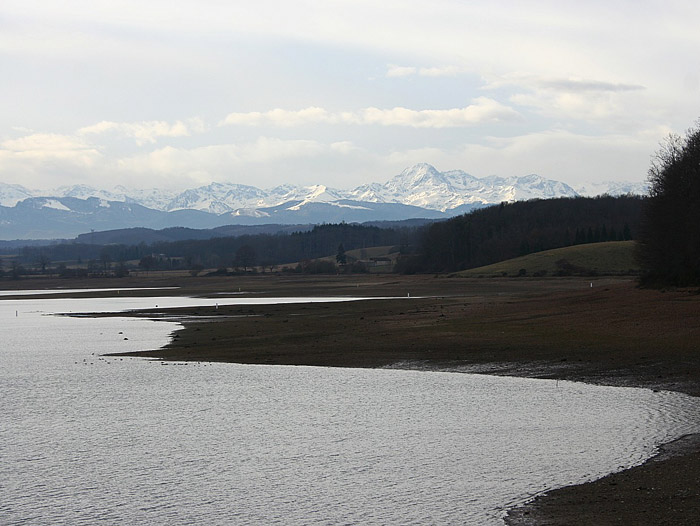

11 December 2011
Rapaces de France
This is the name of the annual supplement to L'Oiseau Magazine, available at an extra 4.50 euros, and concentrating on birds of prey. I've been leafing through the latest edition, No. 13, and a couple of items particularly caught my eye. One concerns Bonelli's Eagle, which currently has just 30 or so pairs breeding in France. A captive breeding project is under way, with nine pairs held in France for this purpose. Getting these eagles to breed in captivity is not an easy task but, in 2011, four of the pairs laid eggs, not all fertile, two young eventually being raised, one released in Majorca, the other in Spanish Navarre. For the moment, none are being released in France, although this situation is under review. As to the wild French population, a recent analysis of ringing/resighting results has shown that the ongoing neutralisation of power lines within the species' breeding range seems to having an effect, in that the numbers being found electrocuted has dropped significantly since the project started in 1997. Younger birds are still at higher risk than adults, and the proportion killed 'by other means' has almost inevitably increased slightly, though not enough to counter the reduced numbers being electrocuted. Productivity has also increased to 0.91 young per pair, but this is still not enough to maintain a self-sustaining population. It appears, therefore, that a small influx from Spain (confirmed by ringing recoveries/sightings) is aiding the increase in the French population. As well as working closely with their Spanish colleagues (who have problems of their own with poisoning and shooting on the other side of the border), the French are concentrating on improving the survival rate of young Bonelli's Eagles, to get it nearer that of the adults.
The same issue also reports some investigations into the feeding strategies of Short-toed Eagles. It appears that at the start of the season they are forced to search for small items, such as Wall Lizards, available in relatively large numbers and easy to catch, but each item quite small. In March/April, when the eagles return, they don't have much choice as the larger snakes and lizards have not yet emerged from winter inactivity. But as soon as they do, the eagles switch to hunting those. It may take two or three hours to locate and kill a large snake, but the effort seems to be worth it, in that the prey caught will be much more valuable energy-wise. For a bird that can go without food for several days, spending a few hours on hunting for a worthwhile meal seems to be good recompense for the time expended. Where there are overlapping territories, parts are defended fiercely, but other hunting grounds seem to be shared reasonably amicably between adjacent pairs. At the end of the season, large insects form a greater proportion of prey items, particularly among young birds which take some time to become expert at catching reptiles.
4 November 2011
LPO headquarters in Rochefort
In October, during a trip to France, I took the chance to drop into the LPO's headquarters in Rochefort, for the first time for a year or two. Previously their offices were in the historic buildings of La Corderie Royale, right next to the River Charente. Having outgrown the space available (they shared it with the Conservatoire du Littoral, which exists to purchase and protect the coastal areas of France), they moved in 2009 to the equally historic Fonderies Royales. Both were part of the naval arsenal built up during the time of Louis XIV to support France's fleet during the various wars of the 17th century. The Corderie Royale was the rope-making factory for the cordage needed for the wooden ships of those times, hence its enormous length, as the ropes needed to be laid out straight during their manufacture.
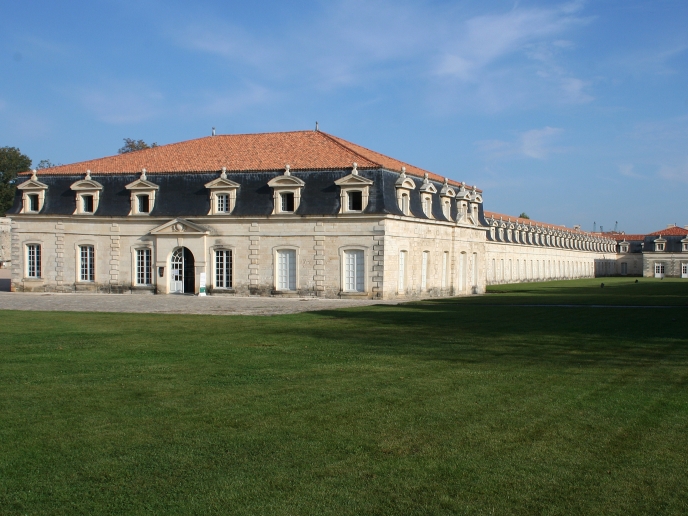
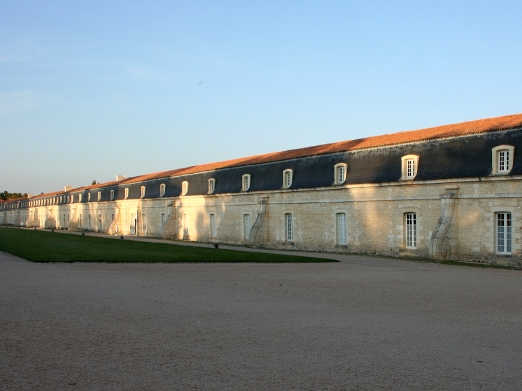
Les Fonderies Royales were dedicated to the casting of bronze cannons and cannonballs for warships, and their real heyday was from the late 17th century through to the mid 18th. But by the end of Louis XIV's reign, the state's priorities had shifted away from naval warfare and this, together with the increasing use of cannons made of iron, led to the gradual decline in the site's importance. Although the facilities were used for casting bronze church bells and for various items of naval machinery, it later became a barracks, and finally, in the 20th century was just used as a warehouse by the local authorities. In 2007, the LPO took possession, and started the major works needed to turn it into offices suitable for up to 100 people, incorporating modern techniques to make its 'energy footprint' as low as possible (solar panels, wood-generated heating, borrowed light for illumination, etc.) while at the same time maintaining all its historic features. An expensive operation, but well-supported with public funds. Although the offices are not really open to the public, the outside and entrance area are worth a look, even if you don't go any further.
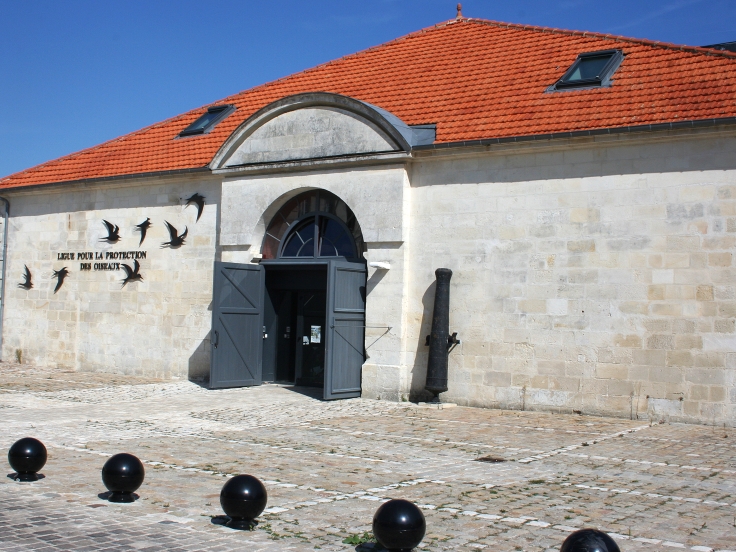
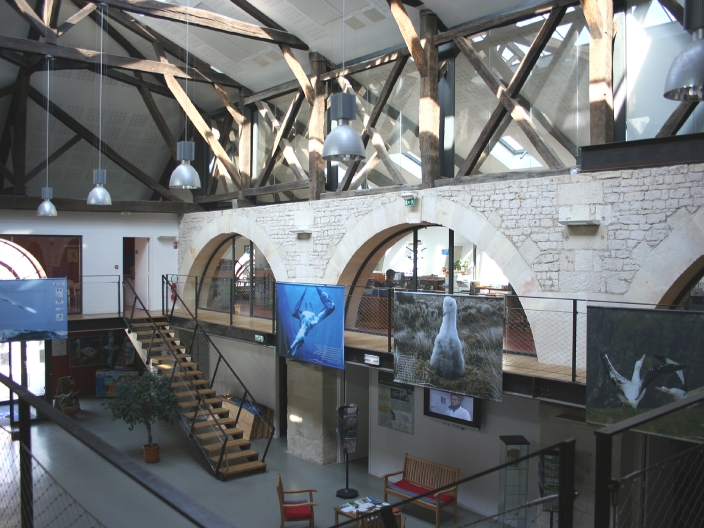
Rochefort itself is well worth a visit if you are at interested in naval history. Related sites in the town include a restored dry dock, and the ongoing project to reconstruct the Hermione, the ship that took La Fayette to fight on the side of the insurgents in the American War of Independence.
4 November 2011
Marais de Brouage
Although the LPO does not have anything like the number of reserves as does the RSPB, it does have several in the coastal marshes close to Rochefort. While in the area I managed to check out the Marais de Brouage, a few kilometres to the south of the town, beyond the mouth of the River Charente. Here the LPO manages the réserve naturelle of Moëze-Oléron, encompassing the saltmarshes on the mainland shore and stretching across the vast mudflats between here and the Ile d'Oléron directly opposite to include the eastern shore of that island as well, 6714 hectares in all. There is a visitor centre in old farm buildings at Plaisance, the best starting point for a visit, well-supplied with maps showing the main access routes, as well as some lovely displays explaining how the various habitats have come about, and what you are likely to see at different times of the year.

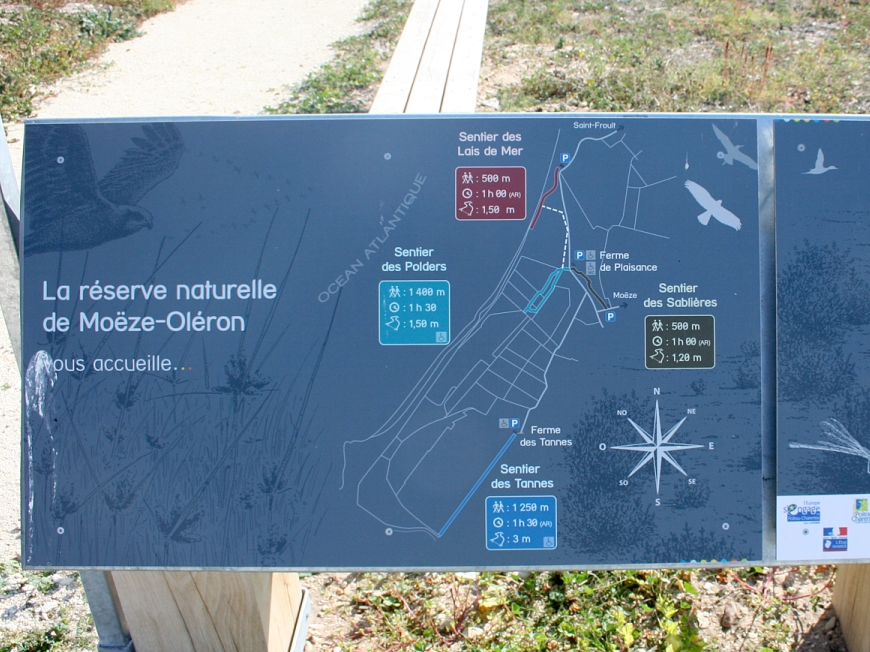
Back from the dyke along the shoreline is a mosaic of old saltpans, now mostly grassed over and dedicated to grazing livestock, but retaining many saline lagoons and freshwater ditches, all liable to flooding at various times. At high tide, the waders and wildfowl out on the mudflats gather here in vast numbers, although of course many species will also feed here whatever the state of the tide. I was there in October, and the long shallow lagoons were thronged with a wide variety of waders – Curlew Sandpipers, Little Stints, Spotted Redshank and Greenshanks among others – disturbed from time to time by Marsh and Hen Harriers quartering low overhead.
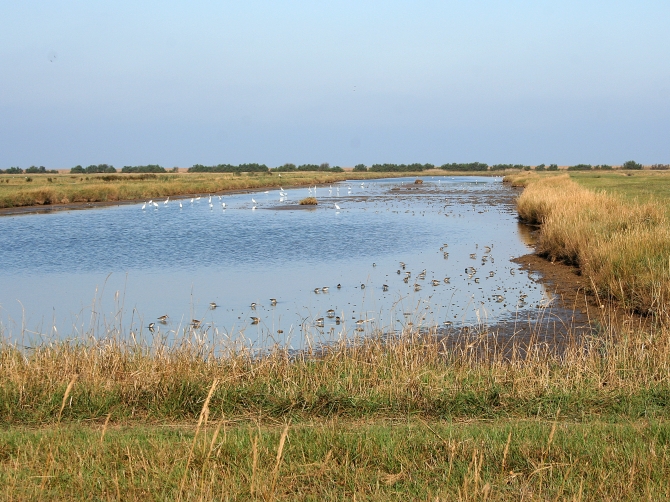

Cattle and Little Egrets were numerous, and at least three Great White Egrets plus several Spoonbills were also present. Several poles with nesting platforms dotted about were the only evidence of the White Storks that breed here in the summer, the birds themselves having departed for warmer climes. There are several walking routes that allow the marshes and the open mudflats to be scanned, with strategically placed screens in several places. I found the road at the Ferme des Tannes particularly productive while I was there.
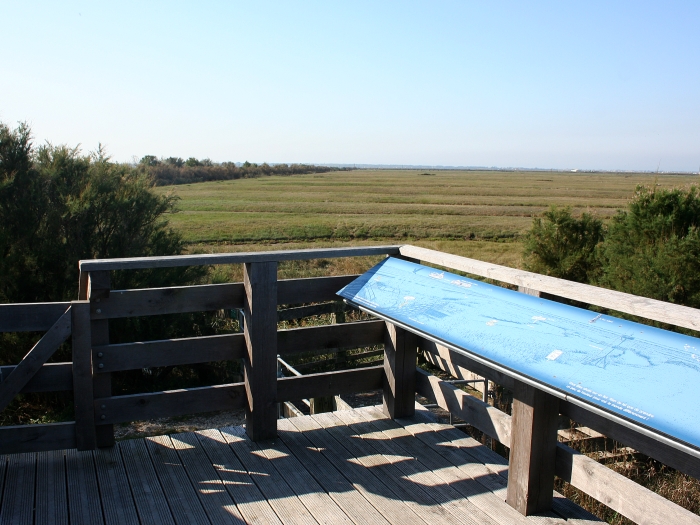

The area is clearly always worth a visit at any time of year, as it has a rich selection of breeding birds (Avocet, Black-winged Stilt, Bluethroat, etc.) and in winter there are hordes of Brent Geese, wildfowl and waders arriving from the north. At passage times, almost anything may turn up.
24 August 2011
Birdfairs
I have just returned from a long weekend in Rutland, wandering round the 23rd edition of the British Birdfair, meeting old friends, collecting ideas for future holidays, looking at the huge range of paintings, photographs and other bird-related works of art, riffling through the new books on offer, and generally marvelling at what a huge 'industry' birdwatching has become. Of course, as well as being an extremely enjoyable event, it is also a mechanism for raising funds for conservation projects worldwide, and over the years has raised over £2,000,000 so far. Each year there is a special conservation issue at which funds are targeted, and this year it was to help counter the threats posed to birds migrating between Europe/Asia and Africa, which of course covers both the UK and France.
Although the LPO did not have its own stand at the Fair this year, it did have some representation on the Regional Natural Parks of France stand, strategically placed at the entrance to Marquee 5. Tony Williams was there, well-known to many of you who have visited La Brenne, as he lives and works in that particular park. The organisation has started to produce a series of very useful brochures aimed specifically at birdwatchers, with the titles 'Where to Watch Birds (and other wildlife) in ....' for several of the parks. They were distributing copies at the Fair, but if you were not there, all is not lost, as they can be downloaded from their central website. On the introductory page, just click on the tab 'Where to Watch Birds in the Parks' in the bottom right-hand corner under 'liens'. The required brochure can then be downloaded as a PDF. Not all the parks have such a brochure, but no doubt more will follow. As well as some suggested routes, they also contain useful information on where to stay and other things to see.
Inspired by the success of the British Birdfair, the LPO has been for some time thinking of doing something similar and has now set a date and a place for what hopefully will be the first of many French Birdfairs. At the moment there are few details, but the place will be Paimboeuf, near Nantes, and the dates are 21–23 September 2012. More details will follow as they become available.
20 July 2011
You don't have to travel as far as Spain to see Iberian specialities
Glancing through the latest report on rare breeding birds in France, covering 2010 (in Ornithos 18-3), my attention was drawn to several species whose main European distribution lies in Spain but which also breed, albeit in small numbers, in France. The Green Woodpeckers mentioned in the item below are not the only ones to creep over the border! Between 300 and 490 pairs of Thekla Larks, for instance, can be found in the Pyrénées-Orientales and Aude, with numbers either stable or perhaps declining as the open habitats they prefer become overgrown. The numbers are up on previous years, but possibly this is because they are being looked for more assiduously. There does not seem to be much doubt, however, about the increase in the numbers of Calandra Larks, 134–164 being noted, the majority on La Crau (Bouches-du-Rhône), though the reasons for the increase are unclear. The same area hosts perhaps 100 pairs of Pin-tailed Sandgrouse, always hard to census during the breeding season, but a winter count of 222 indicates the scale of the total populaton in 2010.
The total of 46 pairs of Collared Pratincoles was similar to the numbers of the previous year, scattered across thirteen small colonies, the majority in the Camargue. Numbers of Purple Gallinules continue to increase (107–123 pairs) and to spread eastwards from their initial foothold in Languedoc-Roussillon, now having reached the main part of the Camargue. Lesser Kestrels, with and without the help of reintroductions, are also doing well, with 279 pairs, an increase of 7.7% on the previous year, producing 545 fledged young. The population of Bonelli's Eagles at last reached the landmark figure of 30 pairs in 2010 and, even better, produced 32 young, the highest number since 1994. All the above species are, of course, to be found in 'Mediterranean France', but we should not forget that at the other end of the Pyrenees, Black-shouldered Kites have also spread over the border, with 48–50 pairs now breeding as far north as the Gironde, although the majority are still in the Adour river valley. They continue to be productive, with an estimated 139 young in 2010, so hopefully will continue to expand their range yet further.
20 June 2011
Green Woodpeckers
Anyone birding in the Languedoc-Roussillon region of southern France who might start to get tired of looking at such exotica as Bee-eaters, Rollers and Flamingos (unlikely, I know), might like to turn their attention to a closer inspection of any Green Woodpeckers they happen to come across. For according to a study reported in Ornithos 18-2 (March/April 2011), they are more likely to see the Spanish race Picus viridus sharpei in the Pyrénées-Orientales département, just north of the international border, than they are to see the P.v. viridis race with which we are more familiar. In fact you have to go as far as the Gard département, just west of the Rhône valley, before you can be sure of a true viridis. In between are a series of intergrades, showing progressively fewer sharpei characters the further north you go along the Mediterranean coast. The two races are well described in the better fieldguides, indicating the various subtle distinctions between them, the most obvious being the shading on the 'face', black in the case of viridis and mostly grey in the case of sharpei. In addition, the male of sharpei has more red in its 'moustache' than does viridis. The article, written by Georges Olioso and Jean-Marc Pons, is well illustrated with photos taken at various points along the coastal strip. Georges has kindly supplied the two photos, below, of the two 'extremes', viridis (left) and sharpei (right), as far as the males are concerned.
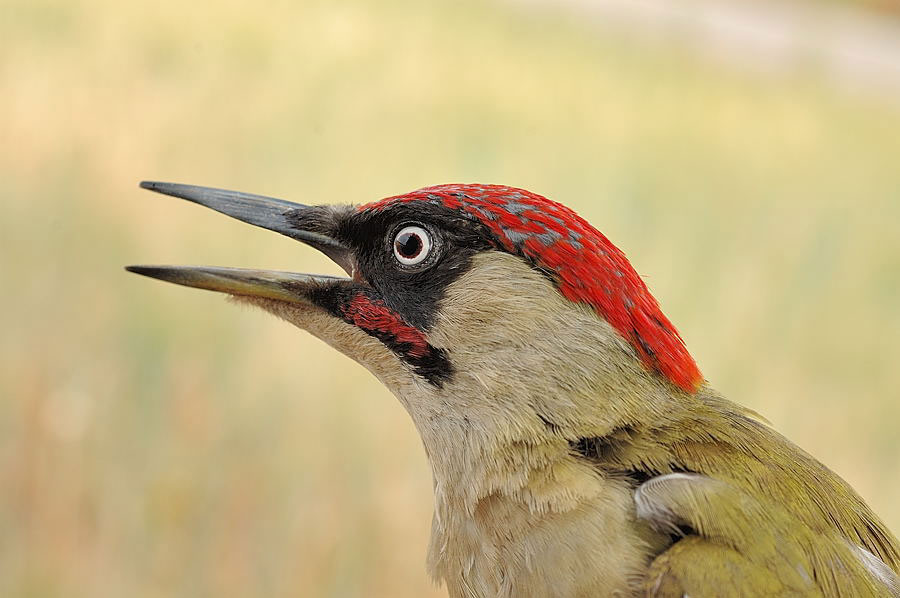
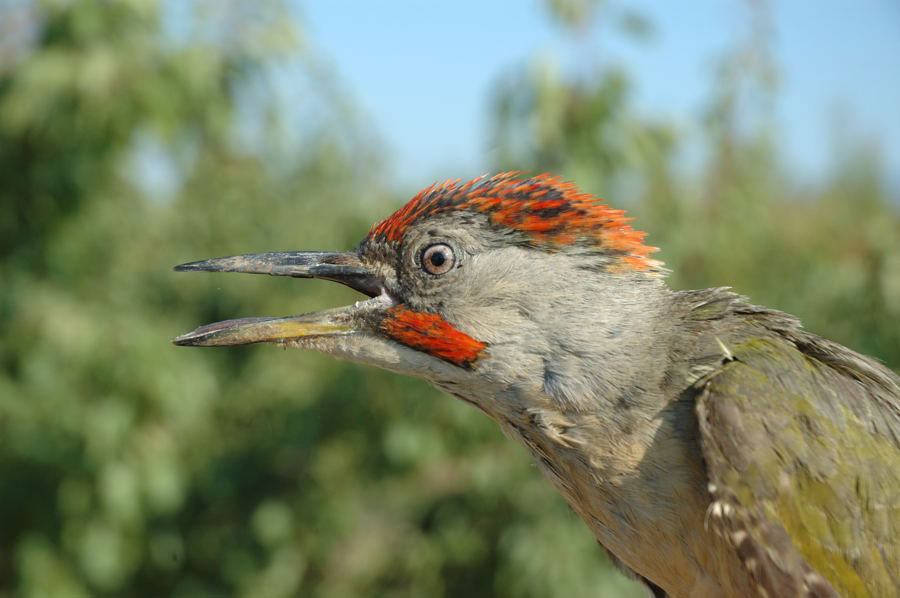
With the current vogue for splitting subspecies off as new species, one imagines that French listers might start to take more interest in the Green Woodpeckers of the region, if only for 'insurance purposes'.
And while talking of Languedoc-Roussillon, those who don't know the area might have their appetite for a visit whetted by an on-line article by Derek Moore, who spends quite a lot of his time in that area, exploring and taking photographs. So that's another holiday idea to add to those below.
18 June 2011
News on Red Kites
For those who can read French, the LPO's Mission Rapaces produces regular newsletters about their ongoing efforts to conserve Red Kites, both in France and elsewhere. These newsletters can be downloaded from the site http://rapaces.lpo.fr/milan-royal. But in addition, an English-language version is now available at http://rapaces.lpo.fr/en/milan-royal/news. This site is still under construction, but already it contains plenty of information for those who have not yet mastered the language of Molière. One depressing recent item concerns the fact that already this year 19 Red Kite corpses have been picked up in France, and once again the cause seems to be bromadiolone, a poison used by farmers to control rodents, the bodies of which are then consumed by the kites (and other raptors like Buzzards), with fatal effect. The LPO continues to have urgent discussions with the agricultural authorities to have stricter controls imposed on the use of such poisons, and ideally have them banned altogether from open-field use.
16 May 2011
Some holiday ideas from the LPO
Across France, the various LPO groups have been for several years organising visits into the countryside in their regions (and further afield) to look for birds, flowers and wildlife in general. Certainly for those resident in France, these are an excellent way of getting to know the local area and also to make contact with other people with similar interests. But there is no reason why holiday-makers should not join these excursions – if for nothing more, it should be a good way of improving your knowledge of the language.
To track down what is on offer, there is now a page (http://www.lpo.fr/loisirs-nature/loisirs-nature) on the LPO's internet site which allows you to search by region for details of the current programmes in any particular area in which you have an interest. Just click on the 'moteur de recherche Sorties nature' and enter the details of the area required. The theme of each excursion, date, contact details, etc. should be available.
In addition, the same page has a link to the Etap Hotels website, where you can make hotel bookings at a preferential rate (10% reduction), as the LPO has a partnership agreement with this chain of hotels.
12 May 2011
Corncrakes in France
In 2009, a national survey of Corncrakes in France was undertaken, and the results reported in the latest issue of Ornithos (18: 1). As implied by the results of the 2010 survey in Champagne-Ardennes (see below), the results are not very encouraging as far as the long-term survival of the species in France is concerned. Between 500 and 550 calling males were recorded, about the same as in the previous 2006 survey, but well below the numbers in, say, 1983/84 when 1600–2200 were counted. Between the two most recent surveys there has been a slight but significant shift in distribution, with declines in the more southerly sites, and an increase in the north-east. The majority of calling males were found in damp hay meadows and the like, in river valleys liable to flooding, and most were in sites classified as ZPS (special protection zones). By far the most important site was the Basses Vallées Angevines, near Angers, with 40% of the total (221–225 calling males), and even here a decline was noted. The only hope is that the late-cutting of hay, agreed with the farmers concerned, can be continued, and/or that more of the key sites can be taken into the ownership of conservation bodies.
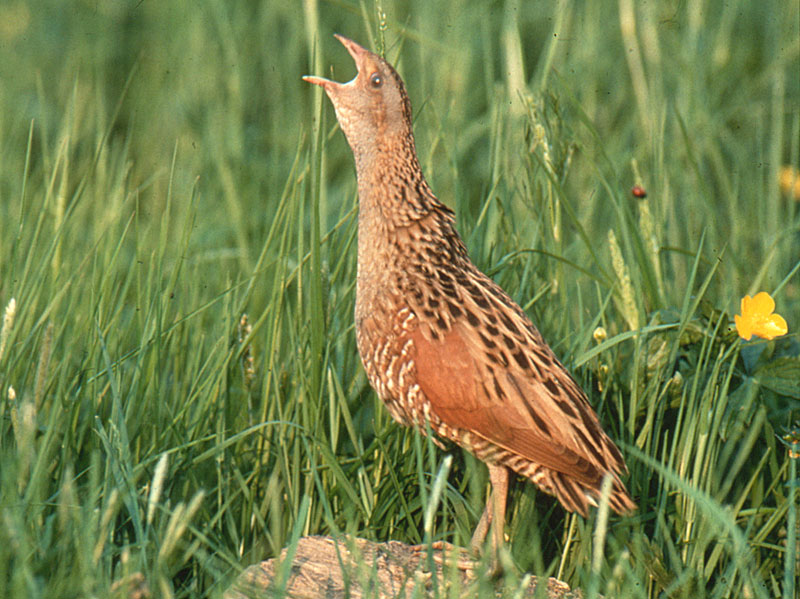
12 May 2011
Hot-spots: The Camargue
The same issue of Ornithos also contains another account in the journal's 'points-chauds' series, this time covering the Camargue. The area has been a long-time favourite with birders from all over Europe, who come to see breeding birds such as Bee-eaters, Black-winged Stilts, Flamingos and Collared Pratincoles, to which have recently been added Glossy Ibis, Great White Egret, Spoonbill and Purple Gallinule, among others. While in winter, in addition to the hordes of winter wildfowl, which include Red-crested Pochard and Black-necked Grebes in some numbers, there is also the attraction of Spotted and Bonelli's Eagles, Long-legged Buzzard and Common Crane, and the chance of passerine rarities such as Pine Bunting. Access details for thirteen different sites within the Camargue are described, and the most significant species for each one enumerated. My last visit was in February 2009, with a group from Bristol, one of whom, David Wilson, supplied the photo of Flamingos shown here.

12 May 2011
Annual report 1: LPO Vienne
The LPO-Vienne group's annual report for 2010 has recently appeared, with a long and impressive list of their activities, of which the following are just a few.
- The mid-January wetlands count produced relatively few wildfowl by comparison with such sites in the UK, but the presence of 29 Great White Egrets shows how numerous this species is becoming in France in the winter. There were also good numbers of Lapwings in the region, with 27,200 counted altogether, plus 1250 Golden Plover.
- Little Bustards are one of the key species in the Vienne département, and the breeding areas for many of them are classified as ZPS (special protection zones). The initial results for these areas in 2010 indicate a slight decline on 2009, when 108 calling males were noted, although the population does seem to have stabilised since 2000. In a area not far away but not within the ZPS, 51 calling males in 2010 as opposed to 59 in 2009 indicated the same result. Counts at the main post-breeding assemblies produced 108 birds in an initial count, and 116 later in the season, again in line with counts made over the past few years. These totals are, of course, only a fraction of the numbers that would have been found here fifty years ago.
- Post-breeding counts of Stone Curlews made at the same time produced 490 birds in the first wave, and 1204 in the second. Although the numbers recorded vary wildly from year to year, these still seem to be within the normal range of the past few seasons.
- The breeding population of Bee-eaters along the banks of the Rivers Gartempe and Creuse seems to be stable at 60 pairs. The maintenance of grazing cattle in the riverside fields, keeping the banks free of vegetation, and the presence of banks formed by sand quarries and drinking pools, seem to be the key features needed for this species to continue to breed successfully here.
- The Short-toed Eagles in Vienne are towards the north-western edge of their range, but nevertheless the departmental population was estimated at 5–10 pairs, with one young fledging from each of at least three nests.
- The majority of the harriers breeding in the ZPS cereal fields north-west of Poitiers chose barley in 2010 as their preferred crop, and as this was the first to be harvested, it put the young at even more risk than normal! However, thanks to the efforts of LPO volunteers in locating the nests, 47 Hen Harriers and 52 Montagu's Harriers successfully fledged from 29 and 30 nests respectively. It is interesting to note that a Dutch-reared Montagu's Harrier was found nesting here in 2010, indicating there is a certain amount of population interchange going on. Counts at post-breeding roosts in the area produced an impressive 400 harriers, of which 300 were Montagu's.
- In addition to monitoring these relatively rare species, volunteers from LPO-Vienne were very active studying a wide range of habitats, forest, wetland and farmland alike, and advising their owners whenever possible, as well as promoting the cause of nature conservation to the general public and within educational establishments. In January, for instance, they organised a 'Fête des Oiseaux' at their Lac de St-Cyr reserve, and attracted no fewer than 800 participants to what was a very successful event. For more news of this dynamic group, see their website http://vienne.lpo.fr.
12 May 2011
Annual report 2: LPO-Champagne-Ardenne
This equally active group has also produced its annual report for 2010, and despite a slight decline in its membership, something that has been a problem for many associations in both France and the UK in the past couple of years, has still carried out much excellent work.
- Small numbers of Corncrakes still breed in region, notably in the Aube and Marne valleys, but only 31–33 calling males were noted in 2010, a significant reduction on 2009. Corncrakes numbers are known to fluctuate considerably from year to year, depending on the extent to which floodwater has inundated their breeding sites, and it is hoped that agro-environmental schemes currently in progress may help stop what otherwise seems to be an inexorable decline in numbers.
- On the other hand, Common Cranes seem to go from strength to strength, with 8000 counted in March at the Ferme aux Grues, and 16,000 at the Ferme du Sorton. Both these sites are specially managed to attract the birds to feed during the day, to reduce the pressure on the surrounding commercial farmland. But, in any case, there is compensation available to farmers if the birds are proved to cause damage by too much trampling, etc. At the well-known roosting site of the Lac du Der, a new record was set on 14th November, when no fewer than 74,500 birds were counted!
- The Red Kites that breed in the Bassigny area of Haute-Marne are the subject of a special study, and an encouraging 28 young were raised with, for the first time, two young fledging from a single nest. Several feeding sites have been set up in the region to improve feeding opportunities during both the breeding and wintering seasons.
- As in the Vienne area, the harriers that breed in the arable fields of Champagne-Ardenne receive special attention from LPO volunteers. From the nests of 227 pairs of Montagu's Harriers located, 335 young fledged successfully, of which 245 would have been lost due to harvesting activities if it had not been for the LPO. Similarly, 143 young Hen Harriers were saved out of a total of 243 young raised by 178 pairs. One can only but applaud the efforts of the volunteers, year after year, in saving so many individuals of these impressive raptors.
- Following the rediscovery of a small population of Collared Flycatchers in the Bassigny area of Haute-Marne in 2002, a special study was conducted in 2010 to monitor the numbers present – a minimum of 43 singing males, as it turned out.
- As in the Vienne, a January count of wildfowl was carried out in 2010, with rather more impressive numbers of wildfowl being found. At the Lac du Der alone, for instance, 78,197 waterbirds of a wide variety of species were counted, reinforcing the importance of this site for more than just Common Cranes and White-tailed Eagles.
- For more information about the group, see their website (http://champagne-ardenne.lpo.fr), which has several pages in English.
16 March 2011
Finches and buntings à table
Like ourselves, the French are happy to put up and stock birdtables in their gardens, for the pleasure of seeing small birds at close range, and to help the birds survive when conditions in the wild are adverse. But a small minority continue to lure birds for the purpose of killing and eating them. 'Tradition' is their watchword, forgetting that not all traditions are worth maintaining - sending children up chimneys to sweep them, for instance. One area where bird-trapping continues is in Les Landes, down in south-west France. Small clearings are made in the arable fields, decoy birds are placed there in cages, twigs and traps (matoles) are placed nearby, all with the aim of luring passing migrants down to the ground to be caught.
There are two main periods when all this takes place. First in late August and into September, when Ortolan Buntings are passing through from their breeding grounds in Scandinavia and eastern Europe, to their wintering sites in Africa. Tim Loseby has kindly supplied a picture of an Ortolan in autumn plumage, rather more subdued than they look in the spring. Then in October and November, it's the turn of the Chaffinches, Greenfinches, Linnets, etc. that pass through to winter in southern France and Spain. All of this trapping is, of course, completely illegal, but it appears that the local authorities will turn a blind eye to what is going on, as long as the trapping is not too blatant. In other words, as long as nobody notices.
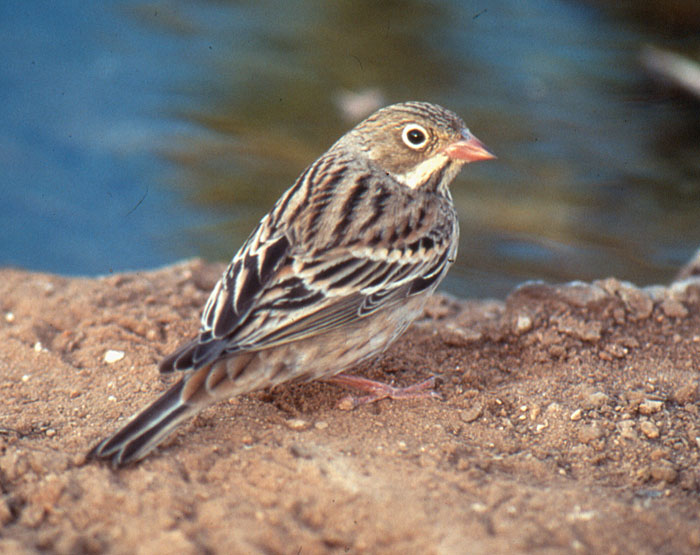
But to make sure that someone does notice, the LPO has been sending volunteers into the area, led by the LPO President, Allain Bougrain-Dubourg, to liberate at least some of the trapped birds, and to demand that the law is fully enforced. He was there at the end of August 2010, for the fifth year running, and again in November. The media were on hand on both occasions, and L'Oiseau Magazine (Issues 100, 101) has accounts with pictures of AB-D in action. It's reminiscent of the events that took place in the Médoc area to the north, to stop the (similarly illegal) shooting of migrant Turtle Doves in the spring. Let's hope that the LPO will be equally successful with this campaign.
To lend your support to this action, please do sign the petition on the LPO-Aquitaine website (link to petition in English). At least some of these migrants will be 'ours', after all.
16 March 2011
Another département joins the LPO 'family'
This time the area concerned is the Rhône, not the river exactly, but the département of which Lyon is the main city. As happens quite often, an existing conservation association, this time CORA-69, has decided to come under the LPO umbrella. The Groupe Ornithologique Lyonnais dates back to 1959, and in due course was transformed into the Centre Ornithologique Rhône-Alpes (CORA), which itself comprises several departmental sub-groups – see its website for more details.
One long-running campaign that CORA (and the LPO) has been involved in does at last seem to have ended in success. Again hunting is involved, this time the spring shooting of Woodpigeons at the Col d'Escrinet and other passes in the Ardèche region. Hunting regulations permit the winter shooting of pigeons, of course, but another 'tradition' in this area has been the targeting in spring of pigeons returning to their breeding grounds in Russia and eastern Europe. There have been many clashes over the years, some quite ugly, between conservationists and hunters on these passes, as legally hunting is not permitted into March. To alter this, the hunters had applied for a derogation of the EU birds directive, but following the results of coordinated counts by hunters, conservation groups and the ONCFS (Office National de la Chasse), clarifying the numbers involved, the request has been refused. With the situation now much clearer, it is to be hoped that the links forged between hunters and conservationists to get to this stage will also lead to the two 'sides' working more closely together in the future to the benefit of all concerned.
News items for 2010
20 December 2010
Nasal saddles on ducks
The same special issue of Ornithos (17-5) that I refer to below also contains an interesting paper by Matthieu Guillemain and Alain Caizergues on the use of, and results from, nasal saddles as a way of marking and tracking wildfowl. I was particularly interested in this as Pochard and Tufted Ducks carrying these markers have turned up on my local reservoirs, Chew Valley and Blagdon Lakes. The photo, kindly provided by Nigel Milbourne, shows such a Tufted Duck at Blagdon Lake.
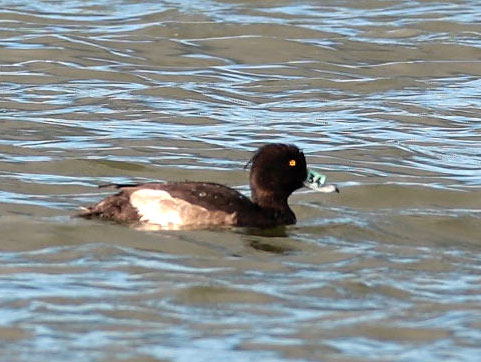
Like most birds, wildfowl have been marked with leg rings for many years, both aluminium and coloured, and a vast amount of information has been gathered from recoveries of these. But normally the majority of results only come from birds that are shot by wildfowlers, or caught by ringers, as it is very difficult to read the ring information unless the bird is in the hand. Various techniques are in use to overcome this problem, such as neck collars (OK for geese and swans, but not so practical on short-necked ducks) and satellite trackers (too expensive to use on more than a few individuals). The nasal saddle technique was developed in North America, and is now used in several other countries, including France, though not commonly in the UK, as far as I know. The Ornithos paper reports the first results from nasally-marked ducks in France.
Although at first sight it looks as if it might well cause the birds some distress, it appears that nasally-marked birds show no difference in weight change over time from unmarked birds and their level in the social hierarchy also remains unchanged after the nasal saddles are attached. Also their attractiveness to the opposite sex seems to remain unchanged, either way, with the nasal saddles in place, and breeding success also seems to be unaffected, at least in more mature individuals. Studies are ongoing as to the long-term effects of the nasal saddles on survival, but so far no significant adverse effect has been found, and some marked birds have certainly survived for 5 or 6 years at least.
So what of the results. As far as Teal are concerned, the resighting rate came in at 53%, as opposed to 23% for birds just carrying a ring, so instantly there is more than twice as much data available for analysis. In the Camargue it was found that nearly 19% of marked Teal returned the following winter, a much higher proportion than had previously been thought, and 75% of these came back to the exact same spot as where they were marked. However, another interesting point was that only 55% of individuals actually remained there from one month to the next, indicating a continuous turnover in the population throughout the winter. This goes someway to explaining how it is that 330,000 Teal per winter can be shot by French hunters, whereas the maximum winter count for France in January is only 100,000. The survivors keep moving on and new recruits keep arriving!
It is a bit too soon for drawing many conclusions from resightings of Tufted Ducks and Pochard, but the 'recovery' rate has certainly increased, and it is already clear, for instance, that post-breeding movements can take place to the north and east, not just to the south-west as might be imagined initially. Hence the appearance in south-west England of birds from the Lac de Grand Lieu, near Nantes.
6 December 2010
Red Kites
The proceedings of the International Red Kite Symposium held in Montbéliard, France, in October 2009 have recently been published, and are available on-line at http://rapaces.lpo.fr/node/64. They contain all the presentations as well as the poster sessions from the meeting, in both English and French, and make for fascinating reading, if rather disturbing in places.
Without attempting to summarise everything, here are a few key points that struck me. One was the importance of Germany, with 10,500–13,000 pairs, to the survival of the species, and the worrying fact that the population there is still slowly declining, following German reunification and the rapid changes in agricultural and forestry practices in the old East Germany that then occurred. The French population, 2340–3020 pairs, is the second largest, but this is also under threat, particularly by the open-air use of anticoagulant poisons to control field-vole numbers, the kites then ingesting the poison from the voles. In Spain, with 2000–2200 breeding pairs, the use of poison baits, often, but not always, targeting foxes and wolves, is another major problem, and of course this also affects the large numbers of wintering kites that arrive from beyond the Pyrenees.
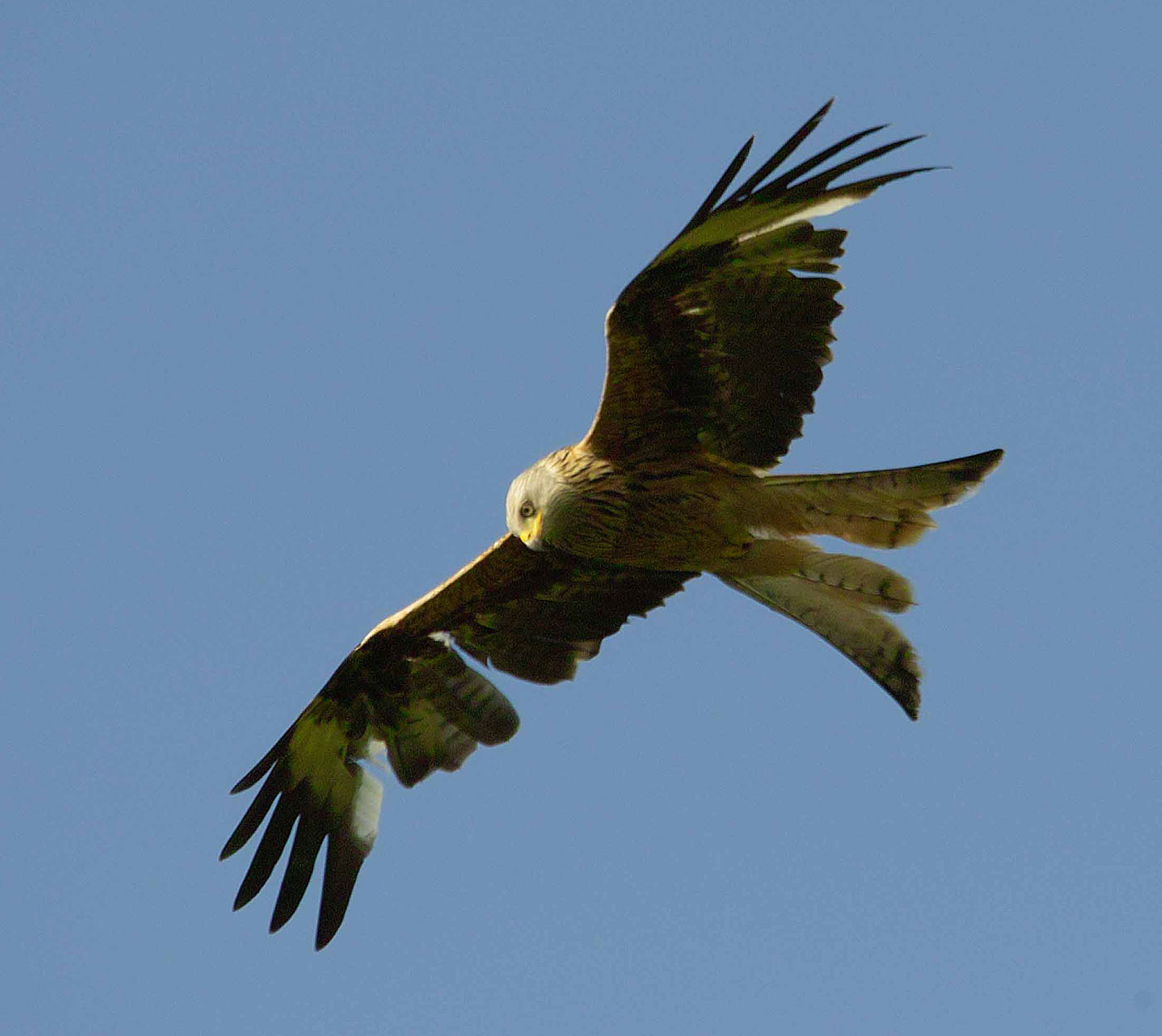
It's not all bad news, however, as the British population (already over 1600 pairs) continues to increase, and shows what can be done with a well-thought-out reintroduction scheme. Thanks to Derek Moore for a photo of one of them. Similar projects are underway in Italy and the Balearic Islands – let's hope they are equally successful. The fact that numbers have increased in Luxembourg, Switzerland and Sweden in recent decades also indicates that extinction is not inevitable, even in countries with modern farming and land-use regimes in place.
At the close of the symposium, the following motion was voted by the Assembly, which had representatives from most of the countries of Europe where Red Kites can still be found.
- The Assembly notes the contradictions between the European Birds Directive, the European Action Plan: 'Halting the Decline in Biodiversity for 2010 and Beyond', and the Directives authorising the use of pesticides, including anticoagulants and anticholinesterases that have a strong negative impact on birds and biodiversity.
- The Assembly asks that the open-air use of all anticoagulants (difenacoum, brodifacoum, bromadiolone, etc.) be banned to ensure the conservation of the Red Kite, an Annex 1 species, endemic to Europe.
- There is a problem in some European countries with the laying out of poisoned baits using agricultural pesticides (e.g. carbofuran) to deliberately kill birds of prey. Red Kites are particularly vulnerable. European Union member states should be required to take firm action against the perpetrators.
As the organisers note in their summary, while the future of this majestic bird of prey, a symbol of our old continent, is bleak and uncertain, the determination, commitment and passion that emerged during the discussions at the international symposium furthers our hope that the Red Kite will continue to soar over the European countryside for many more years to come.
11 November 2010
Melodious and Icterine Warblers
Almost in parallel with the BTO's breeding bird atlas for Britain, currently in its final seasons for data collection, a French atlas is also in preparation. Fieldwork for this runs from 2009 to 2012, but already some of the information gathered can be accessed on the site www.atlas-ornitho.fr. One species highlighted in the most recent issue of L'Oiseau Magazine is the Melodious Warbler which, although just an uncommon migrant in Britain, breeds widely in mainland France, being absent only from the mountains of the Pyrenees and Alps, and from the far end of Brittany. Since the 1970s its range has steadily increased towards the north and east, and it is now to be found in the regions of Nord-Pas-de-Calais, Alsace and Lorraine from which it was previously absent. In 2007, its population was estimated to be between 400,000 and 1,200,000 pairs, with annual census counts indicating a continued increase. My thanks to David Wilson for the photo, taken in La Brenne.

Conversely, the range of its 'sister species', the Icterine Warbler, seems to be steadily shrinking, again to the north and east. Formerly to be found from Picardy to the Franche-Comté, the species has progressively disappeared from the Jura, Champagne-Ardenne, Burgundy and Lorraine, with a fall of 41% in the numbers censused since 2001. The reasons for this shift are not entirely clear, but climatic warming, loss of habitat and possible competition with the Melodious Warbler are some of the hypotheses. The two species are very similar to each other plumage-wise, both being fairly plain greenish with yellowish underparts in the breeding season. They fall into the group that we might call LBJ's (little brown jobs), which the French call 'merderolles', a term best left untranslated but which implies the difficulty to be encountered in telling one from the other.
11 November 2010
Black Tern breeding success
The same issue of L'Oiseau Magazine also has a success story concerning Black Terns. Incidentally, with this 100th issue, the magazine celebrates 25 years of publication, and continues to be an impressive flagship for the work of the LPO (see here for details on how to subscribe).
Anyway, back to the Black Terns. These summer migrants are uncommon breeders in France, with just a few widely scattered colonies, the most significant being in the Brière marshes and at the Lac de Grand Lieu, both near the mouth of the Loire. A bit further south, in the coastal Poitevin and Charentais marshes, the LPO manages a couple of sites where the terns have also settled, in both places using artificial platforms floating in the flooded grassland. At Voutron, 6–15 pairs have nested each year since 1999, but at Fouras Black Terns have only attempted to breed twice since 1994, and on neither occasion were they successful. However, in 2010, 13 pairs arrived in late May, built their flimsy nests on the LPO's platforms, and by the end of the season between 23 and 28 juveniles were on the wing, the best result for 20 years in this particular area. We can only hope that the birds will return again next year with equal success.
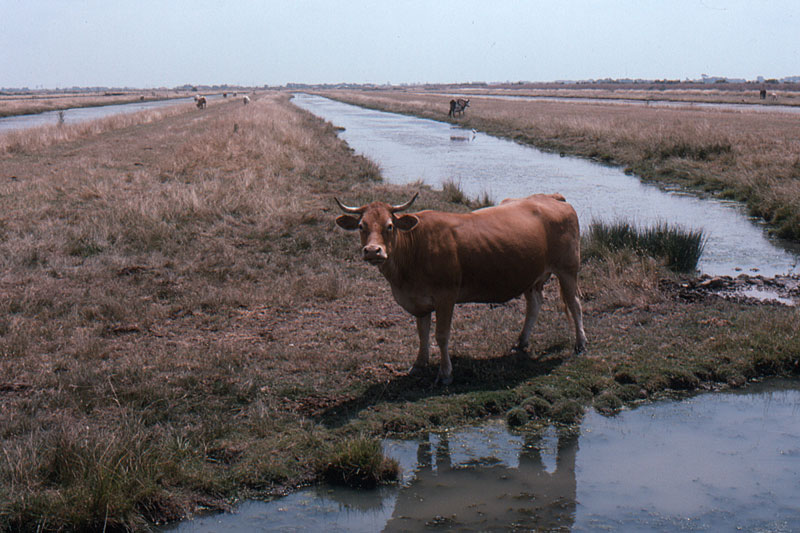
11 November 2010
Réserves de chasse
The other main publication of the LPO is of course Ornithos (again see here for details on how to subscribe), and the current issue (17-5) is a special one dedicated to a series of papers concerning ducks. The contents list can be found (at least at the moment) here.
One item that caught my eye was about wildlife refuge zones in France, particularly those for wildfowl, and their effectiveness. This might be a good opportunity to try to clarify, as best I can, what a réserve de chasse (RC) actually is, something that is often understandably confusing for English-speakers. The most literal translation would seem to suggest 'hunting reserve', i.e. somewhere specially set aside for hunting, whereas in reality it's the exact opposite! I prefer to translate it as an area 'free of hunting', which is what it actually should be. Relatively small-scale RC's can be set up by local hunting groups, and are usually marked as such by signs along their boundaries, with the object of providing a refuge, so that (presumably) numbers can build up and be shot elsewhere (presumably not too far away!). In many places it is a legal requirement that such zones exist.
The article in Ornithos deals with a survey of the larger-scale RC's that are of significance for wintering wildfowl and waders. These are the ones with a formal classification as Réserve de Chasse et de Faune Sauvage (RCFS), with both 'hunting' and 'wildlife' in the title. These have the principal aims of protecting migratory birds in conformity with international agreements, particularly those whose populations are under threat, managing the habitats to the best effect, and ensuring that hunting for control purposes can take place on a sustainable basis. The body with the prime responsibility for management is the Office National de la Chasse et de la Faune Sauvage (ONCFS), although other organisations can be involved as well. A special category are the Réserves Nationales de Chasse et de Faune Sauvage (RNCFS), which are either very large, used for scientific research, or hold species of particular interest. In addition there exist Réserves Naturelles Nationales (RNN), i.e. national nature reserves, as well as sites with local reserve status. The ONCFS survey took in 230 sites where wildfowl and waders were found in significant numbers, to see to what extent the birds were disturbed, and by what. Among the larger and more well-known sites covered were the Camargue (a RNN), the Mont-St-Michel bay (a RCFS) and the Lac du Der (a RNCFS). For some species, such as Knot, Black-tailed Godwit and Shoveler, it would appear that the majority of wintering birds are found on such reserves.
The findings showed that the reserves were doing a good job in preventing undue disturbance by hunters, but that at many sites, particularly coastal ones, walkers, watersports, fishing and, to a lesser extent, microlights and quad bikes, were quite intrusive. It was felt that the rules under which these various reserves were set up could be reviewed, as only disturbance by hunting was formally prohibited, with little in place to cover these more recent forms of activity, although the RNN's and RNCFS's had more comprehensive controls than most RCFS's. By preference, the creation of nature reserves would seem to be a more effective means of reducing disturbance, although, of course, some form of reserve status is better than none.
21 October 2010
Rare bird news
Those who wish to keep up-to-date with the latest news of rare birds seen in France have now been provided with an on-line resource, where observers can submit details almost as soon as they have found and identified something unusual. The site looks as if it is still under construction at the moment, but the basic information is already there, featuring a map of France dotted with spots where rarities have been seen, and a column giving, day-by-day, the species concerned and the name of the site where it has been seen. It is possible to click through to get more details, and even photographs, for several of the records. The sightings are of course not always officially verified, but the system should make that task a bit easier, and of course if the birds stay put, you can always go and check for yourself! I notice, for instance, that what is likely to be the first Chestnut-sided Warbler for France was seen on the Île de Sein, off the Brittany coast, on 10th October, along with a Red-eyed Vireo on nearby Ouessant the same day. The website is a partner to others that report sightings, not necessarily just of rarities, in several regions of France, as well as the one that records day-by-day migration counts from watchpoints across the whole country.
14 September 2010
4th Fête de la Grue
If you were thinking of going to the Lac du Der in the Champagne-Ardenne region to look at Cranes this autumn, you might like to consider going for the weekend of 23rd-24th October, as the local LPO group are organising a special 'crane fair' on those dates. Not only should the birds have arrived in good numbers, but there will be plenty of people on hand to tell you the best places to go and what there is to see. There are various exhibitions, talks, guided walks, etc. on offer, which will give you a good idea of the importance of the area, not just for the Cranes, but also for the other migratory and wintering birds for which the lake (and other nearby sites) are so well known. The LPO group have a website which gives more details of the event, the fourth of what has proved to be a successful series of gatherings.
14 September 2010
What do Ospreys eat?
Well, I guess everyone knows the answer – fish! But to put some flesh on the bones of that answer, the Muséum d'Orléans has undertaken a study of the diet of Ospreys breeding in the Orléans/Chambord area of central France. This region is where a thriving population of this wonderful bird of prey has recently become re-established (see next item for a few more details), breeding in the extensive forests south of the River Loire and feeding along the river and in nearby wetlands. Two research projects were undertaken, one based on analysing prey remains near the nest, and the other by means of digiscoped images of feeding adults. The first project is still to be published formally although preliminary results are in line with those of the latter study, summarised in the latest issue of Rapaces de France (No. 12)*. As expected, the birds' diet consisted entirely of fish, of sizes ranging from 15 to 35 cm in length, the highest numbers falling in the 25 to 35 cm band. Overall 22 species of fish were involved, the majority quite common, the carp family (cyprinidae) featuring most frequently, at 71%. To the extent that Ospreys have sometimes been seen as a 'problem' by fish-rearing and angling groups, the results were also analysed from a commercial/sporting point of view. This found that 79% of the fish were native wild species, 10% were non-native river fish, 5% were species raised for fish-farming/sporting purposes and 6% were 'ornamental' varieties. One can therefore conclude that the economic effect of the Osprey's diet, certainly in this area, is negligible. The preferred hunting area was the River Loire itself, and its tributaries, and only at times when the river was in flood, turbid, etc., would the Ospreys hunt over ornamental or fish-rearing pools to any significant extent.
*Rapaces de France is a available to subscribers to L'Oiseau Magazinee at an extra 4.50€. It is a supplement devoted entirely to birds of prey, and includes the detailed results of the previous year's monitoring programme of breeding raptors carried out by volunteers across the whole of France on an annual basis, as well as articles on individual species, both diurnal and nocturnal.
12 September 2010
Rare breeding birds in France, 2009
The annual report on rare breeding birds for France, covering the year 2009, has recently appeared in Ornithos (Vol. 17-3). The equivalent report for the UK, covering 2008 (British Birds Vol. 103-9), arrived simultaneously and prompted me to look for a few comparisons. It may be some time before Black Storks become more than a vagrant in Britain, but the French breeding population continues its steady growth, now at an estimated 40–60 pairs, with the Ardennes département, on the Luxembourg border, being the species' bastion, with 7 pairs located. A total of 64 young were fledged from the 20 nests that were monitored closely, a productivity rate of 3.2 young per nest. The White Stork population reached a new record, with 1618 pairs recorded. Although the numbers in Haut-Rhin (Alsace), at 285 pairs, are still just ahead of those of Charente-Maritime, with 272, productivity at the latter is far higher (538 young as opposed to 480), as has historically generally been the case. With significant numbers breeding along the Channel coast from Normandy to the Belgian border, it's a bit of a mystery why the species does not reach our shores more often. After several 'false dawns', the news that 6 pairs of Spoonbills have bred this year at Holkham in Norfolk has raised hopes that an enduring population may have at last established itself in the UK. It is therefore doubly encouraging to know that the French population is also expanding, with 342–416 pairs estimated in 2009. The Brière/Lac de Grand Lieu/Guérande area, around the mouth of the River Loire, remains the main centre, but a new colony (71 pairs) has also sprung up in the Camargue. As this area does not generally feature as being on the Spoonbill's principal migration routes, population growth seems to be mainly self-generated, although as ringed birds from The Netherlands and Italy have both been seen here, no doubt they were the original sources of these new colonists.
Less likely as a breeding bird in the UK, but an increasing possibility as a vagrant, is Black-shouldered Kite. The number of pairs in south-west France is now in the 37–43 band, producing a remarkable 89–103 young in 2009 alone. A new motorway has displaced a few pairs, and agricultural changes (loss of set-aside, removal of hedgerow trees) are another threat. But hopefully, with such high productivity, this attractive raptor will continue to thrive.
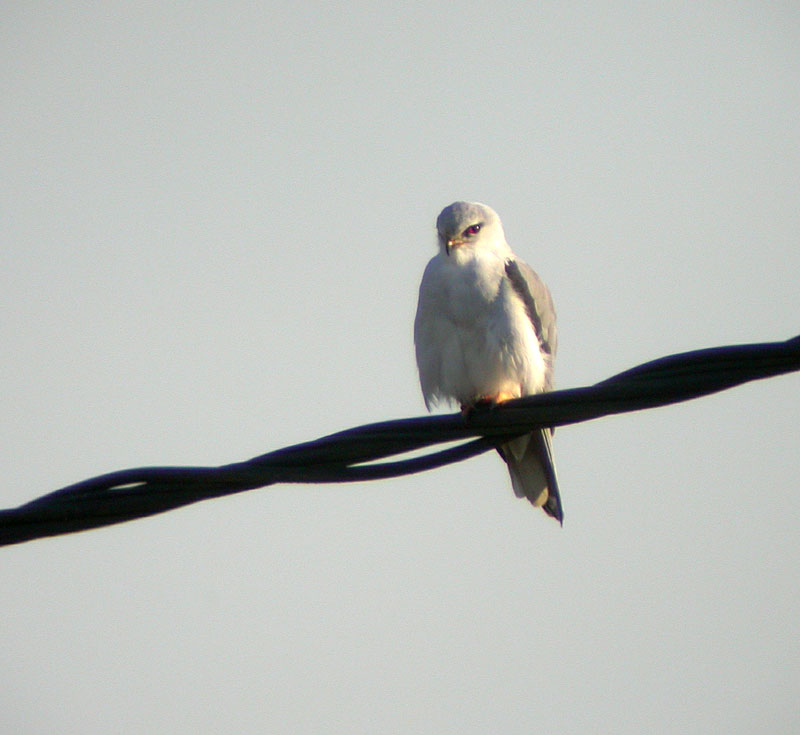
Among other birds of prey, 2009 saw the numbers of Ospreys breeding on the mainland of France overtake those on the island of Corsica (31 and 29 pairs respectively). Disturbance by photographers at mainland sites, and by coastal tourism on Corsica, are cited as reasons for low productivity/failure in some cases, but nevertheless the trend is steadily upwards. It is worth noting that reintroduction was not a method used for this species – they got here naturally, although the placement of artificial platforms has helped – but of course it has been applied very successfully in the case of Griffon and Black Vultures in central southern France, both of which continue to thrive.
With an estimated 6731 pairs, the Mediterranean Gull can hardly be considered 'rare' any more, matching the phenomenal increase in numbers also noted in the UK since the mid 1990s. On the other hand Roseate Terns remain on the brink, with 50–55 pairs at a single island site off the Brittany coast, as is the situation in the UK, where 71 of the 76 pairs breeding in 2008 were at just one site, Coquet Island in Northumberland. All three breeding auks (Razorbill, Guillemot, Puffin) maintained their numbers, but the warming climate may be against them in the long run, as they are all at the southern edge of their range in northern France. Glossy Ibis, Lesser Kestrel and Bonelli's Eagle (see below for relevant updates on all three) are among other species mentioned in this report, which covers 52 species for which both annual and intermittent censuses are carried out, involving nearly 800 observers.
24 June 2010
Lesser Kestrels – an update
The Lesser Kestrel remains classified as a globally threatened species, its population in western Europe having declined by nearly 90% between 1950 and 1990. In recent years there has been a welcome increase in southern Europe, numbers in France having reached a nadir of just three pairs in 1983. However, by 2009 the French population had reached 259 pairs, with two new colonies now established further west along the Mediterranean hinterland from the long-established one on La Crau, close to the Camargue. These falcons are cavity nesters, and on La Crau have favoured the piles of stones which dot this semi-desert plain. However, in such sites they are very vulnerable to ground predators like snakes, polecats and foxes, and so the LPO has been working to provide nestboxes at a higher level, under the tiles of some of the disused shepherd's huts and old military buildings which are another distinctive feature of the landscape here. The fledging success rate is much better in these sites, and as a result the population had reached 150 pairs by 2009.
The second colony was discovered in 2002, when a dozen pairs were found to be breeding in a village in the Hérault département. These birds nest under the roof tiles which are such a characteristic feature of the Mediterranean villages of this part of France. Conservation work here is centred on ensuring that the proprietors of the buildings concerned do everything possible to manage their roofs in such a way that neither they nor the birds are disadvantaged. So far, things seem to be going well, with 97 pairs raising 259 young to fledging in 2009, from here and from other colonies newly founded in nearby villages.The following photo of a male Lesser Kestrel was taken by Derek Moore at one of these colonies – many thanks to him for letting me use it.
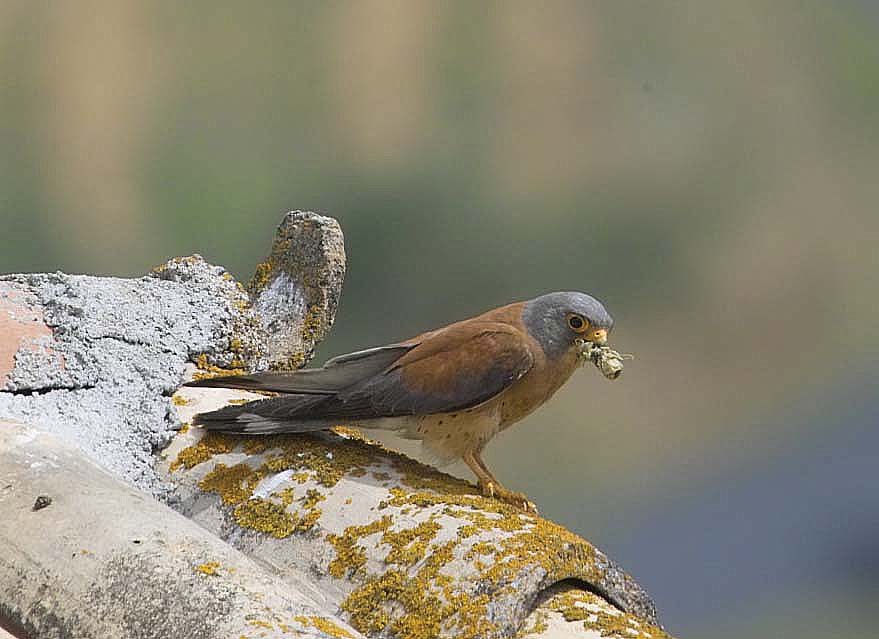
The third main colony, in the next département west again, the Aude, is the result of a reintroduction programme. Back in the 1960s, the Massif de la Clape was home to a colony of around 40 pairs of Lesser Kestrels, but they died out during the subsequent decline of the population that affected the west European population generally. Subsequent to the spontaneous appearance of a couple of pairs in 2003, nestboxes were placed in a restored winery building and on some electricity pylons nearby and, starting in 2006, young birds from Extremadura in Spain were released close by. Happily, half of these birds returned the next spring, and again the next year, and by 2009 a dozen pairs had started breeding, producing 15 fledged young. The results for 2010 are eagerly awaited, with hopefully the return of the first young actually born at the site. The work of the LPO in this project is ongoing, and has been greatly helped by funds donated during a special appeal in the recent past – many thanks to all who contributed to that.
24 June 2010
Refuges LPO
I am reminded, with various friends heading for France for extended periods in the summer, that many will either own property over there or will be staying courtesy of friends that do. This might be an opportune moment for them to think about joining the network of 'Refuges LPO'. What does this entail? A Refuge LPO is an area, publicly or privately owned, that has some ecological value, which the owner agrees to manage in an environmentally friendly manner, following a simple series of principles laid out in a four-point charter:
- To create conditions to encourage wildlife and native plants
- To avoid the use of chemical pesticides and herbicides
- To reduce one's impact on the environment
- To ban any hunting over the area concerned
As they stand at the moment, these Refuges comprise the most important network of ecologically maintained gardens in France, although they have now started to widen their remit to cover more than just gardens. The first Refuge was created in 1921 in the Forêt de Mormal (in the Nord département) but since then numbers have steadily increased, with on average 2300 new ones created each year. They range from several hectares in size to just simple windowboxes in a city, but are all useful additions to the 'trame verte et bleue' that is under construction to link ecologically valuable sites across France. Such 'ecological corridors' are vital ingredients in allowing sites to be recolonised where necessary and to increase biodiversity in urban areas and in the wider countryside.
Throughout France there are local groups which put owners of Refuges in touch with one another, to swap experiences and advice, while the central Service Refuges LPO is there to provide specialised help, including legal advice, as necessary. The network now participates in surveys of nesting and wintering birds, to track changes from year to year. The Garden Bird Surveys carried out in the UK are a close equivalent. Who knows, you might be lucky enough to report a Hoopoe!. Thanks again to Derek Moore for the photo.
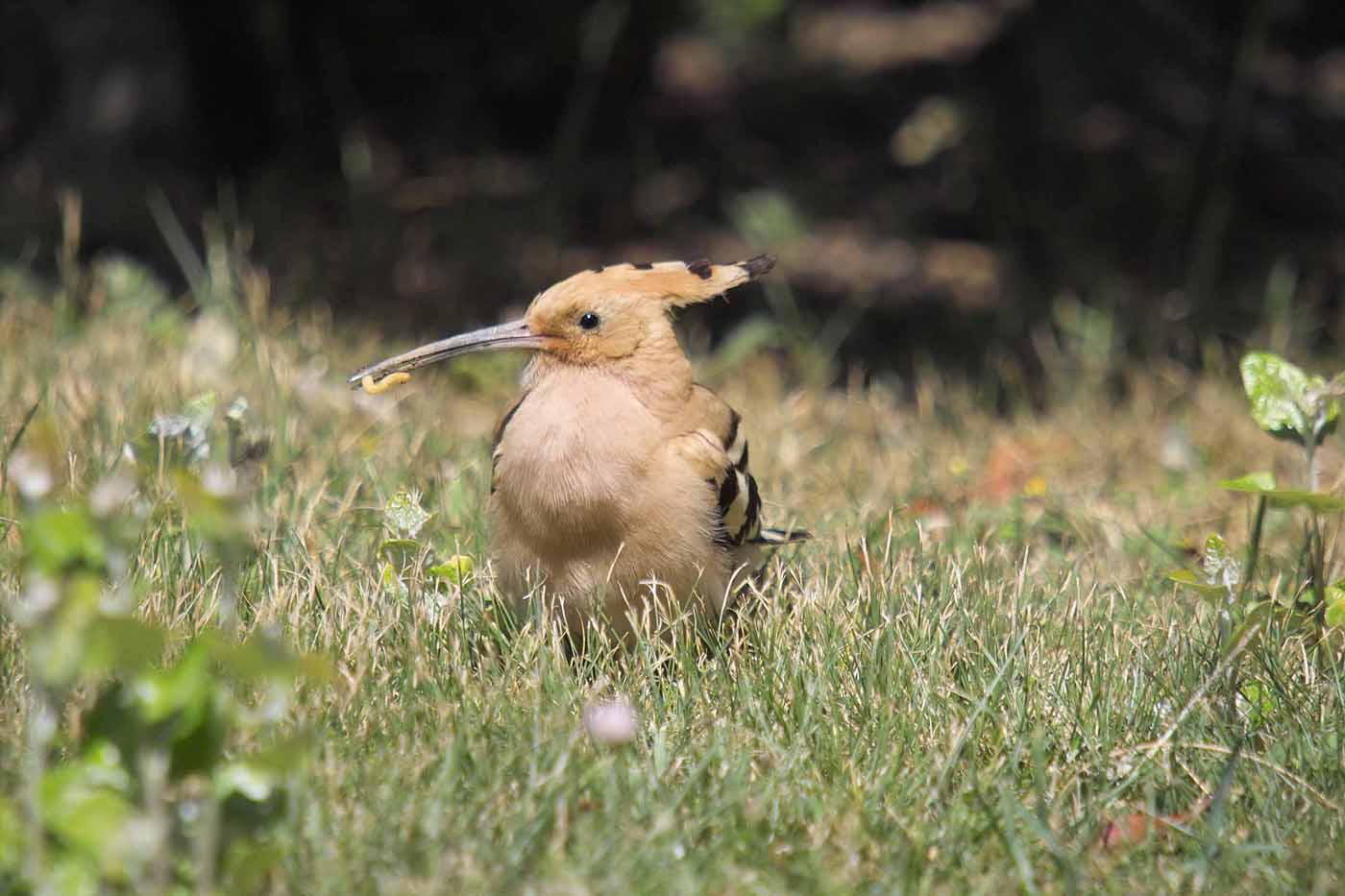
For the cost of 35 euros, participants who sign up will receive a panel which they can put up to indicate that they are part of the system, a nestbox to install in an appropriate spot, three mini-guides to get them started on eco-friendly management, and access codes for the website created especially for Refuge participants. For more details, and to sign up, see http://www.lpo.fr/refugeslpo.
24 June 2010
Festival de Ménigoute, 2010
The dates and programme for the 26th Festival de Ménigoute have just been announced – opening on 27th October and running through to 1st November 2010. The core of the event is the showing of the latest and best bird films, in competition, from around the world, but there are many other activities and exhibitions on offer, including guided excursions into the surrounding area, Ménigoute being situated in the département of Deux-Sèvres, between Niort and Poitiers. For more details, see the festival website at http://www.menigoute-festival.org.
26 May 2010
Ringing returns from rarities
There is a school of thought that considers ringing rare birds a bit of a waste of time, as the chance of a recovery is so low. But, nothing ventured, nothing gained, borne out by a couple of instances that appear in the latest issue of Ornithos (17-1). The first concerns a Yellow-browed Warbler ringed on 6th October 2009 at Overdinkel in the Netherlands, and seen just three days later on Ouessant island, off the western tip of Brittany, on 9th October. Once the fact that it was carrying a ring was noted, efforts were made to trap it, this being successfully achieved on the 12th. As the two sites are 953 km apart in a straight line, the warbler must have covered at least 318 km per day, assuming that it took the most direct route, a quite impressive rate of progress. When one considers that the nearest breeding sites are 4000 km away in the Ural mountains, the bird's feat of migration is really quite remarkable. Of course the bird was actually going the 'wrong way', in that the bulk of the population normally flies east-south-east to wintering grounds in China and south-east Asia. Why a small part of the population regularly heads south-west and whether many of them actually survive is still something of a mystery. The direct trajectory of this bird from the Netherlands to Ouessant is a little west of south-west. If continued it would take it out into the Atlantic, where it would presumably perish. But maybe it turned south to head for Spain and Africa. Who knows, unless it is spotted again?
One reason to look on this possibility with at least some optimism comes from the other ringing recoveries, also from Brittany, in 2007. The species concerned this time is Aquatic Warbler, which mostly breeds in eastern Europe (e.g. Poland) and winters in West Africa (e.g. Senegal). Although a rare migrant, it is regular in small numbers in France, with the majority of records coming from reedbeds in Brittany and at the Loire and Seine estuaries, most birds being picked out of ringers' mist-nets. The coastal reedbeds of Trunvel in Brittany provide records on an annual basis, and in autumn 2007, two birds were trapped that had been ringed either there or nearby the previous year, showing that they had survived a complete annual cycle of migration. In addition, one bird ringed there in 2007 was retrapped on its breeding grounds in Poland in 2009, while another ringed in September 2007 was retrapped ten days later at Txingudi, on the French/Spanish border in the south-east corner of the Bay of Biscay. So these records combined show that Aquatic Warblers can successfully manage to fly south-west from Poland all the way to the far end of Brittany, turn sharp left there and head south to the Basque country and then on to West Africa and back again. This ability to change direction during migration has been shown to have a genetic component in several species, but perhaps they might also be triggered by the coastline to make the 'decision' at the appropriate moment. If Aquatic Warblers can do this on a regular basis, perhaps the Yellow-broweds can do it as well. Sentimentally, one would like to think so.
30 March 2010
Crane migration
The latest summary concerning the migration and wintering of Cranes in France has recently appeared, covering the season 2008-2009. The report can be viewed on the LPO Champagne-Ardenne website, the relevant page being found here. In summary, 206,000 Cranes were seen crossing France in the autumn of 2008, a higher figure than for the previous autumn. One has to remember, of course, that migration often takes place at night as well as during the day, so these counts must be a minimum estimate of the population concerned. Although many of the birds are heading for winter quarters in Spain, an increasing number these days are remaining north of the Pyrenees for the winter, the highest numbers being found in the Champagne region (Lac du Der, etc.) and in the Landes area of south-west France (Captieux, Arjuzanx, etc.). The estimated wintering population in 2008-2009 was around 81,600 individuals, the highest yet recorded. Counts of birds moving back north in the following spring, totalled 208,000, with about 191,000 of them passing in just the last 20 days of February. Totalling the various counts comes up with an estimated total population for the west European migrant population of 243,000 birds, the highest yet recorded, with numbers seemingly having doubled over the past 10 years. The protection of the various staging and wintering sites certainly seems to be reaping dividends.
30 March 2010
Other birds of the Champagne-Ardenne region
The Champagne-Ardenne group is a particularly active one, and their website (http://champagne-ardenne.lpo.fr) is well worth exploring, especially if you are thinking of visiting the area. Notes of recent sighting are posted there, and visitors may well be interested in joining one of their guided field trips, particularly the ones at the Lac du Der. The region is probably best known for its wintering birds, but should not be ignored in the summer, as the woodland hold a good range of breeding birds, including Black and Middle Spotted Woodpeckers. A survey in 2009 located 35–55 pairs of Great Grey Shrikes, although how long this declining species will remain here is open to doubt. Montagu's and Hen Harriers had a poor season, mainly due to the low numbers of rodents, their favoured prey, in 2009. Thanks to the work of an army of volunteers locating the nests, and saving the chicks and eggs from destruction during normal farming activities, 192 Montagu's and 140 Hen Harriers fledged from the various nests located. The huge lakes of the Forêt d'Orient and the Lac du Der, as well as providing safe roosting sites for the Cranes, also act as autumn staging posts for Black Storks on their way south. Although numbers were slightly down in 2009, there were still 27 at the former and 26 at the latter, mid- to late-September being the peak period. Quite a few were carrying rings, indicating a variety of origins: the Czech Republic, Belgium, Luxembourg, Germany, and Poland, as well as France.
30 March 2010
La Brenne
La Brenne is another popular area with birders visiting France from Britain, and some might be interested in participating in one of the courses organised there on various aspects of natural history. Further details can be found on the website www.cpiebrenne.org. For more details on the area generally, the regional natural park English-language website is well worth a look.
10 February 2010
Pelican vagrancy
I see from the November-December 2009 issue of Ornithos that White Pelican has been upgraded from Category B to Category A of the French national list (i.e. some of the sightings made since 1950 are now judged to refer to wild birds). This decision is based on a statistical analysis of vagrant pelicans across Europe published in a paper in Ibis (150 (3): 606-618) by Jiguet et al. The statistics are quite heavy going, at least for me, but in essence a distinct connection was found between the breeding populations of both White and Dalmatian Pelicans in eastern Europe and the number of sightings of birds from outside their normal dispersal or migratory ranges. In years when the numbers of birds at the breeding sites were low, due to poor habitat conditions (e.g. drought) then a significant proportion of returning adults abandoned that year's breeding attempt and so were thought more likely to disperse more widely. For long-lived species like pelicans, missing the occasional breeding season is not so important as it would be for, say, small passerines. In such years, both the timing (i.e. the spring) of higher numbers of out-of-range sightings, and the fact that many of the individuals were adults, is suggested as good evidence that at least some of them were wild birds, rather than escapes. In 1990, for instance, a record number of twelve White Pelicans was seen in France, a year in which the breeding population at Lake Prespa in Greece (a closely monitored site) was at an historical low. The conclusion drawn is that at least some, if not all, of these birds were likely to be wild, hence the species transfer to Category A. Incidentally, there also seemed to be a secondary link with the amount of rain in the previous winter in the Sahel, aiding survival of wintering birds and hence a higher population in the following spring, and thus a larger pool of potential vagrants.
The same Ibis paper suggests that at least some of the Pink-backed Pelicans seen in Europe may also be wild, with more birds moving north from their African breeding grounds in years when rainfall in the short Sahel summer is particularly high. Such a year was 2001, when ten Pink-backed Pelicans were seen in Italy, and singles in Corsica and southern Spain. But for this species, the situation is even more clouded by the possibility of escapes than it is for pelicans generally, as there is a free-flying colony of around 30 pairs at the Sigean zoo on the French Mediterranean coast, and they are known to wander at least locally. The authors acknowledge that determining the exact origin of any particular individual pelican is always going to be difficult, unless the bird concerned is actually carrying a readable ring or is otherwise marked, but the probabilty of a wild origin needs more serious consideration than perhaps it has received in the past.
10 February 2010
Bonelli's Eagles
It is good to report that the population of Bonelli's Eagles breeding in Mediterranean France is still just about holding its own. In 2009 the number of pairs crept up to 29, including a new pair found in the Bouches-du-Rhône département, where the core of the population already occurs. Numbers have hovered around the upper 20's mark for several years, and breaking the 30 mark would be a good psychological boost – maybe 2010 will be the year? The success rate in 2009 was also encouraging, with 28 young fledging. Nevertheless the level of loss of adults from one year to another is very worrying, with eight sites being occupied by young adults replacing the previous year's older birds which never returned. A major cause of this is of course electrocution, and although the electricity companies are willing to neutralise the worst affected pylons, this work is only taking place at a very slow rate. On a brighter note, there are tentative signs of a range expansion into the Grand Causses area, well-known for its reintroduced Griffon and Black Vultures. So if you are in that area in the summer, it is worth looking at every bird of prey just that little bit more closely.
10 February 2010
Underwear lends its support to the LPO
The LPO, like the RSPB and other charities, seeks to work with appropriate commercial companies whenever possible to tap into extra sources of funding. The most recent concerns the lingerie company 'made in éthic', which has a range of underwear made from ethically sourced and recycled fibre. For every tanga from this range sold, one euro will go to the LPO's 'Birds in Distress' appeal. Until I looked at the company's website (http://made-in-ethic.com/slip-tanga-birds-ocean-p-1459.html) I thought that a tanga might be the name of some neo-tropical bird family (I've led a sheltered life), but see now that they are ladies briefs, this series featuring a couple of birds on the back. The range goes under the label 'mésanges', and so I look forward to other items in the range with some interest. However, if the RSPB goes along the same track, it might be well advised to choose a different bird family for the British market.
22 January 2010
Migrants and breeding birds of the Aude département
The latest newsletter from the LPO-Aude group has a brief summary of the migration watches carried out in autumn 2009 at the Roc de Conilhac, near Gruissan, a well-known viewpoint for seeing passing migrants both in spring and in autumn. In all, over 220,000 birds were counted in the 64 days the site was manned. Some of the more significant tallies included 4968 White Storks (they are hoping to break the 5000 barrier next season!), 4538 Sparrowhawks and an amazing 245 Rollers. As ever, there was a scattering of rarities, such as Spotted and Lesser Spotted Eagles, a Lanner (the first for the site) and even a Little Bustard heading south.
On the breeding bird front, the département is home to a part of the remnant population of the Lesser Grey Shrike in France, and after a blank year in 2008 it was feared that the species had disappeared for good. But in 2009 the shrikes returned, with three pairs located on the west side of the lower River Aude valley, and another four pairs on the Hérault side of the river. In addition, another eleven pairs were located elsewhere in the latter département. The success rate was excellent – perhaps the warm weather had something to do with this, with plenty of large insects available – 57 young fledged from 16 successful nests. It is to be hoped that at least some of these young birds will survive their migration to winter quarters in Africa and return to their natal region in 2010. Although the breeding birds are under close surveillance, disturbance, probably inadvertent, by workers in the surrounding vineyards led to the failure of a couple of nesting attempts. As the LPO writes, in school report style, 'Homo sapiens – could do better!'.
Encouraging news also from the Corbières, where mechanical clearance of scrub from an area of garrigue near Embres-et-Castelmaure has led to colonisation by seven pairs of Thekla Larks, an extremely localised breeding bird in France, essentially present only in Languedoc-Roussillon. This was the first time the species had bred at this particular spot, and the same goes for the pair of Ortolans that also appeared in 2009. This is one of several parts of the Corbières where such habitat management is being carried out, aimed at restoring areas of the more open habitat that several of the more specialised birds need, not to mention conserving the rich flora of these limestone hills. In some places mechanical cutting is employed, in others controlled burning, and wherever possible the newly cleared areas are grazed by sheep to maintain the open aspect without too much further human intervention. Post-management surveys at these sites indicate that key species like Black-eared Wheatears, Tawny Pipits and Dartford Warblers are already benefiting from this management action.
News items for 2009
4 December 2009
L'Île d'Ouessant
If you are a rarity hunter who wishes to get a bit more of the feel of finding their own birds than is often possible these days in pager-saturated Britain, why not head for the island of Ouessant, off the Brittany coast? The autumn migration season is just about over now, but an article by Mark Lewis published online by Birdguides that I have just noticed might whet your appetite for next year. And of course, spring migration can be just as exciting, as regulars on the Isles of Scilly already know. According to Mark, even if you are not actually the first to see the bird concerned, the lack of any advance information makes it seem as if you really were the finder. In an information-soaked world a whole new philosophical outlook on birding immediately raises its head, though one not too welcome to the makers of pagers I would imagine (not that they seem to have much to worry about as far as I can tell). Ouessant, of course, is just one of many islands and migration hotspots along the west coast of France, several of which in recent days have seen a huge influx of Leach's Petrels as a result the storms towards the end of November, with apparently 2000+ along the southern shores of the Bay of Biscay. As has the been the case in Britain, quite a few of these birds have not survived the ordeal, but normally populations bounce back again from such natural setbacks.
3 December 2009
Ecological disaster on La Crau
The Réserve naturelle des Coussouls de Crau was created in 2001 to protect the remaining parts of this stony plain in Provence from further encroachment from inappropriate agricultural and industrial development. It is a site well-known to birders visiting the nearby Camargue, as it is the only place in France where one can find breeding Pin-tailed Sandgrouse, the majority of France's Calandra Larks and Lesser Kestrels, plus a wide range of other birds such as Roller, Southern Grey Shrike and Little Bustard. In addition it is an extremely important site for a range of specialised plants, insects and reptiles. The major industrial zone of Fos-sur-Mer lies just to the south, and underground pipelines carrying gas and oil to refineries further north in Europe cross the reserve in several places. On 7th August 2009 one of these burst, sending a fountain of crude oil four metres into the air in the middle of the reserve, and before it could be stopped five hectares of habitat had been irreversibly damaged, not to mention the effects of air-borne pollution, a contaminated food chain and the damage caused by the vehicles coming to effect the necessary repairs. The oil on the surface was quickly removed, but the first 40 centimetres of soil is completely saturated, and below that an uncertain further depth will also be affected; there is also the question as to whether the underlying water-table has been affected. The contaminated soil is being removed, but how and if it can be replaced is uncertain. The local authorities and the LPO have started legal proceedings to ascertain those responsible for this 'ecological crime'. The pipeline is managed by the Société du Pipeline Sud-Européen, part of Total and Exxon Mobil Corporation. Where have we heard those names before? It seems that wherever there is oil there is trouble. More information can be found on the site http://www.reserve-crau.org.
3 December 2009
The biggest Refuge LPO yet?
While the majority of 'Refuges LPO' tend to be private gardens managed for the benefit of birds and wildlife generally, there is no reason why they should be restricted to just these. On 25th May this year, an agreement was signed between Allain Bougrain Dubourg, the President of the LPO, and Daniel Level, the Maire of Fourqueux, making the whole 'commune' (perhaps best translated as 'parish') a 'Refuge LPO'. Fourqueux extends over 367 ha, and is home to about 4,500 inhabitants, and birds to be seen here include Honey Buzzard and Hawfinch. Quite a significant section of the commune includes a golf-course and part of the Forêt de Marly le Roi, but the main areas to be targeted for ecologically sympathetic maintenance will be private houses and gardens, the public open spaces, and some areas of woodland at present not under formal management. The local authorities will be working with the LPO to undertake a range of activities including placement of nestboxes, reducing the use of pesticides, and promoting recycling wherever possible. This is first time a whole commune has joined the network of Refuges, and hopefully will not be the last.
3 December 2009
Bienvenue chez les Ch'tigognes
It is amazing how close White Storks are nesting to Britain while remaining relatively rare, even as migrants, on our side of the Channel. A first for the local area this year was the arrival of a pair in the village of Saint-Venant, south-east of St. Omer, and not all that far from the Channel ports. They arrived at the end of April, and built their nest in the crown of a decapitated poplar. The female was ringed, and proved to come from a site further south-west in Normandy. The surrounding area is well-supplied with the damp meadows and wetlands that this species needs to find its food, being evidently sufficient, as two young were first seen on 13th June. Despite some mixed weather the family eventually successfully left the area on 5th August. The title reference (courtesy LPO Audomarois) is to the comedy hit film 'Bienvenue chez les Ch'tis', the local name for the inhabitants of this region of France, playing on the stereotypes of 'northerners' as seen by 'southerners', in this case French, but the parallels with Britain are not that hard to draw! I think it appeared in the UK as 'Welcome to the Sticks'.
7 November 2009
La Vienne in 2009
The latest newsletter from the LPO-Vienne group contains a summary of the various surveys that their members have been undertaking this year. Some of the results are encouraging, some less so, but all are of interest. Some of the more significant results can be listed as follows.
- Little Bustard. This year 56 calling males were found in the special protection area to the north-west of Poitiers, as opposed to 55 in 2007 and 52 in 2006 (the results for 2008 were felt to be unreliable). Over a wider area, 108 calling males were located, as opposed to 112 in 2007 and 102 in 2006. Both figures indicate a certain stability, which is perhaps some indication that conservation efforts are bearing fruit, although the raw figures hide the fact that there were quite large differences from spot to spot, with some places showing a decline and others an increase.
- Stone Curlew. Associated with the same open-country habitat as the bustards, and similarly adversely affected by agricultural activities, this summer visitor forms large pre-migratory assemblies in the autumn, giving an opportunity to assess its population trends from year to year. Each year two autumn counts are made, and this year the first count came up with 706 birds and the second with 1271. The comparison figures for 2008 were 544 and 995, those for 2007 being 401 and 1511, and those for 2006 being 432 and 690. So, once again, a certain stability is indicated, which is encouraging.
- Harriers. There was less good news concerning both Montagu's and Hen Harrier, with significant declines noted for both those breeding in the arable fields and for those using heathland habitats. In both cases the common factor seemed to be the lack of suitable prey, with the mice and voles which form their main food source being in short supply. As is well known, rodent populations fluctuate on a cyclical basis, so hopefully this factor is only temporary. The counts made at the autumn roosts also showed a decline and a rapid departure.
- Nightjar. The Moulière forest north-east of Poitiers is a stonghold of this nocturnal summer visitor, and 2009 was the mid-way point of a triannual series of counts of birds calling at dusk. A preliminary estimate indicates a healthy population of 170–180 territories.
- Dartford Warbler. Nesting in similar heathland areas to the previous species, this resident warbler saw its numbers fall from 554–724 pairs in 2008 to only 103–165 pairs in 2009. This sudden decline is almost certainly due to the effects of the extended period of severe cold weather the area suffered in January. A similar decline, for the same reasons, seems to have affected this species in parts of the UK, but hopefully numbers will bounce back again in both countries.
- Middle Spotted Woodpecker. Also breeding in the Moulière, although in the more afforested sections, this species is also the subject of a three-year survey. Woodpeckers are notoriously difficult to pin down, of course, but four nests of Middle Spotted and ten of Great Spotted were located in 2009. The surveyors noted that although the young of the latter were quite noisy, making occupied nests a bit easier to track down, young Middle Spotted were almost silent in the nest, adding to the difficulties in assessing the numbers of this elusive species.
- Bee-eater. After a drop in numbers in 2008, when only 48 pairs were found as opposed to 67 in the previous year, it is nice to report that 61 pairs were found in 2009, back to the better levels of the previous few years. Most of these breed along the banks of the Rivers Gartempe and Creuse, with others digging their nest holes in sandpits and similar artificial sites.
29 September 2009
Glossy Ibises
With the news that there are currently good numbers of Glossy Ibises wandering around Britain, over 20 at a time in places, it is worth taking a quick look at the status of the bird in France. In the first half of the 20th century, its occurrences were mostly restricted to small numbers seen along the Mediterranean littoral. However, from the 1970s onwards, observations started to become more widespread and regular, although it was not until the late 1980s that sightings became an annual event. Over the year, there are records from every month, the main peaks occurring from early April to late June, and from late August to the end of October. The autumn peak produces the largest number of sightings away from the Mediterranean area, many along the Atlantic strip and in Brittany. The fact that the first birds seen in Britain this autumn were in Ireland and west Wales is therefore not a great surprise. As a breeding bird it has always been rare, with just four attempts noted between 1961 and 1998, and none for any of the next few years following that. However, in 2006 they took up residence at the Étang de Scamandre in the western Camargue, with 14 pairs producing 45 young. In 2007 there were 45 pairs and in 2008 there were 96 pairs, with 117 young being reared in each of those years. Several of the birds seen at the nest in France are carrying Spanish rings, as have been some of the birds seen in Britain this year. Some of the young ringed at Scamandre have reappeared at the colonies in subsequent years, but others have been noted from both Italy and Spain. Habitat destruction and persecution seem to have been the main reasons for the decline of the Glossy Ibis in the past, and its recent increase must be linked to the improved protection that both the birds themselves and their breeding sites are now receiving, but climate change may also be playing a part. It is to be hoped that the Glossy Ibis is now firmly re-established as a breeding bird in France and – who knows? – might even follow Little and Cattle Egrets to our shores in due course.
25 August 2009
Rapaces de France / Red Kites
The latest issue (No. 11) of Rapaces de France, the annual supplement to L'Oiseau Magazine, has recently appeared, with a variety of articles about birds of prey in France and elsewhere. One particularly disturbing item concerns the results of the 2008 survey of the Red Kite breeding population. This survey was structured so as to repeat as closely as possible the 2000–2002 survey, when the population was estimated at 3400 pairs. In 2008, the equivalent figure had fallen by 21% to just 2656 pairs, the largest falls being recorded in the Massif Central and North-east France. Bearing in mind that the French Red Kite population is second only to that of Germany, and that the species is essentially confined to Europe, this decline is extremely worrying. Habitat changes, poisoning and collision with electricity cables are among the known reasons for the decline, and the LPO is appealing to the French Government to place restrictions on the use of some of the most lethal rodenticides, which have been implicated in many deaths.
There is better news concerning Ospreys, Egyptian Vultures, Lammergeiers and even Bonelli's Eagles in the same issue and an interesting item covers the numbers of species of eagle that you might be able to see in the Camargue in winter – nine, no less! Spanish Imperial might be a bit tricky, with only two sightings in nearly 200 years, but Spotted, Booted and Bonelli's are all seen in small numbers every year. Another reason to visit this wonderful area.
Rapaces de France is available to subscribers to L'Oiseau Magazinee at an extra 4.50€.
16 August 2009
British Birdwatching Fair, Rutland Water, 21–23 August
Although unfortunately it was not possible for the LPO to host a stand at this year's Birdfair, Ken and Lys Hall will be there, and if anyone wishes to contact us they can do so via the Wildwings stand in Marquee 4 (Stand 52&53). We are always pleased to see LPO members (and potential new members!) who are, inevitably, well scattered across the UK and elsewhere. The Birdfair is thus a good opportunity to meet up. If you have any queries about birding in France, we will do our best to help. Tony Williams, from the LPO in La Brenne, will also be there (he's giving a lecture on the Sunday about the birds of four of France's Parcs Naturels Régionaux). You can make contact with him on the stand of the Fédération des Parcs Naturels Régionaux, which is stand 17&18 in Marquee 5.
9 August 2009
The LPO's new headquarters inaugurated
As of 19th June, the new headquarters of the LPO in Rochefort were officially inaugurated, the tape being cut by Jean-Louis Borloo, the French Ecology Minister, using bird-shaped scissors designed for such special occasions. Also present were the LPO president, Allain Bougrain-Dubourg, the president of the Poitou-Charentes Region, Ségolène Royal (perhaps better known in the UK as the Socialist Party's candidate in the last French Presidential election), the mayor of Rochefort, Bernard Grasset, and a whole host of other local dignitaries and invitees. Warm and appropriate words were spoken all round, and the speeches were rounded off with a toast.
Although the LPO has occupied a substantial part of the historic Corderie Royale in the centre of Rochefort since moving there in 1980, its offices and staff have steadily expanded in line with its membership and the scope of its conservation activities. So much so that it had already had to take up office space in the nearby Arsenal and Hermione buildings, and it was becoming increasingly inconvenient to be split up this way. So the search was on for a single site big enough to have everybody under one roof. Several places were investigated, but in the end the choice was made to move to the Fonderies Royal, close to the existing offices, and of a similar type to those of the Corderie Royale. Although recently being used for warehousing, the Fonderies were originally built as a factory for producing artillery and other munitions for the French navy – Rochefort, of course, being very much a naval town – being used as such from 1668 until 1840. To turn such a building into modern offices has been quite an undertaking, costing a little over 4 million euros, nearly half of which has been financed from public funds, the rest to be raised by the LPO itself. The renovation has incorporated the latest energy-saving techniques and eco-friendly materials, and is designed as a show-piece of modern construction for other similar projects in the future. With the move at last completed, the LPO can now return to concentrating on its main objectives of promoting biodiversity and bird conservation. For those wanting to make contact with HQ, the post-code is the same, the only change being the name of the building itself.
9 August 2009
Kingfishers return to the Parisian waterways
An encouraging result of the efforts made by the city authorities to clean up the River Seine has been the successfully breeding of a pair of Kingfishers close to the Eiffel Tower in 2008. The actual nesting cavity was completely hidden, somewhere under a concrete riverside wall, accessible (only by the birds!) through a narrow gap in the embankment just above the waterline. Despite the heavy and noisy traffic above their heads, the birds seemed quite unaffected by the disturbance, and successfully raised at least two young to fledging. Urban nesting by Kingfishers has rarely been reported in France before – let's hope this is first of many such events.
9 August 2009
Organbidexka Col Libre
The migration season at this famous pass in the French Pyrenees has already started, with probably the bulk of the Black Kites already having passed through (see (http://www.migraction.net) for day-by-day reports from here and other sites in France). For 30 years the volunteers of OCL have rented the hunting rights to the pass, in order to protect the migrants from the shooters who dominate many of the surrounding passes, but for various reasons in 2009 did not feel able to enter the rights auction which takes place every third year. The possibility then arose that the hunters might take over the pass, with all that that would imply for the birds themselves, not to mention the interruption to the historic series of data built up over the past 30 years. But the local LPO group, LPO-Aquitaine, stepped in, and in coordination with OCL, has funded the rental of the pass for another three years at least. Both OCL and LPO-Aquitaine have been working more and more closely together, having founded the Observatoire Régional de la Migration des Oiseaux (ORMO), of which Organbidexka and the Pointe de Grave are two crucial sites being monitored regularly. The latter, at the mouth of the Gironde estuary, has been studied by LPO 'spotteurs' for many years, being one of the most important spring migration bottlenecks in western Europe. Although the rental of the hunting rights by OCL has been supported by the French environment ministry for many years, one must hope that the involvement of the LPO will make future funding even more secure.
9 August 2009
Nestboxes for Hoopoes
With support from the Fondation Léa, the LPO-Meurthe-et-Moselle group has launched a programme aimed at protection and expanding the population of Hoopoes in their part of Lorraine. One factor affecting this beautiful and exotic-looking bird is the lack of suitable nesting cavities – and, of course, it is not alone in this respect (cf. Rollers). So this spring the group has constructed 23 nestboxes suitable for Hoopoes, and started to instal them in promising-looking locations. In addition, the group is pressing local authorities and landowners for the maintenance and restoration of the habitats needed by Hoopoes, both for feeding and breeding, particularly in the traditional orchards of this region of France.
9 August 2009
Black Storks
The département of Meurthe-et-Moselle is one where Black Storks have nested in the past, and was one in which birds were seen in suitable habitat in the spring of 2008, but no breeding was actually proved, this according to the latest French rare breeding birds report (Ornithos 16-3). However, breeding was confirmed in nine other départements, with 14 closely observed nests producing 40 fledged young, the highest numbers recorded since recolonisation of France by this species began. Considering that both the bird and its nest are quite large, actually proving breeding is surprisingly difficult, but nevertheless the best estimates give the 2008 population as between 30 and 50 pairs. Ringing of young in the nest has produced some interesting results, with birds fledging from nests in the Ardennes being found in later years breeding not only elsewhere in France but also in both Portugal and Germany, countries where there have been long-established populations, the latter perhaps being the most likely source of the current French breeding birds.
9 August 2009
Other rare breeding birds
The Rare Breeding Birds report for 2008 (Ornithos 16-3) indicates that quite a few of the species monitored are currently doing quite well, with increases noted for, among others, Greylag Goose, White Stork, Glossy Ibis, Spoonbill, Black-shouldered Kite, Lesser Kestrel, Collared Pratincole, Mediterranean and Slender-billed Gulls and Purple Gallinule. Numbers seem to be stable for Manx Shearwater, Gannet, Lammergeier, Egyptian Vulture, Whiskered Tern and Guillemot. The numbers of Bonelli's Eagles has crept up by one pair, to 29 pairs, although a disturbing proportion of adults disappear from year to year. The one pair of Lesser Spotted Eagles remains in eastern France, the species having arrived in 2003 and bred each year since. Lesser Grey Shrikes maintain a toehold, with 17 pairs (36 in 2007), not helped by adverse weather in the breeding season, with the consequent lack of large insects with which to feed the young. The numbers of Little Bustards in Poitou-Charentes were stable, but the outlook there is still very uncertain. On the other hand, down in Languedoc-Roussillon and Provence, numbers are increasing fairly steadily. The population of Calandra Larks, almost entirely on La Crau, increased just a little to an estimated 82-93 pairs.
9 June 2009
The LPO arrives in Burgundy
As of January this year, a new group has been added to the LPO 'family', this time based in the Burgundy area. Although perhaps more well-known for its wines, the area is also well worth a visit if you are interested in natural history. Those limestone slopes and cliffs that shelter the famous vineyards are home to a rich flora and a hundred or so species of butterfly. Among the birds to be seen in summer are Bonelli's Warbler and Nightjar, even a few of the southern specialities like Orphean and Subalpine Warblers, here at the very edge of their range. Among birds of prey, there are Peregrines on the cliffs, Montagu's Harrier on the plateaux and Short-toed Eagles hovering over the slopes, the latter looking for the snakes and lizards that make up its preferred diet. In winter arrive Hen Harriers and Short-eared Owls, while, if you are very lucky, you may spot a Wallcreeper searching for insects on the cliffs, escaping the rigours of its alpine summer haunts.
The new group, 'LPO Côte-d'Or' has been formed, with the agreement of its members, from the previous association 'Centre d'Etudes Ornithologiques de Bourgogne (CEOB)-Aile-Brisée'. The group already has 178 members, and they are looking to increase this considerably over the coming years, with all ages very welcome. Anyone needing further information, especially those wishing to join, should look at their website in the first instance.
9 June 2009
And in Rhône-Alpes as well
Also as of January this year, and in another area famous for its red wines, the Centre Ornithologique Rhône-Alpes (CORA) Drôme became LPO-Drôme, currently with more than 200 members. The association has been closely involved in the reintroduction of vultures to the Vercors national park, as well as publishing an atlas of the breeding birds of the département. With the Rhône valley lying on an important migration route, members take part in annual migration watches at Pierre-Aiguille, close to Crozes-Hermitage. The most numerous spring migrant here is the Black-headed Gull, with more than 20,000 counted, followed by around 10,000 Cormorants. Perhaps more expected as migrants are Black Kite (3000) Common Buzzard (1500) and White Stork (700). For more information about the activities of the group see http://www.corafaunesauvage.fr.
9 June 2009
LPO Vienne
This time not a new LPO group, in fact one of the more long-established ones, LPO Vienne is also one of the most active, and news of their activities has quite often featured here. I notice that they have recently revamped their website (http://vienne.lpo.fr), which anyone visiting or resident in the area might well want to look at. As well as presenting news about the activities of the group, it also allows observers to add their own records to a database of sightings. But perhaps of most interest to the casual visitor is the section on 'balades ornithologiques en Vienne', where there are details of a series (nearly 30 currently) of ornithological walks in the département. These very well presented itineraries have been appearing in the group's newsletter for several years now – I have managed to follow at least a few of them, so far without getting lost – and they have now been produced in PDF format, downloadable from the website. Well worth checking out. The group also publishes an impressive journal – L'Outarde – available at 4 euros. The most recent edition has several interesting articles on the avifauna of the area, including one on the first breeding record of Cattle Egret, which took place in 2008, and another on the behaviour of a Wallcreeper which spent the winter of 2007/2008 in Poitiers, particularly favouring the fine 12th century cathedral of Saint-Pierre.
6 April 2009
Pipits
The first issue of Ornithos for 2009 has recently appeared and contains an account of the first Buff-bellied Pipit for France. This was found at the migration hotspot of the Île d'Ouessant, off the Brittany coast, by Aurélien Audevard. The article is embellished by some of his stunning photos – you may have seen his work previously in Ornithos and Birding World among other publications. He found the bird on 26th September 2007, having noted that one had been seen the previous day on the Isles of Scilly – another example of how modern communications can help the today's rarity hunter. The bird, taxonomically split only fairly recently from Rock and Water Pipits, was thought to be of the North American race, the more likely option as compared to the Central Asian race, although the latter has also wandered to Europe in the past. The sighting fitted very neatly with what was an unprecedented influx of this vagrant to Britain and Ireland, where 12 different individuals were located, with two more seen in Iceland, the majority between mid September and late October.
The main item in this issue of Ornithos, however, is the annual report on rare migrants in France, covering the year 2006. Among these are two more pipits, both rare in the UK, slightly less so in France, for different reasons. In autumn, Red-throated Pipits are primarily seen in September and October along the north-west of France, with just four sightings in 2006, comparable to the situation in the UK. However, whereas in spring they are extremely unusual in Britain, they are regular passage migrants through south-east France, particularly along the Mediterranean litoral and northern Corsica. About 80 birds were seen in 2006, with up to 12 together. The passage is extremely concentrated – almost all between mid April and early May – and the Étang de Canet-en-Roussillon in the Pyrénées-Orientales seems to have been a particularly favoured spot to see them.
Again as in the UK, Richard's Pipit is a rare but regular autumn migrant through France, with the majority scatted along the north and west coasts from the Somme to the Gironde, 13 out of 28 being seen on Ouessant. In contrast to the UK, the species has now become a regular wintering bird, from late October to late March, when up to 24 individuals could be found at the Mas Chauvet on La Crau, the stony plain not far from the Camargue. Having seen them there myself, it's a bit of a mystery as to why exactly these grassy fields are so different from those elsewhere, but clearly in the eyes of a Richard's Pipit they must have something special about them, as the same site has been used for several years now.
The pipits are just two of a whole range of species covered by this report, which, as ever, makes fascinating reading, both in its own right, and by way of comparison with sightings in Britain.
22 March 2009
Marais de Rochefort
The Marais de Rochefort is one of a series of wetland habitats spread along the Atlantic coast of France, and lies just to the north-west of Rochefort, where the LPO has its headquarters. Together with sites such as the Marais Poitevin, Marais Breton and Loire Estuary to the north, and the Brouage and Gironde marshes to the south, it is a vital staging point for migrants on their way between northern Europe and Africa, as well as providing important breeding and wintering habitats for many wetland birds. Over the centuries, and more especially in the past fifty years, these wetland sites have been drained extensively to increase agricultural productivity, but at the expense of the wildlife that depends on an adequate supply of water throughout the year. In recognition of the environmental importance of these fragile habitats, and in particular those near Rochefort, the area has benefited from an EU-funded LIFE-Nature scheme, aimed at the preservation and restoration of the marshes, the programme being coordinated by the LPO and receiving funding, matched by another 50% from the French state and other local bodies, running from 2006 to 2010. The first report on progress so far has recently appeared.
At the Rochefort marshes, micro-habitats range from tidal mudflats at the coast itself, through former saltpans now converted to wet grazing, rather drier but still damp meadows also used for grazing, to drained marshes given over to arable crops. There are also reedbeds and strips of damp woodland alongside the larger drainage channels. All in all, a rich mosaic of habitats. Among key mammal species are Otters and European Mink, the latter at the northern edge of its remnant range in France, and work is currently concentrating on ways to reduce traffic mortality when these animals have to cross roads to get from one area to another. Among the birds, a wide range of herons breed here, including Little and Cattle Egrets, Purple, Grey and Night Herons. In addition, about 16 pairs of White Storks are easy to see, often nesting on specially erected platforms out in the fields. Nineteen pairs of Garganey and 34 pairs of Shoveler are significant populations within the national context. A couple of bird species are being particularly targeted, both emblematic of the west coast marshes. The first is the Black Tern, for which in 2006 only 158 pairs were found breeding in France as a whole. Within the Rochefort area, the Marais de Voutron and the Marais de Fouras hold about 15 pairs (2007 figures), and the LPO aims to increase this by controlling the water levels and providing nesting rafts at both sites, the rafts being a good way of dealing with at least some inevitable fluctuations in the water table. The other target species is Montagu's Harrier, which here still nests in the damp grassland, a rather more secure habitat than the usual cereal fields they choose elsewhere, with the risk of nests and young being destroyed during the harvest. The main management activity currently is aimed at stopping scrub and bushes encroaching too much on the open areas that this raptor prefers, with an annual cut-back taking place in the autumn once the birds have left on migration to Africa.
Finally, the significance of the area is being actively promoted to as wide a public as possible, but concentrating in the first instance on the local agricultural community, to encourage them to see what agri-environmental possibilities they might be able to incorporate into their own holdings on surrounding land. A website at http://maraisderochefort.lpo.fr contains more details of the project and the wider importance of the site.
22 March 2009
La Brenne
Just a brief note to remind you that an impressive range of educational courses on a variety of natural history related topics is once again being held in this popular area, and which might attract those with a reasonable command of French. See the relevant page on their website for more details. The website of the Regional Natural Park for La Brenne has plenty more information on what to do and see in this very wonderful area in Central France.
12 February 2009
LPO-Aude welcomes the English living in the region
Like most if not all of the LPO regional groups, the one in the Aude département produces its own regular newsletter for local members. But a recent innovation, aimed in the first instance at the many English-speaking incomers who have taken up residence in the area, is a supplement to the newsletter in English, summarising the main points in the French version. The most recent issue has items about creating a bird reserve in your own garden via the LPO Refuge scheme; answers to queries about why Robins are more in evidence in the winter in the region; and some background on one of the most emblematic species of the area – the Flamingo. There is a listing of some mouth-watering field-trips, an ideal way for newcomers to meet fellow enthusiasts and get to know the area. To find out more about the group and its activities, a good place to start is its website at http://aude.lpo.fr.
20 January 2009
Apologies
A Happy New Year to everyone! I've just noticed that there has been a glitch with the website, and an older version of this page has been displayed for some time. I'm not quite as far behind at all that! I''ll try to add a few more items shortly.
News items for 2008
7 December 2008
Rare birds in France
The latest issue of Ornithos (Vol. 15–5) contains the annual report of rarities seen in France, this time covering both 2006 and 2007. The two years saw four new species added to the national list, with Sooty Falcon, American Woodcock and Black-faced Bunting in 2006, plus Buff-bellied Pipit in 2007. The Brittany region, as ever, features quite strongly, as it is always a hot-spot for rarities, with the islands of Ouessant, Sein and Hoëdic attracting rare migrants both from Siberia and from across the Atlantic in both years.
The same issue also contains a recent report of another potential addition to the French list for 2008, also from Brittany, seen by an English visitor to his house in the Morbihan. Will Jackson, incidentally also a member of the LPO, spotted an unfamiliar bird feeding in the garden, along with the usual House Sparrows, during a visit in April, and amazingly enough it was still there when he returned in June, this time with his camera to hand. The bird is evidently a White-throated Sparrow, native to North America, with only a handful of records on this side of the Atlantic, and never before in France. One of Will's pictures can be seen here, and once the Comité d'Homologation National (CHN), the French equivalent of the British Birds Rarities Committee, have completed their deliberations as to the bird's likely route to north-west France, with luck the record will appear in next year's report.
7 December 2008
8th Nuit de la Chouette
Those in France on 14th March 2009, and with a particular interest in owls, might well want to check whether an excursion, lecture, film-show or exhibition associated with this event is taking place in their area. The basic idea is to make as many people as possible aware of, and to make contact with, the owls of France. The date has been chosen to be close to a night with a full moon, to maximise the chance of seeing, or at least hearing the calls of, whichever species can be located during an evening's guided walk. The event, which takes place every second year, is organised by the LPO in conjunction with the Féderation des Parcs naturels régionaux de France, the website of which will soon have full details of what and when things are happening.
2 November 2008
How much is a Turtle Dove worth?
The answer: 90 € each! This is the value that has been worked out by the Office National de la Chasse et de la Faune Sauvage (ONCFS), being the estimated cost of replacing one individual of this protected species. Accordingly, at a recent Bordeaux court of appeal, four shooters were fined 5,040 € when they were caught red-handed with 56 recently killed Turtle Doves (out of a bag of 130 birds in all) in the north Medoc area of the Gironde estuary in May 2004. Turtle Doves are, of course, fully protected during their spring migration, but the 'traditional' targeting of the species has taken a long time to suppress. Judgements like this can only help, and the LPO, to whom the amount was paid, has welcomed this method of calculating the fine, as opposed to the previous fixed penalty, often set rather arbitrarily.
1 November 2008
Red Kite migration
One of the reasons why the Red Kite population seems to be increasing in Britain, following the successful reintroduction projects throughout the country, is allied to the fact that our birds are in general fairly sedentary. In France and Germany, much of the population is migratory, moving south-west in winter, as far as northern and central Spain. Here they are in great danger of being poisoned, from baits primarily laid to kill foxes and rodents. There are many other reasons for the increase in the UK and the declines in France and Germany, of course, but the migratory habit is one behavioural trait which needs to be understood, to find out exactly where and when the birds are moving. To this end, several marking schemes are in hand, ranging from normal ringing activities, through wing-tagging, to satellite tracking.
The preliminary results of one of the latter schemes have recently been published, based on birds breeding in Switzerland. The scheme was initiated in 2001 by the Natural History Museum of Fribourg, with 11 individual Red Kites furnished with Argos transmitters. Of these, six wintered in Spain, three in France and one in Switzerland. Those that crossed the Pyrenees several times always seemed to take a different route for each journey. The first autumn migration started between 27 September and 9 October, and the birds took between seven and 27 days to complete their journeys. The second autumn migration started between 13 September and 25 October, and took between three and ten days, though not necessarily to the same place as the previous winter. The birds would spend between 12 and 29 weeks in their winter quarters and commenced their first return migration in spring between 9 March and 26 April. All the birds that survived their first winter returned to Switzerland for at least part of the following summer, although some also wandered to France and Germany. The start of the second spring migration was significantly earlier, between 8 February and 25 March, although none of the marked birds birds bred in that summer, i.e. at two years old. Of the 11 birds, one died shortly after release, three died in Spain or France for unknown reasons, one was found poisoned in France, and another was shot (illegally, of course) in France. However, one that survived to four years old then nested successfully 17 km from where it was born, and again the next year 2 km from the first nest site.
Although expensive to implement, these satellite tracking schemes are very successful in providing enormous amounts of information, and it is hoped that they can be continued and expanded across Europe. See http://www.fr.ch/mhn for more details of this project.
1 November 2008
Peregrines nesting on Albi cathedral
Peregrines first took up residence on the historic cathedral at Albi, in the Tarn département, in the winter of 1988–1989, and although urban nesting by Peregrines was (and still is) a rare event in France, local birdwatchers almost immediately persuaded the church and local authorities to install a nestbox on the building with the hope that a pair might stay to breed. The fact that Peregrines preyed on pigeons was a great help – if the birds would do for free what pest-control cost money to achieve then the local council was all in favour. However, it was not until 1994 that the first breeding attempt took place, though this failed due to restoration work being carried out that year, and in the end it was not until 2001 that a pair managed to successfully raise any young, three in fact. But since then they have bred successfully every year, raising 25 young to fledging to date. Although Peregrines nest elsewhere in the Midi-Pyrénées, using natural sites, this is the only known urban site anywhere in the region. Albi cathedral is, of course, a building of immense architectural and historic interest, attracting thousands of visitors each year, but the authorities were keen to add the Peregrines to the list of reasons to come to the area, and in 2007 agreed to the installation of remote-controlled cameras so that the public could observe the birds in close-up. The local LPO-Tarn group is very much involved with this exciting project, the culmination of many years work by their members. For more information about the LPO-Tarn, see their website http://tarn.lpo.fr where there are links to the city's own website (http://www.mairie-albi.fr/evenements/faucon.htm) where more information about the project and videos of the birds themselves can be found.
27 August 2008
Visible migration of Bitterns
Those with access to an extensive reedbed might might well be interested in the results recently published in the French journal Ornithos (Vol. 15, No. 3, pp. 181–186 (2008)), concerning visible migration of Bitterns in the spring. As is well known, Bitterns are extremely difficult to observe for extended periods, spending most of their time hidden in the reeds, emerging briefly at dusk to move from one feeding area to another, the most common means of knowing that they are present being the sound of their territorial booming calls during the breeding season. Although those nesting in Britain are thought to be mainly sedentary, with the young dispersing up to 200 km after fledging, the more northerly populations of Europe are long-distance migrants, as their breeding grounds freeze over in the winter. In autumn, particularly if the weather is severe, there is an influx of birds to Britain from the mainland, ringing returns showing that they mostly come from The Netherlands, Belgium, Sweden and Germany. In Italy, wintering birds are known to come from southern and central Europe, while birds breeding in Poland have been found wintering in Belgium, France, The Netherlands and Germany. In France, the only ringing returns from outside the country so far have concerned movements to or from Britain and Germany. So although ringing returns can give a rough idea of movements, getting an idea of the scale of the wintering population has proved difficult.
Following studies in Bielorussia in autumn and in Italy in spring, where birds were seen leaving reedbeds at dusk and apparently setting off on migration, some serious effort was applied in the springs of 2003 and 2004 at two wetlands in France to see if the same effect could be observed there. The two areas concerned were the Seine estuary on the English Channel coast, and the Vigueirat marshes in the Camargue, both important breeding and wintering sites for the species. At both places observers were not only assessing the number of booming birds at dusk, but were also encouraged to look for signs of movement.
The results were quite impressive, with an admittedly incomplete survey counting 95 individuals at the Seine in 2003 and 106 at Vigueirat in 2004. Migrants were seen from mid February to mid April, with the majority (90% at the Seine, 77% at Vigueirat) on the move in March. Although the earliest to leave were 50 minutes before sunset, with the latest 58 minutes after sunset, the peak moment for departure was 31 minutes after sunset, essentially the same at both sites, despite the fact that they are at opposite ends of the country. What the observers noted were Bitterns taking off almost vertically from the reeds, uttering a characteristic gull-like call, then circling in a leisurely way over the the reedbeds, still calling, for up to half an hour, with more and more birds joining the group, before they all headed off together, eastwards in the case of the Seine, between north and east in the case of Vigueirat, both implying a final destination in north or east Europe, although it is not possible to confirm this, of course. Most departures took place on evenings with light or no wind, although the observers themselves tended not to bother turning out on wet and windy evenings, as such evenings were less productive as far as booming was concerned.
The numbers involved are remarkable, although it is hard to tell whether all the birds were wintering at the sites involved or whether they included migrants from elsewhere. Bitterns are normally thought of as rather solitary birds, so this group migration might be considered surprising. However, several other species of heron (Grey, Purple, Night, for example) are known to migrate in small groups, so this aspect is perhaps not so unusual after all. The authors (Pascal Provost and Grégoire Massez) suggest that internationally coordinated watches at dusk might be a good way of giving us a better idea of quite how many Bitterns there are in Europe in the winter.
27 August 2008
Points chauds: Le phare de Gatteville
Appearing in the same issue of Ornithos is another in the regular series of site guides to various ornithological 'hot-spots' in France, this time the lighthouse at Gatteville, 20 km east of Cherbourg at the north-east corner of the Cotentin peninsula. An excellent site for watching seabird and other migrants, particularly in autumn. Such items are yet another reason to subscribe to the journal, and add to the 3000 people already doing so. This landmark figure was reached recently, and the same issue also has a picture of the editorial team understandably raising a glass – of champagne, naturally – to celebrate the event.
27 August 2008
L'Oiseau Magazine
But don't forget L'Oiseau Magazine, which contains material of a more general nature for whatever your level of interest in birds, ranging from improving your garden for wildlife, through news items, portraits of artists and writers and species studies, to 'where to watch' articles covering sites both in France and elsewhere. Something for everyone, in fact.
27 August 2008
More on vultures
The subject of wandering and predation by Griffon Vultures continues to occupy the attention of conservationists, especially in France and Spain (see also item below). The June 2008 issue of the newsletter of the group working on the preservation and restoration of vulture populations in France contains more on both topics. Certainly it seems that the appearance of vultures in early summer in northern Europe is not directly connected with the lack of food resources in their breeding areas, but is still thought to be the re-establishment of a pattern that used to exist when numbers everywhere were much higher.
Marked birds from the Causses and the south-western Alps are known to have appeared in the Low Counties and Germany, and observers are encouraged to make a note of any rings or wingtags should they be lucky to come across such birds in the future, so that the pattern of movement can be further clarified. The vultures suffering from lack of resources are primarily those of Spain, though this is affecting the birds in the French Pyrenees to a certain extent, where the population seems to have peaked in 2006, with a 10% decline noted in 2007. The reasons for this are to be sought in Spain itself where, with protection, numbers increased from 2,238 pairs in 1979 to 7,529 pairs in 1989. This increase was considered to be sustainable, being supported by enough 'natural' food supplied by traditional stock-rearing methods. By 1999, the population had shot up to 20,000 pairs, this further increase fuelled by the provision of waste meat from the intensive, semi-industrial, rearing of pigs in Spain, a practice which has become increasingly widespread in the country. Then in 2000 came the 'mad-cow-disease' crisis, the reaction to which varied across Europe and also within Spain itself.
Navarre, Aragon and Castile-Léon, which host a large part of the Spanish Griffon Vulture population, interpreted the EU regulations in a very restrictive manner, closing almost all the 'muladares' where carcasses had been deposited (under strict regulation) in the past, not only those supplied with semi-industrial waste, but those that just took carcasses from traditional cattle and sheep farmers. The population in Aragon, where the restrictions have been most severe, has seen a drop in numbers of 30–40% in the past few years, and the decline in the French Pyrenees, just over the border is linked to this, as the French birds were presumably, in part, feeding on the southern side of the border. The answer, it is suggested, is to stop the provision of industrial food waste, which has lead to an unsustainably high vulture population in Spain, and to revert to the practice, already established in France, of putting out carcasses (not offal) in controlled sites well away from human habitation, the carcasses coming from normal stock-rearing activities.
The increase in the number of reported 'attacks' on cattle and sheep in the Pyrenees does seem to be linked to the problems that this over-population of vultures has been having in finding food. Concrete facts are very hard to come by, as in many cases the veterinary authorities, because of the terrain concerned, inevitably arrive on the scene too late to be certain of what has actually caused the death of the animal concerned. In most cases where the vultures have played a part, it is likely that the animal was so badly affected (broken limbs, attack by dogs, problems giving birth) that the vultures merely hastened an inevitable end, although it is conceded that if the shepherd had arrived in time, the animal might have been saved. Obviously if vultures are to continue to grace the skies of southern Europe, the goodwill of the hill-farmers must be retained. The majority have seen the benefits of having the vultures present, but are naturally concerned about avoidable losses to their stock. Urgent action is needed, and actions are in fact taking place to resolve the situation, but these need to be cross-border and taken on a rational basis, using the best evidence that can be gathered. The LPO's Mission Rapaces continues to play active role in this process.
24 August 2008
Great White Egret range expansion
In winter, Great White Egrets have become increasingly widespread across France, being relatively easy to find even well to the north. The first sighting in the Somme estuary area, in Picardy, dates back to January 1978, but it was not until 1988 that one was seen during the summer, with several subsequent sightings in suitable breeding habitat since then, although with no proof of breeding. However, at last in 2007, a search of a mixed heron colony in Picardy resulted in nine or ten active nests being found, several containing young, a very encouraging range expansion, just a short distance across the Channel from the UK.
The most numerous species in the heronry was Grey Heron, but there were also Little and Cattle Egrets nesting here as well. With both the latter now breeding in the UK, one would hope that it would only be a matter of time before Great White, already more and more often seen in the UK in the winter, will also set up in a heronry somewhere in southern Britain. Nevertheless, this impressive egret remains a rare breeding bird in France, with small groups currently nesting only in the Camargue, the Lac de Grand-Lieu (Loire-Atlantique) and La Dombes (Rhône-Alpes). Another species also now nesting in Picardy, the Spoonbill,continues to increase in numbers nationally, with 243 pairs estimated in 2007, at nine sites. In 1999 the equivalent figure was 77–87 pairs, so quite a significant increase. Loire-Atlantique still contains the majority of the population (77%), with the Lac de Grand-Lieu and La Brière being the main sites.
24 August 2008
Rollers
Most birdwatchers would find it hard to forget the sight of their first Roller, that blue and chestnut bird more redolent of Africa than Europe, but personally I find every subsequent sighting nearly as exciting. It is therefore encouraging to note that a recent survey published in Ornithos 15–2: 84–89 (2008) indicates that the numbers breeding in southern France appear to be stable or increasing. The main range in France is along the fringes of the Mediterranean, from the Spanish border round to the Var département, with an extension north along the Rhône valley. In 2007, the 'Roller Working Group' set up to study the species, made a special effort to locate as many breeding pairs as possible, the result being a reasonably confident total of 800–1000 pairs, well above the previous estimates of 500–600 pairs of just a few years earlier.
Although the intensity of the survey must play a part in this change, the group felt that the increase was in fact real, and suggested a few reasons as to why this might be so. These include changing practices in the French vineyards, a favoured habitat, with more vegetation left among the vines and a reduced use of pesticides, climate change, with milder winters and drier springs helping increase potential insect prey, better winter survival in Africa, and the increasing placement and use of nestboxes. Only this last factor can be clearly identified as positive, but is not likely to be the only cause. Because of the species' semi-colonial breeding strategy, special census techniques are needed to assess the population accurately, and the group aims to refine these so as to continue to monitor the numbers of what is generally a vulnerable species across its wider breeding range.
9 August 2008
Marsh Harrier migration
The June issue of the Organbidexka Col Libre (OCL) newsletter has an article about the autumn passage of Marsh Harriers as observed at the western end of the Pyrenees. Although not a major migration hotspot for this species – and remember that the harriers are much more 'broad-front' migrants than many other birds of prey – some interesting conclusions can be drawn from the counts made over the past 26 years of observation. The bulk of the migrants pass during September, with the middle of the month seeing the highest numbers and 90% of the passage over by the beginning of October. The juveniles tend to come later than the adults, and the males ahead of the females. As is the case for many trans-Saharan migrant raptors, the timing of the passage has become earlier over the years, by nearly 10 days in fact, which is quite a lot for a species where the bulk of the bird pass in just one month. One piece of encouraging news is that numbers have increased by about 50% over the past 26 years, with increases also noted at other migration watchpoints such as Falsterbo in Sweden. Volunteers are always welcome at Organbidexka, the season being a long one, from the Black Kites passing in July/August, to the Cranes and Red Kites not until October. The totals can be spectacular, with 33,163 Black Kites, 10,083 Honey Buzzards, 3830 Red Kites and 440 Black Storks counted in 2007, not to mention 761,538 pigeons at just the pass of Organbidexka alone.
9 August 2008
La Mission Migration
Talking of OCL reminds me that they are one of six associations – the LPO is another – that make up this recently created network dedicated to the study and conservation of migratory birds in France. One of its major aims is to increase public awareness of the phenomenon of bird migration, and part of this has been the creation of a website (http://www.migraction.net) on which can be found background information about the project and regularly updated accounts of migration counts from about 20 key sites around France. The Col d'Organbidexka is of course one of them. The website is still developing, but already contains plenty of reference material and links for anyone fascinated by the movements of birds to and from their breeding and wintering grounds.
9 August 2008
Migrating and wintering Cranes
The most recent report from the 'Réseau Grues France' that I have to hand has a summary of the observations from across France for the season 2005–2006. The report contains lots of detail about how the migration seasons evolved over time, but in summary the autumn counts totalled 218,000 Cranes crossing the country, beating the previous record number of 210,000 achieved in 2004. As ever, the Lac du Der in the Champagne-Ardenne region was the most important staging point, with up to 51,000 birds seen there at a time, often leaving en masse in the morning for the south-west, one of the most spectacular sights in the bird world.
Although the majority of the population continues to go to Spain for the winter, increasing numbers are staying in France, with over 40,000 counted most years since 2001. In 2005/06, about 57,800 remained north of the Pyrenees, with nearly 32,000 at Arjuzanx and Captieux (in les Landes in the south-west) and 16,435 in Champagne-Ardenne (primarily at the Lac du Der) being the largest concentrations. Most of the wintering sites lie on the north-east/south-west axis of migration but about 200 Cranes were counted in the Camargue, by the Mediterranean. In spring 2006 about 130,000 were estimated crossing France, the numbers always being a bit lower in the spring as compared to the autumn. Taking into account the 10,000 or so Cranes which winter in Germany, the group estimates that the total west-European population of this magnificent bird is currently of the order of 228,000.
9 August 2008
Little Bitterns in Paris
When I was working on the English translation of the second edition of 'Where to Watch Birds in France' (A & C Black, 2006), adapting it for the UK market as best I could, I came across several sites where the list of birds to be seen seemed 'optimistic' to say the least. I was aware that this is always a problem for authors when compiling such books, and for the sites I knew I could sometimes make a suitable textual adjustment as to the likelihood of the average visitor's chances of seeing the bird concerned. But in some, where there was no other information available, or which I had not personally visited, I just had to take things on trust.
One such site was the Parc de La Courneuve, in the northern suburbs of Paris, where breeding Little Bitterns were mentioned. As this is generally known to be a species in sharp decline all across Europe, it seemed strange that they should be found at such a spot, and I was a bit sceptical. But in a recent issue of the LPO-Île-de-France newsletter I see that a survey in 2007 at the park confirmed the presence of three males and two females, with the two breeding pairs fledging two and three young respectively. Not only that, there were apparently other pairs in the Paris region at the Parc des Chanteraines (Hauts-de-Seine) and in the forêt régionale de Bondy. In fact, according to BirdLife International, the main problem that this migratory species is facing is drought in Africa rather than in Europe, leading to loss of suitable wetlands during its wintering and migration periods. Nevertheless, conservation of wetland sites in Europe is vital if we are to continue to retain this and other heron species as breeding birds in future.
9 August 2008
Ospreys, 2007
The position for 2007 was similar to that for 2006 (see below), with 30 pairs holding territories in Corsica, of which 27 laid eggs, raising 27 young to successful fledging. On the mainland, 22 pairs were known to lay eggs, with 41 young fledging. So a certain stability seems to have been reached, but with the tendency still upwards, at least on the mainland. Pairs successfully raised young in the Sologne (from a nest on an electricity pylon) and in Touraine, both extensions to the current breeding range, and there were other unsuccessful breeding attempts elsewhere. It is normal, of course, for the first few attempts of pioneer pairs to fail. Part of the restoration plan for this species is not only to protect the existing population but to extend the range if possible. To this end, nesting platforms have been erected in various spots where birds are known to linger on migration, and in 2007 a pair, both birds carrying rings (one was from a German nest) summered at a platform erected near the Étang de Lindre (Moselle), building a nest, but doing no more than that. But it's a hopeful sign for the future.
9 August 2008
Little Bustards
It's sad to report that things are not looking too good as far as the long-term survival of this species is concerned. In France there are two main centres of population. The first is close to the Mediterranean, in the viticultural plains of Languedoc-Roussillon (ca. 500 males) and on the La Crau (550–700 males), not far from the Camargue. This population is essentially sedentary, and currently is reasonably stable, even increasing slightly. The other population (ca. 350 males) is to be found on the cereal-growing plains of central-west France, in and around Poitou-Charente, breeding here but migrating to Spain in the winter. The LPO has been putting in enormous efforts to conserve this population, the sole remnant from what was formerly a much wider distribution in northern France. By working with the farmers, and helping them use their set-aside land in a bustard-friendly manner, numbers of calling males and young raised have remained reasonably stable over the past few years, following a catastrophic decline dating from the intensification of agricultural practices that started in the 1960s. The set-aside system of the Common Agriculture Policy (CAP) of the EU has thrown the birds a lifeline, in that this uncultivated land is where most of the bustards nest and feed.
But as of 2008 the CAP is stopping the set-aside system, and also has said that it will not fund those farmers who wish to retain their set-aside under agro-environmental schemes. After intense lobbying by the LPO and others, this last item has been relaxed, so that farmers will be eligible to some funding for set-aside, but with the rising price of wheat and the demand for bio-fuels, the pressures on farmers to intensively cultivate all of their land is very strong. It is ironic that the EU is a major funder of the programme to help save the Little Bustard, while at the same time removing one of the main sources of support that has proved very effective in stabilising the decline! As usual the LPO is carrying out its annual survey of the population in 2008, and it will be interesting to see what the results of this are. As ever, the more support and funding that the LPO receives, the more pressure it can bring on the French and European authorities to help us keep this bird as part of our avifauna.
9 August 2008
Bee-eaters in Vienne
Following the previous item, at least it is good to be able to report that the number of Bee-eaters nesting in the Vienne département continues to increase, with 56 pairs located in 2006 and 67 in 2007. Three new sites were discovered in 2007, bringing the total to 17 sites so far. As described below, some are associated with riverside meadows, while others are in quarries of various kinds, bringing a touch of Mediterranean colour to this area of central France.
9 August 2008
Étang Purais
Many British birdwatchers will have visited La Brenne (see below for some more background), and so will be interested to know that the LPO is in the process of acquiring another lagoon in this outstanding wetland area. The Étang Purais lies not very far from the well-known Étang de la Gabrière, and close to the Étang de la Touche which the LPO has also recently purchased. The Étang Purais is one of the richest lagoons for wildlife in La Brenne, and currently holds about 10% of the French breeding population of Whiskered Terns, with more than 300 pairs in some years. To fund the purchase, an appeal for donations is currently in progress. If you would like to contribute, please see http://www.lpo.fr/dons/purais for more details.
30 November 2007
LPO-Aude
This group, based at Gruissan on the Mediterranean coast in Languedoc-Roussillon is always the source of interesting information. Their latest newsletter draws attention to the migration camp they have at the Roc de Conilhac, not far from Gruissan itself. This is one of many sites spread across France where migration counts are carried out (see http://www.lpo.fr/migration for a listing), to monitor fluctuations in numbers passing through, and in many cases to ensure that the migrants are not molested. This autumn's count is drawing to a close, with the remarkable total of 430,000 migrants logged, of which 24,000 were birds of prey. The 18th September was a particularly notable date, with 17,500 raptors counted, not to mention 2014 White Storks, 90 Black Storks, 92 Rollers, 2400 Bee-eaters and near on 300,000 Swifts! I wish I'd been there.
The group is also very active in protecting some of France's rarest breeding species, among which is the Egyptian Vulture, of which three pairs bred this year in the Aude département, raising two young to flying stage. But, encouragingly, six other, non-breeding, individuals were also noted, which at least is a good augury for the future. One of the main problems has been the lack of sufficient food resources in the area, but feeding stations are being set up to in part alleviate this. Among other bids of prey, the single pair of Bonelli's Eagles in the area raised one young successfully, whilst 14 pairs of Golden Eagles, one of the specialities of the Corbières, raised at least 11 young to flying stage. Another speciality of the area among smaller birds is the Lesser Grey Shrike, and although the sites occupied by this attractive bird seem to shift from year to year, at least numbers have remained stable since 2002. In 2007, 17 pairs were located in the Aude, of which 14 fledged a total of 42 young. Let's hope they continue to survive at this most westerly corner of their range. Other activities undertaken by members of the group included guarding the tern colonies from (mainly unintentional) disturbance at their nesting sites on the crowded Mediterranean beaches, and habitat restoration in the Corbières (see below).
30 November 2007
LPO-Vienne
An equally active group, based around Poitiers, also has some interesting results to declare. Little Bustards have one of their remaining centres of population in this area, with the arable fields north-west of Poitiers being particularly carefully studied, many of the local farmers participating in agri-environmental schemes with the bustards the key species. This year's census located 80–84 territorial males, and 19 family parties were seen at the end of the season. As usual, eggs and young were rescued from nests that would otherwise be destroyed, and taken to a special centre where they were raised to maturity and then released close to one or other of the post-breeding assemblies. Counts at these located up to 88 individuals ahead of their departure to their southern wintering grounds. During the same period, up to 1511 Stone Curlews were counted, this being another species that breeds in the area and forms pre-migratory assemblies.
The same arable fields, but rather more extensively, are also important for another significant species group, the harriers. This year they did particularly well, the wet weather actually helping in that it delayed the harvest, and hence gave the young that little bit of extra time to escape the blades of the combines. Nevertheless, LPO volunteers were still kept busy locating as many nests as possible, moving them temporarily or marking their positions, a task they carry out year after year and which helps save a very significant proportion of the young. In all, 47 pairs of Montagu's Harriers and 52 pairs of Hen Harriers were located in the main study area, the former raising 115 young, the latter 140, productivity helped by the high numbers of small mammals, the main food source, present this year. At the end of the summer, the harriers tend to roost communally, and by counting the birds as they arrive and checking the wing tags with which many have been marked, valuable information can be gathered as to their survival and movements. A total of 331 individual harriers was the maximum count, both combining both species. Both harriers also breed in good numbers at the Moulière-Pinail reserve east of Poitiers, with 23 pairs of Montagu's and 10 pairs of Hen Harriers located in 2007, as opposed to 13 and 9 respectively in 2006. Once again productivity was good, with 65 young Monty's and 32 Hen's fledging from the site.
The region is also important for one of the more northerly populations of Bee-eaters that nest along some of the rivers, the Gartempe being particularly significant. Numbers have continued to increase, with 67 pairs located in 2007 (56 in 2006), spread across 17 sites conatining between one and twelve pairs each. Other surveys in hand this year were of wintering waders and wildfowl, with 30,000 Lapwings and 3000 Golden Plovers particularly notable, and of herons, 12 heronries containing 427 Grey Herons in all being located, whilst 44 pairs of Purple Herons were at just two sites, the latter particularly vulnerable to the destruction of their reedbed habitat. And all this is not to mention the fact that the group is now into the third year of a comprehensive atlas of breeding birds for the whole département. Grey-headed Woodpecker and Tawny Pipit have been just two of the more unusual species located so far, and the final results are awaited with great interest.
21 October 2007
'Vultures ate my hamster'
During the past year lurid press reports in France have featured stories about Griffon Vultures attacking sheep and cattle, particularly in the Pyrenees. Hard reliable evidence of this behaviour is extremely difficult to come by, but this has not stopped journalists whipping up a storm of alarm among the public and the shepherds. One has to remember that for millions of years vultures have been carrion-eaters, and there is no reason why they should have suddenly changed evolutionary direction. Moreover, although they are undoubtedly large and impressive birds, they are not really equipped physically for killing a still-living animal.
The theory that they have become active predators rather than scavengers is often linked to the idea that their food supplies are running short. Recent concerns, real or imaginary, about animal hygiene have led to the closure of some sites in Spain where dead livestock was previously dumped for the vultures to dispose of, and from a conservation point of view these closures are regrettable. Numbers of Griffon Vultures have certainly increased spectacularly in southern France and in Spain, following protection after years of persecution, but it is still probable that there could be twice as many before they started to run out of food, at least in the French Pyrenees. A study in one area here has estimated that the vultures consume 28,000 dead sheep per year, out of a total 'flock' of 700,000 present on the mountains. This they do at no charge to the tax-payer, and without the CO2; emissions that would be involved in sending lorries to collect the carcasses and incinerating the results. Not to mention the fact that the vultures have become a major tourist attraction in many areas, bringing significant income to the rural areas where they breed.
Perceived food shortages are also cited as a factor in the recent appearance of Griffon Vultures, sometimes over 50 at a time, further north in Europe. But a study published in Ornithos (13–5, 2006) on the history of these movements indicates that they are probably just the re-establishment of a habit that was normal in the past, and which had only become unusual because of the decline in numbers during the 19th and 20th centuries. Now that the population, at least in Spain and France, has recovered, the traditional northerly movements in summer have restarted. It is likely that shortages of food in Spain may have accentuated the totals to a certain extent, but they are not the main reason for the appearance in Holland, Belgium, Germany and elsewhere of these wandering birds, at least some of which can be proved to have come from Italy, Croatia and central France.
In all likelihood they will cross the Channel one of these summers, and no doubt the British press will be happy to invent horror stories about starving vultures coming to carry off small children. We have already seen migratory birds being blamed for the spread of bird flu, although scientific studies have shown that this is by far the least likely means of transmission. But if the average journalist thinks it makes a more exciting story, why worry about the facts?
9 July 2007
Rare breeding birds report 2005/2006
The 11th report on rare breeding species in France has recently appeared in Ornithos 14–3 (2007) and, in a catching-up exercise, covers the two years 2005 and 2006. The report is in French, of course, but, as for all the items in the journal, there is a short English-language summary at the end of the article. So even if your French is not of the most fluent, you can get an overview of each article before taking the time to check through the full thing with a dictionary at your leisure. To give you a taster, the following is the summary for this particular article, containing much of interest and a good adjunct to its counterpart for the UK which appear in British Birds:
"This follow-up census of rare and endangered breeding birds in France is thanks to the consistency and competence of volunteers and it has resulted in the achievement of this 11th census concerning the breeding of 48 species in 2005 and 2006. It appears that the breeding of Pintail, Red-breasted Merganser, Ruff, Arctic Tern, Little and Baillon's Crake in France is now irregular and that the two small crakes seem threatened with extinction. Though numbers of nesting Lesser Spotted Eagle and Common Eider are small, the situation is positive for these species; the former has been nesting in France only since 2004 and Eider bred again for the first time after having disappeared in 2000 due to the Erika oil spill. Numbers of nesting Glossy Ibis in 2006 (14 pairs rearing 45 young in the Camargue) constitute a remarkable event but it is too early to have a definite idea of the population trend yet.
On the other hand, data show a positive growth over the last ten years for the following 17 species: Greylag Goose, Ruddy Duck, Gannet, White Stork, Osprey, Black-shouldered Kite, Lammergeier, Black, Griffon and Egyptian Vultures, Lesser Kestrel, Collared Pratincole, Mediterranean Gull, Black-tailed Godwit, Gull-billed and Whiskered Terns, and Common Guillemot. Eight species have shown either a steady trend or no noticeable growth over the last decade: Manx Shearwater, Razorbill, Common Gull, Puffin, Sandwich Tern, Black Stork, Greater Flamingo and Bonelli's Eagle. Declining numbers in the breeding population of Roseate and Black Terns, Slender-billed Gull, Lesser Grey Shrike and Common Rosefinch are confirmed. The presence of Black-headed Bunting is confirmed, but breeding remains uncertain. Unfortunately, the situation of Corncrake is alarming, as the number of breeding pairs has constantly declined for the last ten years."
For more detail, you'll need to subscribe to the journal!
9 July 2007
Parc Ornithologique du Teich
I've just received some new publicity about this bird reserve situated on the west coast of France, in the south-east corner of the Bassin d'Arcachon. I've spent many happy hours there – it really is one of the great bird reserves of France, in fact of Europe generally. The range of species to be found here is outstanding, Bluethroats, Spoonbills, White Storks, Cattle and Great White Egrets being just a few of the 263 species already recorded here. Some are resident, others are summer visitors, and almost anything can turn up on migration. If you are in that region, do set aside a day for a visit – the trails have been extended in recent years to enable a full circuit to be made. To get a taste of the area, they have an equally impressive website; not as good as the real thing, of course, but well worth a browse: http://parc-ornithologique-du-teich.com – it has both French and English viewing options.
10 May 2007
Egyptian Vultures
The latest newsletter from the LPO's Mission Rapaces concerning the restoration plan for the Egyptian Vulture reports on the 2005 and 2006 breeding seasons (see below for earlier reports). Although the trend for numbers of fledged young is upward, the pace is painfully slow. In 2005 a total of 80 pairs were located (64 in the Pyrenees, 16 in south-east France), fledging 54 young in all (41 and 13 respectively). The equivalent figures for 2006 were 81 pairs (63 and 18) raising 58 young (48 and 10). A wide range of individuals and groups are involved in these surveys (an estimate in the Pyrenees alone being 792 visits by 125 observers totalling 1978 hours in all, not including travelling time there and back!).
In addition to the survey work, the organisers are involved in negotiating with the EU bureaucracy (successfully) to keep the necessary funding flowing and extending the areas under special protection (ZPS) to reduce disturbance to the breeding birds in areas often popular with other users of the countryside (ramblers, climbers, etc.). One of the key areas, the Gorges du Gardon in Languedoc-Roussillon, is used for training the helicopter rescue crews who provide essential services in these mountain districts, and long negotiations have been carried out to ensure that they avoid sensitive sites where the vultures (and Bonelli's Eagles) are nesting. Another problem the vultures face is lack of food, especially when they have young in the nest, and to help with this, artificial feeding sites (much appreciated by the crows, apparently!) have been established near the Alpilles. For more information concerning all this ongoing work on this attractive small vulture, check out the website http://percnoptere.lpo.fr.
10 May 2007
Cyril Girard – bird artist
Having recently revisited the Camargue, I was naturally interested to read about the work of Cyril Girard, an artist who is based in that area, and whose illustrations often feature the wildlife of the region. An article about him appears in the spring issue (No. 86) of L'Oiseau Magazine, another in the regular 'Portrait' series of articles on artists specialising in natural history subjects. The article is well illustrated, including images of Flamingos, Glossy Ibis and Caspian Terns, and as ever is well worth reading – yet another reason to subscribe! He has contributed to several books and booklets on the wildlife of the area, some for the local LPO group (LPO-PACA), including on the Marais du Viguerat as well as the Camargue itself. Examples of his work can been seen on the website http://cyril.girard.dessin.naturaliste.chez-alice.fr, and we can expect to see more when the forthcoming book on The Greater Flamingo by Alan Johnson appears later this year, published by A&C Black/Christopher Helm, as he is the main illustrator for that.
8 May 2007
A few ideas for birding trips to France
I felt a bit guilty for having neglected this site for a time, but I do have a few excuses. I spent some time compiling an article about spring bird migration in France, recently published in a magazine I didn't know much about before, called Birds Illustrated. It's edited by David Cromack, who was until recently editor of the magazine Birdwatching. If you want some ideas about migration hotspots to visit, back issues of the magazine are available via their website, http://www.birdsillustrated.com – the magazine is subscription only, and features plenty of material of particular interest to photographers and those interested in bird art.
Also, tempted by the idea of seeing Wallcreepers and Alpine Accentors without having to scale a mountain, I organised a trip for my local Bristol Ornithological Club to the Camargue in February/March this year – I can highly recommend the experience. We duly saw the target birds, and much else besides. A couple of the participants wrote up the trip, downloadable as a PDF file here – perhaps it might whet your appetites. We were based at a small hotel just outside Arles, called the Auberge du Mas de la Fenière. It was ideal as far as we were concerned, and they were keen to receive more birding visitors, especially out of season.
Another area new to me was the Marquenterre reserve at the mouth of the Somme, south of Calais. I'd had it recommended by several people, so managed a long weekend trip there last summer, again with the BOC. Despite being one of the less 'glamorous' parts of France, there was plenty to see, not just at Marquenterre but at other sites nearby as well. It was a bit late in the year (and very hot) so we didn't see as much as if we'd gone a bit earlier (you can't be everywhere in May!), but nevertheless it was a very worthwhile trip. For a few more details of where we stayed and the places we managed to fit in, have a look here. We were, apparently, the first birding broup to visit the hotel, but the owner was interested in this new market opportunity – and it can't be a bad thing for them to see that there's a financial return from bird protection.
7 May 2007
Michel Métais receives the RSPB Medal for 2006
Although the presentation took place last year, I have up to now omitted to note here that the prestigious RSPB Medal, awarded annually for outstanding contributions to wildlife conservation, was awarded in 2006 to Michel Métais, the LPO's Director. The presentation took place at the RSPB's AGM in London, where Michel was accompanied by his wife and daughter (the latter currently resident in the UK). Michel's campaigns for environmentally-friendly farming, and the introduction agri-environmental measures to help the Corncrake and Little Bustard populations of France, came in for special mention, as well as the way he has fostered strong links with the RSPB and other non-French conservation organisations. Congratulations to him!
7 May 2007
Corbières
The name will be familiar to many wine-drinkers and holiday-makers alike, but this beautiful part of Languedoc-Roussillon is also an outstanding area for wildlife. In recognition of this, an EU-funded LIFE programme – Conservation de l'Avifaune patrimoniale des Corbières Orientales (LIFE Consavicor) – has been set up to manage conservation activities in the area, with the LPO-Aude group very closely involved. The key landscape features are the limestone mountains and gorges of the Corbières, enclosing typical Mediterranean cultivated valleys with vineyards and olives, hot and dry in summer, wet in autumn and winter, and often buffeted by strong winds. Sheep-rearing was a traditional activity, but as this has declined, the open ground has gradually been encroached on by trees and bushes to the detriment of some of the specialities for which the area is so important. Management plans are designed to reverse this trend, to maintain the area's suitability for open-country species such as Bonelli's Eagle, Ortolan and Red-billed Chough. Other special birds of the area include Eagle Owl, Montagu's Harrier, Short-toed and Golden Eagles, Peregrine, Dartford Warbler, Nightjar, Woodlark, Tawny Pipit and Thekla Lark. Note that the bulk of the French population of this last species, more associated with Spain, is found in this area.
The LIFE programme aims to survey the populations and study the exact requirements of these and other key species, reduce the problems of disturbance and collisions with electricity cables that affect the birds of prey, and work with other land users to improve the habitat for wildlife generally. Involving the local population is of course vital, and an ambitious series of publications and exhibitions to this end is under way, including the website http://aude.lpo.fr/life-consavicor/accueil.htm which carries more details of progress so far.
7 May 2007
Peregrines in the city
Following the population crash in the 1960s, Peregrines have gradually returned to their coastal breeding sites over the past few decades, both in Britain and more lately in France. However, a new development has been the recent appearance of this fine raptor as a breeding bird in central London, where three young were raised at Battersea Power Station in 2001, with other pairs now established at the Millennium Dome, Tate Modern, Regents Park and the Old Bailey, using tall buildings as surrogate cliffs. Similar developments have started to occur in France, with successful breeding taking place at Strasbourg and Mulhouse in north-east France. This habit seems likely to spread, aided in several cities by the provision of artificial nestboxes by the LPO, with the active financial and logistic support of the authorities who are keen to see the falcons return, partially as a way to control excessive numbers of corvids and pigeons. The places concerned include Troyes, Vichy, La Rochelle, Lyon, Rouen, Belfort and Biarritz, with water towers, church towers, grain silos, a chateau and natural cliffs all being used as installation sites. Rock-climbers, firemen and even a helicopter have been pressed into service to help with placement and construction. For more information on Peregrine conservation more generally, and for access to webcam pictures of some of the nests, see http://pelerin.lpo.fr.
7 May 2007
Ospreys, 2006
The results for the 2006 breeding season concerning Ospreys in France have now been collated. In the long-established population of Corsica, numbers have remained stable since the 1990s, with 31 territorial pairs in 2006, of which 22 successfully raised 54 young. Of these, 48 fledged to the wild, and six were captured as part of a reintroduction project on the coast of Tuscany, Italy, not far away to the east of the island. It may well be that in Corsica further increases are now limited by the lack of suitable nesting sites, so artificial nests have been placed at various spots away from the main centre of population, but so far none have been visited by Ospreys.
On the French mainland, there were 20 pairs in the woodlands in the general Orléans area, of which 18 pairs raised 44 young. This is much the same as in 2005, after a long period of steady growth since this population started in the 1980s. However, good numbers of young birds have been raised over the past few years, and certainly several non-breeding pairs have been noted not far away. A slow increase in numbers is what has been experienced in other countries (e.g. Britain, Germany), with only a very slow expansion in range, most new nests being well within 200 km at most from where the young were born. Nevertheless, it is interesting to note that there have been several sightings recently in south-west France, where birds on spring migration have lingered for long periods, and even indulged in a certain amount of display, so perhaps this will lead to something more concrete in the years to come.
Of course, to breed successfully, Ospreys need to survive their migrations, and to find out more about this, a young bird from the Orléans area was fitted with a satellite tracker in 2006. The bird (named Tom) left the area on 20 August, taking seven days to reach the central Pyrenees, then turning west to the estuary of the Tagus in Portugal where it spent the winter, a total distance of 1830 km (see http://balbuzard.over-blog.net/ for more details of this project).
16 December 2006
Everything you need to know about Cranes
The sight and sound of migrating Common Cranes is one of the most outstanding wildlife spectacles that Europe has to offer, and France has a multiplicity of places where this can be experienced. As I write this, Cranes are on the move across France in their thousands, from their breeding grounds in Scandinavia to their traditional wintering sites in Extremadura in south-central Spain. But in recent years more and more birds have been staying north of the Pyrenees for the winter, with the maize fields near Arjuzanx and Captieux in Les Landes attracting up to 35,000 birds during the winter. They also winter in smaller, though still often impressive numbers – even a few Cranes make a wonderful sight – in several other places across France.
Perhaps the most well-known is the Lac du Der in the Champagne region, holding tens of thousands during the spring (February/March) and autumn (October/November) migration periods, but still there can be well over 10,000 there in the winter. The area is easily accessible for a (long) weekend trip from the UK and, having been there several times, I can highly recommend the experience. For more information about the area, take the time to look at the LPO Champagne-Ardenne site (http://champagne-ardenne.lpo.fr/English/e_sommaire.htm), where (in English) there are details of the area, the best sites to watch from, other species you may see while in the area (including, of course, wintering White-tailed Eagles, plus many raptors and wildfowl), and places to stay while you are there. It also has links to other websites with details of where Cranes can be seen elsewhere in France, with up-to-date counts from several areas. There is even a game, again in English, aimed at children of all ages – Clara the Crane – where by answering a series of questions you can follow the migration of a newly hatched bird from nest to wintering grounds, and learn something about the species's behaviour at the same time. Great fun, and all in the characteristic cartoon style for which the French have such a penchant.
16 December 2006
Bonelli's Eagles in France
A recent newsletter from the LPO's Mission Rapaces has both good and bad news about the status of one of the rarest breeding raptors in France, the Bonelli's Eagle; in fact it is probably the most threatened bird-of-prey at the moment. The good news is that the number of pairs in 2005 went up from 27 to 29 (15 in Provence-Alpes-Côte d'Azur, 11 in Languedoc-Roussillon, 2 in Rhône-Alpes), and this total included a pair returning to a site in the Pyrénées-Orientales where they last bred in the early 1990s. The bad news is that productivity fell from 80% to 55%, with only 16 young fledging as opposed to 22 in the previous year. All the nest sites are watched on a regular basis, to ensure that disturbance, often unintentional, by other users of the rocky gorges and cliffs where the birds eyries are situated, is kept to a minimum. Another major problem is caused by power cables, where birds fly into them and are either injured or electrocuted. The LPO has built up its contacts with EDF to try to get the most dangerous stretches of cables neutralised to reduce this latter problem.
6 December 2006
Gannets in Brittany
The réserve naturelle des Sept-Îles is the LPO's oldest reserve, and the campaign to save its breeding seabirds, most notably the Puffins, led to that species being used as the LPO's emblem. In addition to the auks that still remain there – possibly more threatened these days by global warming – there is also a flourishing Gannet colony on the Île Rouzic, one part of the archipelago. The results of this year's census are encouraging, with 18,698 pairs counted, an increase of 1200 over the previous year. The birds are all crammed in at one end of the island, but there is still room for expansion as this picture of the colony shows.
6 December 2006
Île de Ré
Another LPO reserve, also popular with the public, is the Lilleau des Niges/Fiers d'Ars area at the western end of the Île de Ré on the Atlantic coast west of La Rochelle. This is an excellent area in which to see a wide range of breeding birds and passage migrants, the latter including many waders and seabirds. A comprehensive survey of the reserve this summer found the following birds breeding:
- Herring Gull, 1206 pairs
- Lesser Black-backed Gull, 540 pairs
- Yellow-legged Gull, 26 pairs
- Great Black-backed Gull, 50 pairs
- Black-headed Gull, 135 pairs
- Mediterranean Gull, 2 pairs
- Common Tern, 167 pairs
- Arctic Tern, 1 pair (exceptionally far south for this species)
- Black-winged Stilt, 92 pairs
- Avocet, 123 pairs (losing many chicks to the above-mentioned gulls!)
- Lapwing, 13 pairs
- Redshank, 14 pairs
- Little Ringed Plover, 6 pairs
- Kentish Plover, 11 pairs
A roost count of 793 Little Egrets one September evening must have been a remarkable sight. One other notable event this summer concerns a Griffon Vulture, present from 11–14 June 2006 on the island, one of several sightings of this wanderer from the south seen in various parts of France. An analysis of the movements of Griffon Vultures appears in Ornithos 13–5 (2006), indicating that the period April to September is when this species has a marked tendency to wander northwards from its breeding colonies in southern France and Spain, with increasing numbers reported from the Low Countries and even as far as Finland and Latvia. It must be only a matter of time before one crosses the English Channel.
6 December 2006
Organbidexka in autumn 2006
The 28th 'season' (mid July to mid November) of counts at the passes of Organbidexka, Lindux and Lizarrieta in the western Pyrenees has recently finished, and the OCL association which organises the scheme, and protects the migrants passing through, has recently published the results. Records have been broken for several species, and with nearly 43,000 raptors, 1,560,000 pigeons and 63,000 Cranes counted, the observers must have had some wonderful days in the field. It was the best year to date for Short-toed Eagle (173 birds at Organbidexka), Marsh Harrier (400 at the same site) and Sparrowhawk (502 also at Organbidexka). A slight increase in the numbers of Red Kites (2414 at Organbidexka, 5028 at all sites combined) was a hopeful sign, though these numbers are far from the 10,468 reported back in 1989.
Among rarities, a Black-shouldered Kite, a Lanner, a Bonelli's Eagle and a Black Vulture must have brightened the day for some lucky watchers. Woodpigeon numbers were also much higher than in recent years (remember that these are the prime target of the shooters who infest the passes in October and November) with a remarkable 1,564,297 birds counted passing south to the plains of Extremadura for the winter, these birds coming from as far away as Russia to escape the cold. But back in the 1950s numbers were as much as four times higher than this! Other notable counts include over 1000 storks, split roughly equally between Blacks and Whites, and a record-breaking 63,331 Cranes, always the last to pass through.
As ever, the shooters did not restrict themselves to legal quarry, and protected species seen to be targeted included Merlin, Kestrel, Cormorant, Griffon Vulture, Black Redstart and Chaffinch, all of which one would thought were easily distinguishable from a pigeon or a thrush. The OCL workers will be reporting any evidence to the authorities to see if legal action can be taken against the perpetrators. A more complete listing of the counts (in French) can be found on the OCL site: http://www.organbidexka.org/result06.htm.
4 December 2006
Biodiversity appeal
The most recent of the LPO's fund-raising campaigns comes under this heading, allowing a wide range of projects to be targeted. The appeal is on-going (so more donations are always welcome!), but an interim report on the results so far has recently appeared. The eight current targets are as follows:
- River Loire – this emblematic river provides a home to, among others, 42 species of fish, 18 of amphibians, 11 of reptiles, 44 of mammals, 240 of birds and over 2000 of aquatic invertebrates. Agricultural intensification and canalisation of the banks have taken their toll, and it is essential that these threats are countered as quickly as possible. Using funds already gathered, the LPO has acquired one area of natural flood-plain, and aims to manage the land to improve its attraction for migratory birds, and also for breeding Corncrakes. There are also plans to survey more sites and to improve visitor facilities at the Saint-Cyr reserve.
- Coastal habitats – concentrating on the Atlantic coastal marshes and working with its partners in Spain and Portugal, the LPO is working to identify the needs of Avocets and other species using the saltmarshes and salt-pans so that their nesting sites can be protected without adversely affecting the salt-extraction and oyster-cultivation that are major economic activities of the region.
- Marais Poitevin – over the past decades 50% of the damp meadows of this wetland area of western France have disappeared, but the LPO is using the funds raised so far to purchase and manage land in the area, particularly in the 'communal marshes' where livestock is managed in a traditional manner, and water levels maintained in a way that benefits breeding waders and migrant wildfowl.
- Egyptian Vulture – long a target species for conservation activity, the LPO is using the funds raised under this campaign to install feeding sites for this species in areas where it already breeds and also in areas where it shows signs of recolonising.
- Agriculture – working with 150 farmers across 15 départements, the LPO is exploring ways in which farmland can be managed in such a way that an economic return can be made without destroying the biodiversity of the land.
- Red Kite – as part of the national plan to help save this species from possible extinction in France, the LPO is using funds from the Biodiversity appeal to ring and wing-tag as many birds as possible (155 already) to find out exactly what their movements are, and what their life expectancy is. In addition, artificial feeding sites are being established in key locations, to replace the lost resouces previously supplied by refuse and landfill sites, many of which are being closed down.
- Lammergeier – working with colleagues in Spain, the LPO is surveying breeding and feeding sites in the Pyrenees, and taking action to minimise accidental disturbance from other users of the mountains, especially near the nest sites.
- Migratory birds – a 'Mission Migration' has recently been created to coordinate migration studies across the whole of France, and to reinforce the laws concerning hunting of migrants, particularly at the mountain passes in the Pyrenees and Massif Central.
Much has already been achieved, but more funds will help with future work, so please get in contact if any of the above particularly interests you.
4 December 2006
Short-toed Eagle range expansion
Whether it is a sign of climate change or just of increased protection for birds of prey, it is good to be able to report on a further northerly expansion of the range of this spectacular reptile-eating bird of prey. Until recently the furthest north breeding birds were known to occur was in the Orléans area, but in June 2005 a pair was found nesting in the Forêt de Fontainbleau, in the Parisian Île-de-France region. They successfully fledged a single young bird, seemingly having no trouble in finding enough food locally, including several asp vipers. Short-toed Eagles are, of course, summer visitors, and the birds were last seen at the end of September, before heading south to their African wintering quarters. During the summer a third adult was seen in the area, so the possibility of a second pair cannot be discounted. The pair returned in 2006 and eggs were laid and hatched once again, but unfortunately the young were taken by an unknown predator when three weeks old, and the adults abandoned the attempt. Hopefully they will try again in future, although disturbance here is a potential problem, so close to major centres of population. The LPO is working with the local land managers to ensure that the sector they favour remains as tranquil as possible.
4 December 2006
Artists
One of the things that makes L'Oiseau Magazine different from most of the others that drop through my letter box is that it often carries an article about artists who take natural history as their theme. A recent issue gave some space to the work of the sculptor Jean-Yves Schneider whose painted models of birds, some quite realistic but others very stylised, have been on display at the Île Grande reserve in Brittany, and also in the Lorraine area where he is based. In addition to this work he is also an active fieldworker on behalf of the LPO, being particularly interested in birds of prey such as Montagu's Harrier and Eagle Owl. More details of his work can be found on http://perso.orange.fr/coucoulespiafs/. Rather different, but also appearing in many LPO outlets, and featuring in the autumn issue of L'Oiseau Magazine, are the paintings of Alexis Nouailhat. Many of these are available in the form of postcards, and as well as being colourful and attractive, the images are also often very humorous. He has travelled widely, both in France and overseas, but has a particular affinity with mountain scenery, and is currently working on a project concerning the Alpine arc from the Mediterranean to Slovenia. Some examples of his work can be found on http://blemish.unimedia.fr/~natyscom/alexis_nouailhat/index.html.
4 December 2006
Exotica
It may be good news for those whose European lists are flagging, but it is disturbing to note that yet another bird has been added to the official French list, in Category C, the section reserved for naturalised species. The bird concerned this time is Fischer's Lovebird, a native of East Africa, which is now breeding freely in the Cap-Ferrat area near Nice, with perhaps 100 pairs present. The equally exotic Indian Silverbill is also present in the same region, so birders exploring the the area might be forgiven for thinking themselves in a zoo rather than on the Mediterranean coast of Europe.
The same issue of Ornithos that carries this news also contains the annual report on rare breeding birds in France, among which the Ruddy Duck features. Despite control measures, the numbers of this North American introduction remain stable, with nearly 40 pairs breeding in 2004, and wintering numbers at the Lac de Grand-Lieu, the main site, were also level at around 190 individuals. Although difficult to prove, there are worries that it may interbreed with and overwhelm its native European equivalent, the White-headed Duck. The main west European population of this 'stiff-tail' duck currently breeds in Spain, but there is an ongoing programme in Corsica to reintroduce it to that island where it was last seen in the 1960s. More concrete evidence of adverse affects on native species comes with the Sacred Ibis yet another African species now established in France, which is starting to prey on some nesting birds and displace others from their colonies (see below for more on this topic).
4 December 2006
Lesser Grey Shrike
It is good to report that this species still hangs on as breeding bird in Languedoc-Roussillon. A survey of the Basse Plaine de l'Aude, one of the main sites for this declining summer visitor, was carried out in 2006 by the LPO-Aude group, and 13 pairs were located, of which 10 pairs bred successfully, raising 19 young to fledging. For the moment it appears that this population has stabilised, albeit at a very low level, but continuing conservation effort and monitoring is essential if this attractive shrike is to remain as a breeding bird in France.
4 December 2006
Red Kites in Corsica
Although declining across most of France, and in fact the target of special conservation measures (as mentioned above), there is at least some encouraging news to report about Red Kites from Corsica, where the most recent population estimate, made in 2002, gives 208–277 pairs. In 1977 there were apparently fewer than 100 pairs, and although better survey methods will have accounted for some of the increase, there seems little doubt that the figures do reflect the reality of the situation. A significant reduction in persecution has played a significant role, as has the introduction of rabbits in several places, these being an important part of the birds' diet. In addition, the maintenance of tradition extensive stock-raising in the mountains is essential if the bird is to continue to flourish on the island.
28 August 2006
Ospreys
The initial results for the 2005 breeding season for the Ospreys breeding in France, primarily in the Centre region and Corsica once again show a small but steady increase. In addition, for the first time, a pair has nested successfully in the Ile-de-France area, raising three young. For those wishing to follow the migration of a bird carrying an Argos satellite transmitter, the first time that a French Osprey has been fitted with one of these, the website http://balbuzard.over-blog.net/ is being updated regularly as to the bird's movements. Not surprisingly, at the moment it is still near the nest site, but should be starting on its travels soon. Of course, it is not necessary to be so high-tech to be able to track large birds such as Ospreys. From observation of colour rings, one bird, now 18 years old and originating from Scotland, has been seen at least 10 times over the years at Millac, in the Vienne area of central France, the latest sighting being this spring on 21 March, when presumably it was on its way back to Scotland.
17 June 2006
Where to Watch Birds in France
A fully revised edition of this book has recently been published by A&C Black/Christopher Helm. Based on the French edition compiled by Philippe Dubois and published by Nathan for the LPO, this new edition covers 337 sites spread right across the whole country. Much improved and enlarged from the first edition, it now includes clear maps showing the location of every site, as well as details of how to navigate your way round each one and the species you might expect to see. For the 124 most important sites there are maps showing suggested routes for exploration, with accompanying text on what to look out for at each point along the way. The book, 400 pages in length, is priced at £16.99 – more details are available from the publisher (http://www.acblack.com).
17 June 2006
Étang de Lindre
One of the more outstanding sites mentioned in the above book is the Étang de Lindre, in the Lorraine region of north-east France. Well-known for its breeding birds (White Stork, Black-necked Grebe, reedbed warblers, etc.) as well as its wintering wildfowl and raptors, the lake is regularly drained in winter as part of its function as a source of fish, as well as for maintenance. The local LPO group has worked closely with the management authorities to monitor what effects this drainage has on the birds and other wildlife, with a special study being carried out during the 2004/2005 season. It appears that, if anything, the birds mostly benefited, with the bare mudflats proving very attractive to migrant waders, and the fresh growth of vegetation the following spring providing good cover for the nests of Yellow Wagtail, Quail and Spotted Crakes; breeding by Black-winged Stilt was also suspected. The numbers of Reed and Sedge Warblers and of Reed Buntings was thought to be especially high, and a colony of 21 pairs of Purple Herons was also located. Heavy work on the lakebed was restricted to the period when the breeding season had finished. A good example of conservation management in action.
17 June 2006
Peregrines and pigeons
There is no doubt that Peregrines catch and eat pigeons, and that brings them, and conservationists, into conflict with the pigeon-racing fraternity, in France as in the UK. A meeting held under the auspices of the French Ministry of Ecology and Sustainable Development in February 2006 brought together the two camps, 'colombophiles' and 'pèlerinologues', for an exchange of views, even if a meeting of minds was too much to be expected. There were the usual calls for a cull of raptors, together with ideas of how predation of the most valuable pigeons could be reduced.
The same newsletter with these details also has a report from Gérard Grolleau, who has managed a rescue centre for injured birds for forty years. During this time many injured pigeons have been brought to him, some of which were ringed racing pigeons. In the early years he used to try to contact the pigeon-fanciers' national organisation, to say that he was holding a marked bird, but there was never any response, so after a time he didn't bother, and just let the birds go again, if and when they recovered from their injuries. On some occasions the ring carried the phone number of the owner, and so he was able to contact them direct. Invariably they would tell him to let it go as soon as it was OK – if it returns home, fine, if not, too bad. No-one, even if they lived locally, ever came to collect the bird – they just were not interested in birds which did not make it back. Gérard several times saw birds that he had released team up with the feral pigeons in the local town, and so clearly did not return to their owners, even when released. Although the number of missing birds taken by Peregrines is likely to be only a fraction of those that go missing in other ways, it seems that the raptors are the ones that will continue to get the blame for the whole lot, and any evidence to the contrary will be ignored, at least officially.
17 June 2006
Lead shot
As of 1 June 2006, the use of lead shot in shotgun cartridges in France has become illegal, at least for use at wetland sites. This, at long last, brings France closer into line with other European countries such as the UK, The Netherlands, Denmark, etc., where such use has been banned for several years already, lead being replaced by less toxic alternatives such as stainless steel. The next stage will be to ban the use of lead shot entirely, as has already been done in many other places. Remember that lead is extremely poisonous, and a bird ingesting even just one pellet while feeding may well be fatally poisoned. And there are millions of pellets scattered across the marshes and wetlands of France from years of shooting. It will take a long time for these to disappear but at least it is good news that the source, in theory at least, should be drying up.
3 April 2006
White Storks
A recent issue of Ornithos (2005, Vol. 12, No. 6) contains a summary of the results of the first census of White Storks wintering in France. This took place in mid-December 2004, when a total of 1029 individuals were located. This compares with a nesting population of 950 pairs, i.e. 1900 breeding adults. The distribution of the species in winter is largely similar to that of the breeding population, with just over 50% found in just two areas: Alsace in the north-east and the coastal department of Gironde, south-west of Bordeaux. Two exceptions concern, firstly, the department of Charente-Maritime, also on the west coast where only two individuals were found in winter although there is a significant breeding population (ca. 136 pairs), and secondly, the Mediterranean department of Hérault where 147 birds were found in a region where there are only five breeding pairs at present.
As this is a species relatively easy to ring and whose rings are relatively easy to read, some quite useful information could be gathered concerning the movements of the wintering birds. It appears that about 30% of the population was sedentary and about 30% were migratory, with the movements of the remaining 40% uncertain. Only about 15% of the population would appear to have originated from captivity, the majority of these being in Alsace, and there was no obvious link between captive origin and the tendency to migrate or stay put.
Among the migrants, two main 'routes' could be discerned, with birds from Alsace, Germany and Switzerland moving to the Dombes (east central France) and the Mediterranean, whilst birds from Belgium and The Netherlands were to be found along the Atlantic coast. The rise in numbers of White Storks wintering in France is clearly linked to the increased breeding population, and no doubt climate change must also be having some effect, but a significant factor is signalled by the fact that over 50% of the birds were found close to an active refuse site. As is the case in Spain, these sites provide an extremely important source of food in winter, and it will be interesting to see what happens when they start to close, as they are scheduled to do under current EU legislation. Further censuses, winter and summer, are planned on a regular basis to monitor the population.
3 April 2006
Bee-eaters
A study of the Bee-eater population of their area carried out by the LPO-Vienne group has recently been published in their report, L'Outarde (No. 43). Although the bulk of the breeding range of this most attractive of summer visitors lies around the Mediterranean, there has been a steady increase in the number of colonies appearing further north. The first colony in the Vienne department was discovered in 1993, when 12 pairs were located by the River Gartempe (which lies between La Brenne and Poitiers). The banks of this river still hold the majority of the colonies of the area, although sand-pits and quarries provide alternative suitable habitat. Although over the years the numbers of birds has fluctuated quite widely, the overall trend has been upward, with a peak of 57 pairs located in 2005. Inevitably the nesting habitat in active quarries and sand-pits is affected by their commercial exploitation, although the LPO works closely with the various owners wherever possible to minimise the effects on the birds. The colonies along the various rivers are strongly associated with the proximity of cattle-grazed pastures close by, where the cattle come to the river to drink and help create bare banks into which the Bee-eaters can excavate their nesting burrows. As long as the meadows remain closely grazed then they will even dig their burrows in the ground out in the open, but colonies are often abandoned where the cattle are moved away and the sites become overgrown. To find out more about the birds and habitats of this area, see the website of the LPO-Vienne group (http://vienne.lpo.fr/), which has recently gone on-line.
3 April 2006
La Brenne
The Parc Naturel Régional de la Brenne, in association with the LPO, produces a considerable amount of literature in English for visitors, including an annual newsletter. The latest one includes details of the 2005 season, where several species were affected by the fact that relatively little rain fell during the previous winter. Numbers of Bitterns were down, and some of the heron and egret colonies were abandoned. However, the colony within the Rosnay military base flourished, with good numbers of Little and Cattle Egrets and Night Herons breeding, along with a pair or two of Squacco Herons. Cattle Egrets, like the Bee-eaters mentioned above, only appeared in the area in the early 1990s, but are now widespread in La Brenne. The annual breeding census of Whiskered Terns and Black-necked Grebes, two of the key species of the area, resulted in the discovery of 918 pairs of the former, 152 of the latter, both species being easy to see from March through to early August. Among other summer visitors, Red-backed Shrikes are widespread and numerous, with a few Woodchat Shrikes also present, here at the northern edge of their range – a pair bred successfully near the Rosnay football pitch in 2005.
Although most visitors come in the spring, an autumn exploration, particularly in September, can be rewarding, when passage birds include Osprey, Black Stork and many waders, particularly Greenshank, Green and Wood Sandpipers. For more information, it is possible to leave a message on (0033) (0)2 54 28 11 04, and Tony Williams, the resident English naturalist, will call back. Alternatively, have a look at the Parc's website (http://www.parc-naturel-brenne.fr) where there is plenty more detail for visitors, including the various training courses they run covering, not just birds, but flora, dragonflies, butterflies, bats, reptiles and amphibians as well.
21 January 2006
Key conservation activities from 2005
Among conservation issues that have featured high on the LPO's list of priorities over the past year, the following are worthy of particular note:
- the release of 22 young Little Bustards raised in captivity in north-west France to reinforce the declining population in the arable fields of this part of the country;
- a second UMS (mobile rescue centre for oiled seabirds) went into service during the year;
- the country-wide network of surveillance schemes for birds of prey goes from strength to strength, and the provision of extra food for Egyptian Vultures has led to an increase on their population in the south-east of France and the stabilisation of their population in the Pyrenees;
- the Lilleau des Niges reserve on the Île de Ré celebrated its 25th anniversary;
- the 10,000th Refuge LPO was inaugurated in Polignac, in the Auvergne;
- L'Oiseau Magazine celebrated 20 years of publication.
These are just a few of the activities in which the LPO has been active, and which can only happen thanks to the support and funding from its members – currently around 37,000 – both in France and elsewhere. Please do help to swell their numbers if you can.
21 January 2006
Shopping
Apparently the world's favourite pastime these days. But if you are in France, you could both benefit from a spot of retail therapy and also help conservation at the same time, by visiting one of the many Nature and Découvertes outlets spread throughout the country. These attractive shops – 61 in all – specialise in eco-friendly products for health and relaxation, outdoor clothing, natural history books, garden accessories, music, jewelry, educational materials for children etc., and the stores are a pleasure to browse in. But, more importantly, 10% of their annual net profits are placed into a charitable Foundation of the same name, which finances a wide range of projects related to nature conservation and/or environmental education. Over the past eleven years the Foundation has funded more than 600 such projects, large and small, to the tune of 4 million euros.
The LPO has been a major beneficiary, with nearly 70 projects supported to date, including such things as the conservation of the African wintering quarters of Lesser Kestrels, studies in the wetland sites of the Champagne region, provision of nestboxes for Little Owls in southern France, protection of the shearwaters nesting on islands in the French Mediterranean, funding the 'birds and gardens' project, supporting migration studies in the Pyrenees and the Baie de Bourgneuf, and many others. Not only are the funds it donates useful in themselves, they often trigger the release of matching funds from the European Union or the French Government, and so become even more valuable that way. The October/December issue of L'Oiseau Magazine carries an interview with the Director of the Foundation and on the web see http://www.natureetdecouvertes.com for more details of how to give the old credit card a bashing in a good cause.
16 January 2006
Migration of bustards
When the LPO released 22 captive-reared Little Bustards into the arable fields of the Niort area in north-west France in September 2005, three of them were fitted with light-weight transmitters. These allow them to be tracked by satellite (if all goes well), a system that has been used successfully for many other larger birds such as raptors and storks. The birds were released into an area with an existing population of Little Bustards, and it appears that at least one of these released birds has successfully joined up with the wild ones on their normal migration south to the Iberian peninsula. This bird was located in the north of Spain (Castile/Leon) on 11 November, and then on 9 December was found further south in Portugal, in the Setubal area near Lisbon.
Perhaps less satisfactory has been the discovery in December 2005 of a young or female Great Bustard at Saint-Viô, Baie d'Audierne, on the west coast of Brittany, followed in January 2006 by a female found dead (under electricity cables) in Champ-sur-Layon, Maine-et-Loire (south of Angers). Both of these birds came from the population released in 2004 on Salisbury Plain, Wiltshire, as part of the UK's Great Bustard reintroduction project. A third bird, probably also originating from the UK, was found in mid January 2006 at the Ampouillac gravel pits, Cintegabelle, Haute-Garonne, in the south-west of France (south of Toulouse). These birds have been raised from eggs of Russian provenance, and may have inherited the migratory patterns of birds from that region. It remains to be seen if they will be able to migrate back to the UK again when adult, assuming they can find suitable wintering habitat in Europe in the meantime. Note that the French captive-reared Little Bustards mostly originate from eggs collected in France, rescued from nests that would otherwise have been destroyed by normal agricultural activities; they are therefore more likely to inherit the migratory strategies of the population they are reinforcing.
16 January 2006
Peregrines in France
As elsewhere in Europe, Peregrines suffered a severe decline in France in the years immediately following World War II, primarily due to the effects of pesticide poisoning. With the restrictions imposed from the 1960s onward, and with increased legal protection (and the enforcement of the law under the vigilant eye of the LPO and other conservation bodies), numbers have started to increase once again. They certainly do not yet occupy the whole of their historic range, being currently restricted to the south-eastern half of the country, south-east of a line from Metz to Biarritz, with scattered pairs along the Channel coast from the Belgian border to Brittany. The latest estimate of numbers is between 1100 and 1400 pairs, again well below the potential of a country the size of France. It is encouraging therefore to report a recent significant range expansion with a pair being discovered nesting in 2005 in the Île-de-France region, the one with Paris at its centre. With luck it is therefore only a matter of time before this fine bird returns to the capital itself, as has happened in major cities elsewhere in Europe. Nest-boxes have been put in place in strategic spots in readiness – Kestrels have been only too happy to use them in the meantime, so none of the effort expended has been wasted!
16 January 2006
Red Kites
For those who have a particular interest in Red Kites and wish to follow the progress of the on-going plan for the species's conservation, a new French-language website (http://milan-royal.lpo.fr) has been created. Up-to-date reports on the species status will be placed here on a regular basis.
13 September 2005
More on Lesser Kestrels
It is good to be able to report, further to the item below, that the final results for 2004 continue to show a steady increase in the population of Lesser Kestrels breeding in southern France. Thanks are once again due to all those who have generously donated to the special appeal launched by the LPO – the funds are applied to protect the breeding sites and to ensure that the nesting cavities the birds use are as secure as they possibly can be. For the 2004 season, 114 pairs were located (98 on La Crau, 14 in Hérault, 2 in the Aude) raising a total of at least 227 young between them (192, 33+ and 2+ respectively).
The increase on La Crau has several explanations. First, the high number of young (197) produced the previous year will have had an effect; secondly, the survival rate of the young was much higher than it had been in previous years; and thirdly there was an influx of young birds starting to breed at an earlier age than has been noted in the past. Ringing recoveries have indicated also a certain element of 'new blood' arriving from colonies in north-east Spain, both on La Crau and in the other two main sites.
More recently, late summer 2005 has once again seen some impressive post-breeding assemblies of Lesser Kestrels in southern France, with nearly 1000 individuals noted in all. As before, colour-ringing indicates that the majority of these had moved north from Spanish Catalonia. The post-breeding dispersal of the birds nesting in France remains a mystery.
13 September 2005
Sacred Ibises in France
The establishment of the Sacred Ibis as a breeding species in France dates back to the 1970s, when free-flying birds from the zoo at Branféré, Morbihan (Brittany) moved outside the confines of the park, and from 1991 started breeding (at the Lac de Grand-Lieu). In a stable-door-bolting exercise, the Branféré park took care that no more birds could escape from 1997 onwards, but by then it was too late, as breeding colonies had become established up and down the coast in suitable wetlands, often but not exclusively mixed with other members of the heron family. There may now be as many as 450 breeding pairs, and winter roost counts indicate a total population of over 2500 individuals, scattered from the north of the Golfe du Morbihan south to the Île de Noirmoutier and beyond.
But it does not stop with north-west France, as another breeding population is now growing along the Mediterranean coast, where birds from the 'African reserve' at Sigean (Aude) started breeding outside the park in the early 1990s, with at least 75 pairs noted at the nearby Étang de Bages in 2004, in a mixed colony of Cattle and Little Egrets. Birds have already been seen in the Camargue, and may even have started to breed here too. The species has duly been added to 'Category C' of the French list, and perhaps could be considered as an interesting and exotic addition to the biodiversity of the country. However, certainly in the Bages colonies, Sacred Ibises have been seen pillaging the nests of other herons, and it is a fact that since the arrival of the ibises, the numbers of Cattle and Little Egrets nesting here have steadily decreased, although in general elsewhere both species are doing well. Competition for nest-sites may be one reason for this, in addition to direct predation. Two papers in Ornithos 12–2 (2005) report these findings in more detail.
Rather more chilling is the short note in the same issue, with photos of Sacred Ibises methodically working their way through a Sandwich Tern colony on the island of Noirmoutier, prodding the adults from their nests and devouring the eggs. By the end of one June day, not a single egg remained, although there had been nearly a hundred there in the morning, and the colony was deserted. A similar occurrence was reported in a Black Tern colony in the Brière marshes.
No doubt when a 'wild' Sacred Ibis turns up in the UK, there will be people pleased to add it to their lists, but perhaps we should be starting to think long and hard about our attitudes to such introduced species, many of which seem to cause such havoc among native wildlife populations.
13 September 2005
Mont-Saint-Michel
Just a reminder that the series of articles concerning 'points chauds' for the travelling birder continues to be published regularly in the journal Ornithos. Issue 12–4 (2005) contains a detailed article about the birds to be seen around this popular tourist 'hot spot' on the Normandy/Brittany coast, with its wealth of wintering waders, wildfowl, raptors and passerines. As ever the articles give lots of detail about the birds to be seen and the best spots for viewing. Yet another reason to subscribe to this fascinating publication.
13 September 2005
The story of the stork and the crane
The news items in the more 'popular' LPO magazine, L'Oiseau, also continue to entertain and inform. I liked the tale of the White Storks which chose to nest on the telegraph wires next to the Nantes-La Rochelle railway line. Up until 2004 there was no problem, but from then on communications started to to become intermittent, and as the lines were part of the safety system for the railway, obviously something had to be done. So, in the absence of the storks during the winter, the railway company consulted with the local LPO group as to what action to take. Rather than destroy the nest altogether it was agreed that it should be detached from its position on the wires, hoisted across the railway lines using a crane (!), and replaced on a circular platform (!!), at the top of a 6-metre pole, not far away but on the opposite side of the tracks from the telegraph wires. The whole operation cost 3000€, all paid for by the SNCF railway authorities. If you want to improve your French with a few translation exercises, these short items are an excellent way to do so in bite-sized pieces, before moving on to the equally enjoyable longer items in the rest of the magazine.
12 September 2005
Black Kite migration
As I write this, the last of this year's Black Kites will be passing over the Col d'Organbidexka, in the western Pyrenees, with just the odd straggler still to come. A recent OCL newsletter summarises the autumn passage of this species, studied here for many years. It is usually the most numerous single species, with 18,847 counted in 2004. It is also one of the earliest migrants, with in addition one of the shortest spread of dates between the first and the last. By 26 July, about 10% of the total will have already passed through, 50% by 6 August and 90% by 19 August. Any kite seen after the end of August is much more likely to be a Red than a Black. One interesting fact that has arisen from these studies is that the average departure date has steadily moved forward over the past 20 years, by about 6 days overall. It may well be that this is another effect of global warming, and is one of the things that the OCL will be hoping to study further over the coming years.
12 September 2005
Illegal shooting continues
According to the results of a survey carried out during the 2004/2005 hunting season by the LPO and the UFCS network of wildlife rehabilitation centres, protected species continue to be targeted by hunters across France. A total of 222 birds of 30 protected species were reported either wounded (87) or killed (135). And of course, these are only the ones reported, no doubt just the tip of an iceberg. Birds-of-prey, notably Buzzard, Kestrel and Sparrowhawk, bear the brunt of this pressure, but other species include Booted Eagle, Goshawk, Osprey, Red Kite and Honey Buzzard. The list also contains birds such as Great White Egret, Mute Swan and White Stork, which one would imagine even the most short-sighted of hunters would be able to identify correctly. The LPO and the UFCS have called on the hunting organisations to remind their members that no-one is above the law, that wildlife is a natural heritage of everyone, and everyone needs to work together to ensure its survival.
Of course, come the autumn and another hunting season has started. In fact in the Camargue the hunters decided to start it early, from 15 August, a fortnight ahead of elsewhere. As pointed out by the LPO, in protests to the government, where were the authorities on the day to ensure that the law was enforced? Nowhere to be seen. And of course the hunters are still using lead-shot cartridges, banned elsewhere in most of Europe for use in wetland areas where the risk of pollution is highest. The law banning the use of lead cartridges in France should have come into effect from this summer, but its implementation has been delayed by yet another year, as a sop to the powerful hunting lobby who do not seem to consider lead poisoning a particularly anti-social practice. The LPO continues to pressurise the authorities to take the wider view.
12 September 2005
Vultures in France
The results for the 2004 breeding season have recently been summarised, and show that in most parts of France where they occur, the vultures are doing quite well, both the reintroduced populations and the ones occurring 'naturally', although there is nowadays a large interchange between the two. The release programme for Black Vultures in the Grands Causses (Tarn and Jonte gorges) came to an end in 2004, with the arrival of the last four birds of a series of 53 individuals dating back to 1992. The current number of pairs is 13 or 14, with four young fledged (six in 2003), and the population is now judged to be self-sustaining.
Elsewhere the first birds of a new release programme for this species were introduced to the Massif des Baronnies in 2004 and the Gorges du Verdon in 2005, two areas in the Provençal pre-Alps where Griffon Vultures have already been released. Concerning this latter species, counts in 2004 came up with a total of 428 breeding pairs (260 in the Pyrenees, 120 in the Grands Causses, 45 in the Baronnies, and 13 in the Gorges du Verdon). In all a total of 255 young were successfully fledged.
Although not featuring as part of a reintroduction scheme, Egyptian Vultures can often be seen in the same areas as the previous two species, and in 2004 numbers showed a modest increase, encouraging after so many years of steady decline. In the Pyrenees, 65 pairs fledged 41 young while in south-east France 17 pairs produced 14 young. This is a species for which there has been a special fund-raising appeal recently, with 40,000 € donated to date, for which the LPO and everyone associated with this remarkable species is extremely grateful. One of the key tools for helping this species is the provision of food under controlled conditions, which has meant working with local livestock farmers and butchers to recycle carcasses in an environmentally-friendly manner so that the vultures can benefit as well.
Finally, 40 pairs of Lammergeiers were located in 2004 – 24 in the Pyrenees, 10 in Corsica, and 6 in the Alps, the latter resulting from reintroduction programmes in several Alpine states. Twelve young were fledged, 10 of them in the Pyrenees, but once again no young were produced in Corsica and there are serious concerns about the long-term viability of this isolated population. Incidentally, the population on the Spanish side of the Pyrenees was estimated at 106 pairs, plus one in Andorra.
One topic that has received some discussion recently, and typical lurid headlines in the popular press, is whether the increasing numbers of Griffon Vultures in the Pyrenees are leading the species to change its habits and attack sheep instead of merely feeding off their remains. Local conservationists have set up working groups with the shepherds to establish what exactly is leading to these reports. A calculation based on the number of sheep and cattle in the mountains, and their estimated 'natural' mortality, indicates that the numbers of vultures could double again before there was any chance of them running out of nourishment. So there is no need for the birds to change their behaviour from that point of view. At least some 'attacks' have been seen to involve newly born lambs, where it seems that the vultures are particularly keen to feed on the placenta, and sometimes get very close to the mother and lamb to do so. But stories of vultures driving sheep over the cliffs seem to be the result of over-fevered journalistic imaginations.
12 September 2005
Electricity lines and birds
Although globally not a massive cause of mortality for birds, collisions with overhead cables and electrocution can be significant hazards for some species, especially those with large wingspans such as raptors and storks. It is therefore good to report that the LPO has signed a formal agreement with the main French electricity companies to coordinate action to ameliorate problems that arise in this area. Some of the key items to be acted upon include mapping zones where adverse interactions with birds are likely to be highest; using electricity pylons/posts as sites for nestboxes (e.g. for Lesser Kestrels in particular); avoiding disturbance by maintenance work during the breeding season; and generally acting as an interface between the companies and conservationists in order to promote 'good practice' in future developments.
1 March 2005
Waxwings
France, like Britain, is enjoying an exceptional influx of Waxwings this winter, the biggest for at least 40 years. In most winters, perhaps a dozen or so birds will wander from Scandinavia and Russia as far south and west as north-east France. However, this year well over 10,000 birds have been seen, and numbers may well be as high as 25,000, a truly exceptional influx. The main numbers are along the eastern borders of the country – Alsace, Vosges, Jura, Alpes du Nord, plateau du Vercors – but some have moved as far south as Nice, on the Mediterranean, searching for the berries that have presumably been in short supply in their normal winter quarters to the east. No doubt they will soon be making their way back north again, but in the meantime French birdwatchers, like their British counterparts, are making the most of this all too rare chance to catch up with this most attractive of winter visitors, the jaseur boréal.
1 March 2005
White Storks in Alsace
According to an exhaustive survey carried out in 2004, the population of White Storks nesting in Alsace now stands at 370 pairs, producing more than 800 young. Considering that in 1975 the population had been reduced to a mere 12 pairs, this is a remarkable achievement by teams of conservationists who started by keeping a few birds in aviaries in order to stabilise the decline, and then worked with local people to improve the habitat and safeguard the birds' natural nest sites so that more and more wild birds gathered around the original nucleus. Contrary to a widespread belief, the majority of White Storks nesting in the rest of France do not result from reintroduction schemes such as this; although the work of the LPO and other conservation bodies has been vital – not least in active protection, habitat improvement and the erection of nesting platforms – they have mostly arrived 'under their own steam' as it were, from the expanding population in Iberia.
1 March 2005
The hunting season draws to an end
The detail of the opening and closing dates for the hunting season in France is decided by the appropriate Minister, usually close to the legal deadline in spring and autumn. The LPO has expressed some satisfaction with the recently announced closure dates for spring 2005, where the hunting season for all waterfowl and waders officially closed as of 31 January. The season for thrushes and Blackbirds, plus Woodpigeon and Stock Dove, ran until 10 February, whilst the season for Woodcock (plus Quail and Turtle Dove!) ended on 20 February. Although the LPO would prefer a single closure date of 31 January for all species, there is no doubt that this is a big advance over the complicated system of staggered closure dates for a myriad of species that was the norm not so long ago. For once the annual time-consuming ritual of legal challenges can be avoided, and conservationists' time and resources spent more profitably.
1 March 2005
La Brenne
La Brenne is a popular area with British visitors, especially those interested in natural history. Those who wish to 'push the envelope' a little further could well be interested in the various courses run by the Parc Naturel Régional de la Brenne, based in the converted and renovated stables of the Château d'Azay-le-Ferron. The topics covered range from insects, reptiles & amphibians, flowers and butterflies, through to birds, but landscapes, painting and sculpture courses are also on offer. The LPO's 'Englishman-in-France', Tony Williams is running the ones on birds and butterflies, so those whose French language skills are less than perfect might well incline towards those. For more details see http://www.cpiebrenne.org or http://www.parc-naturel-brenne.fr.
19 February 2005
Griffon Vultures in the Verdon
Following the successful reintroduction of Griffon and Black Vultures into the southern Massif Central and Baronnies, the LPO is now involved in a similar project in the Parc naturel régional du Verdon, in Haute-Provence. Griffon Vultures used to live in this area, but the population died out around 100 years ago, mainly because of persecution. The habitat is still favourable to their breeding and feeding requirements, and their presence here would be another vital link in the chain of populations bewteen Iberia and the Balkans. It would also aid the spontaneous return of related species such as Egyptian and Black Vultures, as has happened elsewhere. The first releases took place in 1999, with 90 birds in total released between then and 2004 and the first chicks born in the Gorges du Verdon left the nest in 2002, a very encouraging success rate in such a short time. It is essential that local people are involved in the project, and see the economic benefits of the presence of these magnificent birds, particularly in promoting ecotourism in the area. So if you are in that part of France (north-east of Marseille, west of Nice) this year, the area is well worth a visit. Lectures, nature walks, group activities for schools, are all on offer. For more details see http://verdon.lpo.fr.
24 August 2004
The hunting season
Each year we wait to see what decision the French government has come up with as to the exact dates of the opening (and in due course, closing) of the hunting season for migratory birds. This year's decision has recently been announced: 28 August for the ducks, but 7 August for geese and waders. The LPO is reasonably satisfied with the former, especially as 'ducks' includes all species – in the past there have been staggered dates for different species and different sites, coastal and inland. But early August is still considered too soon for waders, especially considering the disturbance caused to other species still with dependent young. The LPO continues to press for the 1st September to be a single date for all huntable species. Personally I am always amazed to see men with guns wandering around the shoreline when nearby beaches are crowded with holidaymakers, and certainly I have heard unfavourable comments from members of the French general public taking their children for a stroll on the sands with shots ringing out close by.
24 August 2004
Egyptian Vultures
Currently there are two areas of France with breeding populations of Egyptian Vultures: the Pyrenees and the south-east. Numbers in the former are reasonably stable with a small increase over the past few years. Monitoring in 2003 indicated 58 pairs, the majority in the western end of the range (Pays Basque, Béarn), of which 44 successfully raised a total of 48 fledged young, the highest number for many years. The population in the south-east of France (Provence, Languedoc-Roussillon, etc.) is much more fragile and has seen a 50% decrease over the past half-century. The LPO is the main coordinator for a Life-Nature scheme, funded by the EU, aimed at stabilising this latter population and helping re-establish former sites currently abandoned. In 2003 in this area, 40 Egyptian Vultures were located, of which 14 pairs attempted to breed, 11 of them raising just 15 young to fledging. Protection of breeding sites and the provision of extra sources of food are two major planks in the work being carried out by a wide range of conservation organisations and individuals. More details of the project can be found on http://percnoptere.lpo.fr.
1 August 2004
Lesser Kestrels in France
The LPO is one of the prime movers in a scheme currently running (scheduled to last from 2002 to 2006) aimed at consolidating and boosting the remnant population of Lesser Kestrels breeding in the south of France. Initial results are very encouraging with more than 100 pairs reported this year. It is too early to say what the balance will be by the end of the season, but details for 2003 have recently been reported. The main site is La Crau, and here 63 pairs produced 196 fledglings, averaging just over three chicks per nesting pair. Control of the grazing regime close to the breeding colonies seems to have lead to an increase in the kestrels' favoured prey, the bush cricket Decticus albifrons, this being a major factor in the improved fledging success compared to previous years. Elsewhere, a newly discovered colony of 11 pairs in the Hérault produced at least 26 chicks, whilst a single pair was found in the Aude, installed in a nestbox erected for Rollers.
A remarkable post-breeding concentration of up to 93 Lesser Kestrels was located on the Sault plateau, between 1500 and 2000 metres up in the eastern Pyrenees. The birds roosted at night in woodland and scattered bushes, feeding during the day on grasshoppers and crickets in the surrounding meadows. A few of the birds were seen to be ringed, one coming from La Crau while four others were thought to come from Spanish Catalonia, where there is another active ringing programme. For several years now, all the young on La Crau have been ringed, so the fact that the majority of these migrant birds were unringed probably points to their having come north over the Pyrenees, possibly as a result of the exceptional late summer heat of 2003. The birds moved on during the first two weeks of September, the last being seen on 19th.
For up-to-date information on the conservation programme, see the website (http://crecerellette.lpo.fr) run by the LPO's Mission FIR.
1 August 2004
Mediterranean Shearwaters
Two species of shearwater breed in the French Mediterranean, and populations of both are in a fragile state. Consequently, EU funding has been made available, under the LIFE programme, for the LPO's Provence-Alpes-Côte d'Azur group (LPO-PACA), along with other conservation organisations, to see what can be done to improve the situation. Important colonies of both Cory's and Yelkouan Shearwaters are on a group of islands offshore from Hyères, with around 250 pairs of each species breeding here, this comprising perhaps 20% of the French population of the former and 90% of the latter. Like our own Manx Shearwaters (only recently 'split' from Yelkouan, of course), these seabirds are superb fliers but very awkward movers once on the ground. For this reason they only come ashore at night, and nest in the shelter of crevices and burrows to avoid avian predators such as the large gulls, Yellow-legged Gulls in this case. But the burrows provide no escape from rats and cats, and a major part of the work of the LPO will involve humane removal of these introduced predators – cats have been known to kill up to 300 shearwaters here in a single year! The islands are popular with tourists, and access to the areas where the birds nest needs to be carefully controlled. In addition, there are plans to install artificial nesting burrows, and also to carry out a study programme to find out more about the birds' movements and their feeding requirements. Storm Petrels and Shags also nest on the islands, and monitoring these species is another priority.
1 August 2004
Ospreys
As in the UK, the breeding population of Ospreys in mainland France continues to increase. The total for 2003 was 22 pairs, raising 32 young to fledging stage. The equivalent figures for 2002 were 17 pairs raising 27 young. At present all the pairs are located in two départements: Loiret and Loir-et-Cher, in the Centre region, where numbers have more than doubled in five years. It is perhaps worth reminding ourselves that these birds all arrived here 'naturally' rather than as part of a reintroduction scheme, although a considerable amount of work is carried out each year to construct artificial platforms and dummy nests in suitable woodland where birds have been seen prospecting on spring migration.
Of course, France is right on the migration route for thousands of Ospreys migrating between their main breeding grounds in northern Europe and their wintering quarters in Africa, and so are frequently seen in many parts of the country, although every occurrence is exciting for the observers concerned. In spring 2004 around 250 volunteers from a dozen conservation organisations spent the 4th April looking for migrant Ospreys along eight rivers – la Loire, l'Allier, la Gartempe, le Cher, la Clain, la Vienne, la Creuse and la Sioule – covering 960 km in all. They located 167 Ospreys, not a bad day's work. The most productive areas seemed to be the Allier near Nevers and Moulins (one every 3 km in places) and the Loire between Angers and Blois (one every 8 km).
The other principal French breeding area for Ospreys is the island of Corsica, and in 2003 there were 30 pairs on territory, with 23 of them raising 56 young, a record number. The population in Corsica now seem to have stabilised, and it may be that all the suitable breeding sites (all on coastal cliffs) have now been re-occupied, a most satisfactory position to be able to report. For further information on Ospreys in France, see http://balbuzard.lpo.fr.
8 May 2004
Wallcreepers
There can be few species so sought-after as the Wallcreeper. Its mountain breeding sites are mostly difficult of access, and pairs are usually very thinly distributed – locating a small bird in such vast spaces is a time-consuming and often fruitless task. In fact, looking for them in winter is often a much better plan, when birds move out of the high mountains to cliffs and buildings at relatively low levels. For instance, Les Baux in the Alpilles region of southern France and the Aveyron gorges between Montauban and Albi can host several birds each winter and they are usually much easier to see in such places. According to the Inventaire des Oiseaux de France (Nathan, 2000) it appears that the Pyrenean population does not move very far into France – it is likely that these birds head for the Spanish foothills instead. The majority of the birds wintering in the French lowlands are thus likely to originate in the Alps.
Every year a few birds move well north and west of their normal range, and 2003/2004 was notable for the appearance of one such bird in central Paris, often to be seen on the walls of the Panthéon, much to the delight of birders from far and near – up to 70 of an evening when the bird came in to roost (see Ornithos 11–2 for some photos of this bird). Other birds were seen on Angoulême town hall, Limoges cathedral, and the chateau at Chauvigny, which many people will have passed on their way to the popular region of La Brenne. Perhaps the strangest record was of one seen on migration at Cap-Ferrat on 4 November, skimming low over the dunes and out southwards (!) across the mouth of the Bassin d'Arcachon. This was icing on the cake for those taking part in this year's autumn migration watch. We can but hope that maybe one of these days one will once again make it across the Channel to our shores.
8 May 2004
Winter wildfowl counts
Regular counts of waders and wildfowl take place across the whole of Europe every winter. Those in France are coordinated by the LPO on behalf of Wetlands International, and the results from one site, the Ile de Ré, have just been summarised. This west-coast island is extremely important as a refuge for both wintering species and migrants, and the LPO's reserve of Lilleau des Niges protects one of the more important parts – it is well worth a visit at any time of year. This year's January count produced impressive numbers of Brent Geese, with around 10,000 birds counted, a typical mid-winter count, although over 20,000 can be present during migration periods. Around 18,000 waders of various species were located, dominated by 8000 or so Dunlin, although numbers of this species are lower these days than they were a decade ago. On the other hand, numbers of wintering Black-tailed Godwits from Iceland have steadily increased of late, with 1800 individuals counted this year. Ducks numbers were relatively low (600 Teal, 130 Pintail, 70 Shoveler), probably because the winter was a mild one, and so these species mostly remained further north in Europe. On the other hand, the mild conditions would have been good news for the Spoonbills which spend the winter here – 20 birds were present the whole time.
8 May 2004
Bitterns: A new web site
Further to the item on Bittern conservation below, those who can read French may be interested to have a look at a new web site (http://www.lpo.fr/etudes/life_nature/life_butor/index.shtml) dedicated to the ongoing study of this threatened species.
25 February 2004
Volunteers wanted for spring bird migration site
The Pointe de Grave at the mouth of the Gironde estuary on the west coast of France is perhaps the most impressive spring migration watchpoint in the country. Each year up to 250,000 birds of over 130 species are recorded during the mid-March to early June period. Huge numbers of Swifts, hirundines, finches, larks and pipits make up the bulk of the numbers, but Black Kites, Turtle Doves, White Storks and Bee-eaters are among a whole range of other species to be expected. An annual migration camp is organised each year, and volunteers to take part in the counts for any length of period are most welcome. The coordinators are the LPO Aquitaine regional group (3 rue de Tauzia, 33800 Bordeaux; Tel: 0033 5 56 91 33 81).
25 February 2004
Transpyr 2003
Whilst on migration, the latest newsletter from Organbidexka Col Libre (OCL), which organises counts and protection of migrants at the western Pyrenean passes, gives a summary of the results from the 2003 season, mid July to mid November. As ever, Black Kites were the most numerous raptor, with 23,526 counted, followed (in time also) by Honey Buzzard at 12,368. Red Kite (5299), Marsh Harrier (552) and Sparrowhawk (588) headed a list of 19 other birds of prey identified during the counts. It's not just raptors – there are plenty of small birds as well – but the large ones like the 56,302 Cranes and 845,033 of various pigeon species (Woodpigeons mostly), all heading towards their Spanish wintering grounds, are difficult to ignore. The latter, of course, attract the attention of the shotgun fraternity whose identification skills, to put it no more strongly, give much cause for concern, as their autumn 'bag' of protected species in the south-west included a Spoonbill, a Cormorant, two Ring Ouzels, four Buzzards, three Kestrels, a Hen Harrier, a Red Kite and a Sparrowhawk. And these are only the ones noted by conservationists and reported to the police. On a happier note, it appears from an article summarising Osprey passage in the Pyrenees over the past 22 years that the general trend in numbers is upwards, athough the annual total for this broad-front migrant (219 this year) is relatively small.
10 February 2004
Red-billed Leiothrix
Those who wish to further boost their West Palearctic lists will no doubt be delighted to know that the Red-billed Leiothrix Leiothrix lutea has recently been added to Category C of the French list (see Ornithos Vol. 10, No. 5). Those who worry about the apparently unstoppable ability of exotic species to escape from captivity and establish thriving feral populations, often to the detriment of native species, will be less enthusiastic. Apparently there are over 1000 birds in the foothills of the Pyrenees near Pau, with other populations in the Seine valley and the Forêt de Montmorency north of Paris, among other places. Also sometimes known in the cage-bird trade as Pekin Robin or Japanese Nightingale, this native of south-east Asia is actually a member of the Timaliidae, and has already established feral populations in such widely scattered places as the Hawaiian Islands and Japan. Studies are currently in hand in France to see what effect this small bird may have on other species with which it comes into competition.
10 February 2004
Peregrines hunting at night
Many of the historic buildings of France are dramatically floodlit at night, and although this provides a spectacular show for humans, it also has an effect on wildlife. A study reported in Ornithos Vol. 10, No. 5 showed that Peregrines in residence at the chateau at Belfort, in eastern France have taken to nocturnal hunting, apparently finding easy pickings among disorientated night migrants. Well after dark the falcons could be seen perched on various illuminated ledges, although usually they seemed to be taking care that their eyes were in the shadow, presumably to avoid being dazzled themselves. From time to time they took flight, often returning almost immediately with prey.
An analysis of the remains showed that a wide range of species were being taken. The largest proportion, unsurprisingly, were of feral and other pigeons, these not necessarily being caught at night. But among 268 prey items identified, there were remains of 27 Quail, 14 Water Rails, 12 Woodcock and 10 Little Grebes, not necessarily among the target species one first associates with Peregrines. These species are all night-migrants, and it is possible that they were not only illuminated by the floodlights, but that they were actually drawn to them in the same way that other night-migrants are drawn to lighthouses along the coast and other brightly lit man-made objects such as tall buildings and bridges, often with fatal results due to collision with the structures themselves. It would not be surprising to find that this opportunistic behaviour occurs in other places. Certainly it might explain the finding of remains of Woodcock at the Peregrine eyrie in the Avon Gorge, close to where I live in Bristol, Woodcock being almost unknown as a breeding species in the area, although no doubt a reasonably common night migrant.
7 February 2004
Local LPO groups
The LPO is very much a 'devolved' organisation, with active groups spread right across the country. Two of the larger ones have recently produced summaries that look back on their achievements over the past year. A milestone for the Champagne-Ardenne group has been to see its membership break the 1000 barrier in 2003. In 1991 they were only 275, so they have come a long way, though they rather wistfully look across the Channel, noting that the RSPB has more members than there are hunters in France, an interesting statistic. Among their many activities, the autumn period at the Lac du Der stands out, where in just a month and a half they welcomed around 5000 visitors to the shores of the lake, 500 to the nearby Ferme aux Grues, and took more than 250 people on guided walks in the general area. The migratory Cranes are the big attraction here of course, the peak number recorded this autumn being just over 34,000, though the total numbers moving through over the whole period will be much higher than this.
The Vienne group is not far behind in terms of numbers with just over 800 members to date, and is equally active. They carried out surveys in the Moulière-Pinail area just north-east of Poitiers, locating 62 pairs of Dartford Warblers, 13 pairs of Montagu's Harriers and nine pairs of Hen Harriers. The harriers seemed to have produced good numbers of young here, unlike the ones breeding on the agricultural plains north-west of Poitiers where their main prey, small mammals, were at a low ebb this year. Bee-eaters had a good year, with 23 pairs located, and an Ortolan survey found 92 singing males, probably the most significant population in west central France for this declining bunting. The range of other activities undertaken is very impressive, ranging from rescuing injured birds, running constant-effort ringing sites, liaising with local farmers, identifying particularly dangerous (for large birds, that is ) electricity lines, through to publicising conservation issues to the wider public. But they have some fun as well, with a varied programme of field trips both locally and further afield.
7 February 2004
La Brière
Justice moves slowly everywhere, but it is good to report that it has eventually caught up with the three men recently found guilty of killing 23 egrets and 3 Grey Herons in August 2001, on the Brière marshes. One loses his driving licence for a year, they all have their hunting permits withdrawn for two years minimum, and the weapons they were using at the time confiscated. In addition they all had to pay damages to the LPO and the other conservation organisations who pursued the case. They could not be prosecuted for also having shot 82(!) Sacred Ibises, as although this species does not feature on the list of species that is allowed to be hunted, it is not formally protected either. At least the similar loophole that allowed Ortolans to be captured in south-west France was closed not so long ago.
Despite all this the Parc naturel régional de Brière, just north of the Loire estuary, is well worth visiting – such occurrences are the exception rather than the rule – and the more visitors that go there, the more the locals will have an economic incentive to discourage similar acts in the future. There are plenty of herons and egrets to be seen, with Spoonbills also present, and other nearby sites such as the Guérande salt-pans hold plenty of wintering wildfowl and waders, with harriers, stilts and Bluethroats among a rich breeding population. For more details contact the Maison du Tourism de Brière, 38 rue de la Brière, 44410 La Chapelle-des-Marais (http://www.parc-naturel-briere.fr).
19 January 2004
The naming of birds
Within the LPO 'family' there exists a variety of specialised groups, and one of the more recent of these is dedicated to the study of the Short-toed Eagle (Circaetus gallicus). The French name for this bird is Circaète Jean-le-Blanc, and although the first part is clearly related to the scientific name, I have often wondered about who or what Jean-le-Blanc was. I therefore read an item in the group's latest newsletter about the bird's taxonomic history with some interest.
The 18th century naturalist, Compte Georges Louis Leclerc de Buffon described this species in some detail in his famous Histoire naturelle, but it appears that when he came to assigning the name (at that time just 'Jean-le-Blanc') he referred back to an earlier 16th century work by Belon. In this, 'Jean-le-Blanc' appears as the name given by country people to a bird they knew well as a common and widespread chicken thief, with conspicuous white feathering on its rump, underparts, underwing and tail. The female was described as much duller, and it was noted that the bird nested on the ground, in heathland habitat. Quite clearly (in the light of modern knowledge), the bird they were describing was one of the harriers, and it appears that Buffon, knowing that the Short-toed Eagle was extensively pale, but not being familiar with the live bird in nature, applied the name to the wrong species. And so it has remained to this day. It doesn't really matter – after all, we have learnt to live with Black-headed Gull, Dartford Warbler, Camberwell Beauty, .... and on the whole, trying to change such things usually seems to cause more problems than it solves.
19 January 2004
Refuges LPO
With the intensification of agriculture, which has turned so much of the countryside into a wildlife desert, it has become recognised that gardens can and do play an extremely important role in maintaining suitable habitat for what were once widespread and common birds. The British have had a long record of feeding and protecting birds in their gardens, but it is good to report that this practice is becoming more and more widespread in France too. One measure of this is the growth of the network of 'Refuges LPO', where owners formally protect the birds in their gardens, displaying the fact by means of a panel prominently displayed, partially to encourage others in the neighbourhood to do the same. Participants also interchange experiences and advice with other members of the network.
As in all conservation matters, there is strength in numbers, so it is good to report that whereas in 1997 there were 750 gardens in the scheme, by the end of 2003 there were 8050, with the numbers still growing. Not only do members agree to protect birds and wildlife within their refuge, they also improve the habitat by providing feeding stations, nestboxes, birdbaths, etc. and also by planting native trees and bushes to encourage the insects on which the birds often feed. Wherever possible, organic methods of cultivation are preferred. If the the garden is in an area where shooting is prevalent, every legal method is used to stop this in and around the refuge, with the LPO providing the necessary legal backup if this is needed. It is estimated that there are over a million hectares of garden in France, and 13 million amateur gardeners. Just imagine if all of those were Refuges LPO! If not, it will not be for want of the LPO's trying.
19 January 2004
Older items
As some older items may be of interest for reference purposes, I have archived the entries for previous years on the following web pages: 1999; 2000; 2001; 2002; 2003. I haven't updated the layouts, and some of the links probably will not work, so my apologies for that!
